
Black Men Read – Expanding Possibilities Through Storytelling • Craig Stoller – Healing Through Chiropractic • Animal-Assisted Therapy with Laura Sanders • Break Dance Teacher Maurice Archer • Local Clothing Company, Joob Activewear • Beth Barbeau of Indigo Forest • Cow Cuddling • Flower Therapy • Singer-Songwriter Anne Erlewine • Yoga Column • Events Calendar • And More Wedding Venues – Tying the Knot in Nature Psychedelic Medicines in Trauma Recovery FREE The Crazy Wisdom CommuniT y Journal souTheasTern miChigan’s ConsCious living magazine may THROUGH augusT 2023 - issue 83 Charlie Brennan and Bridget O’Brien of Garden Juju Collective and Gateway Farm Putting Permaculture into Practice
GAIN FREEDOM FROM THE PAST WITH EMOTIONAL COMPLEX CLEARING GET THE RESULTS OF LONG-TERM THERAPY IN JUST A FEW HOURS

Join us to learn how to uncover and resolve your underlying issues. Learn to facilitate this powerful healing technique for others.
Free Introduction via Zoom

May 24, 2023 at 7:30pm ET.
Watch replay at ecctherapy.com
Susan Downes, M.D. Mary Framo, Ph.D., L.C.S.W.
Carole Inglis, M.F.T.
IN THIS SEMINAR YOU WILL LEARN TO...
• Get accurate information from the subconscious.
• Assess chronic anxiety, depression, and other core issues and resolve them.
• Address concerns at the mental, emotional, and physical levels.
• Discover whether self-sabotage will undermine results, and overcome it.
• Determine whether a physical/mental issue has some emotional cause and resolve the issue at its source.
• Coordinate both hemispheres to achieve whole-brain learning.
• Ensure your results will last, thus enjoying enduring relief and release.
• Feel lighter, freer, and clearer.
Brad May, Ph.D.
A licensed therapist for four decades and author of FEELING GOOD ABOUT FEELING BAD and MUSCLE TESTING MIRACLES
Professor coast to coast at 11 universities
Ann Arbor, Michigan June 23, 2023 7-9:30pm June 24 & 25 9:30am-5:30pm $345 if paid by May 25 $375 after May 25 Location Admission • Seminar • For more information and to register: ecctherapy.com “Emotional Complex Clearing”
Crazy Wisdom Seeking Full-Time Manager for Events Space and Bookstore

Crazy Wisdom is offering an exciting one-of-a-kind opportunity for a full-time manager to spearhead the re-opening of the brick-and-mortar Crazy Wisdom Bookstore, southeastern Michigan’s leading body, mind, and spirit bookstore for almost 40 years. After being on sabbatical since early 2022, Crazy Wisdom Bookstore is ready to reemerge, under its same longtime ownership, in the fall of 2023 or the first part of 2024.

This incarnation will focus primarily on the second floor as an event and community building space, and will host a variety of events including but not limited to: meetings, workshops, poetry and storytelling nights, book discussion groups, author events, intuitive and psychic readings, seasonal rituals, witches’ nights out, Salon nights, music nights, drum circles, meditation gatherings, and other types of events which it has fostered and hosted over its decades.
There will also be a smaller and more focused bookshop located on a portion of the first floor. The re-imagined Crazy Wisdom will have significantly reduced hours of operation—still a destination for its regional customer base—but only open 30 hours a week, spread out over just four days each week.
For More information: crazywisdomjournal.com/job-openings

The Crazy Wisdom Community Journal • May through August 2023 • Page 1
The Crazy Wisdom Community Journal Online Archive

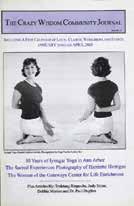
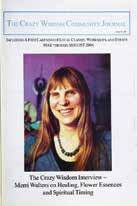
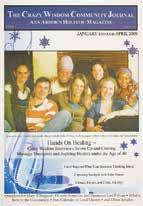
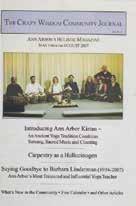
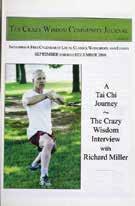

View over 76 full issues of The Crazy Wisdom Community Journal spanning 28 years.
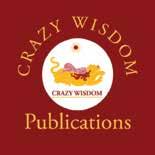
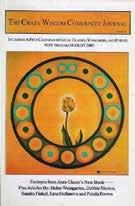
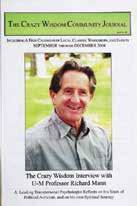

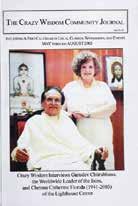
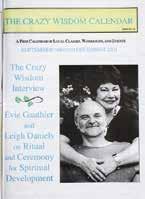
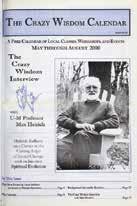
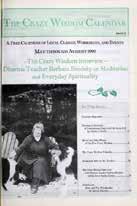
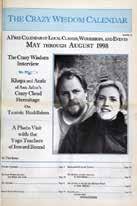
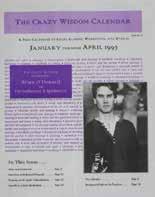
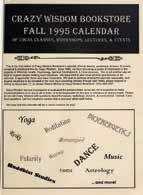


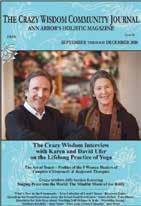
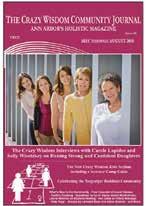

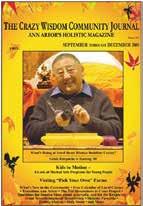

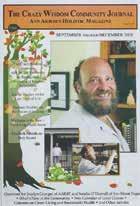
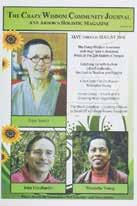
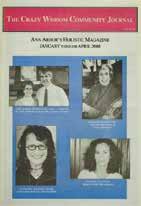



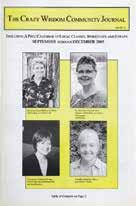
The Crazy Wisdom Community Journal • May through August 2023 • Page 2
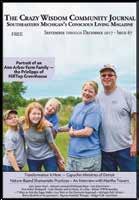
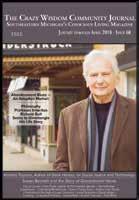

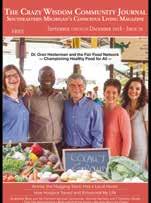

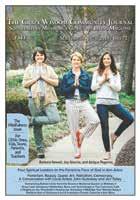

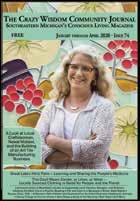

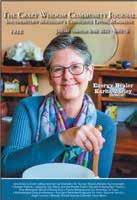
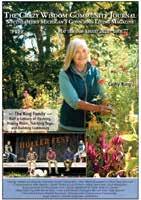
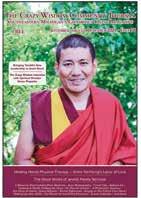
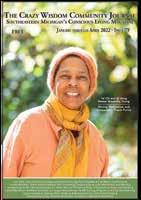
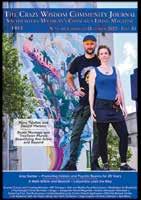

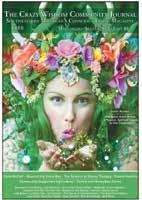

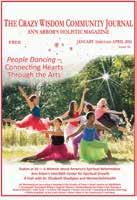


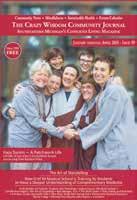
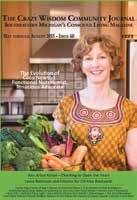
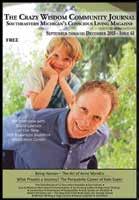


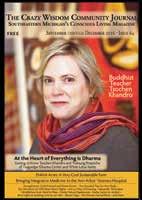
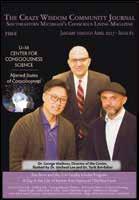
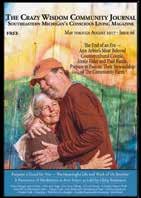
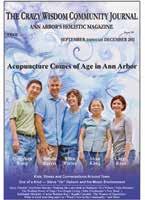
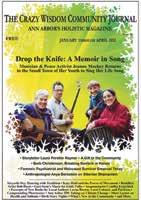

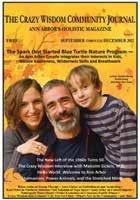
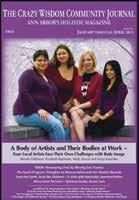
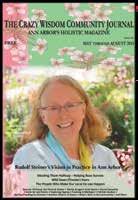

The Crazy Wisdom Community Journal • May through August 2023 • Page 3 Visit https://bit.ly/CWJArchive or scan the QR Code.
The Crazy Wisdom CommuniT y Journal
Features CWJ
Page 7
Learning From Our Year-Round Birds by Ash Merryman

This Issue ~
Page 38
Tying the Knot in Nature by Christine Macintyre
Learning From Our Year-Round Birds by Ash Merryman ....................................................................................
Roadside Marsh by Frank Vandervort
The Past Rarely Stays in the Past by Sandor Slomovits
Ann Arbor Clothing Company, Joob Activewear, Aims for Fair Trade and Climate Neutral Fashion by Kirsten Mowrey
Ann Arbor Farm & Garden — Flower Therapy and Community Beautification by Peggy Alaniz
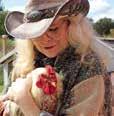
Tying the Knot in Nature by Christine Macintyre

Black Men Read — Expanding Possibilities Through Storytelling by Hilary Nichols
Page 48
Black Men Read — Expanding Possibilities Through Storytelling by Hilary Nichols

Page 60
Gateway Farm — Growing with Permaculture by Sandor Slomovits
InPage 76
Craig Stoller — Healing Through Chiropractic Interview by Madonna Gauding

Page 68
A Conversation about Animal Assisted Therapy with Laura Sanders by Grace Pernecky
Page 86
Field of the Five Horses by Irena Barbara Nagler
Page 82
Psychedelic Medicines in Trauma Recovery by Ashton D. Justice
Page 7
Page 8
Page 9
Page 18
Page 36
Page 38
Page 48 Garden Juju Collective by Hilary Nichols
Gateway Farm — Growing with Permaculture by Sandor Slomovits

Peace, Love, and Cows by Cashmere Morley
A Good Crop of Mental Health —
Page 58
Page 60
Page 66
A Conversation about Animal Assisted Therapy with Laura Sanders by Grace Pernecky .................................................................................
How Humor Helps Me Over a Hurdle by Angela Verges
Craig Stoller — Healing Through Chiropractic
Interview by Madonna Gauding
Psychedelic Medicines in Trauma Recovery by Ashton D. Justice

Field of the Five Horses by Irena Barbara Nagler

Columns CWJ
Kindred Conversations ~ by Hilary Nichols
Page 68
Page 75
Page 76
Page 82
Page 86
Break Dance Teacher and Change Maker, Maurice Archer Page 10
Singer-songwriter, poet, painter, maker, and performer, Anne Erlewine
Healers of Ann Arbor ~ Indigo Forest and Chronic Pain Reduction by Marie Duquette

Our Yoga Column ~ by Katie Hoener
Out of My Comfort Zone ~ Stretching Out of My Comfort Zone by Rachel Portnoy
What’s New in the Community ~ by Lynda Gronlund
Green Living ~ Ditching the Paper Towel by Emma Hess
Page 11
Page 13
Page 23
Page 24
Page 26
Page 33
Astrologically Speaking ~ All About Mercury Retrograde: Return, Reassess, Redo, Renew by Catherine Carlson Page 34
Leaps of Faith ~ by Laurel Decker
Curiouser Clay
Third Mind Books
Page 44
Page 46
All Creatures Great and Small ~ In-Home Euthanasia and Hospice-Assisted Natural Death for Your Pets by Monica Turenne Page 72
Sustainable Health ~ When Food as Medicine Becomes Food as a Threat to Health by Judy Stone Page 74
Handcrafting ~ Little Bug Fairies — A Waldorf-style Pocket Doll by Jennifer Carson
Page 92
The Crazy Wisdom Community Journal • May - August 2023 • Page 4
Putting Permaculture into Practice
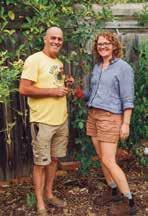
Charlie Brennan and Bridget O’Brien
CWJ
Conscious and Tasty Eating and Nutrition
Food Section
Starts on Page 51
Herbs for Your Garden — Calendula by Caitlin Potere Page 52
Great Tasts in Local Food by Crysta Coburn
The North Star Lounge Page 54
Latin American Cuban Cuisine .................................................. Page 54
Plate Sushi and Chicken Page 55
Cooking with Lisa — Delicious Plant-Based Burgers for Spring by Lisa Viger Gotte Page 56
Tea Time with Peggy — Cold Brew Tea by Peggy Alaniz Page 57
CWJ
Kids Section
The Crazy Wisdom Kids Section
Starts on Page 89
Children’s Book Picks Page 89
Conscious Parenting Column ~ Ele’s Place Ann Arbor— A Home for Healing Hearts by Kris Maly Page 90
Events Calendar for Kids-Related Classes and Happenings Page 91
CWJ
Book Reviews
Book Review: An Immense World — How Animal Senses Reveal the Hidden Realms Around Us — by Ed Young Book Review by Christine MacIntyre Page 65
Book Review: Ensemble! Using the Power of Improv & Play to Forge Connections in a Lonely World by Jeff Katzman M.D. and Dan O’Connor Book Review by Christine MacIntyre Page 97
CWJ
The Calendar
The Crazy Wisdom Calendar Section
Calendar Edited by Jennifer Carson
Starts on Page 94
The Calendar Page 94
Background Info on the Teachers Page 111
The Practice Beneath the Practice by Kelly Kempter Page 101
Finding Myself Through Human Design by Melody Simmons Page 108
The Art of Spirit Guide Messages and Tarot by Kat Similo Page 113
In Memoriam — Richard D. Mann, 1933-2023 ...................... Page 115
CWJ
Advertisers
Advertiser Directory Page 116
Resources for Conscious Living Starts on Page 14
Crazy WisdomJournal.Com
This issue will be posted on our website as of May 1, 2023
The Crazy Wisdom Community Journal has been published three times a year since 1995.
Copyright © Crazy Wisdom, Inc. — April 2023
No parts of this publication may be reproduced for any reason without the express written approval of the publisher. There is a token fee charged if you would like to use an article in this publication on your website, so make sure to contact us first. Articles from back issues are available on our website’s archive.
Crazy Wisdom was founded in 1982. Since 1989, it has been owned by Crazy Wisdom, Inc., which consists of Bill Zirinsky and Ruth Schekter.
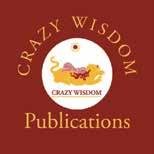

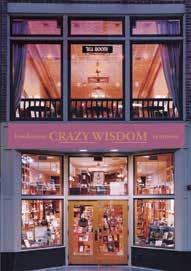
Advertising Sales Manager
Tana Dean
Distribution
Richard Knapp, Paul Stehle
Managing Editor/Staff Coordinator
Jennifer Carson
Senior Design and Production Editor
Carol Karr
Design and Production Editor
Jennifer Carson
Editing
Jennifer Carson, Michelle McLemore, Lexi Mohney
Writers
Peggy Alaniz, Petula Brown, Catherine Carlson, Crysta Coburn, Laurel Decker, Marie Duquette, Madonna Gauding, Lisa V. Gotte, Lynda Gronlund, Katie Hoener, Ashton D. Justice, Joshua Kay, Christine MacIntyre, Angela Madaras, Michelle McLemore, Ash Merryman, Carin Michaels, Cashmere Morley, Kirsten Mowrey, Irena Barbara Nagler, Hilary Nichols, Grace Pernecky, Sandor Slomovits
Artwork
Jennifer Carson, Margaret Wyngaard
Photography
Senior Photographer: Linda Lawson
Susan Ayer, Mary Bortmas, Rachel Everheart, Tobi Hollander, Kate Jackman, Hilary Nichols, Edda Pacifico, Joni Strickfaden, Rachael Waring
Calendar Editor
Jennifer Carson
Publisher/Editorial Director
Bill Zirinsky
This issue is distributed starting in the last week of April.
The deadline for Free Calendar submissions for the September thru December 2023 issue is Wednesday, July 19, 2023
Contact calendarforms@ crazywisdom.net
The deadline for reservations for Paid Advertising is Monday, July 31, 2023
Contact tana@crazywisdom.net
After being on sabbatical since early 2022, Crazy Wisdom Bookstore is ready to reemerge, under its same longtime ownership. See ad on page 1.

The Crazy Wisdom Community Journal • May - August 2023 • Page 5 On the Cover
Serving the Community Since 1982
crazywisdomjournal.com Listen to the interview AADL Talks To: Crazy Wisdom
info@crazywisdom.net
Cover Photo by Marcelo Paternoster
of Garden Juju Collective and Gateway Farm
Meet Some of Our Creative Team
We sincerely appreciate all the talent that gets put to work to bring you the best Crazy Wisdom Community Journal three times a year, and we like to highlight different contributors from each issue in this space. Look for us to highlight some of our contributors in every issue.

Kate Jackman of Fresh Coast Photography has been a bookseller, inventory manager, personal chef, and commercial and fine art photographer. She has run her own personal chef business for 22 years. She’s photographed for Edible WOW, The Crazy Wisdom Community Journal, numerous private clients, and has sold her art photography in Ypsilanti’s galleries. When not cooking or running around with her camera, she loves to travel, read, garden, and relax with her spouse and furry kids.
Madonna Gauding lives in an artist’s community in Dearborn, MI. She has worked as a writer, illustrator, and book designer for book publishers in the US and UK and for Jewel Heart Tibetan Buddhist Center in Ann Arbor. She loves interviewing people about their lives and their work.

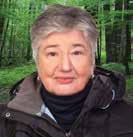

Lisa Viger is a vegan artist, gardener, author, recipe developer, and lover of the planet and all its inhabitants. She’s a 200RYT Yoga Teacher and an MSVA Vegan Lifestyle Coach. More than almost anything, she enjoys showing others that a healthy vegan lifestyle can be economical, simple, fun, and delicious, too. Viger is the author of our Cooking with Lisa column.
Kirsten Mowrey has been a bodyworker in private and group practice since 1995. A licensed massage therapist, Trager practitioner, and Four Winds graduate, she blends soulful energy work with movement, safe touch, and anatomical precision. She has been writing articles for The Crazy Wisdom Community Journal since 2014.




Lexi Mohney is an author, editor, publisher, and a book coach living in Ann Arbor. Throughout her writing and coaching career, she's lived by the motto of "six seconds of insane courage," and worked with her own coaches, groups, and support system to see her dreams come true. Her first published piece, Carnal Knowledge, won an award at the 7th Annual Bisexual Book Awards in NYC in June 2019.
Susan Ayer began as a photojournalist in 1991, when she became publisher, editor and staff photographer for the Washtenaw Jewish News. Now retired from that position, Susan spends her time traveling; creating art; visiting her adult children and grandchildren in Portland, Oregon; and with her Touchstone Cohousing and Friends Lake communities here in Michigan. Her photography can be viewed at susanayerphotography.com.
The Crazy Wisdom Community Journal • May through August 2023 • Page 6
Learning From Our Year-Round Birds
By Ash Merryman
have caught your eye on more than one occasion. For centuries, humans have observed birds for signs and omens (called augury or ornithomancy) as well as told stories illuminating the lessons birds carry. Birds have a wealth of wisdom to share with us, and this article highlights several of our year-round winged teachers who can be called on at any time in our hearts and, with some bribing, in our yards. These Michigan loyalists are the Black-Capped Chickadee, the Blue Jay, and the Northern Cardinal.
Perhaps, this “call it like it is” approach is what lends Black-Capped Chickadees their observable levity as these birds are full of energy and buoyancy.







Black-Capped Chickadee: Honesty, Joyfulness, & Confidence. These pintsized birds emanate joy and are sure to make you smile. Their striking black cap and bib in contrast with their white cheeks makes the Black-Capped Chickadee easy to identify. Also recognizable is their distinct warble, for which they are named after, sounding like “chickadee.” The number of “dee”s at the end of their call corresponds to the degree of threat in their environment, making chickadees excellent communicators who use their voices to empower those in their group (called a banditry) with the truth of things. Perhaps, this “call it like it is” approach is what lends Black-Capped Chickadees their observable levity as these birds are full of energy and buoyancy. In this way, Black-Capped Chickadees show us there is joy to be gained through honest communication. Additionally, Black-Capped Chickadee asks us: why not be happy on your way to happy?
For the Black-Capped Chickadee, light-heartedness is a state of being. This bird shows us that ease follows from a positive outlook and preparedness. With excellent spatial memories, these birds stash food away in autumn and can relocate those stash spots come winter. This teaches us to be grateful for the times of plenty and to prepare for the needs of our future selves for peace of mind. Finally, though small, this bird is mighty courageous! Easily one of the most confident birds at my feeder, the small Black-Capped Chickadee acts like a very big bird, reminding us to be confident in ourselves and our capacities. Call on Black-Capped Chickadee for the courage to be honest, for light-heartedness and optimism, in times of preparation, or when you need a boost of selfconfidence to fly onward.
All the verve of Blue Jay is backed by strong actions, too. Blue Jays are extremely loyal to their life-long mate and flock, and tenaciously protect their flock and territory with great vigilance.
Blue Jay: Authenticity, Bravery, & Protection. Elegant and fierce, the brilliantly colored Blue Jay truly illustrates what it means to live out loud. Due to light refraction, a Blue Jay’s dull toned feathers appear a striking blue. Combined with the noble crest atop their heads and ornate black ring on their necks, Blue Jays steal the show with their regal looks. A member of the corvid family, a Blue Jay’s call is an unmistakable screech-like whistle that can be heard up to a mile away, and these birds love to be vocal. This unabashed guide recognizes its inherent worthiness, is loud and proud, and always arrives with flare. Blue Jay encourages us to embrace and express our authentic selves with equal vivacity. All the verve of Blue Jay is backed by strong actions, too. Blue Jays are extremely loyal to their life-long mate and flock, and tenaciously protect their flock and territory with great vigilance. This bird will even search for and rescue flock members
who are lost or in danger. At my feeder, Blue Jay is the only bird bold enough to swoop at squirrels when peanuts in the shell are on the line. By facing both danger and the unknown with courage to protect who and what matters to them, Blue Jays teach us to have our flock’s back, to loudly advocate for ourselves and loved ones, and to bravely protect what’s important, whether it be a place or personal boundary. Call on Blue Jay to let your authentic self shine, to bravely face difficulties or unknowns, or to protect yourself, your flock, or what’s important to you.
Northern Cardinals show us that flourishing in life begins with a stable home base and feelings of security.
Northern Cardinal: Home, Love, & Community. Spotting a bright red male cardinal in the snowy winter offers all the idyllic cozy feelings one could hope for in cold months. It’s no wonder the Northern Cardinal is a bird of home and domestic life. Adept nest builders, Northern Cardinals mate monogamously for life and work together to co-create a secure nest and raise their young. Northern Cardinals show us that flourishing in life begins with a stable home base and feelings of security. Often sighted in pairs, the model worthy partnerships of Northern Cardinals symbolize lasting romantic love. Whether we’re in love or single, Northern Cardinal has lessons on love to go around. For people in relationships, Northern Cardinals encourage us to re-commit to our partner every day and appreciate all they are and all they do. Cardinal pairs sing special duets that increase their bond, asking us how we might show up in our romantic partnerships as a harmonious duet.
For people who are single, Northern Cardinals offer the strength to be uncompromising on what we deserve–singing about a nourishing and secure love on its way. Lastly, Northern Cardinal is a sociable bird of community who flocks together with other cardinals and even other bird species. These birds are exemplars of peaceful coexistence by socializing with and welcoming both other cardinals and different bird species with open hearts and minds. In this way, Northern Cardinals teach us about being open to and welcoming of people who are different than us, showing us by example that this is what community is all about. Call on Northern Cardinal for a sense of home and security, in all matters of love, or to promote openness and acceptance in your community.
The next time you share an encounter with one of the three feathered mentors highlighted here, listen for the wisdoms they sing to you-letting their song give you joy, grant you strength, and shelter you in love.
For all the beautiful teachings these birds share, we can show our thanks by keeping a feeder going year-round and offering sources of fresh water. We make a difference: Northern Cardinals have expanded their territories in recent years because humans make winter more comfortable for them with bird feeders. If you have a yard, turning this space into a bird sanctuary is an excellent way to cohabitate kindly as well as learn more about and from our birds. Plus, you get the bonus of creating and spreading abundance in your corner of the universe. The next time you share an encounter with one of the three feathered mentors highlighted here, listen for the wisdoms they sing to you–letting their song give you joy, grant you strength, and shelter you in love.
The Crazy Wisdom Community Journal • May through August 2023 • Page 7
Roadside Marsh
By Frank Vandervort
The westbound traffic on Interstate 94 is at a crawl this morning and I couldn’t be happier. It’s a Wednesday and brilliant sunshine glints in my rearview mirror. About halfway between home and my office at the university, a small marsh lays up next to the highway partly shadowed by the Platt Road overpass. Tucked in behind a red brick apartment building along the edge of a residential neighborhood, the marsh covers an acre, maybe two. On the edge furthest from the highway, there is an area of open water. The basin containing the marsh is deep enough that this pool never dries up, though for much of the summer, when the hydrophytes are at their tallest, passersby on the expressway get only an occasional glimpse of the water.
The interstate and the surface road flow day and night with traffic—cars, trucks, motorcycles, recreational vehicles of every description. However, the marsh’s proximity to all that human activity does not prevent it from being an active bit of the natural world.
Science has caught up to what we humans know intuitively: exposure to nature, even a little, and even if under less-than-ideal circumstances, when we cannot immerse ourselves, has tangible benefits for our physical and emotional health. Exposure to the out-of-doors has been shown to reduce stress, speed recovery from illness and injury, and to reduce the symptoms of attention deficit hyperactivity disorder in children. Living in a suburban area, and working on an urban campus, my mind and body sometimes longs, even aches, for the chance to be immersed in nature.
The interstate and the surface road flow day and night with traffic cars, trucks, motorcycles, recreational vehicles of every description. However, the marsh’s proximity to all that human activity does not prevent it from being an active bit of the natural world.
I pass this little marsh two or three times a week, and sometimes five, so I have the chance to observe it as it changes gradually throughout the year. In late August, as the new school year approaches, the marsh grasses, the cattails, and the sedges are dense and green. When the breeze stirs them, they sway together like so many waltzing couples. In a few weeks, as the shortening days of late summer fold into the even shorter days of autumn, the color will gradually drain away. The grasses, cattails, and sedges will grow at first tawny, then brown, then a sickly, almost colorless, cream. Rather than dance in the gentle breeze, their dried stalks will rattle and scrape in the sharper winds of winter. The view of the pool, which has been partially obscured for the past several months by the robust flora, will open again.
Some mornings, small flocks of ducks, Canada geese, or a pair of swans float in the open water, using the small pool as a layover during migration. The water on which they bob ranges in color from light blue to near black as it reflects the changing conditions of the sky. This morning it is a light gray, the slanting morning sunlight having not yet reached the water’s surface. The passing fowl are there for a day or two and then they are gone.
On chill autumn mornings fog (caused when the cool air passes over the warmer water) rises from the pond. Later in the fall, around Thanksgiving most years, ice develops on the pool. Recent winters have been so mild the water is often open
into January. When the surface does freeze solid, snow blows in wispy, curling fingers across the ice, accumulating along its edges, where the foliage acts like a natural snow fence.




One thing that does not change is the half-dozen or so dead hardwoods scattered in the marsh and around its edge. One is large and has plainly stood in its place for decades. A maple, I think, its trunk straight and thick. The tree has been dead long enough that its smaller branches have fallen away, and its bark is sluffing off. The presence of these snags makes me wonder about the origin of the marsh. The basin must be of relatively recent vintage given that the area was at one time dry enough for these hardwoods to reach full maturity before drowning. Is the marsh the result of the unintended impoundment of water that resulted from the construction of the interstate and the surface street? Is it a glacial pothole that has gradually expanded to encroach on the adjacent hardwoods? Or is it simply a low spot in the ground that has, over the years, filled with rainwater and snowmelt?
In late August, as the new school year approaches, the marsh grasses, the cattails, and the sedges are dense and green. When the breeze stirs them, they sway together like so many waltzing couples.

Whatever its origin, today it is a vibrant miniature ecosystem frequented by waterfowl, songbirds, and, sometimes, by raptors. In this morning’s light, the dead maple’s upper branches—bare, arching and spread wide—reflect the salmon tint of the sunrise. Many mornings a red-tailed hawk assumes a perch high in this snag, a perfect platform for surveying the roadside and the marsh for prey.
As the cold season melts into the earliest days of spring, the marsh gradually awakens. Color creeps back into the grasses’ stalks. The thawing brings insects, and the insects attract the avian residents and visitors. Soon I will see the season’s first red winged blackbird, a sure sign that spring is at hand. They alight on the sturdy plants along the marsh’s edge. Despite the highway’s noise, I often lower the passenger side window to catch their sweet “creee-e-e, creeee-e.”
For the rest of my drive to the office this morning, I reflect on my life choices. More than three decades ago, I settled on living an urban life, one very different from my rural childhood in Northern Michigan when I lived close to the natural world. It’s a decision that I’ve struggled with at times ever since. Over the last several of those years, this little roadside marsh has provided a window— limited and momentary, though soothing—into a wild landscape. It has provided a reprieve from the relentlessly developed landscape of city and suburb. The calmness I feel passing it helps me prepare for the hectic day ahead, and to appreciate a good traffic jam.
It has provided a reprieve from the relentlessly developed landscape of city and suburb. The calmness I feel passing it helps me prepare for the hectic day ahead, and to appreciate a good traffic jam.
The Crazy Wisdom Community Journal • May through August 2023 • Page 8
The Past Rarely Stays in the Past The Past Rarely Stays in the Past
By Sandor Slomovits
Sometimes it’s hard to uncover the truth about past events. Other times the past reveals its truths almost unbidden. Either way, the past rarely stays only in the past.

I came upon a striking personal case of that recently and then noticed some correspondences to current events in our country.
It began with a book review by Chuck Newman in the Washtenaw Jewish News. (Newman also hosts a biweekly series of “Conversations” presented by the Jewish Community Center of Greater Ann Arbor.) The book Newman reviewed is called The Nine, by Gwen Strauss. Its subtitle is what caught my eye: The True Story of a Band of Women Who Survived the Worst of Nazi Germany. I am the son of two survivors of the Holocaust. Between them, my parents lost more than a dozen close relatives. When I see the words “survived” and “Nazi Germany” I tend to pay attention. Very soon after I started reading The Nine, I realized it was going to hit even closer to home than I had anticipated.
My brother and I were about sixteen when our mother first told us of her wartime experiences. Of course, we believed her, but still, her stories had a kind of unreal, mythical quality.
The Nine is about nine women who were imprisoned in the Ravensbrück concentration camp in 1944. My mother was also imprisoned in the Ravensbrück concentration camp in 1944.

The nine women were forced to labor at a munitions factory in Germany during the war. My mother, too, was forced to work in an airplane parts factory in Germany during the war. My brother and I were about sixteen when our mother first told us of her wartime experiences. Of course, we believed her, but still, her stories had a kind of unreal, mythical quality. The events she described had taken place so far away and years before we were born. Additionally, it was—and still is—very hard to imagine or accept that people had done to other people the things she described; that they had done them to her! That despite everything, some people managed to survive those ordeals and return to ordinary life--that she’d managed to do that.
As I read The Nine, I found that Strauss’ detailed accounts of what the women endured—culled from interviews and from their writings after the war—not only confirmed everything our mother told us, they also made evident that our mother had in fact toned down or even completely hidden some of the harshest aspects of her detention in Ravensbrück, as well as of her subsequent transfer to forced labor in Penig, and her escape from a death march in April of 1945.
In researching The Nine, Strauss travelled to Germany and visited the Gedenkstätte Für Zwangsarbeit, the Memorial for Forced Labor in Leipzig. The Memorial is located near the site of the HASAG munitions plant where the nine women, and thousands more, were held captive and forced to build weapons for the Nazis. The Memorial is devoted to preserving the history of that lager (camp) and of other Nazi labor camps in Germany and elsewhere in Europe. It makes its library and archives available to scholars, survivors and their relatives, and also offers lectures, tours, and other educational events. Anne Friebel, a member of the museum staff, helped Strauss find documentation about the nine women’s detention in the HASAG lager.
Shakespeare had it right when he wrote in The Merchant of Venice (where else, of course!) “Truth will come to light; murder cannot be hid long… in the end truth will out.”
When I finished The Nine, I sent Friebel a brief email in which I related what I knew of my mother’s wartime experiences and asked if the Memorial might have any further information about her. A few days later I had a reply from Friebel. Yes, she had found my mother in the Arolsen Archives. (The Arolsen Archives are
the most comprehensive archives on the victims and survivors of the Holocaust.) She attached digital copies of my mother’s prisoner card in Ravensbrück, and of her prisoner card in Penig.

Friebel also wrote, “Today in Penig, there is an active association commemorating the women of that camp” and offered to put me in touch with them. In the next few weeks, I exchanged dozens of emails with her and with two of the people in the Erinnerungsort-Penig (Penig Place of Remembrance) and they sent me more information about the Penig lager. In response to my questions, they wrote, “Our group was founded in 2013 after neo-Nazis brutally beat up a student [in our community]. At first, we started to raise awareness, to promote democracy and tolerance. In this context, the idea arose in 2015 to investigate the history of the concentration camp that existed in our hometown from 1944 to 1945 and especially what crimes intolerance, anti-Semitism, and racism can lead to. That is our motivation.” Their website says, “…over the past 15 years a neo-Nazi scene, which was prone to violence and had a strong national network, had been able to establish itself in our rural area, and was responsible for a whole series of attacks on non-whites, people living differently, the homeless and those committed to democracy.” Their mission statement ends with, “Above all, we want to counteract racism, anti-Semitism, and neo-fascism with the help of education and awareness-raising work.” I continue to be in contact with them.
I’ve roller-coastered through an enormous range of emotions since I first read The Nine and wrote to Friebel. I’ve felt in turns, excited, fascinated, horrified, repelled, frightened, furious, sad, grief-stricken, and more. I often questioned what I was doing and why. I felt a variation of survivor’s guilt; I only researched what happened—they had had to endure it. When I felt overwhelmed or numb, I withdrew, but found I could not look away. I remembered a line from Crimson Joy, a mystery by Robert B. Parker. “If she could suffer it, I could look at it.”
Through it all, I couldn’t help but notice current parallels in our country-the craven attempts to deny and erase truth and history, some focusing on the 2020 election and the January 6 insurrection, others more broadly on slavery, racism, and the treatment of Native Americans. Rising anti-semitism, xenophobia, and efforts to marginalize and attack the LGBTQA+ community are just some of the despicable echoes of the Nazis’ past.
Shakespeare had it right when he wrote in The Merchant of Venice (where else, of course!) “Truth will come to light; murder cannot be hid long… in the end truth will out.”
I don’t know where continuing the search for my family’s past will lead me. Here’s what I do know: Where I stand now is in gratitude—gratitude for Gwen Strauss for her tremendous skill and effort in creating The Nine; to Anne Friebel and the other staff and volunteers at Gedenkstätte Für Zwangsarbeit and Erinnerungsort-Penig for their dedication to preserving and teaching what at times must be some very painful truths; for their kindness in helping me and many others who are still seeking those truths; to those people in our country who rejected the lies about the 2020 election, and the violence of January 6; to all people everywhere, who courageously stand for truth on behalf of all humanity. Above all, I feel more gratitude and admiration for my mother than I can put into words.
Almost exactly four years after she was deported to Germany in a cattle car bound for the hell that was Ravensbrück, then shipped, again in a cattle car, to Penig and forced to labor for the Nazis, my mother endured another painful and difficult but this time, freely-chosen and joyous labor: she gave birth to twin sons—my brother and me.
Sandor Slomovits plays folk music for children and families with his brother and daughter in the trio, Gemily. He also writes essays and articles on a variety of topics. His website is SandorSlomovits.com.
The Crazy Wisdom Community Journal • May through August 2023 • Page 9
Kindred Conversations with Hilary Nichols
Break Dance Teacher and Change Maker, Maurice Archer. Check-out A2Breakdance at a2breakdance.com.
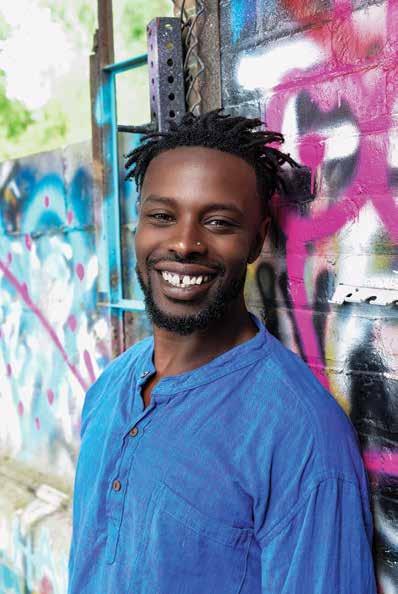 Story and Photos by Hilary Nichols
Story and Photos by Hilary Nichols



The center of Maurice Archer’s big vision starts with dance. He’s known around town as the premier break dance performer, teacher, producer, and owner of A2 Breakdance. He has been bringing his unstoppable energy and expertise to classrooms, after school programs, rec and ed offerings, private parties, intensives, local festivals, and street fairs for years. If you’ve seen the linoleum unroll and a simple boom-box set up for a crew of kid and adult dancers to step in for six step, windmill, kickup, flare, or a bunch of impressive acrobatic dance moves, then you have seen an A2 Breakdancers’ cipher. A cipher is a circle of dancers, jumping in to share a small mobile dance floor with their handstands, back spins, and fancy footwork before the next dancer tags in.
Archer plays percussion and keyboards, raps and sings at his in-home music studio where he records beats, tracks, and music videos with his collaborators and his kids. Archer is a father of five. As any father will tell you, his kids are his pride and joy. With the talent, charms, and manners of this beautiful troop, no one would wonder why. Exposing his kids to these arts is a crucial part of his parenting philosophy. Archer tells me, “Kids don’t just pick up the interests of their parents, they tap into their devotion and dedication. They witness and mirror how important it is to prioritize their passions, so that interests become compulsions, and hobbies become talents in time.” To see his kid’s mastery of breakdancing and other arts is impressive and inspiring.
From cipher to circle, from students to friends, from audience to community, Archer is building something bigger with his expansive impact. With his community of friends and family Archer is creating an art compound. He found a little place to purchase south of Ann Arbor a few years ago, and it is there that they are combining their whole family’s skill set to build a greater vision. The home was run-down with a wood burning oven and not many other modern amenities, but Archer saw an opportunity, and he’s taken the simple home from rustic to bucolic, as the hub of an expansive and productive property. Now chickens and goats wander around the gardens and pathways that wind through the extensive grounds. He envisions a venue for music production, wilderness retreats, and life-skills workshops that will inhabit the land in time. Weaving together all the talents and intents of his growing clan, this vision is alive and expanding.
Archer has been building a team of talented dancers with his consistent workshops all around town. The classes offer step-by-step knowledge that builds strength and precision for mind and body for adults and kids of all ages. But beyond breaking, these students receive much more than movement instruction: they are getting subtle but powerful lessons that Archer has dubbed his “life skills sessions.” The encouragement through this practice builds physical and mental strength, self-reliance, and self-love. By putting in the work, students come to trust their ability to know, improve, and empower themselves with their own unique strengths and offerings. Not everyone will master the same moves, but that’s what makes the cipher so compelling. Each dancer gets to throw down their special skill into the mix. Breakdance celebrates all body types, talents, and souls.
Archer discovered the form as a teen while studying martial arts and other strength training practices. He found it combined his love of musicality, creativity, strength, and community spirit. Sharing this love of dance took center stage, yet all the while he has kept up on his martial arts, training seriously in TaeKwonDo at Ann Arbor Martial Arts Academy. He competed at his first TaeKwonDo tournament in 2021 with a nearly instant win. Though the decision was challenged, his ability was clearly on display. His musicality is still an active pursuit as well, engaging in a number of collaborations and independent projects. You can see some of this work on his social media channels.
Sitting for tea with Archer recently, I felt his calming and focused presence, even as he balances in the sway of all this swirl. The elements seem to add up beautifully for a dancer, teacher, singer, producer, businessman, land owner, farmer, and father. Archer is trained to hold his center in the eye of the storm. All of these disparate elements he sees as one force, fueled by his energy field, that he likes to describe as loosh. Loosh is a new term for me, he described it as the “vibrations of human energy that we each emit and can tap into.” For Archer this loosh is a positive notion that affirms how we can all listen in and harmonize with the human and planetary hum. Maurice Archer has clearly been listening and found his sound wave to ride into his rightful role in this world. As a creator he is clear on his contribution and our community is better for his clarion call, and for his airflare and standing flip on the linoleum floor.
The Crazy Wisdom Community Journal • May through August 2023 • Page 10
The encouragement through this practice builds physical and mental strength, self-reliance, and self-love. By putting in the work, students come to trust their ability to know, improve, and empower themselves with their own unique strengths and offerings.
From cipher to circle, from students to friends, from audience to community, Archer is building something bigger with his expansive impact.
Maurice Archer
KC
Singer-songwriter, poet, painter, maker, and performer, Anne Erlewine.

Anne Erlewine is the art in the center of her offerings. A singer-songwriter, poet, painter, maker, and performer, she is an open heart on tap. She channels each word and chord straight from her core as she performs. Erlewine plays the guitar, keyboard, and ukulele to accompany a full set of her hand-crafted tunes. I have seen her perform at the Ann Arbor Summer Fest, at Argus Farm Stop, and house concerts in Ann Arbor. At her home turf, the Earthwork Harvest Festival in Lake City, her stage presence is so natural and dynamic, it fills the converted barn to the rafters. She commands the spotlight with honesty and truth as she introduces her storied songs. She describes her style as, “Kind of folk. It’s vulnerable and genuine, and revealing like folk. Straightforward and poetic, putting my emotions through a microphone. I try to amplify what’s going on in my soul.” Woven along with her precisely parallel arrangements, her work is both surprising and familiar. There is a heart-wrenching intimacy to listen to her inner atmosphere.
“I came into playing music, really wanting to keep my voice alive, to let my expression survive. It is not the easiest thing,” Erlewine confessed. Being a performer may not come easily to Erlewine, but it is a crucial part of who she is. “I was a really good runner; it came naturally to me. When I met this woman who was not natural at it, but did a marathon because it was tough, I had to ask myself, what is my marathon? Performance is that for me,” she explained. “I have had to hang in there with myself.” But, she recognizes it isn’t a choice. “There is just something in it that keeps calling me back.”
That is the ultimate point in her song writing, honing her inner dialogue to be able to express her own voice with clarity. Erlewine looks to energy work, chakra clearing, and somatic experience to quiet the distractions. “I have to disidentify with these over-couplings that set me off in a trajectory that is not my own,” she explained. “My whole journey is to pacify the inner critic and offer the unconfident self a warm cup of tea, just to continue.” Over time the practices have had their impact. “I have been able to shed some of the doubt, calm the nervousness. I have created some space for me to survive and to start to thrive in this environment.”
The payoff is palpable. Her audience hangs on every word, swaying to the elegant tunes, complex arrangements, and engaging rhythms. “It has never been simple for me. But maybe it isn’t supposed to be,” she mused. Writing and recording the ten original songs on her debut album Over The Bones took five years to complete. The album producer, Christian Bathgate, offered this in review: “Michigan native singer-songwriter Anne Erlewine distills her lyrics, and sets them to simple, clever, cyclic guitar parts that support her clear, direct, and hauntingly honest voice. Her vulnerability plows a path for yours.” It is traditionally a close collaboration between producer and artist. This work clearly benefited from the overlap of these two friends and artists. Bathgate honors the alignment. “While it was the gravity of your art that pulled me in, made it worth it, inspired me to agree, to be dedicated, involved,” he commented on Instagram, “Itt was your kindness, your remarkable way of being, your relentless forgiveness, that kept me at the table of promises.”
Kindness emanates from Erlewine and that comes through from the stage. Throughout the weeks prior to her performances, she writes down her life stories as they strike her and brings the prompts to stage in her rusted metal Banter Box. Some find this their favorite part. “My songs can seem so serious, so I like to add levity. I’m funny.” Initially this tall, curly-haired woman seems shy, though quickly it is apparent she is no shrinking violet. She is funny and powerful even while she can be self-deprecating. It is all part of her charm that is apparent in her long prose that she shares on her Facebook Blog. She muses on the humor, frustrations, and minutiae of parenting at eye level with her two young daughters. Lighthearted, but not fluff, her writings are worthy of taking seriously. “The pressures and societal norms put on women to raise children with the lack of community support is difficult for me,” she shared. “I find that when I am in my domain as an artist, I feel most empowered in my life and in relating to my kids.”
As a painter, Erlewine has carved out a home studio in her basement. “When we’re in the studio together, my kids are little artists and the laws that I have around my own creativity are different. There is a lot more relationship building going on there; we share a certain respect.” Sharing her creativity is in her blood. Anne Erlewine inherited her passion from her paternal grandmother along with her tools and equipment. Her grandmother’s 40-year-old hot wax pot and her framed batik pieces grace Erlewine’s garage studio, and her photo is posted beside her painting supplies downstairs. “I want to incarnate what she gave to me; I aspire to be like her, to become her, in this lifetime,” Erlewine said. “She was a matriarch that truly tended to her creativity and passed it along to all fourteen of her grandchildren and her five sons.” Erlewine studied art at U of M, and spent a summer investigating watercolor and poetry at Naropa Institute in Boulder, Co. Today she paints feather light naturescapes and wildflower
Divine Inspiration At Work
Let Divine Inspiration be the guide for the next chapter in your personal life, career, or business.
Psychic & Mediumship Readings

Career & Business Strategy Sessions
Live Virtual Workshops via Zoom

DivineInspirationAtWork.com



"I can say beyond a doubt that my reading with Susan has helped propel me in my soul’s direction and vocation! She is incredibly accurate and left me feeling more inspired and excited than I could possibly express!” Hallie S., Salt Lake City, Utah

The Crazy Wisdom Community Journal • May through August 2023 • Page 11
Susan McGraw Psychic Medium Career & Business Strategist 734-415-4006
Anne Erlewine
Kindred Conversations continued...




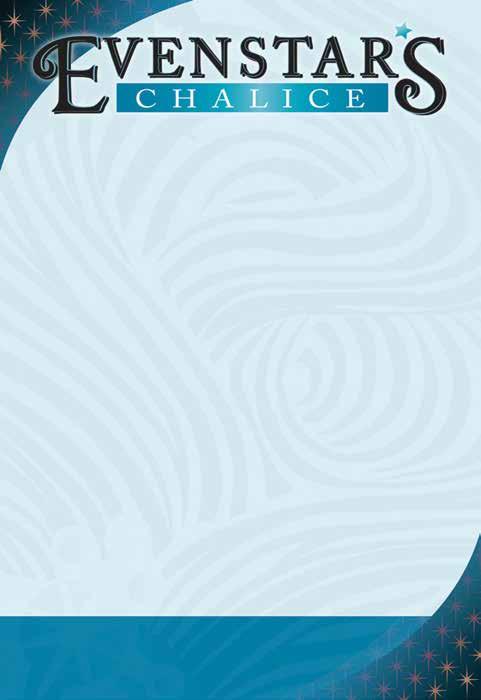





abstracts with white shadowed interplay on bright birch, oak, or maple panels that give these large pieces a daydream aesthetic. She has shown her pieces independently at art fairs, venues, cafe galleries, as well as the Michigan Guild Gallery and Dear Womanhouse collective. Handcrafted earrings, modern ceramics, and her daughter’s miniature paintings all share space at her booth.

An Erlewine can’t help but create. In her studio filled with her colorful canvases and floral panels, it becomes obvious, this is more than a creative outlet for her. She sees it as her responsibility in this society. “We are the seed savers of culture. If you don’t hold space for that to be real, it will no longer be real, so this is the best act of resistance that I have,” she said. “You are reminding people that it is okay to pull from their own inner design and to bring that out into the world, rather than repeating what already exists. That is necessary for this world. We need new ideas and innovations.” Her motivating force is to create, share, and encourage others as well. “To draw on the inner wisdom of a person, it takes an awakening or a reflection for people to be able to hear that unique aspect of themselves.”
Being an artist is a life mission. It is real work to stay receptive to insights and inspirations. “When you just have you and your own pursuit, you start recycling and it loses oxygen. It becomes a closed loop version of yourself; it doesn’t have the energy inputs. It does nothing but starve you. I have to keep reaching for something greater than myself.” Like her life depended on it, art is her work and her savior. “Creators are always giving birth, mothering these ideas, channeling these expressions,” she stated. With her builder husband she is working to renovate their all-season porch into an indoor addition to host house-concerts and to teach art classes so that she can continue to encourage and inspire others. And so that she can continue to empower her passions. “Music is worth doing. Even if for only one moment of life you experience that connection, it is worth it.”
The Crazy Wisdom Community Journal • May through August 2023 • Page 12
Improvisation by Anne Erlewine Call Beth for a free consultation (734)994-8010 DRUG FREE PAIN RELIEF WHOLE BODY HEALING IN THE PALM OF YOUR HAND AVACEN HEAT THERAPY www.indigoforest.com Ruth Wilson Intuitive Coaching and Hypnosis Change your life. Build Peak Performance. Align with your intentions. Feel better As a certified coach, hypnotist, intuitive, and MBA, I help you bring forth authentic abilities and take powerful actions. Schedule a free consultation. https://go.oncehub.com/Ruth-Wilson Subscribe at www.ruth-wilson.com for access to free peak performance sessions. mailruthwilson@gmail.com • www.facebook.com/group/magicintuition Spiritual Supplies that Make your Soul Smile! Shopping Classes Books Tarot Herbs Candles Jewelry Statues Readers 36 N. Huron St. Ypsilanti EvenstarsChalice.com FIND US ON Read e rs M ker s Items from Over 40 Local Makers!
“When you just have you and your own pursuit, you start recycling and it loses oxygen. It becomes a closed loop version of yourself; it doesn’t have the energy inputs. It does nothing but starve you. I have to keep reaching for something greater than myself.”
Indigo Forest and Chronic Pain Reduction
 By Marie Duquette
By Marie Duquette
Beth Barbeau is a healer, and a teacher with 40+ years of midwifery and natural family health experience. Barbeau has recently added a new therapeutic device to her robust set of therapeutic options at Indigo Forest, her online and inperson business designed to help people of all ages achieve optimum health.

The AVACEN, is a non-invasive, drug-free, FDA-cleared device that helps reduce chronic pain. AVACEN uses dry heat therapy to increase oxygenation at microcirculation levels, resulting in decreased systemic inflammation and pain. It treats the whole body through the palm of the hand.

I visited Barbeau recently to experience an AVACEN treatment myself. The machine itself is small—not much bigger than an eight-slice toaster. Barbeau put a simple hygenic mitt on my hand. The mitt is a custom made HDPE mitt which was biocompatibility tested for cytotoxicity, skin sensitization and irritation. After warming up the machine, which took just a few minutes, she had me place my hand into a round opening up to my wrist, resting my arm on a table. My hand was warm, and the position was comfortable, almost soothing. She set the timer for twenty minutes (the length of a typical treatment). The sound of the machine produced minimal white noise; It was easy to forget about the treatment as we conversed.
When the timer went off, signaling I could remove my hand from the AVACEN, I was surprised. The treatment had been comfortable and easy. Since I hadn’t begun with any pain, I did not immediately notice any difference in how I felt. I asked Barbeau, “Does the AVACEN alleviate pain anywhere in one’s body, even if it is not in your hand?” She explained, “Yes! It is a head-to-toe treatment that uses your hand to improve circulation. Some of the conditions it can help treat include arthritis, plantar fasciitis, and neuropathy. Its claim to fame is that it increases microcirculation and reduces inflammation.” It is also a Class Two Medical Device that the FDA has cleared specifically for the relief of pain.
Since I wasn’t feeling anything noteworthy after my treatment, I asked her to tell me more about how others had found relief from the AVACEN. One story was especially memorable.
AVACEN uses dry heat therapy to increase oxygenation at micro-circulation levels, resulting in decreased systemic inflammation and pain. It treats the whole body through the palm of the hand.
She told me about a pregnant client whose baby wasn’t growing well. Barbeau and the mother had been working closely to make sure she was getting the right nutrition. Although the baby had a steady heartbeat and movement could be felt, it had not grown in the last two months of pregnancy. The University of Michigan confirmed Barbeau's suspicion of a IUGR (Intrauterine Growth Restriction) diagnosis. If IUGR continues, it commonly ends up being treated by inducing labor, delivering the baby early, and hoping the baby continues to better grow outside the mother. Barbeau said, “I had this machine that improves microcirculation, and in a way, what's a placenta but microcirculation? I was concerned about using any device with pregnancy, but the company assured me that it was FDA-cleared with no contraindications to its use. The mother took the AVACEN to start using it daily at home. Within about 10 days
she reported that the baby’s movements were stronger in her belly, and the ladies at church were commenting that she looked bigger too. Five weeks after she started the AVACEN treatments, her 5 lb. 12 oz. baby girl was safely born at home! The baby had gained over a pound and a half in that time, which is pretty much unheard of for those IUGR babies—you just don't ever see that.”
Barbeau is a licensed homebirth midwife who has been helping mothers birth babies at home for over four decades. Last summer Barbeau retired from “catching babies” (as it is called in midwifery) to focus more on teaching and writing, while continuing to consult with pregnant women and expectant families throughout their journeys. “There is a huge generational loss in our culture today,” she said. “Emotional, spiritual, and health care support used to be something we entrusted to grandmas and the women in the neighborhood. Now there is a void because those support systems are not as prevalent as they once were. I feel that as a society we've kind of lost the rhythm of honoring time for integration and recalibration. That is part of what we need to relearn and recreate. We need time to process the transitions in our lives; our families and circles of support need to learn anew what it looks like to do that.”
When the timer went off, signaling I could remove my hand from the AVACEN, I was surprised. The treatment had been comfortable and easy.
Before I left, we had discussed a wide variety of healthcare issues, the poetry of Shel Silverstein, the effect of art on the psyche, and the wisdom of Winnie the Pooh. As I was leaving, she said to me, “Let me know how you sleep tonight.”
I not only slept well that night, but for several nights to follow. My sleep came easily, and I woke up naturally eight hours later feeling more rested than I had in months. It felt like I could inhale more deeply. These were subtle, though tangible changes in what I was accustomed to accepting as sleep.
The AVACEN machine is available to rent or for periodic treatments. The first treatment is free.

If you or someone you know has issues with chronic pain, I recommend you give the AVACEN treatment a try. Beth Barbeau is the right compassionate, experienced, healthcare professional to introduce it to you.
For more information go to AVACENmedical.com/BethBarbeau or call (734) 8079909 to make an appointment.
When the timer went off, signaling I could remove my hand from the AVACEN, I was surprised. The treatment had been comfortable and easy.
The Crazy Wisdom Community Journal • May through August 2023 • Page 13
Ann Arbor Healers
Beth Barbeau







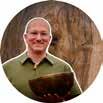








The Crazy Wisdom Community Journal • May through August 2023 • Page 14 Acupuncture Astrology/Chart Services NORTHERN SKY AND BEYOND, LLC Astrology with Alice Charts • Readings • Star DNA www.northernskyandbeyond.com info@northernskyandbeyond.com 734.892.8809 Birth 7notesnaturalhealth com 248-962-5475 contact@7notesnaturalhea th com 3830 Packard Road Suite 120 Ann Arbor Michigan 48108 Rob Meyer-Kukan, LMT Bodywork: sound therapy, massage, reiki, reflexology color therapy & natural health consultations Natural Healing Center 2002 Hogback Rd. Suite 14 Ann Arbor, MI 48105 734-649-2891 (C ) denisebheld@gmail com www.a2re exology.com www.facebook.com/A2Re exology Resources for Conscious Living Bodywork/Bodymind Therapy Books From the streets of Detroit to the ashes of the Holocaust paulineloewenhardt.com paulineloewenhardt@gmail.com Breathwork Jackie Miller Certified Breathwork Facilitator 734-883-7130 / jackie@thisbreath.com Ann Arbor & Ypsilanti, Michigan thisbreath.com
DIAMOND WORK MICHIGAN
Presenting the teachings of The Diamond Approach®




• Introduction to Spiritual Inquiry, “Exploring the Present Moment” at the Interfaith Center for Spiritual Growth on June 25, at 10:45 a.m.


• Next class begins September ’23, exploring joy, truth, reactivity, curiosity, and more.


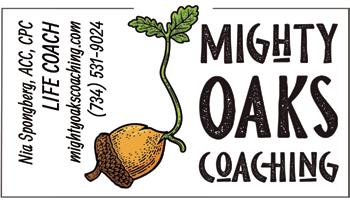


• For more information contact Lou Weir, Diamond Approach Teacher at: diamondworkmichigan@gmail.com

Equine

The Crazy Wisdom Community Journal • jMay through August 2023 • Page 15
cheerful mind perseveres, and the strong mind hews its way through a thousand difficulties.”
Hypnosis Life Coaching Catalyzing revolutionary healing through Trauma-Informed Homeopathy Intrinsic Coaching Holistic Health Education Kellie Mox, MPH, DCHM, CCH Kelliemox.com heal@kelliemox.com | 734 - 476 - 0349 Free,20-minuteexploratorysessionfornewclients CHÉRIE ANN McMULLEN Holistic Health Practitioner Nutritional Consultations Vitamins/Herbs/Homeopathy 734-355-5369 2223Cherieann@gmail.com
“The
— Swami Vivekananda
Therapy Holistic Health
Resources for Conscious Living Kate Roos, MAAT, ATR, TCTSY-F Movement & Art Therapy www.kate-roos.com 734-221-0202 A Trauma Informed Practice For Teens and Adults Offering Online and In Person • Call for course dates • State licensed school • Personal enrichment • Help people reach their goals • Supervised practical experience • Add a new modality to your practice (586) 899-9009 • clinicalhypnosisinstitute.com Cheryl Beshada, C.M.Ht Hypnosis Classes & Sessions
Expressive Arts Therapy Diamond Approach
RAVENSONG COUNSELING Individual & Small Group Sessions for Ages 10+ www.ravensongcounseling.com (734) 604-7074 Equine Therapy at Hidden Creek Healing Farm Believe in your journey IFS • Enneagram • Career • Relationships Jennifer Lee Stein MA, LPC lifeiscurrent.com COUNSELING & INTUITIVE COACHING lifeiscurrent@gmail.com 734-707-7766
Music/Music



Psychotherapy/Trauma Therapy


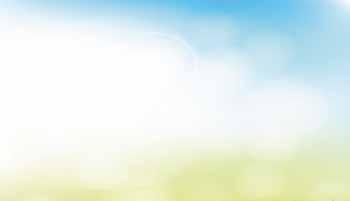
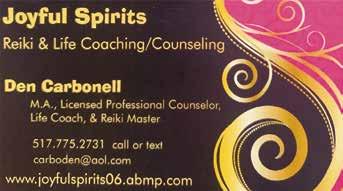







The Crazy Wisdom Community Journal • May through August 2023 • Page 16
Lessons
ANN ARBOR WALK AND TALK THERAPY Fran Cowen Adler, LMSW An experienced therapist’s novel approach to counseling, for teens and adults Let’s walk and talk! For information and to make an appointment: 734-429-2076 a2walktalk@gmail.com
Mental Health Resources for Conscious Living
Gardening “Know the enduring happiness that the love of a garden gives.” – Gertrude Jekyll Rosina Newton Organic Gardening Coach/Designer/Speaker Rosina@NewEarthHomeAndGarden.com NewEarthHomeAndGarden.com 512-638-3401 Massage School
Reiki Organic

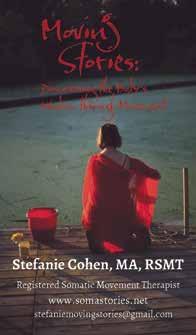













The Crazy Wisdom Community Journal • jMay through August 2023 • Page 17 Our advertisers appreciate your patronage Resources for Conscious Living Divine Sanctuary 1524 Horton Rd. Jackson, Michigan 49203 517-247-8400 Metaphysical Supplies mydivinesanctuary.com Sacred Sexuality Somatic Therapy Spiritual Healing Theatre Groups Theatre from Scratch Neighborhood Theatre Group www NTGYpsi org info@ntgypsi org Retreats Resources for Conscious Living ADS for as little as $99 an issue with a 3 issue agreement ($295.00) Contact Tana at tana@crazywisdom.net for more information. Reflexology
JOOB ACTIVEWEAR — ANN ARBOR CLOTHING COMPANY — AIMS FOR FAIR TRADE, CLIMATE NEUTRAL FASHION

Better Beats Perfect
By Kirsten Mowrey
The Crazy Wisdom Community Journal • May through August 2023 • Page 18
Joob Activewear —
Ann Arbor Clothing Company


“How’s the fit?”
The hiking pants swished as I walked, hugging my legs as I squatted, lunged, and brought my knees to my chest. Not as tight as a legging but not as loose as a typical hiking pant, they ghosted over my skin, covering it, but not hampering movement a bit. I pushed my hands in the front pockets, felt the tug at the elastic waist, and checked out the zippered back pockets. A barely-there logo of an elephant shimmered near my left hip on the black fabric. I found the fit comfortable. I could wear these pants all day.
I sampled these pants courtesy of John Ames, co-founder of local activewear company Joob activewear. Located off Jackson Road, I drove down a short gravel driveway that ended at four buildings surrounded by mature trees and a green lawn perfect for concerts or picnics. It was early on a Friday and the setback made the area surprisingly quiet, even though traffic rushed past. I was in the retail area, directly off the entrance, a space lined with professional photographs of beautiful people in outdoor settings, and racks with displays of pants, jackets, shirts, and a table covered with caps and beanies.
As I walked around, Ames’ craggy kind face was knitted up with concern, as he was looking for feedback on this new design. A request from a customer, these pants were designed to meet the needs of outdoorswomen whose bodies have changed, whether through pregnancy, age, or other life experiences, and he is eager to find out how they work for me. When I gave him the thumbs up, a big grin cracked his face.
Joobwear—“Joob” is Thai for kiss—has a small line of well-designed, sustainably-sourced, and climate-friendly clothing. Their name speaks to their vision of “kissing” the earth, living with a smaller environmental footprint, and blending the founders’ love of nature with a thorough, thoughtful dedication, shifting fashion (one of the most polluting industries in the world) toward a more sustainable enterprise.
When you go to the mall or online to purchase clothing, what are your primary priorities? Fit? Style? Fabric? Attire appropriate for an event? In the documentary The True Cost: Secrets behind the Fashion Industry, designer Orsola de Castro calls clothing “our chosen skin.” Yet most of us have no idea what goes into making our fashion: we don’t know the processes behind dying, creating, and sewing the fabric; we don’t know how much water is used, who sewed the garment and how well they were treated or paid, and we don’t know the environmental impact. How would we choose differently if we did know?
Joobwear is asking these questions. Ames is an avid fly fisherman and Chicago native with a background in marketing, management, and strategy and organizational behavior. He moved to Ann Arbor to join Llamasoft, a tech company focused on supply chain optimization and simulation software. Llamasoft helps companies redefine how they manage their supply chain from suppliers to customers. While there, Ames met his wife, Nicha Sangiampornpanit. A Thai native, Sangiampornpani has a master’s degree in industrial engineering and operations research, and is the other co-founder of Joobwear. Ames explains, “I’m more the soft skills and she’s more the detail person, so it’s a good mix.” It was a work trip that sent them into the fashion world.
Ames said, “My last job with Llamasoft was building the Japan office. My wife and I spent two years in Japan. That’s where we started to notice [activewear]. We ski and we hike--we’re pretty active: we do yoga and we used to run. We noticed the Japanese people look like everyone’s wearing tailored clothes. They look fabulous when they’re hiking or skiing or they’re going out to the mall. When I think about fly fishing gear, a lot of times their fit isn’t that great. And we started thinking, if you’re doing all these different activities, why do you need to have clothes dedicated to [only] one activity? That’s where the ideas started.”

A request from a customer, these pants were designed to meet the needs of outdoorswomen whose bodies have changed, whether through pregnancy, age, or other life experiences, and he is eager to find out how they work for me.
Returning to the States, Ames and Sangiampornpanit pulled from their work life to pursue their passion project. Ames explained, “One of the early investors to Llamasoft was Nike Green Ventures. From working with them, I learned the importance of quantifying carbon emissions. software actually optimized around cost and efficiency. For example, say you want to optimize your total supply chain cost, but you also have high emitting suppliers or facilities. You want to look at the trade-offs of going to lower emissions. Sometimes it means a higher cost, but a lot of times it just means looking at different suppliers that are more efficient.”
The Crazy Wisdom Community Journal • May through August 2023 • Page 19
Owners of Joob Activewear, John Ames, his wife, Nicha Sangiampornpani, and their daughter, Jaya.
Where do you start building a vertically-sustainable apparel business from the ground up? With his expertise at Llamasoft, Ames thought, “Okay, I can piece together the supply chain.” He began with fabric, the base material. The couple wanted it to be sustainable, but what is sustainable? Ames said, “I started doing, and I still do, this search for fabrics and cut and sew facilities. I found KenDor textiles (kendortextiles.com) out of Vancouver and the founder there, Paul King, has been working on finding sustainable mills for brands for several years now. I learned a lot from him and his team about what sustainable means from a fabric perspective. Take super fine Merino. Some people say sheep emit methane. That’s true, but this is a completely biodegradable product. You have to look at the life cycle emissions and it’s really hard to find that calculation of life cycle emissions for a particular fabric.
After getting the details nailed down on the fabric, then there was production. “The first partner we had for cut and sew was in Cleveland, it was a husband-andwife team. Then, I found this company called MCM (mcmenterprise. net) out of Brooklyn.
Joanne Young is their lead design person for us. I showed her our beanie.” Ames grabs a classic knit beanie from the table in the middle of the retail space, the type you see everywhere, but this one is of merino yarn in a shade of old bronze. “You think like an item like this, building something like this would be easy, but the first one was way too big. The next one looked like a swim cap. I got on the phone with Joanne and right away she got it. And then, when the first prototype was nailed, I said, ‘this is gonna be one of our partners’.”
But the couple wanted to do more than just use sustainable fabric. They had gotten married in Dexter and had a second ceremony in Thailand. Ames said, “We were driving in an area of rundown buildings. Nicha said “God, I wish I could do something to help my country.” And so, the couple decided to make their brand fair trade as well. Sangiampornpanit’s connections built this component, Ames explained. “One of Nicha’s friends from University of Michigan, her father did cut and sew for Nike in Bangkok, and he has a zero-waste facility. He had adopted Toyota’s small batch production and quality management practices. He utilizes automotive practices to cut and sew, which I thought was really amazing.” The couple toured the factory while in Thailand and have worked with them for some products.
After their time in Japan, their lives changed: Llamasoft was purchased by a private equity firm and Ames, as an early employee, gained a level of financial freedom. He chose to put more time and energy into Joobwear. He explained, “I like to build stuff. I wanted to do something that I could touch and feel. We like active wear but there’s certain things with the fit. There’s things with the sustainability and with the fair trade that I really don’t like about apparel. Apparel’s really a crappy industry, really crappy.”
For example, that facility in Bangkok? Ames said, “Nike stopped using them because he paid his employees a living wage and educated his employees to do more than what they were doing for that job, which I thought was really cool. And this is typical of apparel. They’re not transparent. They treat employees really badly and they’re completely focused on the lowest cost. H & M, Zara, and fast fashion just drives me crazy. Why do you need to have new stuff every season?”
I suggested to Ames that fashion is where food was forty years ago, when we just ate what was at the grocery store, never asking about what chemicals had been used, who was exposed to those chemicals to pick the produce, how far had it been transported. While small food co-ops had begun to ask these questions in the 1970’s, it wasn’t until the success of bigger stores, such as Whole Foods, Sprouts, and Fresh Market that more consumers and then corporations became interested in organic and fair-trade practices.
Ames agreed. “I think the apparel industry is that far behind [40 years]. Absolutely. It’s not just about the material, but it’s about water usage, water waste, labor practices, things like cotton. People don’t realize that a cotton t-shirt takes a tremendous amount of water. It uses dyes that pollute the water, usually the labor practices are—unless it’s organic or there’s some certification on how they source it— really bad in terms of their production. What type of power do they use?
They have no clue. It’s true with a lot of apparel manufacturers. Then I asked, “Are you guys doing anything with measuring your [carbon] footprint or looking at innovative materials? They replied, “Nah.”
Unlike his Ohio producers, Ames does know about his carbon footprint. Working with consulting firm South Pole (southpole.com), Joobwear did an endto-end analysis of their carbon footprint in 2018 before selling any product. They also invested in their rented building. Solar panels face south, and the couple is installing electric heaters to run off the solar, replacing the gas furnace. The interior is painted deep gray with orange and plywood accents. You enter into the aforementioned retail space, below a beautiful mural with a happy elephant proclaiming, “Every day is Earth day.” Beyond it and past a bathroom, you go up two steps to Ames’ workspace, where a laptop in a frame seems to hover over a keyboard, and the room is backed by a small kitchen. To the right are two chairs, a table, and a doorway that leads to the processing room, where orders are fulfilled and packed for shipping. Everything compactly located, keeping the footprint small and efficient, but with space for expansion. “I wanted to be the anti big company,” said Ames. “That’s why I like this small place. I want to make really good quality stuff. I want to make it technically competent, but wrapped around sustainability, fair trade, closed loop. I try to be zero waste as much as possible, and to use innovative materials as much as possible. I feel like apparel needs to get back to small, sustainable, and then scale from there.”

Sustainable is a complicated definition in fabric.
Sustainable is a complicated definition in fabric. One of the main items Joobwear uses a lot is recycled plastic, from all of those plastic bottles we put in our recycling. It’s environmentally friendly because it’s using these petroleum products again, giving them a longer life cycle then the original use they had and decreasing our pumping oil from the planet. But, they also wear and disintegrate, which means they shed plastic, called micro-plastic. Micro-plastics are a huge concern, as they float and they concentrate in the organs of all beings that ingest them, such as seabirds, turtles, fish, and humans. It’s for this
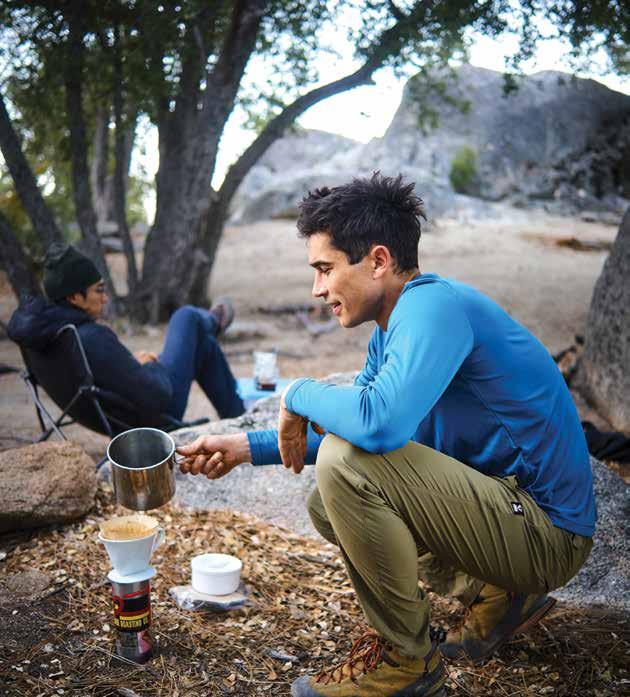
The Crazy Wisdom Community Journal • May through August 2023 • Page 20
JOOBWEAR—“JOOB” IS THAI FOR KISS—HAS A SMALL LINE OF WELLDESIGNED, SUSTAINABLY-SOURCED, AND CLIMATE-FRIENDLY CLOTHING
Better Beats Perfect
reason I’m a fan of natural fabrics such as wool, linen, and cotton. And yet, we have a vast amount of plastic waste that we need to find a use for other than concentrating it in our water supply.
Ames agreed with me. “’Better beats perfect’ is a saying that we say a lot in tech.

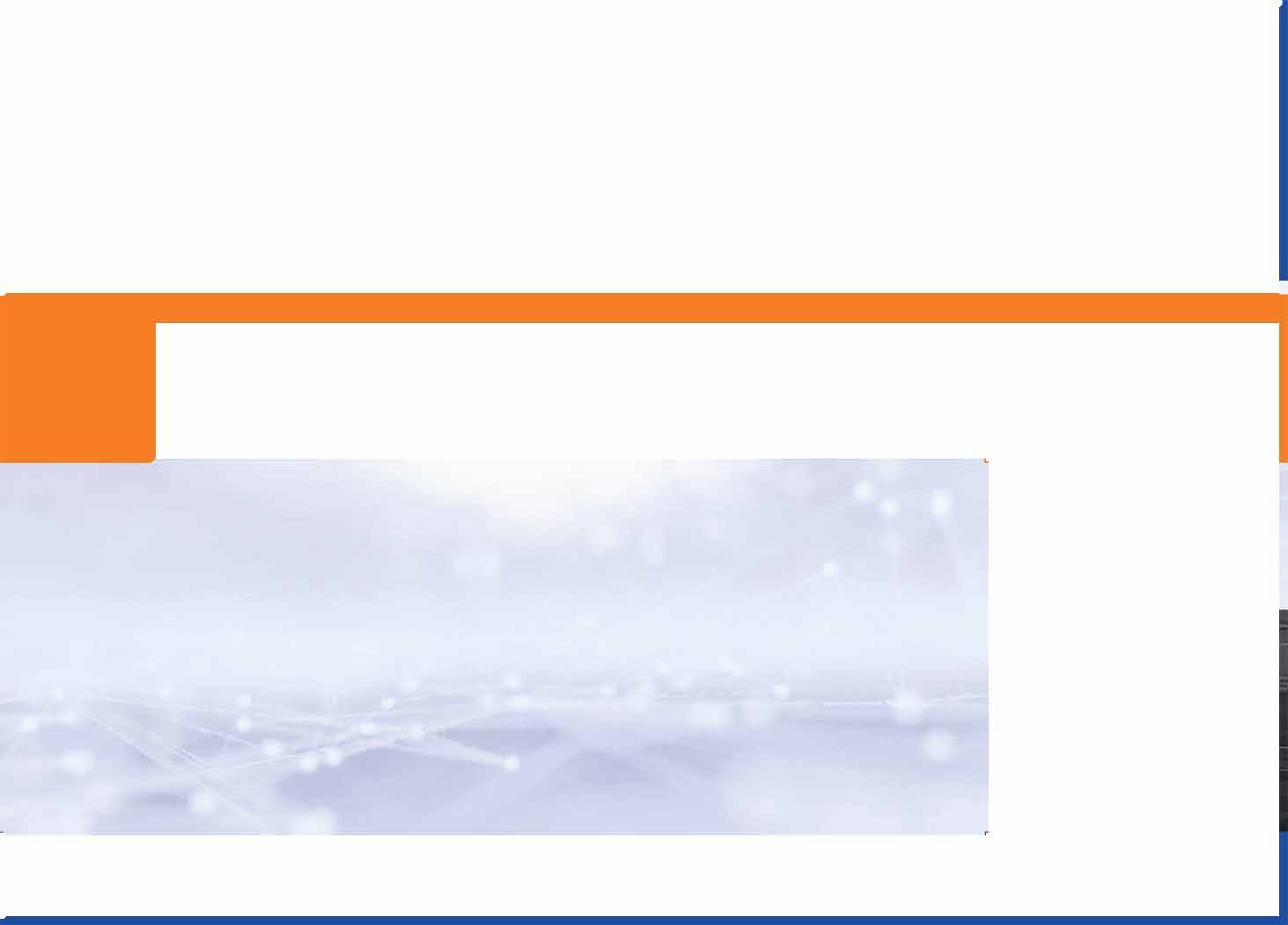
I don’t know where the answer is with micro-plastics. I do know that we have a ton of single use plastic out there that we need to do something with. We need to recycle it for sure, the recycling rate here is just horrendous. When we lived in Japan, I had like six garbage cans in our apartment. Their recycling rates are in the eighty to ninety percent. For the United States, last I checked, it was like 7%.”
But as Ames pointed out, “How is a consumer going to know what’s good? Bamboo is supposedly great, but it uses a ton of chemicals in the dye process.

For example, that facility in Bangkok? Ames said, “Nike stopped using them because he paid his employees a living wage and educated his employees to do more than what they were doing for that job, which I thought was really cool. And this is typical of apparel. They’re not transparent.”

The Crazy Wisdom Community Journal • May through August 2023 • Page 21
Joob Activewear Robert Krasnick, M.D. specializes in: • Prolotherapy • Platelet Rich Plasma ( PRP) • Bone Marrow concentrate ( cellular therapy ) • Prolozone • IV Therapies including ◦Myers Cocktail ◦Glutathione ◦NAD+ ◦Ozone/UBI
Sacred Sound Journey Cacao Ceremony
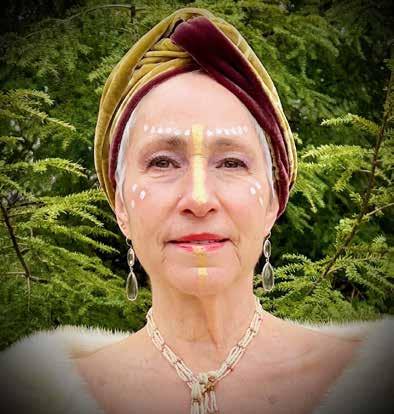
Joob Activewear
Ann Arbor Clothing Company


Cotton is organic and biodegradable, but it uses a ton of water, you know? How do you pick and choose?
It’s really hard. I mean, if it’s hard for someone in the business to be able to pick what’s the best material to use, how is the consumer going to know? There’s no standard. It’s a wild west now about what people communicate. And really how, how are you certifying it? I think the next big innovation is going to be on closed loop supply chains. Things like microplastics are going to be addressed. Everybody that produces a single use container has to be responsible for recycling and reusing it. It makes sense. If you’re producing something, and it has a package, you should do something about it.”
Ames gestured to the grey t-shirt he was wearing. Like all of Joobwear’s products, the material is soft, and the fit is close but not tight. “This is actually a prototype shirt with a material called Naya Acetate, which is made from recycled PET (polyethylene terephthalate, a plastic used in both fiber and bottle production) garment waste and sustainable, transparent, traceable, wood pulp. This is half biodegradable, because the recycled PET cannot be, but this one doesn’t use any water or dyes.”
Ames is rethinking classic clothes, particularly classic fly-fishing clothes, such as flannel shirts and cotton tees. In his office I could not stop stroking a red checked, long sleeve button-down shirt of modal and silk, completely biodegradable, that feels light as a feather and whispers along my skin.
I touched clothing swatches of a hundred percent recycled fleece that Ames is prototyping for a vest which will have a partially recycled nylon exterior, providing water repellency without PFC’s. Joobwear has also partnered with Mako, a manufacturer of fly-fishing reels, to produce apparel. They offer a long sleeve silky feeling 100% recycled shirt treated with Chitosante. As any outdoors person knows, while poly fiber is great for wicking and durability, it stinks if you sweat in it a lot. I have old poly shirts that are only fit for solo hikes at this point. Chitosante takes care of that by using crushed shrimp and crab shells in the creation of the fiber to help with odor. Ames smiles proudly when he shows me the shirt, “[Mako] said they searched Patagonia and Sims and said our shirt was the best fit and comfort.” To out-design such established brands is a huge endorsement of what Joobwear is doing.
Besides their collaboration with Mako, Joobwear is maintaining their retail and online spaces. After leaving Llamasoft and building Joobwear through attending pop-up shops in 2018 and 2019, Covid shut down everything and Ames started working on a new start-up with his old collaborators. Sangiampornpanit has remained at Llamasoft and gave birth to the couple’s daughter, Jaya, last year. Joobwear has moved to being more of a passion project for the couple, as they focus on raising their daughter. When asked about the future, Ames replies, “I just want to continue to innovate and spread the word about sustainability, get better at what we can do, help people make decisions and still have cool, sustainable, stylish stuff.” Given how their pants feel and knowing the thought behind their creation, I can say he’s well on the way to his vision.
Kirsten Mowrey is a somatic educator who enjoys getting out in nature, whatever the weather, whenever possible. You can find her on the web at kirstenmowrey. com

Joob activewear is located at 5007 West Jackson Road, Suite A in Ann Arbor, MI 48103. You can contact them at 734-277-2510, or by email at Hello@JoobWear.com, or check out their website joobwear.com. Currently retail hours are by appointment only.
Author's note: Between finishing this article and publication, the Center for Environmental Health in California published its test results of women's sports bras and athletic wear. The results showed high levels of BPA, a known hormone disruptor. BPA was found in polyester based clothing containing spandex from brands such as Athleta, PINK, Asics, Brooks, Nike, and FILA. These results emphasize the importance of supply chain integrity and doing the due diligence that companies such as JOOBwear have done. For more information, check out: https://www.cnn.com/2022/10/13/business/bpa-sports-bras and here: https:// health.ec.europa.eu/system/files/2022-08/sccs_o_240.pdf
The Crazy Wisdom Community Journal • May through August 2023 • Page 22
www.victoriaschon.com
Namaste Katie,
I am joining the long line of people who have developed neck issues with increased time on my computer and hovering over my phone in the last few years. I have been incorporating more stretch breaks during the day, though am curious if there is something more specific I can do. Thank you.
Marti, Ann Arbor
Dear Marti,
Such a common experience (as I sit on my laptop, on my couch). So many of us have changed the orientation of our work, our school, and the patterns of our lives over the last few years. These changes invariably impact how we hold and move our bodies. The more time we spend in any particular posture, the more our bodies adapt to that space, even if those adaptations are not suited to the rest of our movements.
Thomas Myers in Anatomy Trains discusses Upper Crossed Syndrome, where we lead with the chin, placing extra stress on the neck and upper back to support the weight of the head. The more time we spend hovering over phones and devices, the more we rely on these smaller muscles to take on roles they were never intended to take over.
Namaste, Katie...
Whether you're a seasoned yogi or getting ready to roll out your mat for the first time, here you'll find a variety of useful tips from local yoga instructor, Katie Hoener.

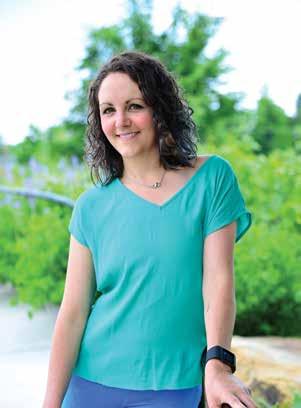
Namaste Katie,
I am a regular practitioner of yoga and am curious about the uses of Ujjayi Breath. I took a more restorative class the other evening that used Ujjayi and it was a first for me, and I liked it.
Beca, Ypsilanti Township
Namaste Beca,
What a delightful question! Ujjayi Breath, the breath of victory, is one of the foundational Pranayama practices in yoga. Ujjayi Breath utilizes a restriction/constriction in the back of the throat that slows down the inhale and the exhale. Studies have shown that this change in breath pattern activates our parasympathetic nervous system, which contains many of the soothing mechanisms of our response network. From this sense this breath practice is calming and regulating. With this impact it can be ideal for a restorative practice.
Ujjayi breath is typically used for more invigorating classes and practices, as it takes additional focus and can create heat throughout the body. That said, once we are comfortable with the practice, it is at times utilized for restorative practices.
For those of us less familiar, Ujjayi breath can be eased into by taking a comfortable inhale, and on the exhale making the HA sound, as though you were trying to fog up a mirror. See if you can stretch out the exhale as much as feels safe for your body. Try that a few more times with the mouth open, seeing if you notice the body relaxing as you elongate the breath. See if you notice any release as you soften the breath. Next, try a few rounds where halfway through the exhale we close the lips, continue the same sound, the same constriction through the exhale. Once you feel at ease with that restriction on the exhale, we have the opportunity to try that same feel and sound through the throat on the inhale as well. I have heard this described as drawing air through a straw, which feels accurate, this beautiful long draw of breath. The more we are able to allow this process, and maintain our focus on these longer inhales and exhales, the more restorative the breaths become.
Namaste Katie,
My sister is a yoga regular and is always talking about the cooling and the warming sides of the body. She will then talk about how she wants to start on different sides for different postures. Can you enlighten me on this practice?
Drake, Ann Arbor
Namaste Drake,
The nadis are a wonderful thing to explore within a practice, should you choose. I was initially training in Hath –which translates as Sun, Moon. Hatha is a practice which explores the light and the dark, the heat and the cool, the inhale and the exhale. Within these balancing practices that make up Hatha Yoga are the nadis, energy channels within the body. There are three main nadis: Ida, Pingala, and Susumna.
There are many schools of yoga that use nadis to inform movement, pranayama practices, and much more.
Ida is described as the cooling side, originating from the base of the spine, crisscrossing through the chakras and ending in the left nostril or the left side of the third eye (descriptions vary). We describe the Ida as representing the moon, the releasing and grounding parts of the practice. Pingala is the fiery side, crisscrossing the body in opposition to Ida and ending on the right side of the nostrils or third eye. We think of Pingala as the energizing side of the practice, full of motion and lift. Lastly Susumna runs up the spinal column and out through the crown of the head. Susumna carries all our purified energy through the chakras and helps connect us with our higher, true selves.
There are many schools of yoga that use nadis to inform movement, pranayama practices, and much more. I was taught in a manner similar to your sister. I start my warm-ups and cool-downs with the left side of the body, and more invigorating poses with the right. It is something that I learned from my teachers and have found makes sense for me and my practice. If these energetic connections make sense to you, absolutely enjoy them!
A posture that beautifully opens up the throat and allows the muscles along the backside of the neck, including the levator scapula and the trapezius, to relax is Matsyasana or Fish Pose. To come into Fish Pose start by laying down on your mat, or a surface where we feel solid. Gently roll from side to side to allow the arms to slide lightly under the torso, with the hands under the glutes. Engage the muscles of the core to lift through the abdomen and bend through the arms—we are creating something akin to a beach chair with the body. Once we feel supported and lifted off the shoulders, we have the option to lovingly dip the head back. The head can rest lightly on the mat, on a prop, or hover in a space that feels safe. When you feel secure take a few breaths and allow for that traction to create space in the neck. After a few breaths, engage the abdominals once again and lift our way out of Matsyasana. Finish by taking a nice Forward Fold Pose (Paschimottanasana), if that feels appropriate for your body.
Fish Pose
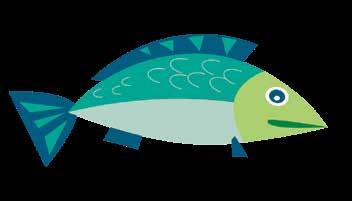
The Crazy Wisdom Community Journal • May through August 2023 • Page 23 YOGA COLUMN
So many of us have changed the orientation of our work, our school, and the patterns of our lives over the last few years. These changes invariably impact how we hold and move our bodies.
Out of MyCOMFORT ZONE


The Crazy Wisdom Community Journal asked a number of leaders in southeastern Michigan’s conscious living community to reflect upon times in their lives that they’ve left their comfort zones to venture out in new ways. In the distant past or much more recently, we asked, what did you do, what inspired you, did it change you, inside or outside, big or little? Did you attend a new class, take an adventurous trip, go skydiving, stretch beyond a long entrenched boundary, start a new relationship, or end an old one, take a leap, retire, join the Peace Corps, go on a night trek in the wilderness, or just do something way out of the ordinary?
Stretching Out of My Comfort Zone
Rachel Portnoy, JD, CYT, CHC, lives in Ann Arbor with her husband and two adorable dogs. She was a lawyer prior to staying home to raise her children. She has been teaching yoga in the Ann Arbor area for the last 17 years, teaching exclusively at Tiny Buddha Yoga for the past eight. She is also a certified health coach. Learn more about Tiny Buddha Yoga online at tinybuddhayoga.com.
By Rachel Portnoy
Generally speaking, my comfort zone is not small. I have lived in foreign countries, trekked in the Himalayas, paraglided off a 5,000 foot cliff, flown in teeny tiny planes over the Amazon rain forest, stood on my head on various mountain tops, and held a giant anaconda around my neck (that one was mostly for the photo op). But when asked to write an article about stepping out of my comfort zone, I immediately knew what I’d share. And it turns out I am not alone in this fear. In fact, it comes in at number two on the list of people’s biggest fears. It is of course, the fear of public speaking (in case you’re interested, fear of death is number one on the list).
But let’s go back in time a bit. I discovered yoga in my late 30s. I didn’t know exactly why I was so drawn to it, but it made me feel better. It took away my aches and pains and helped me feel lighter—both physically and emotionally. Even better, it settled my busy mind. I had trained as a lawyer, worked in nonprofits and at the Federal Court house for a few years, but ultimately decided to set aside that part of my life to stay home with my two young sons. The yoga seemed to make me a more patient and loving mother to my boys and partner to my husband. How could this simple activity I participated in a few times a week have so many benefits?

These questions prompted me to embark on a yoga teacher training program at the Center for Yoga with Jonny Kest in the Birmingham/Bloomfield area. It was 2005/2006 and vinyasa yoga was not as ubiquitous as it is now. I was met with doubt and concern by certain family members and yet I felt called in a way I could not ignore. The training program consisted of the study of yoga texts and philosophy, self-reflection through journaling, meditation, asana practice, and of course, learning to teach. That last part interested me the least—mostly because of my fear of public speaking. I had meticulously circumvented it most of my life, clumsily powering through in a state of near shut down when it could not be avoided. I even asked my teacher, Jonny, not to spontaneously call on me during class to practice teach as he did with the other students to avoid my discomfort. And despite his gentle messages that what we avoid is likely what we need the most, he respected my request.
When asked to write an article about stepping out of my comfort zone, I immediately knew what I’d share. And it turns out I am not alone in this fear. In fact, it comes in at number two on the list of people’s biggest fears.
The Crazy Wisdom Community Journal • May through August 2023 • Page 24
As the training progressed, I told a few friends what I was doing. Apparently, word spread, and people began asking me to teach—mostly in informal settings. At first, I avoided it, consistent with my previous pattern, but eventually I began to say yes. I was terrified, and at first, I’m certain that I was terrible. My heart raced and my voice quivered. My sentences would trail off into a barely audible whisper. I would sometimes forget an entire side or simply go blank. These mistakes were often exacerbated by technical difficulties with playlists and sound systems. But no one ever seemed to notice or at least they didn’t say anything. Instead, they seemed happy to be there and grateful for the class. I kept at it and improved a bit. I began to teach at health clubs and yoga studios. What sustained me during those awkward first few years was the desire to share a practice that helped me so much. A practice that taught me how to connect to my body, to live from my heart and to stay present in the moment through breath. I wanted to share this powerful practice even if it made me profoundly uncomfortable to do so. In retrospect, it makes perfect sense that the practice that reconnected me with myself helped me overcome one of my greatest fears. And the fact that it happened organically, without forcing or pushing through, feels consistent with the practice of yoga itself.
The yoga seemed to make me a more patient and loving mother to my boys and partner to my husband. How could this simple activity I participated in a few times a week have so many benefits?

Over the seventeen years that I’ve been teaching vinyasa in the Ann Arbor area, there were days here and there when I felt like a particular class was terrible and I questioned why I was even teaching. It was on those days, without fail, that a student would approach me after class and tell me how wonderful class was and how much my classes helped them through a difficult period in their lives. And I’d be right back on track.
Visit

Triple Crane Retreat Center is committed to serving a wide, diverse, and supportive community of spiritual seekers and practitioners from our surrounding communities in Southeast Michigan. It is our goal to cultivate a tranquil environment for personal and group retreats, as well a residential and local commuter classes and programs where spiritual seekers with a desire for authentic spiritual growth can relax, unwind and submerge themselves in spiritual practice.
Residential Retreat and Workshop Space
Available for Group and Personal Retreats TCRC also serves as a retreat place for other like-minded individuals, sincere spiritual seeker and organizations offering workshops and retreats for practitioners of their own. Contact us for more information on available residential retreat space.

Work-Exchange and Volunteers Program
Triple Crane is growing it’s work exchange program. We are looking for committed and talented individuals to help co-create a thriving practice community. Visit our work-exchange and volunteer programs website page.
In those early years, I would prepare by writing out my class plan. I would review it and even practice it before teaching. I’d also research and write out a corresponding theme, based on yoga philosophy. When I made a mistake, I was mortified, and I’d ruminate on the mistake for days. These days when I forget a posture or mix up which side we’re on, I let it go and laugh it off. Humans are imperfect, life is imperfect, and the more we embrace that beautiful imperfection, the more loving and compassionate we can be to ourselves and one another.


At first, I avoided it, consistent with my previous pattern, but eventually I began to say yes. I was terrified, and at first, I’m certain that I was terrible. My heart raced and my voice quivered. My sentences would trail off into a barely audible whisper. I would sometimes forget an entire side or simply go blank.
As time went on, I was able to let go of my notes, and create a class flow on the fly. As more time went on, I could weave in a theme, also with no preparation, but rather based on what my students needed to hear that day. Those classes always feel the most intuitive and profound. Sometimes I don’t even know where the words come from as they appear to flow through me and not from me. I could never have imagined being able speak like that in front of a group when I first entered my teacher training program all those years ago. We learned in that program that the opposite of love isn’t hate, but fear. Sometimes hiding beneath the fear is a power or strength waiting to be cultivated. And when we confront the fear and step out of that comfort zone, we may just discover our true calling—what we truly love to do. I’m so grateful to those students in the early days who suffered through my classes and those who offered encouragement along the way. I can now share my love of this powerful healing practice with grace and ease. And what a lovely journey it’s been.
The Crazy Wisdom Community Journal • May through August 2023 • Page 25
Triple Crane Monastery is now TripleCraneRetreat.org | 7665 Werkner Road, Chelsea MI 48118 Office@TripleCraneRetreat.org | 734.713.6163
gratefully accepted Retreat and workshop space available. Call for details. 734.713.6163
Donations
classes, programs, retreats, and MORE! TripleCraneRetreat.org
our website often to learn about all of our upcoming events, yoga and meditation
breathe
What’s New in the Community
By Lynda Gronlund
This ongoing column features upcoming events within Ann Arbor/Washtenaw County and surrounding areas’ Body/Mind/Spirit communities, new (during the past year or two) practitioners and holistic businesses, new books written by local/regional authors, new classes, as well as new offerings by established practitioners and holistic businesses.

Local musician Curtis Glatter
Drummer, improviser, composer, and teacher, playing “a little bit of everything” from classical to rock to jazz and experimental music, electro-acoustic chamber music under narration, and straight percussion.
See Listing on page 30
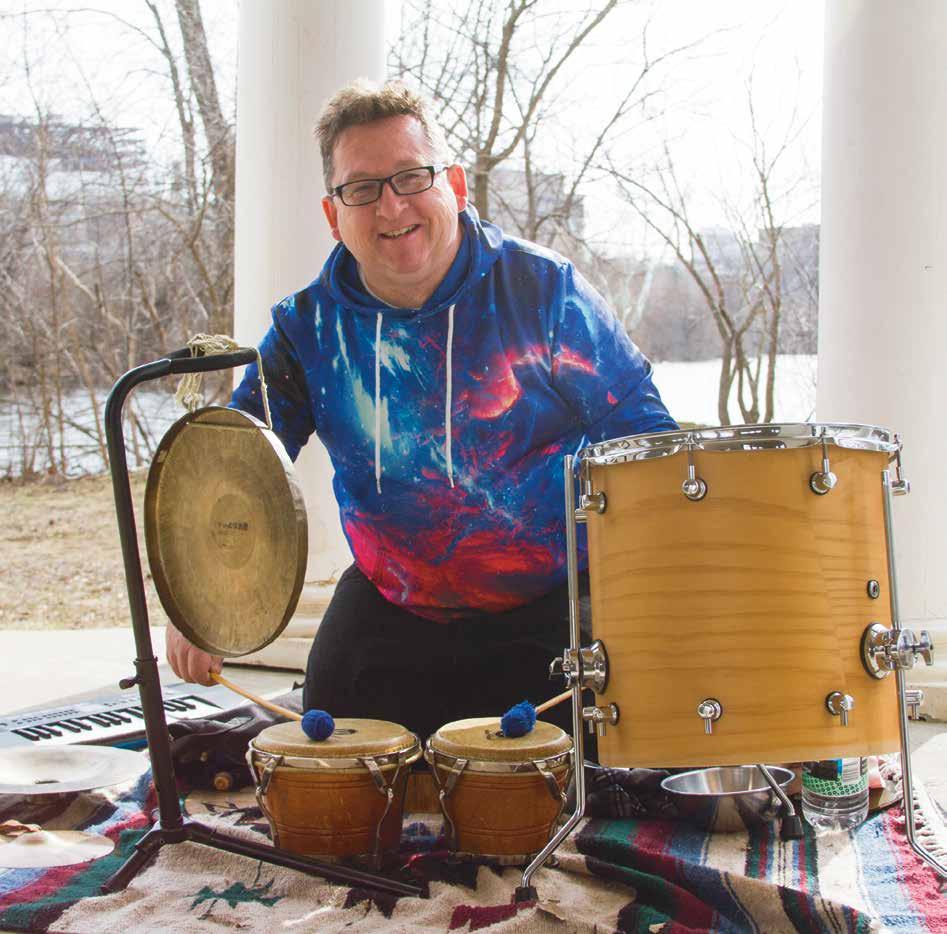
The Crazy Wisdom Community Journal • May through August 2023 • Page 26
Photo by Susan Ayer
New Offerings by Established Businesses and Practitioners



Ann Arbor-based certified health coaches Alexis Adams and Katy Gladwin have teamed up to provide an online health support group for women called Wholistic Vitality.
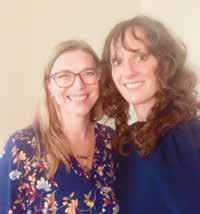
Gladwin is a birth doula and childbirth educator who pursued and received her certification as a health coach in 2017. Adams holds a master’s degree in exercise physiology, is a certified plant-based nutritionist, and became a certified health coach in 2021. Both specialize in women’s health concerns from the onset of menses through menopause and beyond. The two met when Gladwin served as a birth doula for Adams. They launched their collaborative online women’s health support group service in January of this year. Both still provide individual services and coaching as well.
“We support women in the ‘obvious’ areas of concerns such as nutrition, movement, and stress management support, as well as the not so obvious health paradigms such as mindfulness, creativity, and joy” Adams said. The groups meet online via Zoom weekly for three weeks out of the month. The fourth week allows for sixty-minute one-on-one coaching calls for each participant. Each month has a particular focus: May is “Mindfulness and Embodiment–Intro to Somatics,” June is “Pillars of Health,” July is “Finding Physical Fun,” and August is “Organizational Skills.” Topics of past months have included “Seasonal Defense Support, “Hormones 101, “Healthy Boundary Setting, and “Cardiovascular Health for Women.”
Adams explained that while she and Gladwin are highly educated and have a wealth of knowledge, “women need more support rather than being talked at more,” and everyone can learn from everyone else’s life experiences. All group members have an opportunity to share, celebrate each other’s successes, and give feedback. Each 90-minute Zoom meeting starts with some mindful breathwork, followed by ten to fifteen minutes of educational content, and then the majority is spent “communing” with group members. The group is capped at ten members with a capacity for Adams and Gladwin to hold up to two groups in a given month if there is demand. Between sessions, members can communicate through Voxer, an app that allows for private group texts and voice memos. There are journal prompts, podcast links, and other resources. Members can also ask Gladwin or Adams questions privately.
The month progresses from week to week. The first week is for “noticing” whatever the focus of the month is, and how it affects pillars of health like energy, sleep, and joy. The second week is for “shifting”—choosing some strategies and implementing one or two. The third week is for “reflection”— coming back to the group with what members experienced and getting a little more information on the topic. During the fourth week each member receives individual coaching to dive deeper into the topic and how it is related and is working, or not working, well for the individual.
Adams said that the ideal participant is a woman who wants to be supported in a community of other women, who have some health challenges such as headaches, burnout, and hormone imbalances, feel like they have tried everything without success, and are not getting the answers they need from doctors and their own research.
More information is available online at wholisticvitality.net. Alexis Adams and Katy Gladwin can be reached via email at wv4women@gmail.com.

Canton-based Dr. Allison Gilson has been a licensed psychologist since 2012 and opened her private practice, Momentai Wellness, in March of 2021.

She offers virtual therapy and specializes in clients with trauma and dissociative disorders. Recently, she received training in hypnosis as part of a professional conference she attended. She learned about gut directed hypnosis, which is a way to use hypnosis to help manage symptoms of Irritable Bowel Syndrome and Inflammatory Bowel Disease (IBS / IBD) such as diarrhea, constipation, and stomach discomfort. A European study with over one thousand participants showed that over seventy percent of patients who tried gut directed hypnosis felt it really helped their symptoms. This is a better success rate, she said, than many prescription medications, with no side effects. As a sufferer of Crohn’s Disease, which is a form of IBD, herself, she found it a useful tool and she was able to improve her own symptoms. “Our bodies can do more than we realize,” she said, and explained that focused attention can calm down sufferers’ stressed-out guts so they don’t have to deal with the discomfort.
Continued on page 29
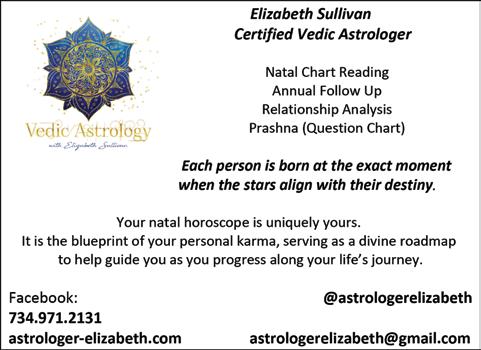
The Crazy Wisdom Community Journal • May through August 2023 • Page 27
Read The Crazy Wisdom Biweekly

The Crazy Wisdom Biweekly seeks to represent the voices of our community in a timely and entertaining manner. With new articles, personal essays, event listings, author and musician interviews, it’s the best of Crazy Wisdom in a bit size read! Read the E-zine online by visiting crazywisdomjournal.com/crazy-wisdom-biweekly. If you’d like the E-zine delivered directly to your inbox every other Friday morning, sign up on our website.
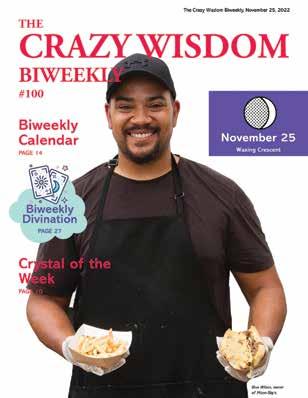

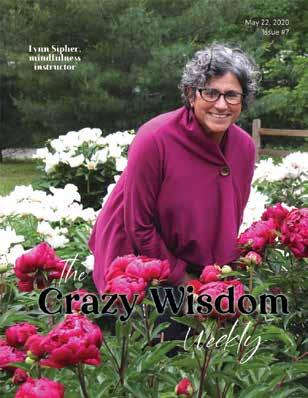
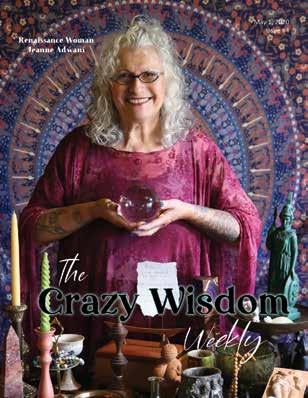
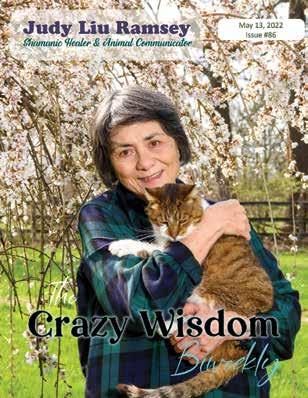
The Crazy Wisdom Community Journal • May through August 2023 • Page 28
What’s New in the Community
Continued from page 27
Gilson is now working to offer group online classes which help people “get comfortable practicing to hypnotize themselves so they can listen to audio or self-guide into trance to help reduce their IBS / IBD symptoms. She needs at least five people to express interest in order to launch her next group and will offer more groups as she gets interest. An initial one-on-one assessment will help determine if people are a good fit to benefit from the group. Afterward, they will go through seven every-other-week online group sessions to learn skills they can continue to use indefinitely. Feedback from her previous group was positive: participants reported feeling very relaxed right after the sessions, having less anxiety related to their symptoms, and experiencing less diarrhea, constipation, bloating, and discomfort. The only other local resource for gut directed hypnosis, as far as she is aware, is at the University of Michigan and is only open to those receiving treatment through the U of M. She hopes this option will increase access to this treatment option for those struggling with IBS and IBD.
More information is available at momentaiwellness.com. Dr. Allison Gilson can be reached by email at allisongilson@momentaiwellness.com or by phone at (734) 472-2705.
Christy DeBurton, yoga teacher and owner of The Yoga Room in Ann Arbor, started offering Mini Retreats in the autumn of 2022.
During the Covid-19 pandemic, it struck her that, despite the positives of the new normal of families being together much of the time with work-from-home, school closures, and general social isolation, sometimes people really needed a break from their children and/or spouses even just for a few hours at a time. It started with one woman, a busy mom with a stressful job, who wanted to bring a few colleagues and have a half-day wellness retreat with some yoga, snacks, relaxation, and socializing. DeBurton realized her yoga studio, housed in a beautiful small poolside cottage surrounded by a garden in her back yard, was the perfect setting for retreats like this.
She now offers regular three-hour self-care, chakra-balancing, and Yoga and Ayurveda mini retreats at the studio. They are limited to four people and are described as a “very intimate, informal, cozy experience.” For people with their own groups of colleagues, friends, or loved ones looking for a healthy bonding experience, she puts together bespoke mini retreats, which can include whatever the group desires, including Hatha, Vinyasa, or Yin yoga; meditation; aromatherapy; yoga nidra; tea; free time to unwind or journal; even a walk or naptime. So far, she said, only women have taken advantage of these miniretreats but men are certainly not excluded.
The studio is a small cottage-like building with a cork floor, lots of calming greens and woods, a high ceiling and a small loft. She described it as a “peaceful sanctuary.”

“It doesn’t happen often enough that we can do what we need to do to take care of ourselves,” she said, noting that most people are constantly tending to work, children, household chores, and other obligations so much that they don’t take time out for to relax and re-set.
More details are available online at yogaroomannarbor.com/mini-retreats. The Yoga Room is located at 889 Honey Creek Drive, Ann Arbor, MI 48103. Christy DeBurton can be reached through the contact page at yogaroomannarbor.com.
Sandy Alcini, owner of Grateful Dreads Salon, moved her business in February of 2022 and released her first hair product earlier this year.

After ten years in Kerrytown, Alcini moved to the new location on Packard, near York Food and Drink and next door to the Temple Beth Emeth/Saint Clare of Assisi Episcopal Church building. She said the new location has free and abundant parking (which was always an issue in Kerrytown) an open floor plan and is more centrally located for nearby communities like Ypsilanti and Saline. Since her salon is considered a destination, and she often has clients coming from all over Michigan (and sometimes all over the world) being easy to get to is important.
Alcini specializes in dreads and locs for all hair types and textures, as well as curly, non-locked hair. She mentioned that for a long time she was at Above Ground Hair Studio in downtown Ann Arbor and was trained by Cookie, a sought-after curly hair specialist. Alcini offers color, styling, tightening, and washing for locs, as well as cut, color, and extensions for all types of hair. Grateful dreads is a “multi-racial salon,” she said.
She uses and sells natural, sustainable haircare products that are crueltyfree, artificial fragrance free, vegan and organic whenever possible, and in biodegradable and/or recyclable packaging. She is passionate about eco sustainability. While Alcini had always thought about creating her own product line, it became a priority recently, with product and ingredient shortages and increasing prices on everything in the wake of the Covid-19 pandemic, war in Ukraine, and inflation. She worked with a chemist based in Brighton, who came into the salon to observe her work, examined the ingredients of every product she was using, and formulated a product that she said does the work of three, affordably. Containing tea tree and cedar essential oils along with other natural ingredients, Alcini said it tightens and moisturizes locs, cools the scalp and helps with any post-tightening irritation, and helps deodorize any odors that highly absorbent locs can sometimes pick up. She has even been using it on her curly-haired clients who do not wear locs. With the help of social media users, she named it Loc Candy. A former apprentice designed the package art. She was very selective about the packaging, which encourages re-use before recycling. Local customers can bring their 8-ounce bottles in for refills at the salon, and she also offers a -liter refill pouch. Loc Candy is available through Grateful Dreads, and Alcini is working on developing wholesale relationships.
Grateful Dreads is located at 2219 Packard Street, Ann Arbor, MI 48104. Sandy Alcini can be reached by email at sandybambihair@gmail.com or by phone at (734) 277-1449 with text being preferred. Her website is gratefuldreadsannarbor.com.
Kevin Cox, who grew up in the Dixboro area just north of Ann Arbor, had always wanted to own a cafe, so when he saw the Moon Winks Cafe on Plymouth Road in Dixboro up for sale he knew it was the right opportunity.

He brought the idea to his business partner of twenty years, Nathan McCardell, with whom he co-owns the construction company Michigan Studs and Walls. McCardell was on board as soon as he saw the place. They had both been interested in finding another business to work and invest in. Cox’s brother Patrick had experience in the restaurant industry, so he was a clear choice to become the general manager. McCardell and Kevin decided to temporarily close for remodel and re-opened the café on August 17, 2022. They envisioned a quiet space for community members to come in to work, study, and meet together, so the remodel included moving the louder aspects of food and drink preparation from behind the counter into an enclosed kitchen. They also changed from fluorescent lighting to LED and repainted. The result, said Kevin, rendered the small dining room “a nice place to sit and be at peace.”
Moon Winks was originally opened in 2006 by Roberta Tankanow and her son, Andy. It was named for her parents, Muriel and Oscar, who met at a restaurant in upstate New York called Moonwinks shortly before World War II. Oscar left to fight, but he wrote to Muriel every day from foxholes in Europe. When he returned home, they married and started a family.
When Andy Tankanaw moved to New York, Roberta sold the café to the owners of Balance Massage Therapy, which was then located in the same building right next door. Unfortunately, the Covid-19 pandemic was very hard on them, and they put the café back up for sale only a few years later, as well as having to temporarily close and ultimately move the massage business to a new location.
The café serves coffee from Ypsilanti-based supplier Hyperion, ice cream from Northville’s Guernsey Farms Dairy, and cheesecake from EK’s Cheesecakes in Ypsilanti. Their bagel sandwiches are made with Ann Arbor-based Barry’s Bagels. They offer soups, salads, vegan options including Impossible Sausage sandwiches alongside the turkey and chicken varieties. They will be adding a corned beef sandwich this spring.
Continued on page 30

The Crazy Wisdom Community Journal • May through August 2023 • Page 29
"In ancient times cats were worshipped as gods; they have not forgotten this."
— Novelist Terry Pratchett
What’s New in the Community
Continued from page 29
In April they increased their hours: they will be open from 8 a.m. to 6 p.m., Monday through Friday, from 8 a.m. to 4 p.m. on weekends. The space is also available to rent for private parties and events after-hours with vary affordable rates.
Kevin Cox repeatedly commented on the importance of the community. He says the café has a fun, family atmosphere and that locals are tight-knit and helpful. There is a farmer’s market from spring to fall right next door that brings people in. While Patrick Cox manages the day-to-day operations, Kevin and McCardell can be seen working the register sometimes, as can Kevin and Patrick’s children.
Moon Winks Cafe is located at 5151 Plymouth Road, Ann Arbor, MI 48105. Their website is moonwinkscafea2.com. They can be reached by email at moonwinksteam@gmail.com or by phone at (734) 994-5151.
New Books by Area Authors
Ellen Craine, therapist, life coach, part-time instructor at the Eastern Michigan University School of Social Work, and LLMSW Supervisor, recently published a chapter in two different books.
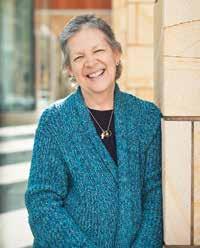
Both deal with themes of loss and grief, which as the mother of a pediatric cancer survivor, the widow of a man who passed away from brain cancer, and a breast cancer survivor herself, she is very acquainted with. Because of her personal experiences she is well equipped to help others with loss and grief in its many forms.
The first book, Women Who Empower, was published in December of 2020. It is a collection of stories from women that are meant to empower other women to live the lives they were meant for. Craine’s chapter, “Finding the Light through the Dark,” asks “What does it take for each one of us to find our own light?” She shares the stories of her son’s pediatric cancer journey and losing her husband to glioblastoma. She also talks about the fall holidays in many cultures that relate to finding the light in the dark, and how this relates to people working their way back into living their lives after devastating events.
Toward the end of production for the first book, Craine was diagnosed with breast cancer related to the PALB2 genetic mutation, linked to breast, ovarian, and pancreatic cancer. In the book, Women Who Dream, her chapter talks about her cancer journey. She is now in remission and she, and her doctors, believe one reason she has done as well as she has is because of her mindset. Refusing to become trapped in a victim mentality and despair, she once again worked through and past her grief and loss, finding ways to embrace the light she still had in her life. She mentioned that she also underwent some alternative therapies in conjunction with the mainstream medical treatments which she believes helped.
Craine recently finished up recording her section of Women Who Empower for its audiobook publication on Audible and has plans for future writing—some in the same book series and some outside of it. “I will be finding my voice for the rest of my life on this earth,” she said.
Ellen Craine can be reached via email at ellen@crainecounseling.com, or by phone at (248) 539-3850. Her website is crainecounseling.com.
Upcoming Events
Brad May, Ph.D., the developer of Emotional Complex Clearing, will be offering a weekend seminar on the technique June 23 to 25, 2023 in Ann Arbor.
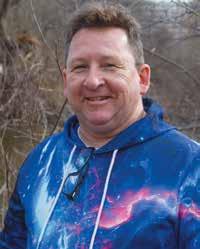
He is the author of Feeling Good About Feeling Bad (1981) and Muscle Testing Miracles (1998), has been a licensed therapist for forty years, and has taught psychology and counseling at eleven universities across the United States.
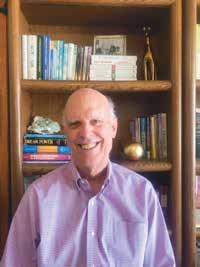
Emotional Complex Clearing (ECC), May explained, is a therapeutic technique that “safely facilitates the emotional healing of current problems, and deeper issues, that may feel like roadblocks in life.” This
is achieved, he said, through using muscle testing to identify issues that are remembered as well as those that are repressed, followed by a clearing technique that “neutralizes the impact of the issue and strips the negativity out of the memory.” Muscle testing, he explained, was developed by a chiropractor about sixty years ago and is mainly used by chiropractors. It is a “natural form of biofeedback without a machine,” that “bypasses conscious filters” to get accurate true/false signals from the subconscious which can be double-and triple-checked. Using this, he checks for unresolved issues using a target list in a variety of categories. This allows him to help people discover and clear issues “that they hadn’t known were negatively affecting them,” and to sometimes “get the results of long-term therapy within a few hours.” Patients don’t have to “talk themselves out of” feeling a certain way or be “taught how to think differently,” they simply do behave and think differently, because the reasons for the negative behaviors and thoughts are removed. He relayed a story about a patient who was on five medications, undergoing shock therapy, unable to work and participate in life, and experiencing multiple panic attacks in a day. Two weeks after a single session in which May helped him clear five childhood issues (three the patient knew were problems and two he hadn’t been consciously aware of), the patient reported that he was tapering off his medications, was back to work, was repairing relationships with his wife and children, and had even stopped needing to overeat in response to his depression and anxiety.
May described his own experience with muscle testing with a chiropractor, over thirty years ago, which allowed him to clear a childhood experience that gave him a subconscious belief that he shouldn’t work too hard or too much, because he had overheard an argument between his parents in which his mother was angry with his father for working too much and not helping with the children. Muscle testing allowed him to not only become aware of the subconscious belief that had negatively affected his career and life, but to almost instantly release it, becoming much more motivated. Since then, he has been able to synthesize this technique into his therapy practice and improve on it over time. He said he has been able to help patients with problems that have often not been helped by years of traditional talk therapy.
The June seminar will be useful for both therapists looking to use ECC to help their clients and for the general public who are seeking ways to help themselves. The technique is “learnable and teachable,” he said, and remarked that he thinks of himself as “an average therapist with a phenomenal technique.” The seminar will be hands-on, but he also explained that after one learns the technique in person, they will be able to use the technique remotely if they wish. “It is energy work,” he said; “muscle testing is not about strength but energy.” Learners do not need to be knowledgeable in anatomy.
The seminar will be twenty hours spread between Friday evening, Saturday, and Sunday June 23, 24, and 25. The Ann Arbor location is to be announced. A free introductory lesson via Zoom will be held on May 24, with a replay available on May’s website. More information about the seminar and registration is available on the website, ecctherapy.com. Brad May can be reached via email at ecc. clear@gmail.com.
Local musician Curtis Glatter is a drummer, improviser, composer, and teacher, playing “a little bit of everything” from classical to rock to jazz and experimental music, electro-acoustic chamber music under narration, and straight percussion.
Along with regular drums he plays with found objects, gongs, symbols, and more. In February, he released a CD with collaborators on the west coast called It’s The Door with the Little Stairs by Troikastra, featuring DJ 10Shun on turntables and Nathan Hubbard on electronics.
He will host the 11th annual Drum & Dance Jam at the Interfaith Center for Spiritual Growth in Ann Arbor, on the first Saturdays of April, May, June, and August. These are interactive drum circles that are beginner-friendly and incorporate frame drums, African djembes, and other hand drums. (Participants can bring drums played with sticks if they like.) “Drumming is proven to be good for hand-eye coordination, cognition stress relief, and enhancing spiritual joy and improving musicality in all ages, Glatter said.” He added that it is for “enjoyment, exercise, letting off steam.” He encourages dancing, and uses a variety of rhythms, fast, and slow. He plays the leader drum and can teach participants different styles, including Asian, African, and Indian. If someone has never been to a drum circle before, he offers them a free brief lesson. Spaces can be reserved, and participants can bring their own drums or borrow from the Interfaith Center. These events are also fundraisers for various organizations. The June event will support the Ocean Conservancy with fifteen percent of proceeds being donated, and Glatter will be giving away books about ocean conservation.
Continued on page 32
The Crazy Wisdom Community Journal • May through August 2023 • Page 30
For all of us, time marches on.
You may have been managing your finances successfully for many years.

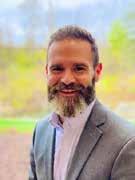



You still feel you can manage the funds but would like some oversight to help you out as things change.
You want someone who will listen, take good care of you, and not push you into the product of the day.
Check with us to discuss how our services might help to reduce your stress at a very reasonable cost. www.McLarenWealth.com


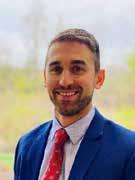

The Crazy Wisdom Community Journal • May through August 2023 • Page 31
BRINGING BALANCE TO YOUR FINANCIAL LIFE Doug Gross,
CFP® Financial Advisor Doug.Gross@ raymondjames.com
Sam Maness, CFP® Financial Advisor Sam.Paul.Maness@ raymondjames.com
Jason Coleman, CIMA® Financial Advisor Jason.Coleman@ raymondjames.com
Emily Rice Relationship Manager Emily.Rice@ raymondjames.com
Melanie Wells Branch Associate Melanie.Wells@ raymondjames.com
Independent Local Thoughtful Advice Securities offered through Raymond James Financial Services, Inc. member FINRA/SIPC. McLaren Wealth Strategies is not a registered broker/dealer and is independent of Raymond James Financial Services. Investment Advisory Services offered through Raymond James Financial Services Advisors, Inc.
Eisenhower Parkway Suite 301 Ann Arbor,
Justin Rice Investment Specialist Justin.Rice@ raymondjames.com
315
MI 48108 Phone: 734-944-7556 Fax: 734-661-1314
What’s New in the Community
Continued from page 30
He will also be performing a new piece of music at the Interfaith Center during the Sunday Celebration Services on June 25.
Glatter collaborates with Nightfire Dance Theater, a local performance ensemble, and will be performing some new pieces with them during the fall and into 2024. He has plans for new collaborative albums coming out in 2024 including a new duo with San Francisco based Nathan Hubbard, a trio record called Estuary Dances with the Found Object Orchestra Internationale, and a solo album. He plans to continue collaborating with local poets and musicians and writing new music as well as travelling to San Diego and Los Angeles to record and perform with west coast friends over the next two to three years.
Curtis Glatter is available for music workshops, individual music lessons, and music education seminars. He can be reached by email at cgindetmi@gmail.com, or by phone at (734) 972-6098. He shares information about upcoming events and performances at facebook.com/glattercurtisav1972. The Interfaith Center for Spiritual Growth is located at 704 Airport Boulevard, Ann Arbor, MI 48108.
New Classes
Ann Arbor Rec & Ed is offering a variety of new adult enrichment classes this year.
Some are revamped offerings that were on hiatus since the start of the Covid 19 pandemic; some are brandnew; some have transferred to a live online format as instructors and students have embraced the convenience and safety of not having to leave home to participate, and some have embraced a hybrid format, allowing participants to choose virtual or in-person attendance. Terry McNeely, Fitness & Yoga Program Supervisor, said that hybrid class options “allow people to choose where and how they want to participate on any given day. More options to participate, less reason to skip a class due to weather or other potential barriers.”
The Cardio Dance & Pilates class is a whole-body, low-impact, cardiovascular workout set to music, with Pilates incorporated for strength and flexibility. This is a hybrid class offered both online and in-person simultaneously, taught by Jenine “Chip” Grover, who has over thirty years’ experience. No dance experience is needed.
Yoga Flow with Chelsea is offered online only and promises to “calm your mind and lift your spirit with this mind-body practice done to soothing music.”
Chelsea Cendrowski is Registered Yoga Teacher (RYT 200) who has been teaching for over ten years.
Feldenkrais: Foundations of Better Walking and Balance is brand-new to Rec & Ed and is being offered as a hybrid class. Feldenkrais practitioner Dale Jensen helps students to “make walking more pleasurable, efficient, and fun” through “a series of movements designed to improve the alignment of your body as it pertains to walking.”
Chair Yoga with Weights is offered online and is ideal for older adults or anyone with balance, strength, or stability limitations. It uses only a straight-backed chair and one-pound hand weights or even water bottles or soup cans.
Iyengar Yoga with David Rosenberg is now being offered as a hybrid course. Rosenberg is a long-time Ann Arbor Rec & Ed instructor who trained with the Iyengars in India. Iyengar yoga uses props to deliver an individualized practice with adaptations for anyone and everyone, of all ages, sizes, and limitations.
Black History Walking Tours are a brand new in-person offering focusing on African American culture. This term’s tour is a 90-minute slow paced guided tour of historical sites connected to the African American community in Ann Arbor, offered by the African American Cultural & Historical Museum of Washtenaw (AACHM) and will be held on May 21.
Cinco de Mayo Feast is a new in-person cooking class held on May 4. Participants will learn to make enchiladas, pico de gallo, and guacamole, with all food and equipment provided.
Growing Vegetables 101 is “sort of rising from the ashes of the pandemic,” said McNeely, meaning it was a new offering in 2020 that was put on hold. Teens and adults can learn the basics of vegetable gardening in pots or in a yard, including what to plant when, natural pest and disease control, watering and plant care specific to our area.
Groove Movement Method, which McNeely said was brand-new just before the pandemic and then went on hiatus because it is best experienced in person,
“uses muscles you didn’t even know you had.” It promises to “unite your physical being with your inner rhythm through your own unique movements.”
More new in-person offerings include Passion for Poetry, Swing Dance 101, Cardio Kickboxing, Adult Self-Defense, Abs & Core for a Strong Back, Intro to Yoga with Cinda, and Therapeutic Yoga with Carl.
Classes are held in various Ann Arbor school buildings and offsite locations. Ann Arbor Rec & Ed offers many adult and youth enrichment, sports, and fitness classes each season. Summer class enrollment starts May 22.

More information and registration for classes is available online at aarecedonline. com. Teresa McNeely can be reached by email at mcneelyt@aaps.k12.mi.us.
New Practitioners and Businesses
Sophia Schwartz, a recent graduate of the University of Michigan Stamps school of Art & Design, became certified in Somatic Activated Healing (SAH) in the fall of 2022 while taking a semester away.

She has always been interested in meditation, yoga, and related disciplines. She became aware of Sah D’Simone, creator of SAH, when she found his podcast “Spiritually Sassy” through social media. She ended up joining the first cohort of students he trained in the method, which he had been developing over the last ten years. Schwartz explained,“It combines the four existing healing modalities of breathwork, meditation,mantras/affirmations, and dance which are sequenced into twentyto sixtyminutelong sessions. I like to think of it like the super-hero squad of healing modalities bringing you a physical and spiritual workout!” The practice, she said, is trauma-informed and “built of the knowledge that we all experience traumatic and painful experiences in our lives. When we don’t process the feelings that arise in these situations, they can become stuck in the body manifesting in physical, mental, and psychic dis-ease.” Since most people don’t know how to process these feelings, we end up with a “backlog of feelings stuck in our body.” SAH works with the body to allow people to process traumatic experiences “without having to specifically recall or revisit them in our minds.”
Schwartz is offering weekly online SAH sessions through Zoom for the Ann Arbor community and beyond on Tuesdays at 4:30 p.m. They are free and last about thirty-five minutes with five minutes of instruction and thirty minutes of practice. Each practice is unique in the details (specific movements, mantras, and type of meditations), has its own playlist, but follows a common structure. The sessions start with checking in and waking up the body, moving into segments of movements and mantras, ecstatic and freeform dance, and repeat. Each session ends with a meditation.
Starting in April, she will begin offering in-person sessions at 7 Notes Natural Health in Ann Arbor. These are typically longer than the online sessions and will be offered on a sliding scale fee structure. Practices are open to all ages, experience, and ability levels.
7 Notes Natural Health is located at 3830 Packard Street Suite 120, Ann Arbor, Michigan 48104. Sophia Schwartz can be reached by phone at (269) 364-1281 or by email at sophiepelleart@gmail.com. Those interested in hearing about upcoming practices can request to join her email list.
Submit your listing for the September through December 2023 issue.
Please note that the “What’s New in the Community” column is part of the editorial (not paid-for-advertising) part of the CW Journal, and the editors may or may not include what you submit. Whether the editors include material or not will depend on space considerations, as well as other editorial issues, such as the need for high resolution jpgs and the overall mix of stories included in the “What’s New in the Community” column in a given issue.
If you would like to submit information to be considered for this column, please email communitynews@crazywisdom.net.
The firm deadline for submissions for the next issue (Sept. thru Dec. 2023) is July 1, 2023.
The Crazy Wisdom Community Journal • May through August 2023 • Page 32
Ditching the Paper Towel
By Emma Hess
Did you know the invention of paper towels was completely accidental? Many are familiar with the Scott Paper Company which founded toilet paper all the way back in 1879. In the early 20th century, the Scott plant received a railroad car’s worth of paper rolled too thick for toilet paper. Instead of scrapping the whole load, one of the founders used a story he heard about a school using small pieces of soft paper to hand out to students with runny noses during flu season as an entrepreneurial opportunity. The paper was perforated into small towel-sized sheets, called Sani-Towel, and sold to hotels, restaurants, and railroad stations for use in restrooms. It wouldn’t be until almost 30 years later before paper towels were popularized for household kitchens the way they are today.
Many remember the paper goods shortage in the spring of 2020, with limits on the number of packs of toilet paper and paper towels a person could purchase during a trip to the grocery store. It was during this time that I began evaluating my own usage and dependence on paper towels.


In order to better evaluate our household waste, I did a trash audit: the process of collecting and identifying the amount and types of waste being generated by an individual, household, or organization in order to determine which items could be recycled, composted, or reused.
Using paper towels for daily tasks had become second nature. Cleaning the bathroom? Use paper towels. Wipe up a spill? Use paper towels. Dry my hands? Paper towels. There was no alternative in my mind. That was until I began doing more research on the Zero Waste Movement and its growing popularity. I’d slowly been making changes to my personal care routines for a few months before the pandemic hit. With the introduction of a solid shampoo bar, bar soap, and natural loofah, my shower set up was taking up less space and creating less waste. What was more challenging were the household items I shared with other people, but it proved to be a worthwhile endeavor.
In order to better evaluate our household waste, I did a trash audit: the process of collecting and identifying the amount and types of waste being generated by an individual, household, or organization in order to determine which items could be recycled, composted, or reused.
The idea behind a trash audit is pretty simple. You won’t know what you need to change unless you analyze the waste you’re already creating. After conducting a trash audit of my own, paper towels, food scraps, and food packaging were my main culprits of waste. I was excited to try composting and gardening to reduce food-related waste, but very unsure of how to ditch my paper towel addiction. That was until I came across a fantastic quote from Anne Marie Bonneau’s 2019 blog, author of Zero Waste Chef.
“We don't need a handful of people doing zero waste perfectly. We need millions of people doing it imperfectly.”
It was no longer my mission to completely rid myself of paper towels but to ease the transition in a maintainable fashion. With conscious consumerism in mind, there was no sense in purchasing new materials if I didn’t have to. I scurried over to my t-shirt drawer, threw everything on the bed and started to sort. In college, I had gathered an unhealthy supply of t-shirts from fraternity, charity, and volleyball events. They were bursting out of the drawer and at the time, I was deciding between donating or recycling them. It was during this time that I began shifting my mindset from “these have served their purpose” to “these are ready for their next purpose.” Each shirt was laid out on the floor and cut into sections, some small, some large, even the sleeves were put to
Any time I needed to clean the counters, I grabbed a piece of t-shirt. Napkin? T-shirt. Spilled coffee? T-shirt. It became a habit fairly quickly.
use. After folding, I placed the stack of 30 or so right next to the kitchen sink. I kept one spare paper towel roll under the sink for cat accidents (we all make compromises and reusing a cat puke-soaked rag was mine).
At first, it took some retraining of habits to get used to them. There was no longer a roll of paper towels sitting on the counter, so I didn’t have anything to reach for besides the reusables at this point. Any time I needed to clean the counters, I grabbed a piece of t-shirt. Napkin? T-shirt. Spilled coffee? T-shirt. It became a habit fairly quickly. I collected them in a washable pail liner and threw everything into the wash when we were low. Soon, it became very satisfying knowing the number of paper towels we had avoided. I’d usually fill a grocery store sized plastic bag with used paper towels after cleaning the house on a weekly basis. Now, I do a small load of laundry once a week.
Reusables in general save you money! I didn’t spend one penny to turn my t-shirts into rags. You could go out and purchase reusable paper towels if you’d like. There are a ton of lovely options from small businesses with beautiful patterns, but it’s not a necessity. I wanted to take a closer look at the cost breakdown between continuing to purchase disposable paper towels compared to a few packs of reusables. With the average American adult using 80 rolls of paper towels a year, let’s do some math on how much a two-person household could save in one year.
COST BREAKDOWN:
Costco Paper Towels 12-Pack: $22.99
$22.99 x 13 (technically 13.3333333) = 156 rolls for $298.87 $298.87 a year for a two-person household
Marley’s Monsters UNpaper Towels 12-Pack = $38
$38 x 3 packs = $114
3 packs would give you a healthy supply and last multiple years $114 for 2-4 years of use for a two-person household
With three years of reusable paper towel usage under my belt, the savings have added up quickly. My trash bin is not nearly full when the truck comes and that’s a celebration in and of itself. While this practice works for me and my twoperson household, it should be adapted to work for your unique circumstances. Whether you go all in and ditch the paper towel, or simply lessen your daily usage, you’re doing right by our planet with either choice you make.
Emma Hess is the owner and founder of BYOC Co. (Bring Your Own Container), a refill station and zero-waste shop with locations in Ann Arbor and Plymouth. Growing up in the neighboring city of Chelsea and a 2020 graduate of the University of Michigan, Hess enjoys helping the surrounding communities reduce their single-use plastic consumption by refilling containers with eco-friendly, plastic-free household cleaning and personal care products. She’s also an avid hiker, backpacker, gardener, and cat lover.
The Crazy Wisdom Community Journal • May through August 2023 • Page 33 The Crazy Wisdom Community Journal • May through August 2023 • Page 33
Green Living
Whether you go all in and ditch the paper towel, or simply lessen your daily usage, you’re doing right by our planet with either choice you make.
Astrologically Speaking



All About Mercury Retrograde: Return, Reassess, Redo, Renew
By Catherine Carlson
Most of us have heard the phrase “Mercury is in retrograde,” ever so often offered up as a reason for something not going smoothly in a person’s life. It’s true that retrograde periods can be challenging. It’s nothing personal and we can all be affected differently, so I wanted to give you the straight scoop on what Mercury retrograde periods are and how to navigate them.
When a planet moves into what is called a retrograde period, it’s not because the planet is physically behaving differently. However, from an earthly perspective, the planet appears to be in reverse motion. In actuality, Earth and the planet in retrograde have caught up with each other for a time, much like two cars on the freeway. This optical illusion from the earth’s point of view is what we call “turning retrograde.” When this period is complete, we say the planet “stations direct.” Because Mercury has the shortest orbit in our solar system, its retrograde periods occur the most often—three to four times per year and lasts for about three weeks. These periods approach and recede like a sunrise and sunset. The three-week Mercury retrograde period is when the energy is most intense, but we may still experience retrograde effects in the few weeks before and afterward, referred to as shadow periods.
When a planet goes through its retrograde period, it adversely affects whatever that planet represents. It’s as though the planetary energy is sluggish, or not as pure and straightforward, like a radio station with static and interference. The planet Mercury rules communication, transportation, and legal agreements. Because these are all major areas of daily living, we can be heavily impacted by Mercury retrograde periods with personal, and even widespread, problems in these areas.
When a planet moves into what is called a retrograde period, it’s not because the planet is physically behaving differently. However, from an earthly perspective, the planet appears to be in reverse motion.
Some common hiccups you may experience during a Mercury retrograde are problems with technology. You may lose information you thought was saved, your phone connection can be repeatedly bad, or your friends may not be able to receive your texts—for no apparent reason. If you purchase a new phone, computer, or other electronic device during a retrograde period make sure you also get the warranty. One example of widespread communication and technology problems occurred during the Mercury retrograde period this past January when the United Kingdom’s postal service was hit by a major cyberattack. It shut down their international mail service for several weeks.
The effects of Mercury retrograde on transportation are very noticeable. Driving your everyday route may suddenly become a major construction zone with a detour. You may experience unexpected delays on a road trip or at the airport. If you plan a trip, buy tickets, or make reservations of any kind during a retrograde period, know that even if that trip occurs after the retrograde period, you may experience changes or delays at the time of the trip or event.
When it comes to legal documents, this would involve anything where you are making a formal agreement or signing contracts. Purchasing a car or home during Mercury retrograde may mean there will be changes you couldn’t foresee at the time of purchase. If you sign a car lease, that lease may be able to be extended even though that was not initially the contract. If you buy a home,
there may be something revealed about the home that you were unaware of at the time you bought it or you may not stay in the home as long as you had planned. For example, it wasn’t until several years after my family had lived in our home that we learned from neighbors that there had been serious water damage in one of our bathrooms. This was not something ever disclosed when we bought the home. Thankfully it had been repaired correctly and did not cause further problems.
If you begin a new job during this time, the job is likely to change in some way. You may be given more responsibilities that were not in the original job description, or you may be transferred to another location, or your boss that hired you may be transferred to a different team, leaving you with new supervisor. In my experience, Mercury retrograde also always seems to affect everyday things like making plans or appointments. Whether you schedule a lunch, dentist appointment, or meeting, often as the date approaches it is either canceled or re-scheduled.
The planet Mercury rules communication, transportation, and legal agreements. Because these are all major areas of daily living, we can be heavily impacted by Mercury retrograde periods with personal, and even widespread, problems in these areas.
The planet Mercury rules the signs of Gemini and Virgo. If you have those signs featured strongly in your natal chart, you will feel the Mercury retrograde periods more. As I write this, we are between retrograde periods which is why I am taking advantage of the time to communicate as clearly as possible!
If all of this sounds disruptive and frustrating, it absolutely can be, but there is an upside to Mercury retrograde and knowing that can help you navigate the terrain. On the positive side, things you’ve been wishing and hoping for may finally happen! If you have been waitlisted at a school, this could be the time you receive your acceptance letter. If you have been wanting to make a big purchase, but haven’t had the resources, this can be a time when that item goes on sale, and you are able to make it work within your budget.
“Retro” means behind or backward. The direction of (Mercury) retrograde appears to be going backward and that is the clue for how to flow with the energy. Look back over your shoulder—did you leave anything behind? Go back to what you were working on months ago. Returning to old assignments, unfinished projects, cleaning out your closet, basement, or garage are excellent things to do and you will find you have great success with such tasks.
The planet Mercury rules the signs of Gemini and Virgo. If you have those signs featured strongly in your natal chart, you will feel the Mercury retrograde periods more.
The delays, the hold-ups and the re-dos may actually be in your best interest. You may learn the thing you wanted didn’t work out because there is something better up ahead that you can’t see yet. Transportation-wise, if you have had a trip on your bucket list forever, this is the time when that can happen, or you may re-visit a place where you spent time as a child.

The Crazy Wisdom Community Journal • May through August 2023 • Page 34
One of the most interesting effects of retrograde is people you haven’t heard from in ages may be encountered. You may get a phone call out of the blue or bump into someone at the airport. During one Mercury retrograde a close relative of mine found an unopened letter she had received years earlier from a distant cousin she had never met. Upon finding the letter she was able to finally make a connection.
Some astrology folks will tell you to avoid agreements, trips, and new electronics during these periods. I hardly think that’s realistic. What if something breaks and you need a replacement immediately? You can’t stop living during Mercury retrograde. You can’t avoid making plans and you won’t experience every issue every time. But, having a basic understanding of this planetary phenomenon, you can hopefully be prepared and ride with the energy instead of being annoyed by it. Go retro. It’s less a time of new beginnings, action, or forward motion so slow down, go back to things from the past and be willing to flex. Expect whatever is already in motion to change.
The planet Mercury rules the signs of Gemini and Virgo. If you have those signs featured strongly in your natal chart, you will feel the Mercury retrograde periods more.
Upcoming Mercury Retrograde dates for 2023 and areas that may be affected
April 21—May 14, 2023 in Taurus (home, resources, spirituality, and gardening)
August 23—September 15, 2023, in Virgo (service, health, animals, daily work and organization)



December 13, 2023—January 1, 2024, in Capricorn and Sagittarius (travel, gifts, higher education, religious faiths, structures, and business)
What about the retrograde of other planets?
All planets in our solar system go through retrograde periods except the sun and the moon. At any given moment there is usually at least one planet in retrograde. The outer planets have a longer orbit time, so the retrograde periods are longer, too. They will also have shadow phases in the weeks before and after the official retrograde periods. Mercury, Venus, and Mars have a more noticeable effect on us, being closer to the earth.
Venus retrograde occurs every 19 months for a period of six weeks. In this case, think beauty and love. Avoid getting a drastic new hairstyle but go back to an old one that worked well. It’s best not to begin a big home renovation project, but one that has been delayed has a good chance of reaching completion. Regarding love, connecting with a former partner may occur and help tie up loose ends, and a wedding delay is not uncommon. Venus will turn retrograde in Leo this year from July 22 through September 3.
Mars retrograde occurs every two years. Since Mars is the Roman god of war, mars retrograde is another one that is easily played out on the world stage. These periods can be times when political conflict escalates quickly without all the facts! For the individual, you may find you have a shorter fuse. If you are a high energy person, mars retrograde can feel like you’ve lost your wind. On the other hand, it could give some of us a boost if we are wanting to get back into an exercise program during this time. Mars just finished up a retrograde cycle this past March and will not turn retrograde again until December 6, 2024, to February 23, 2025.
The Crazy Wisdom Community Journal • May through August 2023 • Page 35
Ann Arbor Farm & Garden — Flower Therapy and Community Beautification
 By Peggy Alaniz
By Peggy Alaniz

Do you like playing in the dirt? Maybe you’re a bit of a novice when it comes to plants, but you enjoy taking walks in neighborhoods that have been enhanced with beautiful flowers, or even learning more about them from an expert. Do you think of ways that plants and flowers can create beauty in a public place in need of some love and care? What about arranging flowers? Are flowers your go to for a loved one suffering from an illness? Would you like to help students who have a passion for botany or in improving the natural environment? If you answered yes to any of these questions, then read on to learn more about Ann Arbor Farm and Garden, an organization that has been giving back to the community for more than 75 years.
Ann Arbor Farm and Garden is an organization that has been giving back to the community for more than 75 years.
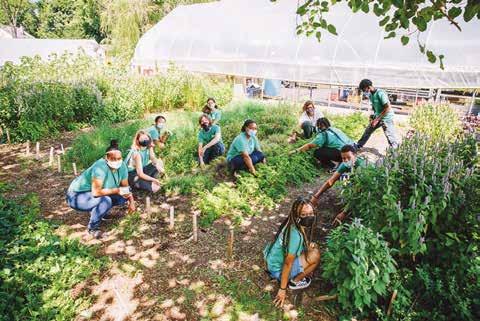
Most people know Ann Arbor Farm and Garden through their annual Garden Walk held annually on the second weekend of June. Even the current president, Barbara MacKenzie, discovered the organization through the garden walk in 2013. However, she did not think about joining the organization at that time because she wasn’t an expert gardener. According to MacKenzie,
“A year or so later [after the 2013 Garden Walk], I attended a class on growing and using herbs at Matthaei Botanical Garden sponsored by Ann Arbor Farm and Garden. Again, I was impressed by their work, but becoming a member didn’t seem possible since I wasn’t much of a gardener at that point, and I erroneously believed that was a requirement for membership. I finally became a member when I discovered that my neighbor across the street was actually the new president of Ann Arbor Farm and Garden, and she was able to dispel all the misconceptions I had about the organization. I didn’t need to be a master gardener or even a good one—I only needed to be interested in and care about nature.”
MacKenzie discovered the organization was about much more than just a walk in nature or digging into various beautifying projects around Washtenaw County. Their roots go back to 1914 and the Woman’s National Farm and Garden Association. In 1946 and 1947 the Ann Arbor branch of the Woman’s National Farm and Garden Association came into existence, and they have been serving the community ever since. According to their motto, “The mission of Ann Arbor Farm & Garden is to promote and support local gardens, the benefits of horticulture, and community beautification through grant and scholarship awards, related educational programs, and service opportunities.” They have fulfilled the terms of their motto by providing informative lectures on gardening that are open to the public, various beautification projects around Washtenaw County, providing grant money to other 501c non-profits to improve horticulture and advance education, as well as providing floral therapy for families with loved ones in local hospitals. Their members range in age from 40 to 100, but they serve all—regardless of age or station.
On the second Thursday of the month from September to May, you can find the members of Ann Arbor Farm and Garden at the Ann Arbor City Club. Meetings begin at 11:30 a.m. with lunch and the lecture begins at 1 p.m. Meetings are open to the public and the organization posts information about the lecture topic as well as the featured speaker on their website. In November, Ellen Holste who will talk about “American plant hunters” who lived in the 18th and 19th centuries. Plant hunters traveled the world to discover plants that were not known to exist by Americans at the time. The upcoming lecture in March features Naturalist and Master Gardener Carol Gagliardi who will present on native plants in the garden. Then in April, Tantre Farm will be presenting. Some of the previous lecture topics have included the use of herbs in the garden as well as how gardening helps the development of young children.
When spring and summer arrive, Ann Arbor Farm and Garden is always looking for volunteers to play in the dirt at various beautification projects around Washtenaw County. Perhaps you have seen or enjoyed a few of them? The group has contributed funds for the Ypsilanti District Library to build raised garden beds so that people with disabilities can enjoy planting and getting their hands dirty, too. At the Ann Arbor Hands On Museum, they helped with a plant-
The Crazy Wisdom Community Journal • May through August 2023 • Page 36
Current President, Barbara MacKenzie discovered the organization was about much more than just a walk in nature or digging into various beautifying projects around Washtenaw County. Their roots go back to 1914 and the Woman’s National Farm and Garden Association.
oriented exhibit. Perhaps you’ve seen the vegetable gardens at Edible Avalon, Project Grow, or the Washtenaw County Youth Detention Center? The group has planted therapeutic gardens such as the ones that can be found at the Catherine McAuley Health Center or the Glacier Hills Nursing Center, not to mention their many beautification projects for Ann Arbor Hospice, Cobble Stone Farm, and Habitat for Humanity of Huron Valley. It seems the hands of members have been in the dirt of nearly every corner of Ann Arbor.
In 2022, Ann Arbor Farm and Garden awarded over $9,400 to local garden projects. They also award an annual scholarship of $1,500 to a graduate student to support the U-M Biological Station in Pellston. Past award recipients include Tappan Middle School, The University of Michigan Matthaei Botanical Garden, and Nicholas Arboretum. You just can’t go anywhere in Washtenaw County without seeing some form of benefit from these enthusiastic gardeners.



The organization doesn’t just make outside areas more beautiful and provide garden therapy. They are also known for their flower therapy programs at local hospitals and wellness organizations.

Beginning in 1981, their flower therapy program started lifting the spirits of the young patients at U-M Mott’s Children’s Hospital. Volunteers would come in twice a month to help the children make their own floral creations. Flowers are uplifting. Who doesn’t like to see something colorful when stuck in a hospital bed? The activity also provided the children with much needed bonding and community support from other patients, families, and volunteers.
Sadly, the floral therapy program had to be discontinued due to the Covid-19 pandemic. They also had to temporarily discontinue service due to the surge of H1N1 in previous years. According to flower therapist Karen Mikus, “At some point, we hope to return flower therapy to Mott Children’s Hospital. We remain in contact with Volunteer Services at Michigan Medicine and will work closely with them to make it possible to once again bring smiles to the faces of the children and families at Mott.”
However, the flower therapists were not to be deterred. In 2021, they decided to reorganize. Taking all the necessary health precautions, volunteers began to deliver bouquets of flowers to places in the community such as The Ronald McDonald House, Alpha House, and Safe House. All the flowers used for these arrangements were donated to them by local florists and businesses throughout the Washtenaw County area. In 2021, they took 440 total bouquets of happiness to individuals. In 2022, they expect to deliver an amazing 855 bouquets.
Flowers, gardening, and taking a walk-in nature are terrific ways to be mindful and improve your own well-being. The communities in the Ann Arbor area have an amazing well-being resource in Ann Arbor Farm and Garden. They not only help to beautify our neighborhoods but provide us with information to help even a novice enjoy time in nature. You do not have to be an expert in gardening to join them, you just need to love playing in the dirt and have a desire to serve others. They are always in need of more volunteers, but if volunteering is not for you, you can give them financial support by participating in, or donating to, their upcoming silent auction in May. And mark your calendars for June 10, 2023, from 10 a.m. to 4 p.m. for their annual Garden Walk. It’s a wonderful way to meet the members of Ann Arbor Farm and Garden and to spend much needed time in nature.
The mission of Ann Arbor Farm & Garden is to promote and support local gardens, the benefits of horticulture, and community beautification through grant and scholarship awards, related educational programs, and service opportunities. Ann Arbor Farm & Garden is a 501(c)3 nonprofit organization. Visit their website at annarborfarmandgarden.org
The Crazy Wisdom Community Journal • MAy through August 2023 Page 37
Some of the previous lecture topics have included the use of herbs in the garden as well as how gardening helps the development of young children.
The communities in the Ann Arbor area have an amazing well-being resource in Ann Arbor Farm and Garden. They not only help to beautify our neighborhoods but provide us with information to help even a novice enjoy time in nature.
Tying the Knot in Nature


 By Christine Macintyre
By Christine Macintyre
Infusing a wedding with nature adds a sense of lighthearted whimsy and charm through elements such as fresh air, natural lighting, vibrant flowers, and wildlife. Several local venues bring the ceremony to nature's doorstep by offering outdoor ceremony sites, while others bring nature indoors. Some Crazy Wisdom favorites include botanical gardens, riverside views, sprawling fields, and vineyards. Each of the following venues is unique, but all of them offer nature's aesthetic beauty and are perfect options for a nature-inspired wedding.
Matthaei Botanical Gardens & Nichols Arboretum –1800 North Dixboro Road, Ann Arbor, (734) 647-7600, mbgna.umich.edu

The Conservatory hosts up to 60 people for smaller, more intimate gatherings. The exotic plants and lush tropical and temperate garden lend to the atmosphere. In addition, the space is climate-friendly, so no rain date is needed for your special day. The space is available for weddings nine months out of the year, which broadens the possibilities for a wedding in nature in Michigan. Floodlights offer ambiance at night, making the Conservatory an ideal spot for a romantic evening wedding.
For a private, isolated space, the intimate Willow Pond Island accommodates 150 guests in an area nestled across the water, between the reeds, to a secret garden. The tranquil water and looming spruce trees create the perfect backdrop, with wildflowers at the forefront. A stone stage offers the ideal spot to say "I do", and sets the tone in this rugged natural space.
Nichols Arboretum is Matthaei's quiet, leafy haven, perfect for an intimate, smaller wedding. Options are endless, with a hillside overlooking the Peony Garden, the Main/East Valleys, the amphitheater, and the Dow Prairie overlook. For an even smaller wedding, with 40 or fewer guests, the Heathdale, School Girls Glen Overlook, and the riverfront along the Huron River offer the ideal spaces.
The Herb Garden is perfect for couples looking for garden space featuring pathways, flexible seating arrangements, and a foliage backdrop of diverse textures and colors. Accommodating up to 100 people, the traditional English Tudor-style garden features a low yew hedge that encloses the garden, main pathways framed with boxwood, and a central bed of creeping thyme, which forms the woven Tudor knot design. Seating options include a semi-circular wooden bench running around one end of the garden and placing chairs at the ends of the focal paved areas, utilizing paths and a symmetrical design for the grand entrance.
Matthaei Botanical Gardens and Nichols Arboretum offer a sweet escape from the city with its lush gardens and formal spaces enhanced by nature. The venue is ideal for a wedding inspired by nature, as the gardens outside or even the indoor space amid the tropical setting in the Conservatory, offer gorgeous surroundings.
Matthaei features seven distinct spaces, "including a fragrant Herb Knot Garden, colorful Perennial Garden, the serene and intimate Willow Pond Island, or the summer-blooming Gateway Garden," according to their website.
Matthaei Botanical Gardens and Nichols Arboretum offer a sweet escape from the city with its lush gardens and formal spaces enhanced by nature.

The Gateway Garden offers vividly colored annuals and perennials. Accentuated by shrubs, accent boulders, and over 6,000 annuals, the central garden bed houses sunflowers, zinnias, marigolds, milkweed, poppies, purple coneflower, salvia, and more attracting butterflies and hummingbirds.
The focal point of this popular garden venue is the pavilion flanked by two beehive-shaped stone fountain pools, offering the perfect gathering area. This space accommodates 150 people in a round design with pathways offering the perfect ceremony view.

The Perennial Garden, which also accommodates 150 people, is defined by yew hedges and four long beds of perennials, marking it as a traditional English cottage garden. The long aisles of grassy lawns in between the beds accentuate the more than 120 varieties of plants which present pastel blues and pinks with white, yellow, lime, silver, and dark green tones. The changing colors of the perennial beds blend and reflect color schemes perfectly, making this an ideal spot for gorgeous photographs. Seating arrangements are best kept formal in this space, with chairs in the center aisle and the ceremony in a semi-circle of white perennials.
Matthaei Botanical Gardens' accommodations are unique in that their spaces whisk guests away to a portrait-perfect scene embedded in nature, surrounded by flowers, plants, and wildlife. In the event of bad weather for those who reserve outdoor spaces, the Auditorium or Conservatory offers options for a backup ceremony location, providing peace of mind and convenience. Additionally, the Auditorium is available for receptions.
Frutig Misty Farm & The Valley –8040 Scio Church Road, Ann Arbor, (313) 657-6882, frutigfarms.com
Located on sixteen acres lies Frutig’s Misty Farm, picture-perfect for outdoor weddings. The 2400 square foot restored historic barn has rooms for a band, dancing, and eating, and accommodates up to 130 people seated. A tent site provides ample room for parties over 130 people, accommodating up to 250 people seated. The site is situated against natural wetlands and rolling fields
The Crazy Wisdom Community Journal • May through August 2023 • Page 38
Photo by Heather Stern
Photo by Phern Joy
Historical Register and features a unique setting on ten acres. Ceremony and reception areas, indoor event spaces, complete catering services, an outdoor dance pavilion, and its position on the river make Weller's the perfect wedding site.
Two unique banquet rooms are available—The Carriage House and the Raisin River Room. Each boasts charm and historical significance. Additionally, two outdoor ceremony sites are available. Riverside ceremonies allow your event to meet nature at its doorstep.

The River Raisin Room, using the ceremony grounds on the opposite side of the river from the Carriage House grounds, comfortably accommodates up to 100 guests. Restrooms, a gift table, a cake table, a buffet table, a boiler bar, an entry foyer, a dance floor, and a stage make this space perfect for more intimate gatherings.
Misty Farm quickly became a top choice among those seeking a natural country setting with the convenience of being close to the heart of Ann Arbor.

and overlooks a gorgeous pond. Among beautiful perennial gardens, uniquely restored buildings provide the perfect photo opportunities.
The idea for utilizing the farm as a wedding venue came to Kelly Frutig after her daughter’s wedding in 2009. Misty Farm quickly became a top choice among those seeking a natural country setting with the convenience of being close to the heart of Ann Arbor. The historic barns, built around the turn of the century, offer a nostalgic, rustic appeal. Surrounded by rolling fields that were once horse pastures, a pond, and wetlands, the site allows guests to be truly immersed in nature.

The 30’ x 60’ Carriage House provides a unique experience. The ceremony site consists of an outdoor fire pit alongside the patio, where a 120 feet wedding aisle extends and leads to the wedding pergola. After hors d'oeuvres, a pre-dinner toast, and enjoying dinner and cake along with mingling among friends and family, the DJ announces the first dance from inside the Carriage House, prompting guests to move to the beautiful outdoor gazebo. Take a break from dancing to visit the outdoor bar offering a selection of drinks and hors d'oeuvres. Round cement tables with benches adorn the outdoor area. Additionally, the Carriage House features an indoor bar, a dinner bell to announce the seating of guests, dinner service, and cake cutting services.
Located only one-half of a mile east of Misty Farm, The Valley is a newly renovated 1840’s barn. The ceremony site includes bench seating, an outdoor round silo bar for cocktail hour, a Dining Barn with newly added pavilion seating for up to 250 people, and a historic main barn for the party. A groom’s shed, bridal staging area, and six bathrooms make this unique venue the perfect location for a memorable wedding.
The Valley was born from the spirit of restoring and preserving historical structures in Washtenaw County, and because Misty Farm saw such great success. The Valley is a gable roof barn built circa 1840, and, with the help of many talented local craftsmen, has been recreated to “satisfy the needs and wishes of the bride seeking a unique, natural, and outdoor venue,” according to Frutig Farm’s website. Both sites seek to cater to “people gather[ing] and enjoy[ing] life and the bounty of earth.”
Their website offers ample information, including an availability calendar, structure and pricing guides, tour schedules, information on how to book, and a detailed list of how things will work once the venue is booked. Rental fees include everything you’ve thought of, plus more, including a built-in sound system, wedding arbor, and wood chair seating, a golf cart, access to props, coffee service, and a refreshing seasonal fruit water bar. A vendor coordinator makes planning a breeze if you don’t already have your own. Frutig Farms’ goal is to ensure a stress-free, smooth-running event that is both beautiful and memorable.
Weller’s Carriage House –
555 West Michigan Avenue, Saline, (734) 429-2115, wellersweddings.com


Weller's, situated on the banks of the Saline River, offers an appealing property embedded in nature and history. The Weller’s property is on the National
The gazebo dance pavilion is 30’ x 60’—plenty of space to dance the night away. The ambiance is romantic and intimate, with eight spotlights in the ceiling and decorative white string lighting throughout. Additional lighting emphasizes the area surrounding the gazebo, pathways, and patio areas.

Forged from Henry Ford's vision for a once dilapidated Schuyler flour mill in the small rural village of Saline, the area came together when he merged urban factories with rural farming through the once little-known and underrated soybean crop. Due to the site's location on the river, Ford diverted the river to create a dam-millpond and installed a waterwheel to produce electricity. In 1966, Carl and Iris Weller purchased the property.
"The buildings and property were in total disrepair. But the Ford remnants unearthed in the buildings, the 10-acre setting, and the underlying natural beauty of the buildings sparked a flame that still burns bright in the family today," reveals the venue's website. Today's venue, a resurrection of the site's glory days, is a culmination of 40 years of hard work.
The Crazy Wisdom Community Journal • May through August 2023 • Page 39
Photo by Monnette Co. LLC
Photo by Monnette Co. LLC
The Weller’s property is on the National Historical Register and features a unique setting on ten acres.
Photo provided by Weller’s Carriage House
Photo provided by Weller’s Carriage House
Tying the Knot in Nature
Wellers offers accommodations that extend above and beyond the expected, including Wellers Hospitality House. These cozy apartments just a few blocks from Wellers make the perfect locale for pre-ceremony affairs, such as the bride and bridal party getting their hair and makeup done, eating lunch, or simply hanging out before the ceremony.
A complete event planning guide can be found at wellersweddings.com.



Zingerman’s Cornman Farms –8540 Island Lake Road, Dexter, (734) 619-8100, zingermanscornmanfarms.com


Dubbed an event venue, culinary destination, and picturesque escape, Zingerman’s Cornman Farms is minutes from Ann Arbor. This venue caters to the wedding of your dreams-indoor or outdoor, intimate or grand. The serene backdrop feels like it exists a world away from the hustle and bustle of the city and allows couples to mix classic design and personalized touches to create an elegant yet laidback occasion.
Words don’t do Cornman Farms justice in terms of visual appearance—you must see the Farmhouse, barn, and grounds to appreciate their beauty. The stunning 1834 Greek Revival Farmhouse was revived in 2019, creating the perfect suite of rooms for the modern wedding or dinner party. The warm, welcoming space comprises a foyer, kitchen, library with a working fireplace, living room, dining room, dressing room, hair and makeup room, and eclectic upstairs lounge. Natural light, romantic touches, serene comfort, and sensible chic spaces make the Farmhouse interior comfortable yet charming.
The Red Barn, restored and modernized since its 1837 inception, features a gabled roof and is nestled into the landscaped grounds. The barn houses a loft perfect for cocktail parties, formal dinners, or wedding dances. The bar and lounge areas on the main floor feature a wood-burning fireplace, providing the ideal space to mingle with friends and family or to warm up during winter. The pergola lets stars sparkle through the garden pathways as guests enjoy the outdoors. Finally, each spring, the gorgeous peak pole Tent Pavilion adds a sense of grandeur to the grounds, offering shelter for wedding receptions.
The Front Grove, where Chiavari chairs line up in a row against the pictureperfect white farmhouse backdrop, allows couples to say their vows surrounded by nature. The Loft is another option, as soft sunrays stream through westfacing windows during romantic sunset ceremonies. For picturesque views of the grounds and the soothing sounds of a crackling fireplace, the inviting atmosphere of the Farmhouse is a cozy site for a ceremony.
Regardless of how big or small a wedding is, this venue goes above and beyond. Zingerman’s Cornman Farms covers all the details that make up the perfect wedding day. The superb culinary quality, country setting, and unique package offerings make this venue a top contender.


Sauk Valley Lakeside Lodge –
10750 Prospect Hill Hwy Brooklyn, (517) 467-2061, svresort.com
Sauk Valley Lakeside Lodge is located in the beautiful Irish Hills in Brooklyn. The area is known for its tranquil setting among rolling hills, lush foliage, wildlife, freshwater ponds, and lakes. Sauk Valley rests among these scenic surroundings, making it an ideal venue for a wedding in a rural setting. Eight hundred rolling, wooded acres offer privacy and quiet, while private Pickerel Lake adds to the ambiance.
Sauk Valley Lakeside Lodge is located in the beautiful Irish Hills in Brooklyn. The area is known for its tranquil setting among rolling hills, lush foliage, wildlife, freshwater ponds, and lakes.
Zingerman’s specializes in the execution of bespoke weddings, intimate weddings, elopements, and tiny weddings. Bespoke weddings are explicitly designed for the couple and are their vision brought to life. The one-of-a-kind experience allows exclusive access to the entire farm, campfires and farm games, baby goats, and a warmly attentive team of event-planning experts.
Available facilities at Sauk Valley cater to a complete wedding ceremony and reception. In-house catering includes appetizers, entrees, and a variety of side dishes. China and silverware, linen table clothes, napkins, and water goblets complete the dining aspects.

The Crazy Wisdom Community Journal • May through August 2023 • Page 40
Words don’t do Cornman Farms justice in terms of visual appearance—you must see the Farmhouse, barn, and grounds to appreciate their beauty.
Photo by Adore Photography
Photo by Lola Grace Photography
Photo provided by Sauk Valley
The main lodge comprises an upper level which houses the wooden-floor dance area complete with a beautiful panoramic view, and the lower level, where dining typically takes place. Natural light spills in through the great windows of the main lodge, which offers views of the gorgeous property. Outside, a fire pit, a lighted patio, and plenty of manicured lawns are the perfect space to spend time with guests.
A grassy outdoor ceremony site is found in front of the main lodge, and the options for set up and design are endless. Complete with single, double, and dorm-style accommodations and lakeside fishing, as well, and with nature as the backdrop, this beautiful country setting is perfect for the wedding of your dreams.
Eyry of the Eagle Wedding & Reception Center –1916 Norvell Road, Grass Lake, (517) 522-3705, eyryoftheeagle.com



Eyry of the Eagle Farm sits just twenty minutes west of Ann Arbor and East of Jackson, offering a private modern farm setting. The unique venue provides the perfect backdrop for an outdoor wedding. Mature cedar trees, looming pines, and the sparkling waters of the pond offer endless possibilities for photographs, ceremony sites, and just lingering with your guests.
The ceremony site, located at the end of Lover’s Lane, is furnished with a wedding pergola nestled amongst densely wooded pines and overlooks Eagle Pond, a three-acre habitat for various wildlife.

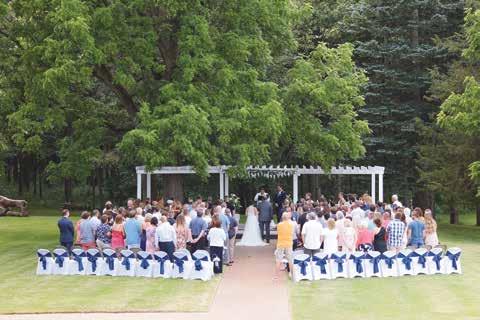
The venue offers the convenience of one location from rehearsal dinner through reception, ensuring reduced stress and more time to celebrate and enjoy your special day. The wide-open, 100-acre property offers ample room for guests to sprawl out. In addition, the beautifully maintained grounds feature a unique pergola, pond, wooded areas, llamas, and beautiful chainsaw carved art.
The ceremony site, located at the end of Lover’s Lane, is furnished with a wedding pergola nestled amongst densely wooded pines and overlooks Eagle Pond, a three-acre habitat for various wildlife. Surrounding the pergola is a lush green lawn, a brick-paved aisle, an elevated podium, and optional linen draping. A florist’s touch can add a thoughtful design to complement the site with splashes of vibrant color. Two oversized Adirondack chairs provide a fun, unique photo opportunity or a place to kick back. A six-person golf cart, “The Little Red Limo,” or a custom guest wagon pulled behind a tractor provides transportation to the ceremony site.
The Wings Gallery Reception Center is a 5,000-square-foot modern facility equipped with a spacious entry foyer, moveable bar, customizable dance floor options, spacious layout and design possibilities, access to an exclusive decorator’s closet, a generous catering kitchen, and capacity for 250 guests. An expansive outdoor patio makes for a great cocktail hour, bar, and appetizer location, taking the party outside. The spacious lawn is perfect for games, gathering to enjoy the surrounding nature, an optional outdoor tent, and even an outdoor dance floor.
Eagle’s Nest Barn tops off the venue with the rustic charm inherent to the beautiful 125-year-old restored multi-level barn. This space is perfect for intimate gatherings or pre-event cocktails. In addition, the barn is a common site for rehearsal dinners or groomsmen to prepare for the wedding day ceremony. The space features a catering kitchen, built-in bar, lounge space, dedicated restroom, heat and air conditioning, and capacity for 90 guests.
While the photos and virtual tour of this venue are beautiful, a scheduled inperson tour is a must to appreciate everything Eyry offers.

Vale Royal Barn is a rustic, prairie-style wedding venue featuring eight acres in a country setting… A natural river lined with willows and a rainbow of wildflowers tops off the natural scenery.
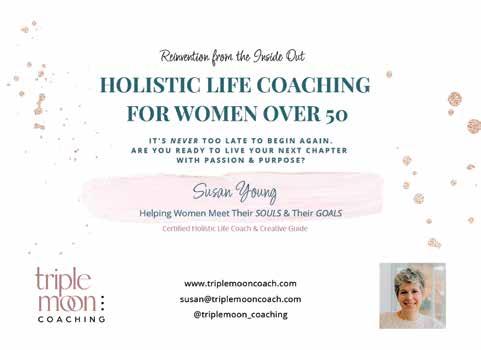
The Crazy Wisdom Community Journal • May through August 2023 • Page 41
Photo provided by Eyry of the Eagle
Photo by Diane Johnson
Tying the Knot in Nature
Vale Royal Barn –11009 Old US 23, Fenton, (810) 519-8269, valeroyalbarn.com

Vale Royal Barn is a rustic, prairie-style wedding venue featuring eight acres in a country setting close to US-23. The secluded setting, including beautiful fields and wooded areas, offers the perfect backdrop for a swoon-worthy wedding. A natural river lined with willows and a rainbow of wildflowers tops off the natural scenery.
The property features several options for outdoor ceremony locations, the updated historic dairy barn, and a bridal suite in the Inn. For couples taking advantage of the three-day package, two nights stay for up to six people in the Inn is included.

Planterra Conservatory -


7315 Drake Road, West Bloomfield Township, (248) 661-1591, planterraevents.com


Plantera Conservatory is a botanical wedding venue featuring premium planning, in-house design, floral, food and beverage, rental, and valet service. Harpar's Bazaar named this unique venue "one of the 33 best garden wedding venues in the world" and Brides.com calls it "one of America's best wedding venues."
Outdoor ceremony sites include a spacious riverside dock, the woods, the courtyard, and a covered bridge. In the event of inclement weather, the royal barn is a charming indoor ceremony site. Rustic benches and arbors are perfect for outdoor ceremonies. Whiskey barrels offer a dramatic touch to the decor.
The royal barn has indoor bathrooms, air conditioning and heat, and accommodates 160 people, including vendors. Two chandeliers hang from the ceiling while twinkle lights wrap the barn's beams. Linen-covered tables and natural wood x-back chairs provide ample seating for the reception. The space is complete with a rustic barn wood bar and a caterer's/bartender's room with a sink, refrigerator, and ice chest.
Photo opportunities lie throughout the property, including a white picket fence courtyard, woodlands, riverside, or the covered bridge ceremony site. In addition, the venue strives to be a family-style gathering place offering lawn games such as horseshoes, croquet, cornhole, and a bonfire pit.
The unique estate is available exclusively to the wedding couple for three days, providing convenience and ample time to bring the wedding of your dreams to fruition. As a private property, vendors of the couple's choosing are welcome, allowing for a genuinely do-it-yourself, customizable experience. Put your Pinterest ideas to work and design lush floral arrangements, creative decorations, and culminate a delicious menu to suit your taste buds. Bring in food carts, craft beer vendors, and donut trucks! Vale has a list of preferred vendors happy to assist couples who would prefer someone else do the heavy lifting.
Vale Royal Barn boasts an intimate outdoor venue that mixes woodsy charm with glamour. Located just a short drive from historic Fenton, the wedding party and guests can take advantage of a selection of hotels and excellent restaurants. In addition, take advantage of a private tour of this venue to appreciate the park-like property in the ultimate country setting.
Plantera Conservatory is a botanical wedding venue featuring premium planning, in-house design, floral, food and beverage, rental, and valet service.


The glass-enclosed exotic botanical garden brings nature indoors for an ideal spot to plan a modern, boho, romantic, or classic wedding. The Belgiumimported atrium feels synonymous with a European conservatory, complete with classic lines and architectural details. An elegant birch and floral arbor at the end of the aisle can be custom styled with fresh-cut flowers or lush, draping fabric. Touches of greenery, floral ice cubes, cut-glass goblets, or gold-rimmed china allow a unique bespoke wedding with exquisite details. The Conservatory is climate controlled and well-ventilated for optimal comfort.
Natural light floods the Conservatory, while the glass enclosure offers clear night sky views and adds to the ambiance. The versatile space offers the
The Crazy Wisdom Community Journal • May through August 2023 • Page 42
Photo by Catchfly Photography
Photo by Kelly Sweet Photography
Photo by Kelly Sweet Photography
ideal romantic backdrop for cocktail hour and dinner receptions. Speaking of receptions, Planterra offers in-house catering with delicious, signature plantbased dishes such as the Planterra Palm Cake to round out the experience.
The primary indoor season runs from September through May, as Planterra specializes in winter, spring, and fall weddings. However, outdoor spaces are available. A 2021 expansion includes a back-of-house addition expanding over Planterra's headquarters and creative space. In addition, a new 3,900-squarefoot enchanted garden courtyard is the perfect outdoor wedding space.
Foliage covers Planterra's VW Love Bug perched on the venue’s front lawn. The local landmark isn't a real car; instead, it is constructed of a traditional topiary wire frame and shaped like the iconic VW Beetle, including the contoured body, which gives it a realistic aesthetic. According to Planterra's website, Volkswagen of America contacted Planterra to build the topiary for the 1998 North American Detroit Auto Show. "The plant and flower-covered topiary was a nod to the car's flower-power history," according to the website. Planterra's plant company, Planterra Interior Landscaping, has a dedicated creative department that is happy to work with clients to build custom topiaries, too!
Black Barn Vineyard and Winery –


10473 Churchill Road, Rives Junction, (517) 569-2164, blackbarnvineyardandwinery.com


For wine lovers, or those who appreciate the beauty inherent of a vineyard, Black Barn Vineyard and Winery offers a unique venue situated in a country setting. The family-owned 16-acre property features a 3,900-square foot New England style barn, a patio area, a large pond, and, of course, a vineyard.
The barn is complete with separate men’s and women’s restrooms as well as two onsite dressing rooms where couples can get ready and hang out prior to the ceremony. Wall-to-wall glass garage doors overlooking the large pond and vineyard are situated on the east wall of the event space. These doors open to a patio area where guests can mingle and enjoy beautiful views of nature.
For wine lovers, or those who appreciate the beauty inherent of a vineyard, Black Barn Vineyard and Winery offers a unique venue situated in a country setting.
A ceremony site situated on the venue’s lower lawn is close to the pond and offers a gorgeous arbor accentuated with live vines. A second ceremony site is about 25 yards away under a beautiful willow tree that lingers over the pond. Both options offer a natural setting with views of the sprawling property and pond.

The Westers’ residence and property has long served as a gathering place for both spontaneous and planned events. These gatherings have always been centered around the Westers’ favorite things: good people, conversation, and wine. Their vision for Black Barn was to open a small, family-owned winery where people can gather for conversation and good tasting wine. Black Barn has been undergoing changes in preparation for opening the winery. A gorgeous Oak tree looms over the vineyard, which is secluded. Wedding couples may take photos at the Oak tree and in the working, fruitful vineyard.
Located just 40 miles west of Ann Arbor, Black Barn Vineyard & Winery is situated in an exclusive country-setting with ample photography opportunities and breathtaking views.
The Crazy Wisdom Community Journal • May through August 2023 • Page 43
Photo by Megan Hannon Photography Have a unique “Coat of Arms” designed just for you! Great for baby announcements, milestone birthdays, weddings, and more! Specializing in whimsical watercolor paintings of animals and nature. For a list of local events and art shows she’ll be participating in visit: FurandFeatherFriends.com
Jennifer • • • •
Carson
LEAPS OF FAITH TALES OF LOCAL BUSINESSES
By Laurel Decker
Photos by Susan Ayer
This column is a look at brave souls who have taken a leap of faith to open their own businesses in and around Ann Arbor. Business owners who are following their dreams and thriving despite the odds.

Curiouser Clay
13223 McKinley Road, Chelsea, MI 48118 (734) 272-8615
curiouserclay@gmail.com
curiouserclay.com
“I wonder if it would make more sense to come to a workshop to see what we do? You can even make a bowl if you like!” This enthusiastic invitation to join Eli Zemper’s next Curiouser Clay mobile workshop sounded like a fun alternative to my typical column interview.
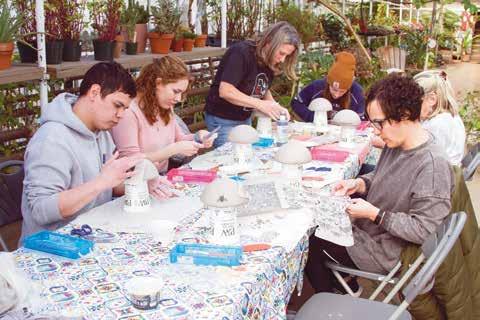
“I would love to!” I answered, before remembering that I didn’t exactly excel in my college pottery class over 20 years ago. Setting my ceramics insecurities aside, I did some online research to up my odds of making a killer bowl. Okay, so maybe I needed to manage my expectations and shoot for a functional bowl that wouldn’t leak. I tried to stay confident, knowing I was learning from Zemper who has 26 years of experience as a high school teacher.
Zemper made the decision to become an entrepreneur while the Covid-19 pandemic was still looming, and that brave move is already paying off. Curiouser Clay’s reputation has been growing since their first pop up workshop in March of 2022. Since then, they have stayed busy holding workshops and “makin’ parties” in which Zemper and her husband, Drew Zemper, show up to private parties, businesses, and homes throughout the region.
On a snowy Saturday afternoon, I drove to Hudson Mills Metropark Activity Center for the Curiouser Clay bowl workshop. The tables were packed with attendees who came with friends and family members, so I found the last open seat by a dad and his son and daughter. In front of each of us was a flat circle of clay and clay trimming tools. Everything we needed was ready to go. Well, almost everything. Maybe the experienced artists knew what to do with those art supplies, but I needed instructions on what to do next.
As soon as Zemper stood in front of the room, it was evident that she was a natural teacher. She began by going over some history behind pottery, and I found it interesting to learn that pottery that was uncovered in anthropological digs still had the maker’s fingerprint on them. She emphasizes that even
Zemper made the decision to become an entrepreneur while the Covid-19 pandemic was still looming, and that brave move is already paying off. Curiouser Clay’s reputation has been growing since their first pop up workshop in March of 2022.
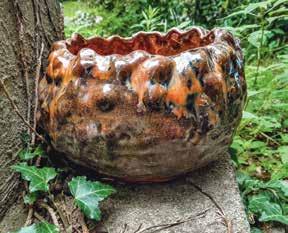
The Crazy Wisdom Community Journal • May through August 2023 • Page 44
Eli Zemper
“Community mental health. That's where it's at. I think it's our joy and obligation to take care of one another. Providing creative opportunities for people to connect to themselves and others is my contribution—that's what brings me joy and delight.” — Eli Zemper
though we can run to a store and buy a bowl, making it ourselves is a personal expression that lasts through what we create. She then gave us clear instructions and a boost of encouraging words before we felt the clay in our hands.
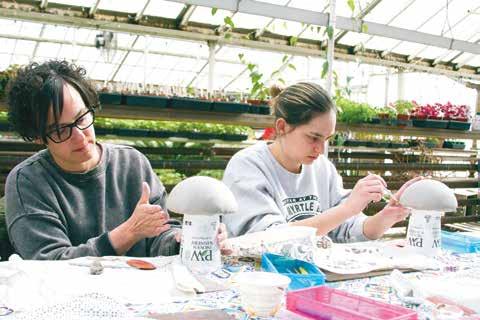
It was a good thing Zemper answered my questions before the workshop, because once I started smoothing out the clay I was focused. So was everyone else. There was some chatter, and idea sharing, but most of us were in a therapeutic zone, and that’s just where Zemper wanted us. She told me: “Community mental health. That's where it's at. I think it's our joy and obligation to take care of one another. Providing creative opportunities for people to connect to themselves and others is my contribution—that's what brings me joy and delight.” Here are some of the other reasons and ways she persisted through the challenges of business ownership during the pandemic.
Laurel Decker: What are some unexpected benefits that came from opening during the pandemic? Why do you think it's unique to the pandemic?
Eli Zemper: I think the pandemic created an acute awareness of how important it is to attend to your mental health. I also think that people are craving ways to connect to one another again. Because we collectively have gone through so much the last three years, I think people have really welcomed all the new small businesses that are cropping up that emphasize doing creative things with others (look at all the cookie decorating, sushi making, paint like Bob Ross kinds of classes people are offering!) I think without the stark contrast of what living isolated from community looks like, people might not be as welcoming or motivated to try these new class offerings.
Setting my ceramics insecurities aside, I did some online research to up my odds of making a killer bowl. Okay, so maybe I needed to manage my expectations and shoot for a functional bowl that wouldn’t leak.
Eli Zemper: The most useful personal skill is empathy. Everyone wants to feel seen and valued. We ensure that people feel comfortable and taken care of during our workshops and in our social media celebrations of their work. There is often a sense of pride or a surprise at their accomplishments at our workshops. Sometimes people use the workshop as a way to process things, like grief. We've had people make projects to memorialize loved ones who are no longer here. All of this clay work is valid—whether it's a night out with friends or a birthday or wedding shower, or a container to put your grief, making something with your hands helps us all integrate what life is dealing us.
Laurel Decker: Is there a memorable moment, good or bad, associated with having a business during such an uncertain time that you could share?
Eli Zemper: I think in August, when I first paid my house mortgage with our earnings, I felt so proud of this baby business! I have imagined this whole process like "birthing" a new thing into the world, and I'm so proud of this little baby for trying to stand on its own feet. Like little people, it requires SO. MUCH. WORK—and attending to, and love, and patience. But I am proud of how it is growing!
Laurel Decker: Did you take any time away from operating as a business? Depending on that answer, was there a fundamental reason you took the break or that you didn't shut down business?

Eli Zemper: This is the business iteration that finally made it to the opening stage. We have been planning a slew of businesses for the last decade, everything from a roller derby gym to a brewery, to a recreational bike company, to a distillery. There has been no break (whew) since the planning stages, so that has been challenging to attend to while raising our (now) 6-year-old twins and our 11-year-old. Finding balance continues to be challenging.
Laurel Decker: How have you, your staff, and your clientele dealt with the various mandates related to Covid 19?



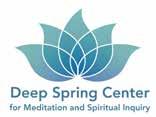
Eli Zemper: This one is tricky. When we first started hosting workshops last March, we followed what the CDC was recommending. As the year progressed and the temperatures warmed, we were outside, so more people felt inclined to let everyone choose their comfort level with masking or not. As norms are changing, more people are vaccinated and boosted, it seems like people are masking or not masking to their preference and there are less clear guidelines that everyone is following.
Laurel Decker: What is the most useful personal skill or trait that you and your staff implement to keep the business going?
As we neared the end of the workshop, I, and many of the attendees, had the same instinct to help The Zempers clean up the tables. Pottery making is a messy process! But they insisted that they had a system, and that when we finished, we could simply put our brushes and tools down and enjoy the rest of our Saturday. I said my goodbyes to my table mates, and new friends, and headed to my car to grab my cross-country skis. There was some fresh snow outside, and we were conveniently in a metropark.
In a few days I’ll go to Hudson Mills to pick up my soup bowl. I’m really excited to see what it looks like after the firing process. And I’m happy to report that even with my lack of ceramic skills, in a way I did make a “killer bowl” after all. I chose the skull & bones press-on rice paper artwork provided by Zemper and, using a clever idea I saw online, painted on the words “cereal killer.” I can’t wait for my breakfast cereal-loving friend to open it on his birthday.
For more information, upcoming workshops, or to book a private gathering with Curiouser Clay, visit curiouserclay.com or you can give Zemper a call at (734) 272-8615.

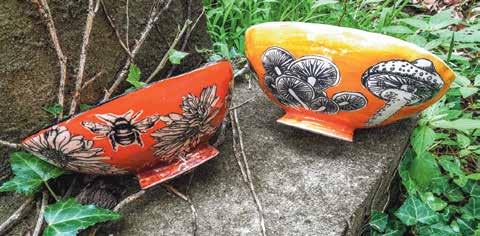

The Crazy Wisdom Community Journal • May through August 2023 • Page 45 Join us on our path to living a life of Lovin g kindness with non - harm to all beings. Experience the wisdom and compassion of Aaron, as channeled by our founder and guiding teacher, Barbara Brodsky. All live via Zoom Classes | Events with Spirit Retreats | Workshops Weekly Silent Meditation DeepSpring.org | info@deepspring.org | 734.477.5848 Deep Spring Center is a 501(c)(3) non-profit. See website for details. 2023 Programs
LEAPS OF FAITH TALES OF LOCAL BUSINESSES
 By Laurel Decker
Photos by Susan Ayer
By Laurel Decker
Photos by Susan Ayer
Third Mind Books
118 East Washington Street
Ann Arbor, MI 48104
(734) 994-3241
thirdmindbooks.com • info@thirdmindbooks.com
Open Monday-Saturday 11 a.m. - 8 p.m. and Sunday 12 p.m. - 5 p.m.
Did you just ask yourself, “What is a third mind?” That was one of the first things I wondered when I first walked into Third Mind Books in downtown Ann Arbor. I also wanted to find out why this business, with over 13 years of online commerce, decided to open a brick-and-mortar store in June of 2022. By then, the danger of the Covid-19 virus seemed to be waning, but the full economic impact was still quite uncertain.
When I spoke with Arthur Nusbaum, owner of Third Mind Books, he explained that The Third Mind is a literary collaboration between novelist William S. Burroughs and artist/poet/novelist Brion Gysin that was first published in 1977. The book illustrates how a third mind is created when two people share their individual perspectives through discussion. Their openness of thought makes it possible for a third intelligence to emerge. Nusbaum gave an additional interpretation, saying “Personally, and this is what Burroughs said
When I spoke with Arthur Nusbaum, owner of Third Mind Books, he explained that The Third Mind is a literary collaboration between novelist William S. Burroughs and artist/poet/novelist Brion Gysin that was first published in 1977. The book illustrates how a third mind is created when two people share their individual perspectives through discussion.
philosophically about it, an author and the book are two things. And the reader creates a third mind when they translate what the author says through the book. It’s the same with other forms of art.” He adds that his personal interactions with Burroughs inspired him to name the store as “a wink at Burroughs, just like our logo with his silhouette in a fedora.”
Along with Nusbaum, I spoke with Third Mind Books staff, Joe Provenzano and Rachel Braum. These two, both in their late 20s, were hardly the demographic I expected to be interested in the 1950s –1970s. But they were enthusiastic and knowledgeable about the store’s collection, which focuses on the Beatnik Generation. A collection that, Nusbaum adds, is becoming “Beat and beyond as we have an ever-blossoming array of items to include with the Beatniks as well as their predecessors and progeny.”

I asked them directly if they have a specific type of customer. Provenzano explained, “We have people who are curious and love bookstores in general, and people who are looking for something in particular. Others may know about us through the connection to the Beat movement. We’ve had people come in who have met Allen Ginsberg.”
Almost on cue, a customer approached the counter and Provenzano turned to ring him up. Because of the store’s proximity to U of M, I asked the young customer what he was buying and if it was for a class assignment. “No,” he answered. “It's just a little poetry. A collection of Russian poets that kind of caught my eye.” Immediately Provenzano offered, “If you like what’s in there, come back and we have some Mayakovsky. Kind of fun, kind of surrealism.” I was impressed by his knowledge.
Seeing how excited the college student was about the little book in his hand, and how excited Provenzano was about helping him find more of where that came from, I was understanding firsthand why one of the world’s foremost online resources for all things Beatnik took the leap into opening a physical space. There is satisfaction that comes from interacting with their customers in person. By providing a place to gather with other curious minds, they are able to host a version of what the Beatniks experienced in coffee shops and bookstores in New York City and San Francisco.
These two, both in their late 20s, were hardly the demographic I expected to be interested in the 1950s – 1970s. But they were enthusiastic and knowledgeable about the store’s collection, which focuses on the Beatnik Generation.
Laurel Decker: When did you first start planning to open the business and when did you actually open the doors?
The Crazy Wisdom Community Journal • May through August 2023 • Page 46
Arthur Nusbaum
Third Mind Team: We had been planning on opening a brick-and-mortar location since late 2021, but we wanted to be free and clear of the pandemic for the most part before opening the doors. We moved into the space and began setting up beginning early 2022, but our official opening was on June 4, 2022.
There is satisfaction that comes from interacting with their customers in person. By providing a place to gather with other curious minds, they are able to host a version of what the Beatniks experienced in coffee shops and bookstores in New York City and San Francisco.

Laurel Decker: How have you, your staff, and your clientele dealt with the various mandates... stay-at-home, social distancing, masks, no masks, etc.?
Third Mind Team: Again, we opened after the mandates had been lifted, and we have not required any precautionary measures at any point. Covid has hit only one of our staff members, and they have self-quarantined according to guidelines. We are all vaccinated and agreed to be personally liable for our own health and well-being.
Since 1984, your source for:
● Homeopathic Remedies
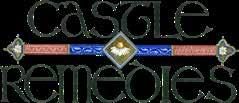

● Quality Nutritional Supplements
● Herbs & Essential Oils
● Flower Essences
● Unique Gifts & Jewelry
Laurel Decker: What is the most useful personal skill or trait that you, and/or your staff, have implemented to keep the business going?
Third Mind Team: Community building. We are trying to create an intellectual and creative gathering space for everybody who is interested by hosting events such as open mic nights, movie nights, book releases, and writer presentations.
Laurel Decker: Is there a memorable moment, good or bad, associated with having a business during such an uncertain time that you could share?
Third Mind Team: We were determined to behave as if the uncertain times were ending if they hadn’t ended already, but we were keenly aware that that attitude could have a polarizing effect for some who were still sensitive to the matter. We would not impede those who preferred to remain masked in public, but we would not require it either. We had a few patrons on both ends of that spectrum, hailing us for not restricting them or continuing to wear their mask regardless. It’s a point of individual personal comfort that is not our right to determine.
Laurel Decker: Is there anything you would have changed about how you handled business during the pandemic?
Third Mind Team: No, we are proud of the way we have gone about things.
Laurel Decker: Did you take any time away from operating as a business? Depending on that answer, was there a fundamental reason you took the break or not?
Third Mind Team: We have remained operational throughout the pandemic, though our brick-and-mortar store opened in mid-2022. Our previous onlineonly activity was not affected by the pandemic since it was a three-person operation and required very little if any public gathering.
Laurel Decker: What keeps you motivated to persist through the challenges of business ownership?
Third Mind Team: We are passionate about the intellectual and creative endeavors that we hope to display and encourage through our unique offerings and community events.
If you are an avid collector or expert on everything “Beatnik and beyond,” Third Mind Books is a great place to visit with like-minded people and tell them about your collection. If you are more of a beginner, it’s a great place to start your collection.
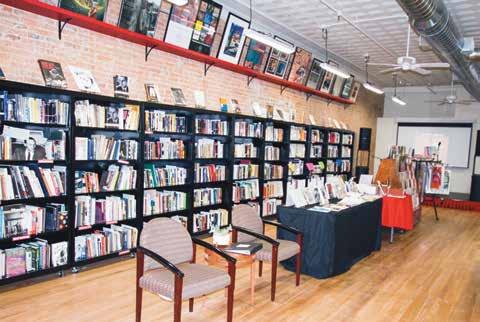
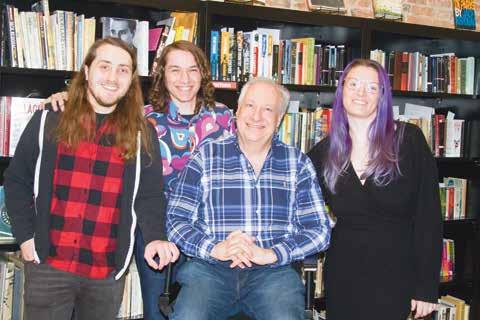
Laurel Decker: What is the most unique or meaningful piece that you have in the store, or in your own collection?
Third Mind Team: Letters and books that Burroughs signed, including Naked Lunch 1st edition and 1st French edition.

After looking around the store, I had to wonder what the most unique item was they had for sale. Unable to name just one, Nusbaum reminds me that “long before I became a seller, I was a collector.” It would be hard to list all of the books, letters, posters, and illustrations Nusbaum mentioned, but I will say that if I had an extra $4,000 lying around, I would start my own Beat collection with the very first printing of On the Road, by Jack Kerouac. Nusbaum said, “It’s probably the most iconic of Beat collectibles and we have it in great condition. Both the book and the jacket.” And then, as if he already knew I might not have a few thousand dollars to spend on memorabilia, he reassured me that they have more accessibly priced versions of it, too.
If you are an avid collector or expert on everything “Beatnik and beyond,” Third Mind Books is a great place to visit with like-minded people and tell them about your collection. If you are more of a beginner, it’s a great place to start your collection. And everyone is invited to the live events. Browse “Third Mind Books” website for the schedule of Beatnik community gatherings such as Open Mic, book signings, and movie screenings.
The Crazy Wisdom Community Journal • May through August 2023 • Page 47
Ann Arbor, MI ● (734) 973-8990 ● www.CastleRemedies.com Shipping and contactless pick up options available.
Now Open for In-Store Shopping!
Arthur Nusbaum and the Third Mind Team
###
Black Men Read — Expanding Possibilities Through Storytelling
“This has to change, on my watch,” Yodit Mesfin Johhson realized. The need for change became urgent when her own son was in second grade. Her life’s work in racial justice organizing took a big pivot toward the education sector with one call. It was Black History month and there were no Black men on the Mitchell Elementary School’s faculty. Her son’s teacher called to ask if she knew any Black men that would read to his classes. Of course, Mesfin Johnson arranged a roster of volunteers that rotated through the school's reading hours all throughout February. The realization that her son had no Black male role models at school collided with her own awakening to spur a deep dive of research into the educational system. “It turns out that less than 2% of U.S. teachers are Black men,” Mesfin Johnson was aghast to learn.
The realization that her son had no Black male role models at school collided with her own awakening to spur a deep dive of research into the educational system. “It turns out that less than 2% of U.S. teachers are Black men,” Mesfin Johnson was aghast to learn.
But it is her personal ethos to ask herself, “If I am going to point out an issue, then how am I going to contribute to the solution?” So after informally arranging volunteers for a few months, Mesfin Johnson invited a fellow parent at the school to collaborate. Together, Dr. Tamara Tucker-Ibarisha and she approached the school’s leadership team and PTO to ask if they could produce an afterschool program. Their proposal was met with enthusiasm at first, until they told them it was to be called “Black Men Read.”
Yodit Mesfin Johnson is the president and CEO of Non-Profit Enterprise at Work or N.E.W. On a radio interview at W.E.B.U. with David Fair she introduced herself as “a mother, poet, activist, and strategist with an abolitionist mind and a visionary heart.” She is kept busy as a consultant, developer, and advisor at the University of Michigan research initiative documenting Black segregation, racism, and resistance in Washtenaw County. But when the Mitchell Elementary’s PTO president challenged the name “Black Men Read” with suggestions of “All
Men Read” or “All Dad’s Read” Mesfin Johnson says, “that really radicalized me.” The school requested a more formal proposal rooted in evidence, which galvanized her efforts, and deepened her resolve.
Dr. Tamara Tucker-Ibarisha is a Phd Cellular and Molecular Biologist teaching in the university system. Her passion for education led her development of STEM initiatives for children of all ages. She is a co-founder of Black Men Read and focuses on the educational and creative aspects of the program.
The data was showing that only 15% of Black and brown kids in the district were reading at their grade level. “Why wouldn’t any and all efforts to address this disparity be welcomed?” Mesfin Johnson wondered. “Representation matters. You can’t be what you can't see.” Eventually the school embraced the program. The first Black Men Read event brought out 40 families.
“Anthony Morgan was the reader that night, and it was beautiful,” remembers Mesfin Johnson. “We believe that the rich tradition of oral storytelling was how communities thrived before the written word. Now, through books, we hope that young people and their families will carry forward these Indigenous traditions by engaging in readings and learning with us.”
The room was full, but it did not satisfy their mission if the children at the lower literacy rates were not in the room. The organization continued to experiment, move, grow, and change for adaptability, and for agility.

After a series of Black Men Read events at the school that Spring of 2016, she began to note that the students they really needed to reach were often not able to attend. “They were the kids that had to get to the bus after school.” They partnered with Black Stone Books and Cultural Center in Ypsilanti, to offer this resource to a greater community. The monthly pop-ups were a great success. “Yet we really wanted to reach the children that might not be able to make the
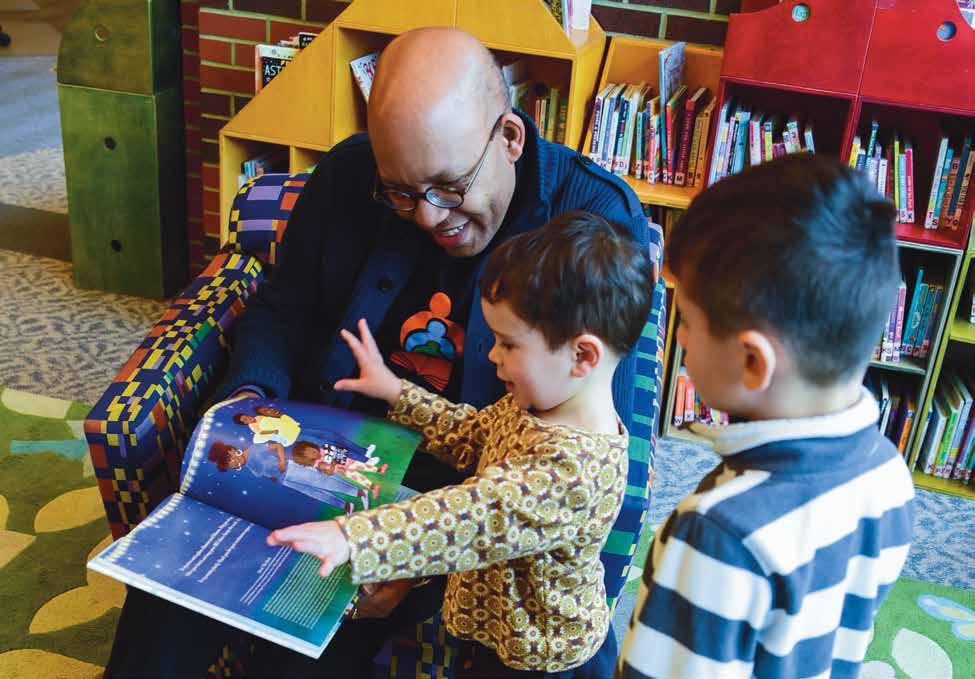
The Crazy Wisdom Community Journal • May through August 2023 • Page 48
Article and photos by Hilary Nichols
Byron Roberts, one of the reading volunteers for Black Men Read.
effort. We wanted them to know that we saw them, valued them, and loved them.”

The room was full, but it did not satisfy their mission if the children at the lower literacy rates were not in the room. The organization continued to experiment, move, grow, and change for adaptability, and for agility. And every year they applied what they learned. “We started to partner with the libraries, community centers, and places that were more proximate to those areas where these kids lived.”
When Black Men Read did pop-ups at the Ypsilanti District Library, the kids would see Darryl Johnson. They would see another reader at another location and another elsewhere. She started thinking, “What if they saw the same person consistently. It wasn’t enough for them to see a reader once and to never see them again.” With no other Black men in their school environment, she realized the program still had room to grow. “From my own experience, developing trust and a love of learning relied on relationships with the teachers and principals that I saw regularly. They became like family.” That’s when Black Men Read developed the Reader in Residence program.
Though costly, the Reader in Residence program is an important aspect of the arc of Black Men Read. “We don’t want to exist into perpetuity. We want to exist until the gap gets filled,” explains Mesfin Johnson. “Ultimately we wanted the school to have skin in the game.” To know the value and invest in a more diverse faculty so that these supplemental programs are no longer necessary.”
In the meantime, Black Men Read is on a mission. “We really believe we can dispel the myth that Black men are not engaged in their families and their communities, because it is a myth. In fact, per capita, Black men are more engaged with their families and communities than other men in our societies,” assures Mesfin Johnson. “In many ways, this is our love letter to the Black men who have been in our lives and in our communities. Black men are valuable,” adds Tamara Tucker-Ibarisha. “Black men are active participants in our communities. Though mostly that hasn’t been portrayed in the media. It's been really great for us to be able to lift-up and honor the men in our community in this way.”
After completing the BMR audition process,” Byron Roberts says, “I was honored to be selected. I have been a reader all of my life. Knowing the power of books to open mindsand inspire dreams, I am excited to share stories with young people.” He has read for BMR at schools, a bookstore, a church, a summer festival, and at the African American Cultural and Historical Museum. “When I read, I go all out to make the story come to life. I get to feel like a kid again, and I think the kids are drawn in by my excitement.”
With a roster of 50 Black male readers at 11 participating locations, Black Men Read interacted with more than 400 kids at these wonderful in-person events right up until the pandemic. The shutdown did not stop their offerings. It took a moment, but soon their on-line presence offered even more consistency with two Facebook live reads per week. And the response was unexpected. In person, 12-
“The reality is most of the American education system has been whitewashed. We live in a nation that has valorized whiteness. So, if all of our kids are primarily learning a curriculum that is whitewashed or doesn’t speak to the lived experience, including the Black and brown, indigenous, or LGBTQIA lived experience, then these students are not being included in the story of their own education.” Mesfin Johnson does not mince words. “The stories of Black, brown, and indigenous people have been relegated to these miniscule points.” She asks, “How do I ensure that my son knows the legacy, ancestry, lineage that he and I and other Black folks are building upon?” Black Men Read is her answer. “We think our children need to see more than slavery narratives, or civil rights narratives. They need to see themselves in normal everyday ways, the same way we normalize whiteness in this country.”
Though costly, the Reader in Residence program is an important aspect of the arc of Black Men Read. “We don’t want to exist into perpetuity. We want to exist until the gap gets filled,” explains Mesfin Johnson.


Nuola Akinde, the culture and curriculum director of Black Men Read, is an early childhood educator. As the founder of Kekere Freedom School, her belief in play-centered learning is aligned with Black Men Read’s mission of a decolonizing program. Her reading list is thoughtfully crafted to normalize and uplift Blackness. Their criteria for books on their annual list titled “Books That Every Black Child Should Read” requires that all the choices have a Black or brown protagonist, with the goal to amplify black authors and illustrators as well. Mesfin Johnson shared her enthusiasm, “We really seek out beautiful stories and illustrations. We want children to open the pages and delight in themselves. Delight in stories that are just normal kid stuff.”
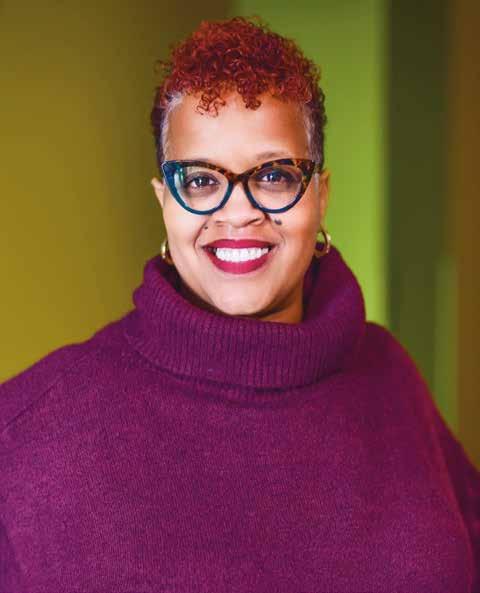
For example, the book Max and The Tag Along Moon (written and illustrated by Flloyd Cooper) is a beautiful story that holds a grandson and his grandfather close under the same moon. These stories are human stories to which every kid can relate to as celebratory, cautionary, historic, present, and future stories. Black Men Read is well-rounded. “We make sure that we consistently keep these ideas present.” Akinde offers, “Like seatbelts, we don’t just tell our kids to buckle up when there's an accident. And I think it's really similar for race and racism,” she continued. “We encourage conversations with kids on an ongoing basis, not just when there's an emergency or a crisis.” Black Men Read can be that consistent source, with over 100 in- person reads so far.
And the community agrees. Reader Byron Roberts expands, “I am proud that our organization is helping African American students to see themselves in hopeful contexts and demonstrating to students from all backgrounds that African Americans have a range of experiences and talents.”
With a roster of 50 Black male readers at 11 participating locations, Black Men Read interacted with more than 400 kids at these wonderful in-person events right up until the pandemic. The shutdown did not stop their offerings. It took a moment, but soon their on-line presence offered even more consistency with two Facebook live reads per week.
readings
“Initially,” Mesfin Johnson chuckles, “my goal was to put a Black subject book in the personal home libraries of all 7000 of the kids in our school district. Black Men Read has exceeded that goal by some. They have also gifted titles at their events funded initially with a grant from the Awesome Foundation and then the United Way of Washtenaw County. “We were proud to be one of the first investors in Black Men Read–helping children see themselves in the stories of culture, history, and everyday life. Having Black men lead the read is critical. I so appreciate the thought and visionary leadership Yodit and her team

The Crazy Wisdom Community Journal • May through August 2023 • Page 49
from Scratch Neighborhood Theatre Group
Theatre
www.NTGYpsi.org info@ntgypsi.org
“We believe that the rich tradition of oral storytelling was how communities thrived before the written word. Now, through books, we hope that young people and their families will carry forward these Indigenous traditions by engaging in
and learning with us.” — Mesfin Johnson
Yodit
Mesfin
Johnson
Black Men Read — Expanding Possibilities Through Storytelling
bring to our community. She is inspiring and motivates all of us to do better,” shared Pam Smith, CEO of UWWC. “I ardently cherish my memories of being read to by my grandfather and the connection it built between us. I am glad our community’s beloved children have an opportunity with BMR.” With their support the nonprofit has been able to gift over 7600 books. These partnering organizations are a crucial part of this non-profit. Black Men Read hosted a Black Joy kids’ corner at Ypsilanti’s Juneteenth celebration giving away over 300 books, with similar outreach at the Ann Arbor Summer Fest.

As a visionary, she [Yodit] reminds me that if we are successful, this organization should become obsolete. Our goals are to enact change. There will be a day when seeing Black men in classrooms and schools is normal.” — Dr.
Tamara Tucker-Ibarisha
Book Box subscriptions are a new way that BMR further supports and expands their outreach. With carefully crafted boxes, families can bring the magic home and extend one with a BOGO ‘Buy one - Give one’ club kit. Subscriptions are $160 a year or $44 per box. Each box provides two books celebrating Black characters and the experience of Black people throughout the diaspora, along with full color activity books, and locally made crafts or gifts. Sharonda Purnell of Cocoa Healing Collective in Ypsilanti added essential oils for kids to craft their own bug spray and Black joy scents. Odia of AidoStudio offered locally made stickers, and Melvin Parsons gifted his heirloom tomato seeds that he harvests himself. “There is a lot of love in these boxes,” assures Nuola Akinde.
It is the love that draws people to this non-profit. “Before we opened the doors at Booksweet in August 2021,” Truly Render notes, “we made a list of people and organizations doing amazing work in the community, people that we wanted to partner with. Black Men Read was at the top of that list. MesfinJohnson shares the sentiment, “Truly and Booksweet are so aligned with our vision and mission. But I couldn’t imagine how meaningful this partnership would become. She really understood the vision and the mission of the organization,” affirmed Mesfin Johnson. The appreciation is mutual. "We love how this non-profit nourishes our community and we believe in their mission. Representation matters. It matters for the Black children in our community to see themselves as leaders, as writers, as readers, as caring and cared for community members. Representation matters for NBPOCs and white children too, addressing biases before they can form through loving connection,” Render offered. Booksweet continues to host Black Men Read outdoors in the warmer months at their Courtyard Shop on the northside of Ann Arbor.
Partnerships are a big component of this non-profit’s trajectory. Black Men Read intends to weave its mission with a number of correlating programs. “We were thrilled to collaborate withNuola Akinde, Yodit Mesfin Johnson, and Tamara Tucker-Ibarisha and their wonderful team on selecting books, designing the activities, and distributing kits of two books and a writing pad to 250 students across our service shared Catherine Calabro of 826 Michigan. The National Writing Education Organization was a natural fit. Reader Will Jones read The Word Collector by Peter Reynolds with students and co-facilitated a session for student writers to create their own word collections. “We look forward to future opportunities to read and write together with BMR!”
At one time Black Men Read had a hard time resourcing enough reader volunteers. At an annual NAAPID event during Black History Month this year, there was a volunteer for every classroom. Four hundred kids at STEAM Elementary School had a Black man read to them. “Twelve readers showed up. It is so fire, it blows my mind. It is the most beautiful thing in the world,” Mesfin Johnson reported. Martin Luthor King’s legacy was shared through the title, We March along with activities to prompt the classes to investigate and integrate “what leadership looks like and leading change in our community and this country,” Mesfin Johnson boasted. Activities are designed along with each read to deepen and secure the message.
Partnerships are a big component of this non-profit’s trajectory. Black Men Read intends to weave its mission with a number of correlating programs.
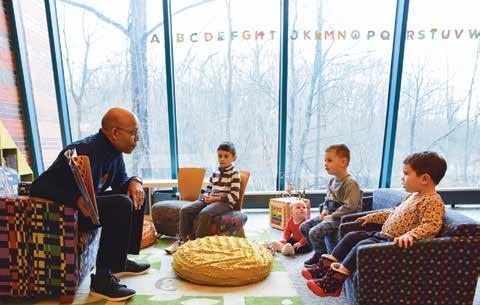
“This isn’t rocket science,” Dr. Tamara Tucker-Ibarisha said. The premise of Black Men Read might sound simple, with the three-word moniker, and straight forward approach, but don’t mistake it. “We are sharing something very simple and asking it to really move the needle of society. To enact actual change. It is so much more than story time. This work is transformative. We are doing two things at once Centering and uplifting Blackness by using books with Black characters. And providing all the children with a new baseline of equality and equity moving forward.”
“Everything we need to know we learned in Kindergarten” is a catchy adage. But this non-profit takes that edict to heart. “We want every child to be loved, seen, and valued. We just really love all the children. And we want them to know that they are a part of the seventh generation. On the strand from seven generations back and building toward generations forward,” said Mesfin Johnson. “It is our calling and our responsibility from our ancestors. It is not a charity, or really a program about literacy. It is about doing the work our ancestors called us to do. Together, we’re helping our children re-shape their world and its possibilities.”
“It is one of the things I love about working with Yodit,'' Tucker-Barisha mused. “As a visionary, she reminds me that if we are successful, this organization should become obsolete. Our goals are to enact change. There will be a day when seeing Black men in classrooms and schools is normal. Families will find it normal to have books that feature Black characters and to buy Black dolls regardless of their background,” she shared. “I find it super delightful to think that one day the work will end because we accomplished the goal, and we can sit back and say, ‘We did it.’"
“Be the change you want to see in the world,” is more than their slogan. Dr. Tamara Tucker-Ibarisha and Yodit Mesfin Johnson addressed a complex problem with an elegant solution. But the problem won’t go away with their volunteers alone. “We can’t be the fix, but we can be the influence,” Mesfin Johnson offered. “The district has done a better job getting people of color employed in the school buildings.” But Black Men Read isn’t quitting just yet. “When we see Black men in leadership roles across the district, that’s what we want to see.” Not simply activists and organizers, Dr. Tamara Tucker-Ibarisha and Yodit Mesfin Johnson are change makers on a mission. As champions for equity and social change, they believe, “There is no greater antidote for hate than love and liberation.”
Find out more about Black Men Read at bmrkids.org. You can follow Dr. Tamara Tucker-Ibarisha at facebook.com/tamara.p.tucker, and Yodit Mesfin Johhson at facebook.com/yoditmj.
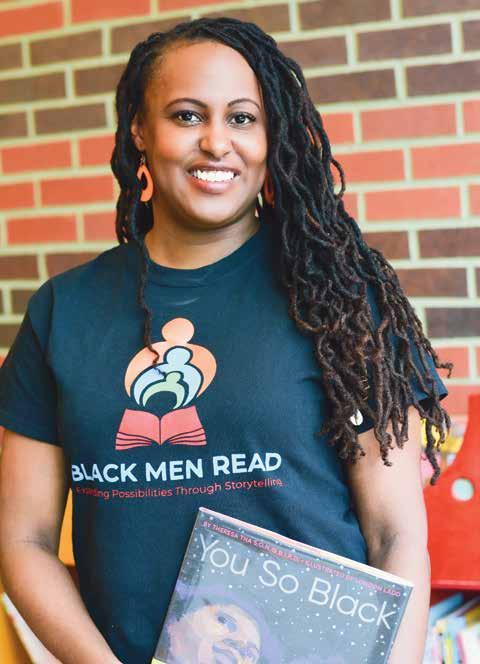
The Crazy Wisdom Community Journal • May through August 2023 • Page 50
Dr. Tamara TuckerIbarisha



The Crazy Wisdom Community Journal • May through August 2023 • Page 51 with Rachel Egherman Using the HeartMath™ method & heart-centered practices to help you find joy & resilience. Get in touch: celebratedheart.com 734-834-3223 Available for individuals, families, & organizations Certified Trauma-Sensitive HeartMath™ mentor Great Tastes in Local Food page 54 Cooking with Lisa page 56 Tea with Peggy page 57 Herbs for Your Garden: Calendula page 52 Conscious & Tasty eating & nutrition
Herbs for Your Garden Calendula



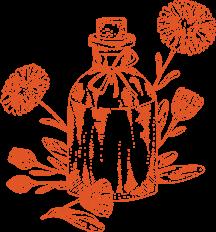


Without fail, you’ll find Calendula growing in my garden every year. It’s an incredibly useful medicinal herb and it’s very easy to grow. Calendula blooms all season long with vibrant orange and yellow flowers. The edible petals can be sprinkled over salads and soups to add beauty along with vitamins, antioxidants, and phytonutrients. The dried flowers are used to make herbal healing salves that are applied topically to speed wound healing, ward off infection, and soothe dry, chapped skin. It’s an indispensable herb for the first aid kid or medicine cabinet. In fact, Calendula is usually the #1 herbal ingredient in herbal healing salves, usually along with herbs like Plantain or Yarrow.
Calendula blooms all season long with vibrant orange and yellow flowers. The edible petals can be sprinkled over salads and soups to add beauty along with vitamins, antioxidants, and phytonutrients.
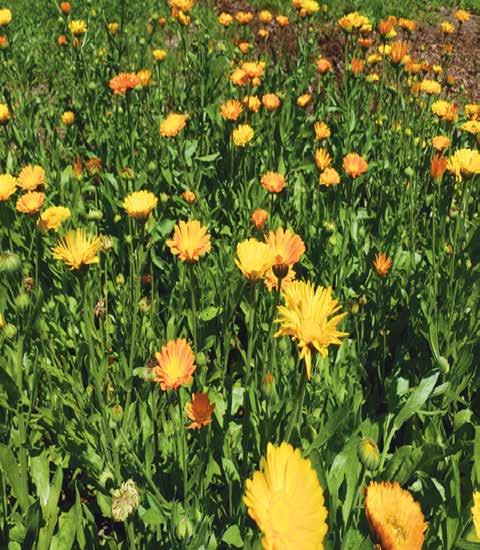
Calendula is grown as a self-seeding annual in USDA grow zones two through eight. In areas with warm winters (above 25⁰F), it blooms year-round. Calendula thrives in full sun with well-drained soil. I recommend sowing Calendula seed directly into the garden early to mid-spring. It’s ideal to plant the seeds as soon as the soil is workable since germination benefits from cool weather, but don’t stress too much about timing. I’ve had success planting seeds year-round. Calendula is a self-seeding annual, which means seeds dropped by the plants in the fall will lay dormant on the ground all winter and then sprout the next spring. However, it’s not an aggressively spreading plant, so don’t worry about it taking over your garden.
When spreading seed, expect a good rate of germination. If you only have a few seeds, you can carefully space them and plant ½” deep. You’ll want to space or thin to 6” apart. If you want a big patch, first prepare the soil, then strew the seeds about on the soil surface and gently tamp. Sprinkle a little extra soil on top if you desire, but it’s not required. Calendula grows easily in regular garden soil and requires no extra watering and no fertilizer. It does equally well in the ground or grown as a container plant.
Calendula is a self-seeding annual, which means seeds dropped by the plants in the fall will lay dormant on the ground all winter and then sprout the next spring. However, it’s not an aggressively spreading plant, so don’t worry about it taking over your garden.
Harvest whole flowers on a dry, sunny day. I like to gather a mixture of peak blooms and flower buds that are just barely starting to open—a tip I learned from Richo Cech of Strictly Medicinals. The flower heads pop right off and are easy to gather by hand. Peak blooms look fresh and vibrant, with the center of the flower plump and intact. You’ll notice a sticky resin start to build up on your fingers (or your scissors!). That’s good: the more resinous, the more medicinal. Rubbing alcohol will remove the resin from fingers and tools.
For culinary use, the fresh flowers can be stored in an airtight container in the fridge for several days. Pluck the petals and sprinkle over soups and salads. For medicinal use, flowers should be carefully dried on a screen or in a dehydrator. You can use an expandable window screen insert from any hardware store. Spread the flowers in a single layer on the screen and place in an area that is dark, dry, and has good airflow. The screen method usually takes two–three weeks to dry completely. If using a dehydrator, set the temperature between 95⁰F and 105⁰F. Spread the flowers in a single layer on the dehydrator racks. Allow 24 to 48 hours for drying. After 24 hours, check flowers every eight to 12 hours for dryness. Store for one to three years in an airtight container, ideally with a food-grade silica packet.
To make an infused oil for topical use, crumble whole dried flowers into a glass mason jar to around the ¾ full mark. Pour organic olive oil over the herb, covering with about ½” of oil and screw the lid on tightly. Place the jar in a dark, warm location and let sit for about four weeks, giving it a good shake a couple times a week. Alternatively, you can speed things up by using a crockpot. Place a washcloth between the jar and the bottom of the crock. Add water into
The Crazy Wisdom Community Journal • May through August 2023 • Page 52
Story and Photos By Caitlin Potere
the crockpot up to the tightly closed lid on the mason jar and turn your crock pot on the “warm” setting. Let sit uncovered, adding more water as needed, for 24 – 72 hours. Carefully strain the flowers out of the mason jar using cheesecloth or a fine mesh strainer. You’ve just made Calendula oil! To make a solid salve, gently heat the Calendula oil in a double-boiler and stir in beeswax beads until they dissolve completely. Pour into containers and allow to cool.
Calendula seeds are easy to collect and save for planting or sharing next year. In the late summer, you’ll notice the flowers begin to die back, close into tight green balls, and then turn into brown seed heads. Each flower can produce a dozen or more squiggly-looking seeds. Collect when the seeds are completely brown and feel crispy-dry. Put them in a paper bag or spread on a screen and place in a cool, dry, dark place. Leave them be for a few weeks to allow them to dry out completely. You can leave them in the brown paper bag all winter long or store them in a dry, temperature-controlled place like you would any seed.
One thing to be mindful of: gardeners have developed many ornamental varieties of Calendula, which are bred for beauty or color variety over medicinal qualities. I recommend ordering Calendula officinalis seeds from Strictly Medicinal Seeds located in Oregon.


If you are pregnant or nursing, or trying to become pregnant, avoid internal use of Calendula. (Topical use is safe.) If you have a known allergy to Asteraceae family plants such as ragweed, daisies, or marigolds, avoid using Calendula. Allergic reactions to Calendula are extremely rare; if you are concerned, I recommend doing a small patch test first by applying a tiny amount to the skin and waiting 24 hours. If redness, itching, or raised skin occurs, discontinue use.
If you would like to learn more about adding herbs to your garden, check out my free online class: Herbs for the Michigan Gardener, which covers 20 different medicinal and culinary herbs suited for the southeast Michigan garden. It’s prerecorded so you can watch at your own pace. Visit CastleRemedies.com and click on “Classes.”
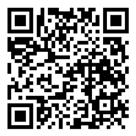
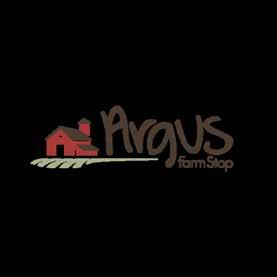

The Crazy Wisdom Community Journal • May through August 2023 • Page 53
Caitlin Potere is an herbalist and enthusiastic Project Grow community gardener. She has been studying herbs for over a decade and has completed programs with herbalists Jim McDonald and David Winston. Potere manages Castle Remedies, an holistic pharmacy in Ann Arbor, and is also a coordinator of the annual Great Lakes Herb Faire which takes place in Chelsea, Michigan. You can contact her by email, caitlin@castleremedies.com.
finest seasonal vegetables from our area's local farms
great way to support our local food system! Every week is different and seasonal Get a box of fresh, locally grown produce every single week! Shop Now We offer flexible weekly or biweekly options & the ability to skip and pause weeks. Easy add-on order options to include bread, milk, meat and eggs! $30/week, EBT specials available!
One thing to be mindful of: gardeners have developed many ornamental varieties of Calendula, which are bred for beauty or color variety over medicinal qualities.
The
A
GREAT TASTES in local food
By Crysta Coburn
The North Star Lounge
If you are looking for some great food and amazing tunes with a chill and intimate vibe, look no further than The North Star Lounge located in Ann Arbor’s historic Kerrytown neighborhood. (According to the Ann Arbor District Library’s online archives, the building that is now home to The North Star was erected in 1887 as part of Baumgardner’s Marble Works.) The ground floor contains a bar and limited seating. Up a narrow flight of stairs to the second floor, decorated in a desert theme, the space opens up and contains booths and tables, a stage in the corner, and a piano for Thursday nights when the Lounge becomes a piano bar.
As for the menu, every item of food is vegan. But please, don’t let that stop you. The portions are generous and filling, and the staff is friendly and accommodating. If you need food that is gluten, nut, or soy free, for example, let them know and they will help you out. I devoured a gluten-free burrito bowl topped with nacho cheese, southwest ranch, and crunchy tortilla chips. In my humble opinion, the vegan nacho cheese made from cashew nuts tastes better than the milk-based variety. And it’s so creamy! There is also the Taco ‘Bout It Salad with grilled tofu if you prefer a little more protein.
There is a generous cocktail list plus beer and ciders (both on draft and in cans) and few choices of red and white wines. There are several nonalcoholic beverages as well, such as coffee, tea, and pop. I opted for the Lavender Lemonade “mocktail,” which was perfectly balanced. The lemon was present without being sour, and the lavender mellowed out the sweetness of the sugar. It could be jazzed up with a splash of vodka or gin, but it really doesn’t need to be.
Speaking of jazz, I was at The North Star on a Wednesday evening, which is Hot Club Jazz Night. There was a $10 cover that I was happy to pay. (Had I left before the music started, I would have avoided the extra $10.) Vocalist Kelley Kimball was accompanied by local jazz band Djangophonique. She sang classic tunes in both French and English that had toes tapping and heads bopping.
I already mentioned Piano Bar Thursday, but if Blue Grass is more your jam, head to The North Star on a Friday. Saturday brings in a rotation of local artists, and Sunday brunch also offers live musical accompaniment. Tuesday night is LGBTQ Night with trivia or popcorn and a movie. I highly recommend the popcorn topped with umami flavoring. It went great with the music.
The North Star Lounge is located at 301 North Fifth Avenue in Ann Arbor. They are open Tuesday through Saturday from 5 p.m. to 11 p.m. and Sunday from 10 a.m. to 3 p.m. Music is from 7 p.m. to 10 p.m. For more information visit nstarlounge.com, call (734) 224-2161, or email northstarloungea2@gmail.com.
If you are looking for some great food and amazing tunes with a chill and intimate vibe, look no further than The North Star Lounge located in Ann Arbor’s historic Kerrytown neighborhood.
Cuban cuisine, as well as culture, is unique and vibrant. But Cuba is not a country many of us in the U.S. are likely to visit. Thanks to Latin American Cuban Cuisine, you don’t have to travel far to get a taste of the Pearl of the Antilles.
Latin American Cuban Cuisine
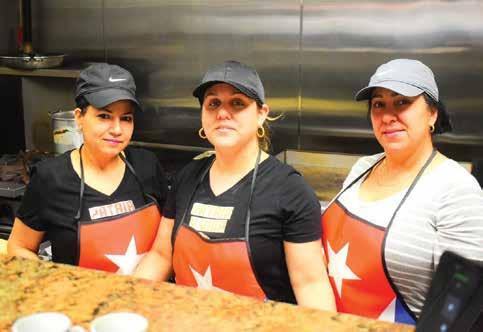
Did you know you can get authentic, not to mention delicious, Cuban food in Ypsilanti? It’s true, and it is a foodie adventure not to be missed. The dining room is colorful with some fantastic art and upbeat music, and the staff is very helpful if you have questions about the menu.

Start your journey with a choice of classic Caribbean flavors like yuca fries, ham croquettes, or Mariquitas Con Mojo (plantain chips with a Cuban garlic and citrus sauce). All entrees are also accompanied by fried plantains, a salad, and rice or beans. Choose between the popular Cuban dish Palomilla Empanizada (breaded top sirloin steaks), Ropa Vieja (shredded beef with vegetables), Masa De Puerco (fried pieces of pork), Mahi Mahi, and many more. If you are looking for something lighter, try a wrap or a sandwich, like the Cuban (my husband’s favorite). I am a fan of ropa vieja, which is so tender. The rice soaks up the rich juices, and the sweet plantains complement the salty beef.
Whatever you choose, you want to be sure to save room for dessert. There is flan, tres leches cake, arroz con leche (rice pudding), and a number of flaky pastries with flavors like guava, guava and cheese, coconut, and more. Although I felt skeptical when I first saw it on the menu, I honestly loved the guava and cheese pastry, a blend of mostly sweet and a bit of savory. Guava is not something I get to eat very often, and it’s a wonderful treat.
The Crazy Wisdom Community Journal • May through August 2023 • Page 54
The drink menu isn’t extensive. I suggest ordering a Materva, a Cuban soft drink made from yerba mate, or Guarapo De Caña, which is juice made from sugar cane, so it perfectly satisfies a sweet tooth. Other Cuban drinks include Ironbeer and Jupiña, both soft drinks despite the word beer. Though I didn’t try them, the Internet told me that Ironbeer is akin to Dr Pepper, and Jupiña is a pineapple soda. Appropriately, there are also a few coffee options on the menu such as cafe con leche and cortadito.
Cuban cuisine, as well as culture, is unique and vibrant. But Cuba is not a country many of us in the U.S. are likely to visit. Thanks to Latin American Cuban Cuisine, you don’t have to travel far to get a taste of the Pearl of the Antilles.
Latin American Cuban Cuisine is located at 2269 Ellsworth Road in Ypsilanti. They are open Monday through Sunday from 11 a.m. to 10 p.m. For more information visit latinamericancubancuisines.com or call (734) 961-7452.



Plate Sushi and Chicken
Near the corner where Broadway Street and Plymouth Road converge north of the Huron River sits a delightful American-Asian fusion restaurant called Plate Sushi and Chicken. If you are a fan of Japanese and/or Korean cuisine, this place has to be on your radar.

The interior is bright and modern industrial with a concrete floor and exposed ceiling that is painted black. Being so close to the University of Michigan’s medical campus, I did notice quite a few people affiliated with U-M sitting at tables and booths, but I also saw families. Seated at the table next to mine was a toddler who appeared to be receiving her first taste of sushi, and her animated expressions were a delight to witness. I say this to show that whoever you are, you will be welcome at Plate Sushi and Chicken.
The friendly faces you may meet at Plate Sushi and Chicken: (L to R) head chef, John Jang, Javier Mora, and Elian Ontiveros
Near the corner where Broadway Street and Plymouth Road converge north of the Huron River sits a delightful American-Asian fusion restaurant called Plate Sushi and Chicken

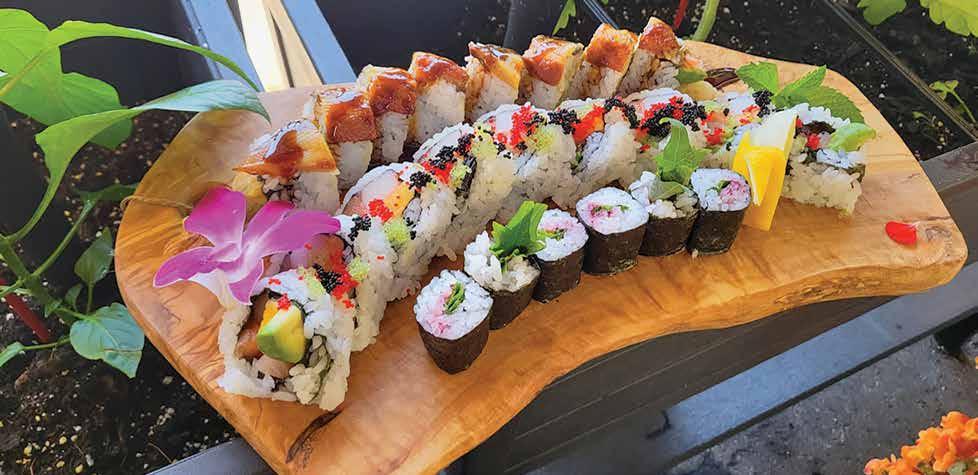
As the name of the restaurant implies, there is an extensive sushi menu. There are also chicken wings and popcorn chicken that can be ordered plain or with toppings such as soy garlic, sweet and spicy, and honey butter. You can also order bento (Japanese lunch boxes), noodle bowls, and special combination plates. The appetizer menu is also generous and definitely worth a look.
I am a huge lover of sushi, so I had a hard time deciding on what to order. I eventually settled on the Plate Poke, which allowed me to choose two fish instead of one. I chose salmon and yellowtail topped with eel sauce. The combo plate was kind of like eating a giant bowl of delicious sushi. I highly recommend it.
I was also drawn in by a side of kimchi fries, which is a basket of crispy French fries topped with Korean kimchi. If it sounds like a strange combination, please don’t be put off. It turns out fries are a fantastic way of enjoying kimchi, which was packed with flavor and spicy enough to clear my sinuses.
Due to the cold temperature outside, hot green tea was my beverage of choice. You can also choose between a number of soft drinks, energy drinks, and both sparkling and still water. For dessert, you can enjoy three different kinds of cake and flavored ice, sometimes called snow ice. Plate Sushi and Chicken’s snow ice is more like a parfait. It is made with shaved milk ice and condensed milk then topped with--depending on the flavor ordered—ice cream, a sticky rice cake, syrups, and powders. Regrettably, I did not save room for dessert, but you absolutely should.
Plate Sushi and Chicken is located at 1133 Broadway Street in Ann Arbor. They are open Monday through Friday from 11 a.m. to 3 p.m. and 4 p.m. to 9 p.m. They are open 11 a.m. to 9 p.m. on Saturday. For more information visit platesushi.com, call (734) 369-6127, or email plateannarbor@gmail.com.
OFFERING
DEEPEN YOUR HEALING WITH INSIGHT AND COMPASSION

The Crazy Wisdom Community Journal • May through August 2023 • Page 55
v i s i t w w w g r o v e e m o t i o n a l h e a l t h c o m
INDIVIDUALIZED MINDFULNESS, MEDITATION, AND TRAUMA-SENSITIVE YOGA
GROVE EMOTIONAL HEALTH COLLABORATIVE
Cooking with Lisa
Delicious Plant-Based Burgers for Spring
By Lisa Viger Gotte
Vegan burgers are plant-based alternatives to traditional meat-based burgers. They’re made with a variety of healthy and tasty plant-based ingredients, such as beans, grains, vegetables, and soy protein, and can be seasoned with a variety of spices and herbs to create a flavorful and satisfying meal.
There are many reasons why people choose to eat vegan burgers. For some, it is a way to reduce their consumption of animal products for ethical or environmental reasons. Others choose vegan burgers for health reasons, as plant-based diets are often associated with lower rates of chronic diseases such as heart disease, diabetes, and cancer. Whatever the reason, they’re super tasty!
One of the most popular ingredients in vegan burgers is black beans, which are a good source of protein and fiber. Other ingredients commonly used in vegan burgers include lentils, chickpeas, quinoa, sweet potatoes, and mushrooms. These ingredients can be mashed, chopped, or ground together to form a pattylike texture that can be grilled, baked, or pan-fried.
Veggie burgers can be made to mimic the taste and texture of meat-based burgers and can be flavored with a variety of spices and herbs to create unique and delicious flavor combinations. They can be served on a traditional bun with lettuce, tomato, and other toppings, or they can be served in a variety of other ways, such as on top of a salad or in a wrap. Other topping ideas that I’ve really enjoyed are mashed avocado, pickled beets, arugula, onion rings, thinly sliced cucumbers, spicy mayo, and any vegan cheese.
Overall, vegan burgers are a delicious and healthy alternative to traditional meat-based burgers and offer a variety of benefits for those who choose to eat them. Here are two plant-based recipes that anyone can enjoy!
Black Bean Burger Recipe

Black bean burgers are a delicious and healthy alternative to traditional meatbased burgers. Here’s a recipe to make your own black bean burgers:
Ingredients:
• 1 can black beans, drained, rinsed, and patted dry with a paper towel

• 1/2 cup breadcrumbs (can use gluten-free)
• 1/2 cup diced onion
• 1/2 cup diced bell pepper
• 1 tbsp minced garlic
• 1 tbsp cumin
• 1 tsp chili powder
• 1 tsp salt
• 1/4 tsp black pepper
• 1 flax egg (1 tbsp ground flaxseed mixed with 3 tbsp water)
• Olive oil, for frying or baking
Instructions:
Preheat your oven to 375°F if baking the burgers or heat a skillet over medium heat if frying.
In a large mixing bowl, mash the black beans with a fork or potato masher. Add the breadcrumbs, diced onion, diced bell pepper, minced garlic, cumin, chili powder, salt, black pepper, and flax egg to the bowl. Mix well to combine. Form the mixture into four to six patties, depending on how big you want your burgers.
If frying, add a little bit of olive oil to the skillet and heat over medium heat. Add the burgers to the skillet and cook for three to four minutes on each side until they are crispy and golden brown. If baking, place the burgers on a baking sheet lined with parchment paper and bake for 20-25 minutes, flipping halfway through.
Serve the black bean burgers on buns with your favorite toppings, such as avocado, lettuce, tomato, and salsa.

The Crazy Wisdom Community Journal • May through August 2023 • Page 56
Lisa Viger Gotte is a Chelsea resident passionate about plant-based cuisine and loves showing others how simple, delicious, healthy, and joyful it can be. A vegan diet improved her own physical, mental, emotional, and spiritual health and she’s seen it do the same in others! She is also an artist, cookbook author, MSVA Vegan Life Coach, and RYT 200 yoga teacher. You can learn more about her and find more tasty recipes at planted365.com.
Mushroom Burger Recipe
Mushroom burgers are a delicious vegetarian or vegan alternative to traditional meat burgers. They are often made with hearty portobello mushrooms but any mushroom will do! Here’s a recipe for chopped mushroom burgers that are packed with flavor:

Ingredients:
1 lb. mushrooms, chopped
1/2 cup breadcrumbs
1/2 cup diced onion
1/4 cup diced celery
1/4 cup diced carrot
2 cloves garlic, minced
2 tbsp olive oil
1 tbsp soy sauce
1 tsp smoked paprika
1/2 tsp dried thyme
Salt and black pepper, to taste
Burger buns and toppings of your choice (lettuce, tomato, onion)
Tea with Peggy
By Peggy A. Alaniz
With the high heat and humidity of a summer day in Michigan, the last thing I want to do is boil water for tea. It’s summer! I want to take life easy, maybe play in my garden or go out on the lake. While boiling water is not hard, I don’t want to waste time waiting for the tea to chill. While I could let the sun brew some tea, I could just as easily cold brew it in the refrigerator overnight. Cold brewing has been becoming more popular in recent years. While you mostly hear about cold-brewed coffee, this technique probably originated with tea. The great thing about cold brewing tea is that you can let your imagination go wild with fresh summer ingredients. The only rule for cold brewing is placing your ingredients in a jar of iced water and letting them steep.
The traditional teas that cold brew the quickest are oolong, white, and green. However, that doesn’t mean that black tea won’t work. It just takes a little longer. Cold brew tea is actually a good way to go if you like fruit flavored tea. You just need to mash your mint, blueberries, raspberries, peaches, strawberries, or black berries first. Then add your ice, tea, and water to the container and leave it to sit overnight.
I’d like to encourage you to expand your horizons by cold brewing your own herbal ingredients and make a tisane. Hibiscus is not only a pretty flower to look at but has a great tart flavor that pairs well with any fruit. Think about adding lemon, lime, or orange peel. Mint tea is also refreshing, should it be spearmint or peppermint. Don’t forget to add other herbs like lemon grass, thyme, basil, and lavender. Possibly even add some chamomile or a cinnamon stick to create a little different flavor profile. Have fun playing with in season fresh ingredients from your local farmer’s market. It is summertime after all! The important thing is to keep it simple. Just let time and the cold water make your tea creation. Should you desire, you can also replace the water with your favorite spirit, making a great complement to your summer picnic or party.
Some advantages of cold brewing tea, besides the fact that it can save you time, is less caffeine, more antioxidants, more vitamin C, and an overall sweetness in taste. More caffeine is released from traditional tea when using hot water versus cold, while the antioxidants and vitamin C are diluted. Warm water also brings out bitter notes in the tea, possibly because of the quicker disbursement into the liquid.
Instructions:
In a large skillet, heat the olive oil over medium-high heat.
Add the chopped mushrooms, diced onion, diced celery, diced carrot, and minced garlic to the skillet. Cook for eight to ten minutes, or until the mushrooms are tender and the vegetables are softened.

Transfer the mushroom mixture to a large mixing bowl and add the breadcrumbs, soy sauce, smoked paprika, dried thyme, salt, and pepper. Mix well to combine.
Form the mixture into four to six patties, depending on how big you want your burgers.
Heat a grill or grill pan over medium-high heat. Add the patties to the grill and cook for three to four minutes on each side, or until they are crispy and golden brown.
Serve the mushroom burgers on buns with your desired toppings. Enjoy!
There is only one way to find out if you’re going to like cold brew tea and that is to try it! Might I suggest you start with either a blueberry mint or strawberry basil cold brew tea.
Blueberry Mint Tea Recipe

2 cups of ice
4 cups of water
Handful of fresh spearmint
3 to 4 bags of black tea
Strawberry Basil Tea Recipe
2 cups of ice
4 cups of water
Handful of fresh basil leaves
3 to 4 bags of black tea
¼ cup of mashed blueberries ¼ cup of mashed strawberries
In both of these recipes you will want to start with the fruit, mint, or basil in the bottom of the container. The fruit and herbs should be ruff smashed prior to placing in the container. Add ice, and then add water. Next, submerge the tea bags into the water and leave the covered container in the refrigerator overnight. In the morning you can strain the tea mixture to remove any particles. The tea bags can be left in the water longer than overnight should it not have the desired strength. Pour the strained liquid into a glass with ice and enjoy.
P.A. Alaniz is a tea enthusiast who has an MFA in Writing and Poetics from Naropa University in Boulder, Colorado. She has also been published in Chicken Soup for the Soul.
The Crazy Wisdom Community Journal • May through August 2023 • Page 57
Garden Juju Collective
Bridget O’Brien and Charlie Brennan, earth tenders and owners of
By Hilary

Water, sun, and soil might seem a simple enough equation for a house plant, but a home garden can be more of an intricate undertaking. Shade or sun, frost or flood, drought or disease—the shifting conditions can challenge any green thumb. That’s when we turn to the experts. Bridget O’Brien and Charlie Brennan of Garden Juju Collective are in a long-term relationship with the earth. “Simple isn’t always quick,” they reminded me. Bridget and Charlie tend the land with both hands and long vision, so that a well-designed fix can be properly applied and nurtured in time. It might take a fleet of earthmovers and months of remediation, but the relationship of the water, sun, and soil can be remedied to become sustainable and self-sufficient, just as nature intended it to be, “on pace with the seasons.”

O’Brien was working as a landscaper when clients asked for plantings with little or no maintenance. Her research led her to the discovery of permaculture. The Oxford Dictionary defines permaculture as “the development of agricultural ecosystems intended to be sustainable and self-sufficient.” The practice is commonly credited to Bill Mollison and David Holmgren because in 1978 they began to teach more traditional farming methods in the face of the damage done by modern industrialized approaches. O’Brien invested in their books and their belief system. She received her Permaculture Design Certification from the Midwest Permaculture Institute in 2012 and quickly started to expand the notions of permaculture toward her greater life pursuits. “I was coming to this study just as I was moving from a place with a big yard to a little rental property in town. So, I began to consider the practices more holistically, to see how I could apply the principles beyond land use toward my whole life.” Her enthusiasm inspired her first trip to Australia to visit David Holmgren’s work.
With a PhD from Western Sydney University in NSW Australia, and a Masters from the school of Social Ecology/Ecopsychology, Charlie Brennan applies his expertise to more than the soil. His understanding of how place and purpose impacts the quality of our life is a crucial component to his work. In 2016, Brennan came to Ann Arbor to design a large installation and needed some help. Mutual friends suggested O’Brien for her interest and expertise. Their common work ethic and belief systems made it clear that they shared something more than their love of the land. They married in 2018 in a destination wedding in Ireland and have combined their efforts internationally ever since.
With 45 years of combined professional devotion to earth tending, Bridget and Charlie have earned their expertise the hard way. It is a passion that comes to these two naturally, but not without sacrifice. “Bridget and I have extremely strong convictions about what we are doing for the world, but it doesn’t come without a cost,” Charlie mused. The work is physical and arduous and not always that well supported. “We give everything we have back into it. But we wouldn’t do anything else. We feel very privileged to be doing exactly what we want to be doing. It’s our life’s work.”
They started The Garden Juju Collective in 2019 to weave together all their offerings. Permaculture is a part of their practice but not strictly. “The earth isn’t bound by rules,” Brennan quipped. For a more well-rounded approach their offerings include consultation, mentoring, design, and project management services. All of their work is anchored in a common conviction toward regenerative principals that give back more than they extract. Hosting workshops in Portugal, England, Australia, and in the United States from Wisconsin, to California and Michigan, The Garden Juju Collective is leaving their
The Crazy Wisdom Community Journal • May through August 2023 • Page 58
Collective. Visit gardenjujucollective.com.
Garden Juju
Nichols • Photos by Marcelo Paternoster
Shade or sun, frost or flood, drought or disease—the shifting conditions can challenge any green thumb.
mark from the roots to the fruit as well as in the minds and methods of earth tenders everywhere.


To further the impact of these principles O’Brien and Brennan developed a card game titled Adapt. The game is a play board and deck of category cards that prompts players “to identify your own genius and unique skill-set for solutions that are more regenerative, rather than mining and extractive,” O’Brien explained. Any life query can be viewed through this new lens, to give players “a life changing shift that considers the co-healing of self, community, and planet equally,” she continued. “The game changed my life, with a meaningful and creative approach to problem solving by design.” Their enthusiasm is uplifting but it is also urgent. “Everyone can live a more sustainable, regenerative, and healing lifestyle, and we all must,” Brennan said. “It is sharing this perspective shift that this work is all about for us.”
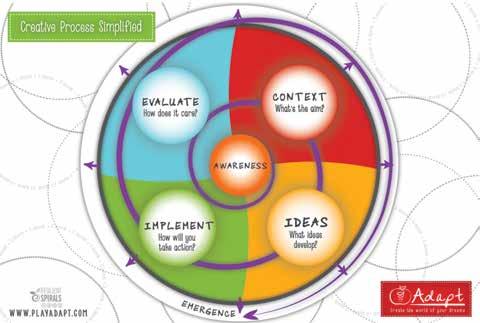

They took on the Oakhill Food Justice Farm in Melbourne Preston Australia, in the middle of the lock down. “The site was on a super rundown church ground and car lot,” Brennan said. The design plan invited student groups and community organizations to lend care. Now it is a highly functional farm and garden where the kids plant the raised beds and harvest greens to feed themselves and their families.
Closer to home, Plymouth Orchard in Plymouth, Michigan has been thriving for over 40 years, while their petting farm has remained mostly overlooked. The Garden Juju Collective was brought in for a radical redesign. With the installation of a pond, pollinators, and native species they created a heritage area, adding fodder plants in the new enclosures with the animals’ well-being at heart. A playscape for the children welcomes families that come for the cider to stay and play with the frolicking farm animals. Rather than tucked away and overlooked, now the goats are clearly a thriving and enlivening element of the orchard.

“We listen to the plants and the animals, for the soul and intelligence of the land first, and only then do we apply the remediation that allows all the natural elements to thrive in communion, the bees, the trees, and the landowners,” O’Brien explained. “Only then can we stand back and listen for the hum. That is what sustainability is all about.”
The projects that they designed and tend on two continents stand for these convictions. As consultants and designers and now business directors at Gateway Farms, Garden Juju Collective leads a fantastic team towards an innovative and ambitious farm hub vision. Hriday Ericson is on their landscape team. “I wouldn’t work as hard for anyone else,” he lauds their work environment, “I believe in the principles that they stand by. I wouldn’t give that level of labor to anyone else. I am willing to put forth tremendous energy, because of their principles. For the right reasons, it feels great to give my all.”
The Crazy Wisdom Community Journal • May through August 2023 • Page 59
O’Brien was working as a landscaper when clients asked for plantings with little or no maintenance. Her research led her to the discovery of permaculture.
Everyone can live a more sustainable, regenerative, and healing lifestyle, and we all must. It is sharing this perspective shift that this work is all about for us.
—Charlie Brennan
Read more about the work Bridget O’Brien and Charlie Brennan are doing locally, in the article titled “Gateway Farm : Growing with Permaculture” on page 60.
Gateway Farm: Growing with Permaculture


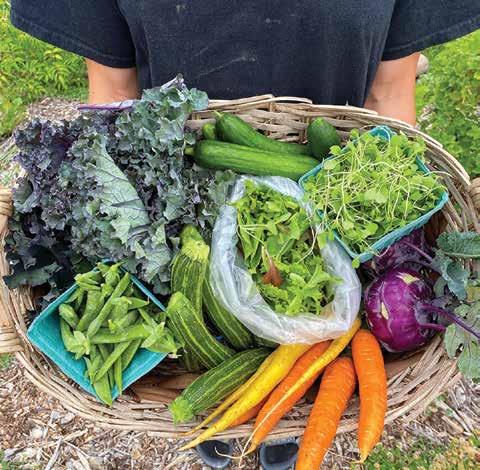
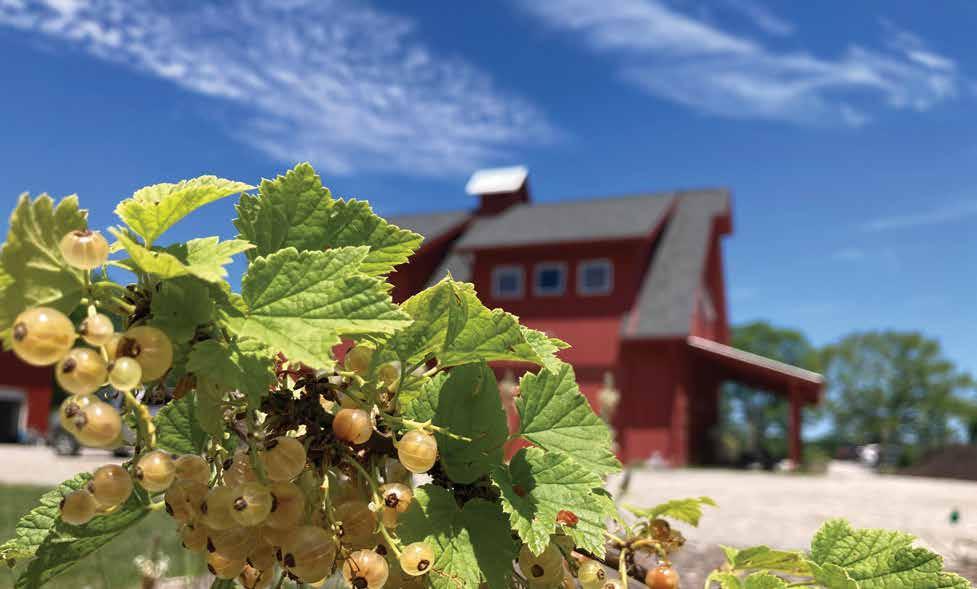 By Sandor Slomovits
By Sandor Slomovits
The mid-January day I visited Gateway Farm in Plymouth was breezy, and the temperature was in the low thirties with faint flurries falling. At the farm’s small, dirt parking lot off Joy Road, I met Bridget O’Brien who, along with her husband Dr. Charlie Brennan, is the farm’s co-director. After we greeted each other, I said, “Not the best time of the year for me to see the farm, I guess.”
“It’ll be okay,” she replied cheerfully. “We’ll be able to see everything because there’s no snow on the ground. Plus,” she added, “The sorrel is still green.”
Gateway Farm in Plymouth is owned by Mary Emmett and her family. Emmett founded the nearby Plymouth Orchard and Cider Mill in 1977 and established Gateway Farm in 2017. Zoe Arvantis, the Farm’s Markets and Marketing Manager, emailed me that, “Mary’s intention was to create a farm hub offering organic nutrient-dense food to the Plymouth Community.” She then added that, “The farm has diversified a great deal in the last five years. We have gone from offering solely organically grown annual vegetables, to showcasing a variety of food systems. Also, like many farms, when the pandemic hit, we were forced to pivot quickly. We leaned heavily into our onsite farm stand as a distribution hub for pre-order online sales. We partnered with local producers to expand our organic vegetable offering with pantry items, maple syrup, and honey. We’ve continued [doing that] today, expanding our offering even more to include perennial foods, Gateway Farm dried herbal teas and value-added products, CSA memberships, farm swag, and transplants. We’ve re-imagined our farm-scape using a permaculture-inspired vision that weaves together market gardening, food forests, land regeneration and re-wilding.”
I’d heard of permaculture, (short for permanent agriculture, which relies on a variety of perennial crops) but had never seen a permaculture-based farm in person, so I asked for a tour.
I had heard the term “food forest” before and had imagined woods with fruit and nut trees. Here the tallest plants growing on the berm near us were only about three or four feet tall.
“Yes,” O’Brien replied, “This planting is only going on its third to fourth year, depending on the plant. There’s a lot of trees in the system, and most of these were planted when they were this big,” she said, holding her hand about a foot off the ground. “So, we’re already getting some good growth on them. Eventually this will have trees, lots of trees in it, so it’ll feel more like a forest. There are layers in a traditional forest. You have tree layers, shrub layers, ground cover layers, and often vines, too. These [plantings] are meant to mimic systems in nature that a lot of indigenous cultures around the world cared for and worked on for centuries.
Our goal as the no-till system ages and needs less input and our system becomes bigger and better, is to eventually be able to close the loop and use our own compost on the farm instead of having to bring it in.
—Bridget O’Brien
We began walking and O’Brien pointed to a number of yard-high berms, crowded with a great variety of plants and bushes, curving gracefully around two small ponds and weaving throughout the thirteen-acre property. “One of the most interesting things about this farm,” she said, “Is that in our perennial plantings we have over 250 different varieties of plants.” She pointed to the berms. “This feature is our food forest--our perennial food system. Eighty to ninety percent of everything that’s planted here is edible in some way, shape, or form.”
The Crazy Wisdom Community Journal • May through August 2023 • Page 60
These [plantings] are meant to mimic systems in nature that a lot of indigenous cultures around the world cared for and worked on for centuries.
—Bridget O’Brien
Look for the companion article on Bridget O’Brien and Charlie Brennan and their business, Garden Juju Collective, on page 58.
We do have mulberries and other stuff that we planted on the other berms that you’ll see are taller than us now. They were planted at the same time but are just happier and grew faster. A lot of food forests are planted kind of like a wild forest, where it’s a bit more of a scatter pattern; there’s a tree here and maybe one over here, but it’s a different species. However, this [food forest] was designed for production. So, there’s a row of serviceberries, rows of elderberries, and we have three patches of honeyberries, but they’re all in one section. As they grow and we harvest them, they’re easier to find. Elderberries are growing really well here. We’ve planted over fifty elderberries on the property; we started harvesting this year—seventeen pounds—second year of growth.”
We came to a small flat area devoted to mints. “We put it [the mints] far away from everything, so it won’t take over. It can grow into the grass, we don’t care. We have a number of varieties that we harvest: chamomile, lavender, calendula, and others. Many of our native herbaceous perennials make really great medicinal teas. A lot of the understory of the food forest are medicinals that we’re value-adding into our herbal tea blends.

We walked by a small pond, and I asked if that had been there before they began farming here. “No, this was all flat or flat-ish. There are wetlands surrounding this property. This land probably also was a wetland, but it was clear cut, flattened, and farmed. Then it was turned into a golf driving range for forty years. When we came to the property, this was just all grass. These ponds were built for the design. These berms were not here, we built them all out of soil from the property. We don’t irrigate with the water from the pond. We have three wells on the property, and we have pretty good water. But we are going to start using this [water from the pond] to irrigate our propagation house.” (A hoop house near the pond.) And we’re setting up systems so that in the future— there’s predictions for El Nino years coming up—we’ll be able to irrigate out of the pond as needed.
The pond is fed by ground water, but there’s also a drain tile from one of the wetlands that comes underground and feeds the pond. There’s an outlet of the drain tile that comes out. When we have mega rains, it can’t process all the water. So, we have an overflow system. We are on a wetland, so water management is number one in the design. Before we did this system, these fields would flood regularly, which made them pretty much unmanageable.”
We come to another berm and O’Brien leans down to pick some green leaves. “This is sorrel, a perennial green, it’s popular in European cooking, and it’s often made into a soup. It’s a really nice green. I think it tastes like lemon spinach.” She hands me a leaf, I chew and agree appreciatively, “Yes, lemony.”
“It’s a nice citrusy flavor,” she says, then adds, “It’s got a fair amount of oxalic acid in it, so you want to cook it more than just eat it raw, but you can definitely dice it up and put it in your salads. It’s really great for soups, stir fries, and flavoring.”
I point to a plant I recognize. “Strawberries?”
“Yes. This is our acid loving berm. Since we built all these berms, we wanted to highlight, or create different micro-climates in different systems. We do not
Writers Wanted
Fun ways to be visible in the community, and connected.
Kids Columnist
We're looking for a new columnist for our ongoing CW Kids Column. Each issue, the columnist writes a feature article which includes three or four profiles of interest to parents and their kids. We focus on people, organizations and businesses offering cool, fun, meaningful and sometimes therapeutic activities, programs, events and classes for kids. Great opportunity for a writer who is also a parent.
Writers
We are always looking for good articles about the holistic scene… reportage, personal journaling and essays, profiles, interviews, journalistic explorations, and other feature writing.

Modest but respectable pay. If you might be interested, please send a letter of interest and links or PDF samples of previously published writing to jennifer@crazywisdom.net.

The Crazy Wisdom Community Journal • May through August 2023 • Page 61
• • • •
Gateway Farm: continued...

We do not have sand on this property, it’s clay, very heavy clay. People that have worked on this property have said, ‘We’ve never worked on clay this horrible.’ Yet we have all this growing.
—Bridget O’Brien
have sand on this property, it’s clay, very heavy clay. People that have worked on this property have said, ‘We’ve never worked on clay this horrible.’ Yet we have all this growing. We brought in three yards of sand, mixed it with the clay and compost and put the berm together. Then we planted blueberries and a variety of serviceberry that like acidic soil. The blueberries are small, but getting there, they’re a pretty hard thing to grow in clay. This isn’t the best place for them, so it’s a bit of an experiment. But, instead of just growing native fruits here, like serviceberries and paw paws—we do have all of those—we also wanted to make sure we had familiar things. So, when people are walking through, they’re like, ‘oh, that’s a strawberry, that’s a blueberry.’ Each berm has a theme. We have some asparagus on this berm and also hazelnuts on the backside of it, and this is lovage on the end. And on all the berms we have different nitrogen fixers. We have either baptisia or speckled alders or redbud trees or one of three varieties of clovers.”
We walked by several tall piles of wood chips and what looked like compost. “We have a tree trimmer that comes and dumps wood chips for us all the time. It’s a service to them and to us. We use a lot of wood chips on the farm, hundreds of yards a year. This is a compost system that one of our crew members, Jesse Raudenbush has set up. He owns Starr Valley Farms, does a lot of work with Project Grow, and also designs really cool vermicomposting systems (worm composting) and we have one of those. Everything over there,” she said, pointing to the piles, “Is material from the property, other than the wood chips. We have piles for our vegetable byproducts and our weed byproducts. He mixes those with the wood chips and turns them and we’ve started producing our own compost on site for our no-till system. Our goal as the no-till system ages and needs less input and our system becomes bigger and better, is to eventually be able to close the loop and use our own compost on the farm instead of having to bring it in.”
O’Brien points to another section of the farm, “There is a little frog pond that drains into the larger pond. That’s our paw paw patch. We have a collection of hazelnuts. There are berms that have some chestnuts on them. In the back corner we have a set of berms that are all planted with things that you can
coppice, cut on rotation.” (Coppice is crop raised from shoots produced from the cut stumps of the previous crop. Coppicing is regenerating crops that way.) “There are chestnuts, hazelnuts, osage orange, comfrey, and redbuds back there. They’re all meant for biochar and fertilization.”
The word ‘biochar” was new to me, and O’Brien explained that it’s the residue of ashes of organic material, “Tiny, kind of honeycomb structured pieces of organic matter that hold a lot of nutrients. They can help retain water, [but] they also help the micro system under the ground. It’s something that we’ve added in bits and pieces across the farm, and eventually we’ll be able to start producing our own. We should be able to, starting this year. Our beehives are also back there.”
I marveled at the great variety of farming materials, systems, and approaches. “It seems you have created a whole ecosystem here,” I said. “Incorporating a great many different techniques and plants and animals, as opposed to so much of what modern agriculture seems to be—growing huge fields of a single plant. The fact that you’ve got this whole variety here seems to be part of the plan. It is the plan, right?”
“Yes,” agreed O’Brien. “It’s all about diversity. We’re inspired by permaculture and its ethics and principles, and we designed from them, along with principles of conservation, rewilding, ecopsychology, and a number of other things. Using and valuing diversity is super important. A lot of the flaws that we see with monocultured systems, a lot of the diseases and pest pressures, are not eliminated through these systems but they’re prevented. It also shows a lot more resilience. Some of the experimentation we have going on here is figuring out what works. There’s a chance that we’ll say, ‘Oh, this plant isn’t working. We’re going to rip it out and replace it with a plant that’s more prolific because we are still trying to produce.’ So, if currants don’t seem to be happy here, maybe currants aren’t going to be a part of the long-term system, but gooseberries are a powerhouse here. So, elderberries and gooseberries, we know for sure we’re going to grow more of those. Rhubarb is hard to grow in heavy clay, but we’ve created systems which grow amazing rhubarb. That’s something that’s really

The Crazy Wisdom Community Journal • May through August 2023 • Page 62
familiar, and people like. People like our wild arugula. They like our sorrel. So, we’ll start bulking out on the things that people like but continue to educate them on other things.”
We moved on to a small field with visible straight rows. “These are our garlic beds that are all planted out. Every time we flip a bed, we add more compost and wood chips at varying depths, depending on the quality of the soil and on the crop that’s going in next. We’ve been producing food for about five years and the no-till system is only about two years old.”
Pointing to a large funnel-shaped concrete slab, O’Brien said, “This is our new compost and materials bay. We’re super into soil preservation and covering, and conservation plantings, water management and erosion mitigation. Compost can be an environmental issue when it’s running off into water, and you can’t put it anywhere on this property without it running off. So, it’s going to run into a cattail pond, which will help remediate it.”
As we continued walking, O’Brien pointed to a small stream. “This is our vernal creek that runs as needed. It helps move the water. Water management is a big thing here. Everything in here is a native plant and everything in the gardens are all native plantings too. We do harvest off them. We have rose hips, some serviceberries and mulberries and things over here, but mainly this is for the wildlife and for the sanctuary aspect of the farm.
These used to be thistle fields and we’ve been working on a system of tilling, cover cropping, and cutting at particular times to remove the thistle so that we can plant meadow style wildflowers.” O’Brien laughs as a memory surfaces: “In our last organic inspection the guy comes, and he does his thing, we’re walking around the farm, and we show him this area and he goes, ‘Okay, don’t need to have a talk with you about biodiversity.’”
I spot a small grouping of young trees and ask about them. “It’s a mini forest. We have a funny patch of land in the corner of the property that is hard to farm. It’s a wet spot, the water just pools there. Here we’re trying to demonstrate what a miniature forest looks like and also a different way of setting up a system. Here the overstory, the larger trees, were put in the ground first and we’re maintaining clover and grass underneath them. Then as they get bigger and can drink up the water there and hold space and start to shade things out, we’ll start putting other layers of plants underneath them. Most of this project [the Gateway berms] was planted in one fell swoop. Then we’ve gone in and fixed things or adjusted, added more, took stuff away. Whereas this one, [the mini forest, we started with] just the overstory. When that gets established, we’ll come in and do another phase. It’s demonstrating another way to do it. It also shows that you don’t need fifty acres to plant a forest. You could plant a forest in your backyard if you wanted to.”
Here at Gateway, Mary Emmett wanted to create a space that felt like sanctuary, a space for horticultural therapy, trying a different approach, a kind of future-of-farming approach.

—Bridget O’Brien
O’Brien started working at Gateway at the end of 2018. At first, she and her husband Dr. Brennan were working for Mary Emmett’s orchard and the farm, consulting and designing the various systems, but recently they’ve also come on board as farm co-directors. They have a separate joint business, Garden Juju Collective, and they travel widely teaching permaculture and many other related techniques of sustainable agriculture. (See article on Garden Juju Collective on page 58).
“We live in Ann Arbor. I grew up on Geddes Road, so this is kind of home for me. We’ll be moving into the house on this property so we can better do our jobs and be present. Charlie is actually from England, in Devin. He grew up in England, Singapore, and Australia, so that’s why we travel and teach in all those places.
When I got out of college, I got super into growing plants and gardening while working at Enchanted Florist in Ypsilanti. I fell in love with plants and flowers and started gardening, cultivating, exploring, and finding out more about my roots of family farming. My grandpa used to work all week, but he had this huge veggie farm and used to give all the produce away to his neighborhood.
I worked at Downtown Home and Garden and at a number of nurseries, and I was always learning about plants and design. At one point when I was working in Tecumseh people kept coming in and asking, ‘I want a garden, but I don’t want any maintenance.’ And I’d say, ‘Well, get your glass of wine and your pruners and just go out and deadhead your roses in the evening.’ I started researching maintenance gardening and I came upon permaculture. In the mid two-thousands I took a course in permaculture, fell in love with it, said ‘I want to teach this, I want to share this.’ I took it back to my boss and said, ‘Let’s do more of this.” He said, ‘There’s no market for that.’ I said, ‘Okay, I need to move on.’ I went to other nurseries and tried to learn other aspects of the landscaping world. I realized it was the least green industry of all the green industries. You’d show up at work and they’d come in from the field in their hazmat suits and say, ‘Oh, we just sprayed.’ And I’m like, ‘Okay???’ Then a client would walk in the door ten minutes later and say, ‘Oh, can we go look at these trees?’

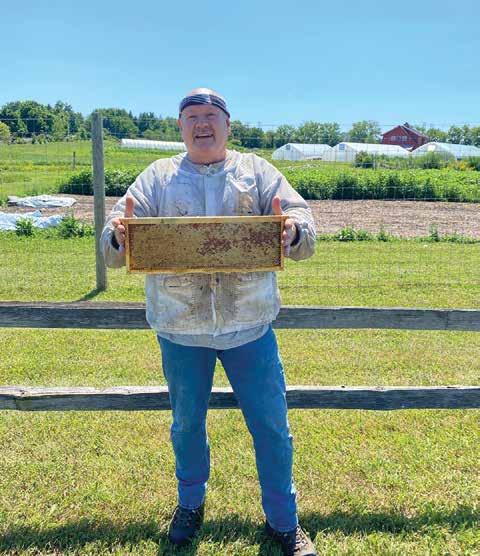
So, I went back to my marketing and merchandising background, what I studied in college. Worked with the Co-op in Ann Arbor for a while and started doing more design work and teaching through there. When I met my husband, he had been doing this for a long time. He has a doctorate in social ecology. He trained with Bill Mollison back in the nineties.” (Australian scientist, Bill Mollison is generally credited with helping to found and disseminate the theory and practices of permaculture beginning in the mid 1970s.) “We started designing and teaching and doing all this stuff together and kind of building on all these different career paths that I had at different times. They all came together and made this happen.”
Our final stop of the tour was the large hoop house that will become the farm’s new event space in the spring of 2023. (More about that later.) In a Zoom conversation with O’Brien and her husband, Dr. Brennan a few days later, we reviewed some of the things O’Brien had pointed out on the tour and talked further about other unique aspects of Gateway Farm. (Dr. Brennan joined us from Australia, the Byron Bay/ Mullumbimby area in New South Wales.)
“Permaculture is just one of the techniques we are using at Gateway,” Dr. Brennan began. “We also are using conservation and rewilding. We’re using aesthetics to bring people in, which is more ornamental gardening, if you like. And [the farm] is transitioning toward being an event hub. It’s very much a public facing place, designed to be a hub for community. It’s being designed with quite an investment from the owner to make that possible.
The Crazy Wisdom Community Journal • May through August 2023 • Page 63
The word ‘biochar’ was new to me, and O’Brien explained that it’s the residue of ashes of organic material, “Tiny, kind of honeycomb structured pieces of organic matter that hold a lot of nutrients. They can help retain water, [but] they also help the micro system under the ground.”
Gateway Farm:continued...

Bridget and I have been involved in food growing for a long time. It’s very romantic, it’s very energetic, it’s usually exhausting, and you’re usually poor at the end of it. So, we’re trying to look for a cleverer farm model than that. Rather than sending tomatoes out and trying to make a living off that, we bring people into the farm experience. People want that horticultural therapy. They want that sense of connection to the land, to healthy food; they want a sense of place, they want to gain skills.”
This brought us to the new event space—half of one of the hoop houses—that Gateway will open soon. “We’re going to make a very welcoming space in there, a teaching center, a meeting space, a space you can hire for an event,” said Dr. Brennan. “When you design outdoor spaces as landscape architecture, you’re often thinking in terms of rooms. What’s this space for? How are people invited here? How are people moving from room to room? So, we’re actually putting a room in the middle of a hoop house. It’s an interesting kind of post-industrial look when you have a nice space inside an industrial building. We’re creating this space so that Gateway can really be a hub for community and education. We want to bring in some high-level teachers, because not many people get to teach out of a landscape as well developed as this.”
It’s all about diversity. We’re inspired by permaculture and its ethics and principles, and we designed from them, along with principles of conservation, rewilding, ecopsychology, and a number of other things. Using and valuing diversity is super important.
 —Bridget O’Brien
—Bridget O’Brien
“We teach around the world in different locations,” O’Brien said, “And oftentimes we’re scrambling around trying to make one raised bed work to teach a whole lesson on gardening, or one fruit tree or six fruit trees in the middle of a field. We’ve taught two workshops here and it’s been absolutely incredible because you have every single plant that you want to talk about, ‘Oh, let me show you. It’s right over here.’ Being able to show micro-climates and some of the techniques has been really fun.
The hoop house is a season extender, so it’s really comfortable. We’ll have lighting in there, we’re going to put shade fabric in so it’s nicer in the summer. We’ll put in passion fruit and grape vines to shade it out, make it more comfortable in the heat of the summer. We plan on putting edgy plants in there, like fig trees, and keep producing a wider variety of crops to show how to do it, and also just to make it feel really good. We’ll take our landscaping backgrounds and make a beautiful, inviting space.
Mary [Emmett] has been working with the land and cultivating food for the community for over four decades now, [at Plymouth Orchard and Cider Mill]. Here at Gateway, she wanted to provide nutrient dense food to the community. Really what she was looking for was creating a space that felt like sanctuary, a space for horticultural therapy, trying a different approach, a kind of future-offarming approach.
The first time we met, we’d pulled together this presentation and we were pretty excited to meet this client who wanted to do something that’s totally up our alley--putting in ponds and perennial food systems and wildlife and native plant areas. And somewhere in the meeting she looked at me and said, ‘You know, I’ve been waiting a really long time for you to show up.’ That felt good. Charlie and I, both of us have gone through a variety of careers and paths as we’ve gotten to the point where we are today. All of that has informed what we do. It’s unusual, it’s different, and it’s not for everybody, but the people that can recognize it, someone like Mary Emmett, who was looking for a different approach, she was very excited to find and meet us and have us jump on board.”
“The great thing about having a patron like that,” said Dr. Brennan, “Who trusts us so much, is that we get to express what things can be done and we take it further. We experiment. We push the edges a bit, and you come up with landscapes like Gateway Farm.”
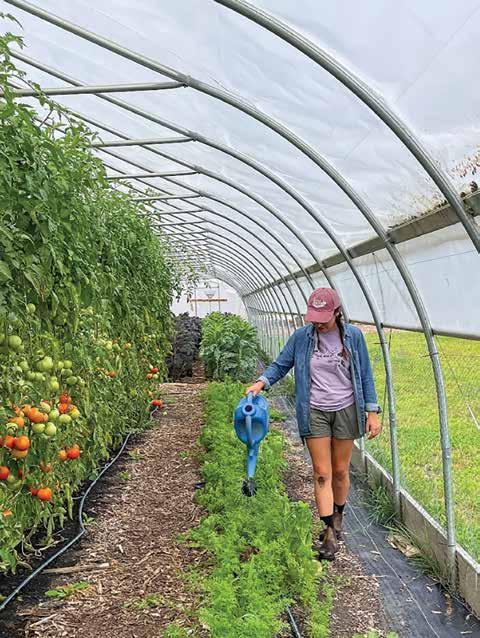
“Mary is an experienced farmer,” continues O’Brien. “She’s been doing this for a long time, and so she knows what it takes, and she knows the kind of resources that are needed to be efficient and be edgy and try things out and produce something really interesting that the community’s going to want to see. She also makes our jobs easier by making sure we have the resources we need to do the work. She knows the value of that, and that’s part of the joy of working for her. Her willingness to invest into these types of things, not only for the people that work here, and our growing and our learning, but also for the whole community.
What we’ve been working toward here is soil health, water health, and human health--how they’re directly related and the importance of that. It’s a collaborative effort. It takes a lot of people and a really dedicated team to make this project happen. Luckily, we have those people in the project and it’s growing because of that. If there wasn’t a big team doing this and dedicated to it, we wouldn’t be here today. A lot of people take on permaculture as homesteaders and think their family of two or five are going to take care of acres of land, and they find that’s really challenging. Charlie and I, part of our mission is to kind of debunk the myths of permaculture so people can be successful. When you look at a farm like this, we have fifteen to eighteen people working here during the height of the season, it’s a reality check. You’re not going to take care of thirteen acres this intensely as a family of two laborers. This is a big group effort—all farms of this size are.
We had a few tours at Gateway last year, and having the community come in and ask questions and start to engage with the property through our workshops and the tours was really fun to see. I think we’re ready. The whole team’s really ready to open up the gates and say, ‘Come and enjoy this thing that we love, that we’re passionate about and dedicated to, and working really hard to maintain and care for.’ It’s been a leap to get to this place. It’s been a lot of work for everybody, but we’re really looking forward to it.”
Learn more about the farm online at gatewayfarmplymouth.com or visit them in person at 10665 Joy Road, Plymouth, MI. You can also give them a call at (810) 354-5154 or email info@gatewayfarmplymouth.com.

The Crazy Wisdom Community Journal • May through August 2023 • Page 64
Our final stop of the tour was the large hoop house that will become the farm’s new event space in the spring of 2023.
An Immense World:
How Animal Senses Reveal the Hidden Realms Around Us
By Christine MacIntyre
Many books praise the natural world, but none quite like Ed Yong does in his book An Immense World: How Animal Senses Reveal the Hidden Realms Around Us. He takes readers on a journey into the sensory bubble in which we live, examining the nuances between each creature’s unique perception. He explains this sensory bubble, or Umwelt, and how each being experiences the same environment differently. The result of this explanation, a book unlike others in its category, is surprising in that it regards an animal’s inner world as something worth contemplating.

Yong makes it clear from the onset that he is not interested in scientific explanations of animals, like how the study of animal senses lends to understanding human sensory systems or the reverse-engineering of animal senses to create new technologies. Instead, he explores animal senses as a method of understanding the lives of animals themselves. He says, “Animals are not just stand-ins for humans or fodder for brainstorming sessions. They have worth in themselves.” True to his word, his book reveals a world of animals and the miraculous nation among them.
Yong conveniently organizes the chapters around specific stimuli such as light or sound and “is a gateway into the varied things that animals do with each stimulus.” The chapters stray from the primary senses, examining color, pain, surface vibrations, echoes, magnetic fields, and more. However, as Yong takes readers through each chapter, he cautions that their perceptions and intuitions will likely stand in the way, limiting how far into animals’ Umwelt they can step. He asks readers to open their imaginations to optimize the value and glory of learning something new and unexpected. “…all is not as it seems, and that everything we experience is but a filtered version of everything that we could experience.” Readers’ worlds will expand and deepen, opening the mind to exploring animals’ worlds.
Yong makes it clear from the onset that he is not interested in scientific explanations of animals, like how the study of animal senses lends to understanding human sensory systems or the reverse-engineering of animal senses to create new technologies. Instead, he explores animal senses as a method of understanding the lives of animals themselves.
Chapter one dives into smells and tastes. Yong introduces readers to an expert on dog olfaction, or their sense of smell, with whom he discusses all things “sniffy and nasal.” The resulting text relays the world of a dog—how his prominent nose is his main interface with the world and how it works. Readers learn how dogs perceive smell and the similarities and differences between humans. Scientific evidence intersperses the text with statistics, data, case studies, and quoted text from experts. Further, the text conveys why the way animals smell and taste are phenomena worth exploring.
Chapter two explores vision and how various animals perceive light. Interestingly, the text reveals how humans’ perceptual biases come into play. For example, humans have sharp vision, which “muddies our appreciation of other Umwelten” because of the assumption that animals can see what we can see. This false perception prompts readers to wonder what other biased assumptions they make about the animal kingdom. Cows or chameleons, for example, view things drastically differently than humans, so one must ponder what it must be like for animals who don’t share humans’ relentlessly forward-facing visual field.
Yong manages to dispel assumptions about pain perception in chapter four, where he goes to great lengths to explain that not all animals experience pain in the same way humans do. Additionally, he demonstrates pain function. While highly subjective and variable across species, it’s imperative to understand pain
among animals. “…We rarely distinguish between the raw act of sensing and the subjective experiences that ensue,” Yong explains. But understanding the constructs of pain “is a morally, legally, and economically vital matter, which affects our cultural norms around catching, killing, eating, or experimenting on animals.” Again, the explanation educates readers on why understanding this pain in animals matters.
Yong gives readers more than information; he gives them the gift of a deeper understanding of something so powerful that it can be life-changing in how they perceive the world.
Similarly, chapter six explains why the sense of touch among animals should be addressed. “…by considering how touch contributes to the Umwelten of different creatures, we will see sandy beaches, underground tunnels, and even internal organs in new ways.” Yong gives readers more than information; he gives them the gift of a deeper understanding of something so powerful that it can be life-changing in how they perceive the world. He explains how sea otters, star-nosed moles, birds, wasps, and manatees experience touch and how it shapes their world.
To tie all the chapters together and connect the dots for readers, Yong utilizes chapter 12 to explain that while we dissect each animal sense to understand their uniqueness better, animals combine and cross-reference information from each of their senses at once. “To truly appreciate Umwelten and to bring our voyage through the senses to a close,” readers should consider the entire picture. From the architecture and anatomy and how it works to how the form of an animal’s body defines its world and how “animals combine the sensory information from the outside world with that from inside their own bodies.” He closes this chapter with the heartfelt sentiment that even a partially successful attempt at understanding animals as a whole “will reveal wonders that were previously hidden to us.”
An Immense World is not a light read; instead, it is a curious deep dive into the animal world unfolding the mysteries of animal senses and their role in creating the Umwelt of various species. Yong packs details into each chapter about the mechanics of animal senses. Further, the exploratory text reveals the nitty gritty of each sense in meticulous detail and sheds light on how the deeds of humans upend the worlds in which animals exist. “Instead of stepping into the Umwelten of other animals, we have forced them to live in ours by barraging them with stimuli of our own making.” Additionally, An Immense World is a call to action. The text urges readers to acknowledge that animals may feel or experience something radically different than humans and provides evidence to invoke a sense of precaution.
However, readers don’t need to be animal experts or scientists to appreciate this book. Instead, Yong asks that readers join in the conversation by opening their minds to the possibilities while imagining they are in the “shoes” of these different species. It isn’t so different than asking an individual to consider what life is like for other human beings as an act of compassionate understanding— to truly see someone else. Yong aids in this process with thorough explanations, diagrams, colorful photos providing a close-up look at various animals’ sensory organs, and plenty of metaphors that are easy for humans to relate to by way of imagination.
The Crazy Wisdom Community Journal • May through August 2023 • Page 65
Book Review
psychological evidence of animals helping aid depression, anxiety, and sadness is nothing new, but Dasa said cows have an “added benefit” because “they have a lower heartbeat, and their body temperature is warmer, so they act like a warm blanket when you hug them.” He adds, “They are also excellent listeners.”
Dasa’s deep bond with the herd is evident–the cows will come running to him like puppies if their names are called; his favorite cow, Padma, is quick to smother Dasa with nuzzles at almost every opportunity he can find.
Peace, Love, & Cows

 By Cashmere Morley
By Cashmere Morley
There is a feeling of peace in the cowbarns at Goloka Eco Experience in Maybee, Michigan. The farm air feels crisp as it enters the lungs—unequivocally more clear than city air. In this moment, the gentle thud of a heartbeat or thwap of a tail against the ground is one’s only soundtrack against the world. Soft, big brown eyes peer out from underneath impossibly-long eyelashes, begging for pats on the head or scratches at the nape of the neck. Goloka Eco hosts an experience one simply cannot find among the hustle and bustle of regular everyday life--an invitation to be present. To come sit. To forget about time for a while. To cuddle a cow, as volunteer Karunasindhu Nitai Gaura Dasa says, is to form a “meaningful relationship.”
The AirBNB experience began in 2020, after Dasa and other Goloka Eco volunteers felt like the burgeoning stress of Covid was emotionally weighing everyone down. During that time, Dasa, who works in the automotive industry, would get off of work and come to the farm to cuddle with the cows to unwind. He would often leave the farm feeling more relaxed and centered after the experience–which led to him to wonder if others would benefit from cow cuddling, too.
“Initially, we started [cow cuddling] without charging people. And then we thought, why don’t we charge a minimum fee so that we can also support the cause? Because during winter, we were struggling a little bit to feed the cows, because hay prices were going up. So, we opened [cow cuddling] on AirBNB Experiences. It took off from there.”
Goloka Eco is a nonprofit organization that runs this experience, and others on the farm, solely through the work of volunteers. The farm was obtained in 2019, and cow cuddling began a year after that.

Dasa said cow cuddling is an “ancient activity” that has been part of Indian tradition for thousands of years–he notes that his grandmother had a cow, as did her mother, going back for as far as he can remember, though he noted that cows and their importance are not only tied to Indian tradition. The
“I’m not supposed to have a favorite,” Dasa said with a smile, “...but Padma is my favorite boy. He was a surprise baby. We never knew he was coming. And when he was born, he didn’t have colostrum. (The nutrient-rich milk that helps in the development of immunity in the newborn.) So, we had to take him to the Ohio State University and do a blood transfusion. And the doctors were asking ‘why are you paying this much money for a $50 calf?’ But he meant a lot to us. He was born at the farm and he was part of the family. He escaped death once. Besides that, his demeanor is also very soft and he’s the first one to approach me and he has a lot of affection.”

Escaping death once raises the question, just where did these cows come from in the first place? Enter Yashoda, mama cow and top-tier cuddler.
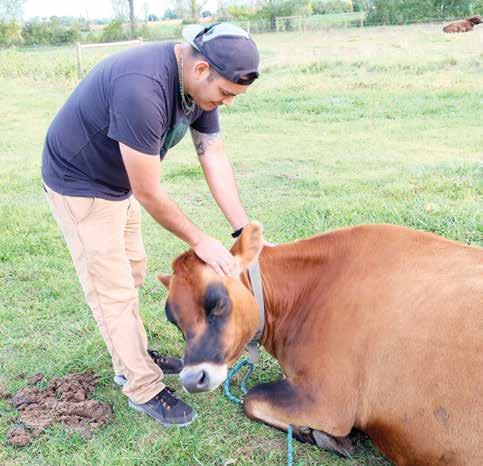
“There are seven cows total on the property, now,” said Dasa. “Three cows, two adults and one calf, on the property were rescued from the previous owner who had the farm. He told us that he could ‘take care of the cows’ ....basically, slaughter them, if we wanted, and we said no, we will keep them. In so many ways we rescued them from the previous owner when we acquired the farm. And then I thought, okay, the new calf was lonely. Let me get another one. So, I got another one from an Amish farm far away.”
A three-hour drive to an Amish farm in Grand Rapids proved fruitful, and Dasa returned to Goloka Eco with Yashoda.
“The Amish farmer thought she would never have a baby because she had a bowed leg, and having a bowed leg means she can’t carry the weight of the baby during pregnancy. If a cow cannot have a baby, she goes to slaughter, because there’s no use for a cow who cannot produce milk. We took her in, and then nine months later, we saw her licking something on the ground... and we went to investigate, and it was a calf.”
The Crazy Wisdom Community Journal • May through August 2023 • Page 66
In this moment, the gentle thud of a heartbeat or thwap of a tail against the ground is oneís only soundtrack against the world.
Dasa said cow cuddling is an ìancient activityî that has been part of Indian tradition for thousands of yearsñ he notes that his grandmother had a cow, as did her mother, going back for as far as he can remember, though he noted that cows and their importance are not only tied to Indian tradition.
It was then that Padma entered Goloka Eco, or as Dasa puts it, the farm grew “from three to four to five by surprise.” No one knew Yashoda was pregnant when they adopted her.
After that came another birth, during which time Dasa went out to seek yet another calf so the newborn “wouldn’t be lonely.” The new calf he adopted was so skinny and frail, Dasa could pick him up himself and put him in the back of the car.
“We call them a herd, but you know, within the herd, you can see how they take care of themselves,” said Dasa. “And once you start interacting with them, and brushing them, cuddling them, you kind of become part of their family, and they tend to reciprocate in that relationship. You form a deep bond, a deep relationship with the cow. People are looking for meaningful relationships in this world. When you can develop deep relationships with animals, that’s also rewarding,” said Dasa.
“To me, this experience is for people to form a deeper relationship with animals and hence feel nourished by that. We want them to meet their meat—to understand that these animals have a profound sense of emotion. When the visitor goes home, they can also think a little bit deeper about the animal they are eating. These animals have personalities; they have likes, dislikes.”
If someone is hesitant to try cow cuddling, Dasa recommends beginning the experience with gentle mother cow Yashoda.
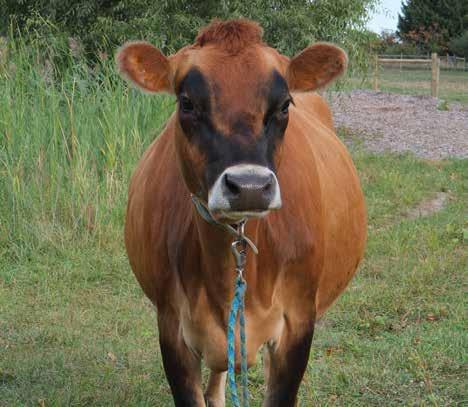
Upon entering the cowbarn, some hay will be nestled in the cow stable for a visitor to sit. A guest can lay right against the cow; Cows love to be nurtured and shown physical affection just like a common house cat or dog. For $40 a person, a guest can brush, hug, and even milk the cows. The AirBNB experience lasts an hour, and visitors can sign up year-round. Guests may even be pulled around the farm in a cart by the cows if the weather is right.
“Winter is the best time for cow cuddling because the cows are fluffier,” said Dasa, “and there are less flies. Plus, in winter, most people are inside, and the weather can be depressing at times, so it’s a chance for everyone to come out and do something fun.”

While cow cuddling can be done as a group experience, Dasa recommends going solo or with one other person—keeping the group as small as possible allows for a deeper bonding experience. Do not wear open-toed shoes and choose attire that can be cleaned easily.
Describing cow cuddling in a phrase, Dasa said it is “heart-transforming.”


“You come here, and you feel a lot of love,” said Dasa. “Love is a word that’s been thrown around, but love is an act of service. It’s more of a verb than a noun. When you love someone, you do service, and when you serve the cows by brushing them, taking care of them, milking them, you see their affection. You will genuinely see the affection back. When you call their names, they come running.”
Goloka Eco is located at 9756 Ferder Road in Maybee. They host the cow cuddling experience Friday through Sunday, mostly during the evenings. Search for “Cow Cuddles, a Bovine Therapy’’ on AirBNB or go to golokaeco.com/cowsanctuary to see the available times to experience cow cuddling at Goloka Eco Experience.
The Crazy Wisdom Community Journal • May through August 2023 • Page 67
Cows love to be nurtured and shown physical affection just like a common house cat or dog.
A Good Crop of Mental Health
Story and Photos by Grace Pernecky
Laura Sanders, LMSW, ACSW, has been practicing in the Ann Arbor area for 34 years and has been teaching as an adjunct professor at the University of Michigan School of Social Work for 26 years. Her approach to therapy utilizes a wide variety of evidence-based and creative therapies, including trauma recovery methods, art and play therapy, Cognitive Behavioral Therapy, and relational approaches through Animal Assisted Therapy. She runs her practice out of Lovingway Farm, which she and her spouse, Ramiro Martinez, have owned and cared for since 2013. She has gradually integrated many of the animals on their farm into her therapy sessions--a unique approach that is currently gaining traction in the field of social work. Sanders has found the result of partnering animals with certain clients to be astonishing. She is also an activist who advocates for justice and social change in the areas of women’s equality, the rights of children, TLBG (Transgender, Lesbian, Bisexual and Gay) concerns, and institutional racism; additionally, she co-founded the Washtenaw Interfaith Coalition for Immigrant Rights in 2008. Her farm, and by extension, her practice, are both inclusive, loving spaces that co-create an atmosphere of mental health and healing.
Lovingway Farm
The name Lovingway Farm is an apt one for Sanders’ therapeutic farm. “Instead of vegetables, we produce mental health,” Sanders told me during one of our chats.
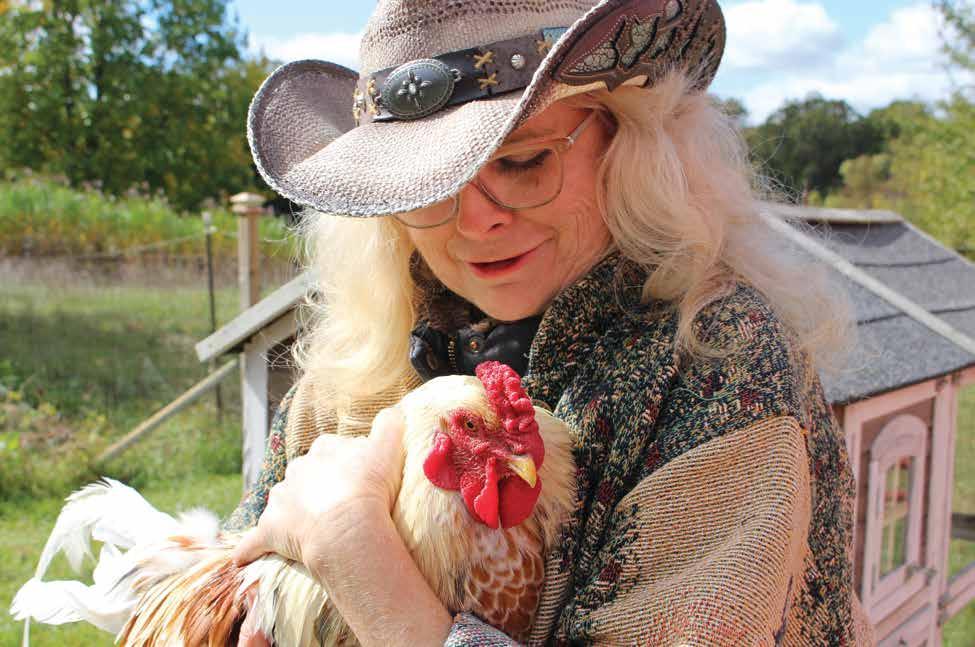
As you step out of your car in the grassy field that serves as a parking lot, you immediately sense that this quip is true. Walking back to the horse barn, which is where you’ll usually find Sanders, you’ll pass a pen of three gray and blackmottled pot-bellied pigs and two gorgeous, pure white roosters who come right up to the fence to catch a curious whiff of a new human. Then, you’ll spot the bunny and chicken village, right up against Sanders’ house. Silkies, one of the friendliest of the chicken breeds, will cluck, call, and beckon you to come closer, and perhaps offer up a mealworm. In the distance, you’ll notice a few other large fenced-in fields and realize that other friendly creatures are likely grazing just out of sight. As you walk closer to the barn, a small white dog, full of energy and holding a stuffed toy in his mouth, bounds up in excitement ready for play. His name is Buddy. Sanders is not far behind.

A Conversation about Animal Assisted Therapy with Laura Sanders
Entering the horse barn, you’ll be struck not only by the cleanliness and organization of the structure that houses the largest of Sanders’ therapy animals, but also by the art. Animal-themed art, whimsical and sometimes antique in nature, adorns the walls. In preparation for the minicourse that Sanders teaches through the University of Michigan (U of M), a large circle of chairs, all facing inward, outline the perimeter of the room. A small, wooden table sits off to the side, adorned with an assortment of fruit, a homemade salsa, a large bowl of chips, and festive, seasonal decorations.
When Sanders greets you, the first things you will notice are her hat and her smile. The smile is warm, inviting, and attentive, and the cowboy hat she wears is adorned with a variety of textures, patterns, beads, and a small, decorative buckle. She listens too and is present with you, but she always has one eye on her animals, as any experienced Animal Assisted Therapist should.
Creative Approaches to Therapy: Tools in the Toolbox
Sanders has been a practicing therapist over 30 years now, but it’s only within the past seven years that she’s been integrating animals into her work. “There’s nobody in Michigan doing what we’re doing here at Lovingway,” Sanders told me. With a bit of digging, I can see that this is true. Though there are a
The Crazy Wisdom Community Journal • May through August 2023 • Page 68
When Sanders greets you, the first things you will notice are her hat and her smile.
variety of people incorporating horses into their therapeutic practice (Equine Assisted Therapy), and yet more therapists working with therapy dogs (Canine Assisted Therapy), there aren’t many others working with a variety of different farm animals, as Sanders does; eight different species, to be exact. Dogs, cats, goats, chickens, rabbits, pigs, horses and miniature horses, and donkeys are all integrated into the relational methods that Sanders utilizes in her practice.
“I have always been creative,” stated Sanders, “and so earlier in my career, I was really interested in integrating art and different forms of creativity with healing trauma.” With a BA in Women’s Studies from U of M, as well as having been in art school for a while, Sanders’ therapeutic methods are interdisciplinary and synergistic, rooted in feminist theory as well as utilizing the healing powers of creativity. Her background has allowed her to view healing as a creative process, as opposed to the “one-size-fits-all,” top-down approach that we see all too often today. Though there’s much evidence and research that this form of therapy can be helpful, it has its limits. As Sanders put it, “A Cognitive Behavioral Theory (CBT) approach can certainly be a helpful tool in the toolbox, but all too often we forget that it is one tool.” CBT relies on the principle that psychological issues are based on problematic or even destructive ways of thinking, which in turn can lead to problematic or destructive behaviors. It offers that participation in talk therapy with a trained professional can help to change these destructive thought patterns and/or behaviors.
Heart to Heart Shamanic Healing Harmony of Spirit for Life
Judy Liu Ramsey Practitioner

*Shamanic healing for people & animals



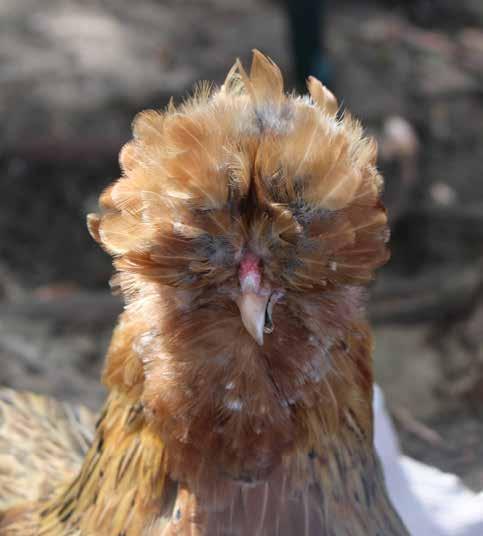

*Support for life changes, loss & grief
*Support for healing trauma & PTSD
*Classes in shamanic practice
*Ceremony for clearing, healing, bonding
For information or appointment, contact: info@judyramsey.net website https://JudyRamsey.net
“The problem with trauma is that it really affects the way that you think. It’s not easy to think your way out of these deeper issues. They register in the body, and so, correspondingly, the healing needs to be embodied,” Sanders concluded. When we experience trauma, we use our “back brain,” fight-flightfreeze responses. These are dysregulated states. The memories of that trauma and the capacity to access what happened and talk about it is a frontal lobe activity. Sanders realized that when she started working with teenagers who’d been sexually abused or had some other trauma that it was really hard for them to talk about it. “The left frontal hemisphere of the brain is where your language centers are. There is some evidence that this center shuts down when folks are reminded of trauma that caused the back, reflexive brain to become active in order to survive,” Sanders clarified. This meant that the clients needed creative avenues that reach the senses in order to eventually talk about the trauma. This is where tools such as art therapy, Theraplay (a form of therapy that utilizes engaging sensory and physical games and other activities to support meaningful, healthy relationships between children and important adult figures in their life), mindfulness, adventure therapy, and yes – Animal Assisted Therapy (AAT)—come into the picture. These are therapies that use your senses, that are relational in their nature, and that help awareness reach much more than just the frontal lobe of the brain.
The Crazy Wisdom Community Journal • May through August 2023 • Page 69
The name Lovingway Farm is an apt one for Sanders’ therapeutic farm. “Instead of vegetables, we produce mental health,” Sanders told me during one of our chats.
5245 Jackson Road Ann Arbor, Michigan 48103 tinylions.org 734.661.3530
A Good Crop of Mental Health continued...
Laura works hard to make sure that the farm is an inclusive environment. On the farm tour she gives all clients at the beginning of their work together, she introduces them to Dusty and Hart, two beautiful white silkie roosters. “We call them our gay male couple, because they love each other; they are each other’s best friend and life partner, and they move as a unit. We want to instill in people who visit the farm that this is an inclusive place. So, we use a lot of metaphors like that.”

In addition to being helpful in metaphorizing LGBTQ issues, chickens can also be great models for adopted children that Sanders sometimes works with in resolving doubts, fears, and anxieties about their status. When hens are broody, they care for whatever eggs they are sitting on top of, even if they were not produced by them. “If I have baby chickens and a mom, who is a broody hen, I’ll just have these kids sit here and watch this relationship between the hen who’s not biologically related, but who is the mother for these chicks. It can be incredibly healing to these children to see such fierce love exist in that space.” These are just a few examples of working with chickens—each species, and each individual on the farm, has their own personality, each one uniquely equipped with qualities that may prove most beneficial for any given client to form a relationship with.
How to Give a Pig a Belly Rub
“Animal Assisted Therapy is truly just another form of art,” Sanders said. “However, it requires very strong ethics of mutuality and partnership with animals, rather than having the mentality of ‘using’ animals.” One principle that Sanders always tries to instill in anyone who comes to the farm is that the animals are our partners. “That means it’s mutual. There’s something in it for them,” stated Sanders. It could be giving the chickens something interesting to pay attention to, other forms of stimulation and engagement, or a treat. “We don’t really use a lot of treats though,” Sanders cautioned, “They can actually be quite distracting. I think there’s a parallel here; we tend to use too many behavioral methods with kids where we’re rewarding and consequencing them using ‘treats,’ when it’s actually a relationship that they need.”

During a one-credit minicourse on AAT that Sanders teaches through U of M, Social Work graduate students are able to directly experience this relationshipbuilding process with animals, and how they might incorporate this method of therapy into their own practice someday. For a full Saturday and Sunday, students come to the farm and undergo a variety of experiences and challenges that help them to better understand the work of AAT.
“Instead of talking about it, we would draw it, diagram it, or be able to access the somatic experience of the events surrounding the trauma in the body, or write poetry about it, or play,” Sanders continued. “These creative activities that actually reach the senses, reach people on a more spiritual or soul level. Sexual abuse, especially, is such a betrayal. It twists young children’s ideas of what it means to love and to trust. So, these talk therapies don’t reach the senses and the psyche as well, in the way I realized I needed to be able to reach.” And from then onward, Sanders continued to explore, and to forge, new and creative solutions to her clients’ issues.
“The mark of a creative person is not that you draw well, or dance spectacularly, or write beautiful music, but that you can always think of more than one way to solve a problem,” Sanders told me. “If Plan A doesn’t work, then try Plan B— maybe Plan B is ‘can you draw it?’ Plan C might be ‘how does it feel to sit with this animal? How does this animal remind you of you?’ It’s just another avenue to reach the senses and the psyche and embody your healing.” So, instead of having one tried-and-true method, Sanders’ process works so well because she is always willing to learn more, to diversify, and to try new things.
Which Came First, The Rooster or the Hen?

How does Animal Assisted Therapy work, exactly? “When I try to figure out what animal to pair with a client, I’m asking a variety of questions that will help me figure it out: what’s the client’s presenting problem? What is it they need more of internally? And so, I have them go inside themselves, and they might say ‘confidence,’ ‘tolerance,’ or ‘patience.’ And that flags me as to what animals are good at helping bring that out in a person. I’m also asking them what animals they are attracted to and interested in. And then, using that information, I’m crafting an animal activity in my mind that I’m going to suggest. And then we’ll do the animal activity, process it, and go from there.”
AAT is not all about being comforted and soothed—it’s about metaphorizing, storytelling, and relationships. “We love metaphors here at the farm,” Sanders smiled. She believes that everything we need to know can be found by observing what’s already present in nature, if we just pay attention.
One example of this can be found in Sanders’ chickens. “I work with a lot of LGBTQ youth, and chicken behavior and development can be a really healing metaphor to some of them,” said Sanders. When chicks are little, it is impossible to tell what their gender is until they have reached a certain age, whereby they will either begin laying eggs, or start crowing. “This can be a really powerful thing for some non-binary folks to sit with and wonder about, before the gender has been revealed,” Sanders told me.
The first day, students get a farm tour from Sanders. They meet each of the animals in turn, while Sanders relays a variety of cases in which that particular animal worked magnificently to help heal a client’s presenting problem. Throughout the course of the weekend, each student chooses a particular animal or group of animals to work more closely with. They learn how to sit with the animal, to observe and to read, what does green/yellow/red light behavior look like for each animal, and once they’ve partnered with the animal and learned how to work with them effectively, to undergo a “challenge” that Sanders dictates to them. This ranges anywhere from getting the pigs to roll over and consent to a belly rub, to guiding the goats successfully through an obstacle course of ladders and stairs. The second day, one of the students volunteers to act as Sanders’ client, so that all the other students can observe how Sanders integrates animals into her sessions.
My first experience on the farm was as a volunteer. Sanders needs volunteers to help keep an eye on each group of animals as the students work with them, to make sure everything is going smoothly. “I can’t be in eight places at once,” she told me as she gave me my job description. She needs an extra pair of eyes on each group of students as they go off and interact with their animals of choice—one that will raise the alarm if anything starts to go wrong.
I settled in with the pig group, and although I was just a volunteer, it was impossible not to get at least a little involved with the two sweet pigs myself. Their names are Frankie and Flower, and the students in this group were challenged to both get at least one of them to roll over for a belly rub, and one of them to go into their kiddy pool, filled with water.
The Crazy Wisdom Community Journal • May through August 2023 • Page 70
Laura Sanders with her partner, Ramiro, and their energetic pup, Buddy.
I’d never really interacted with pigs before besides petting them through a fence, so it felt freeing but also a little scary to be with them in such close quarters, not knowing much about pigs. I imagine that they might’ve felt similarly about me.
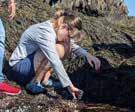
I learned so much about these delightful creatures just during the small amount of time I spent with them that day. Frankie was a little more friendly than Flower, but still not as friendly as the house pets I’m more accustomed to. He would sniff my arm a couple times when I stretched it out his way, but would then grunt crankily and move farther away, as if I had deliberately wasted his grazing time for such a piteous offering. I would try again and again, and the same thing would happen. I began to get frustrated; how was this supposed to be therapeutic?
The kiddy pool venture was a success, but only because an apple was involved. The belly scratch remained evasive. I vowed to attain this Highest of Honors next time I was at the farm.
Sure enough, next time I visited, Frankie ventured over my way of his own free will and, after gently butting up against my leg, rolled over for a scritch-scratch.
“That’s what pigs need,” Sanders said, laughing at the expression of sheer delight on my face. “They need you to be persistent. It might feel annoying to us to keep going after them, but to them, they need to feel special, like letting you rub their belly will be worth it.” And so, my first lesson (of many) at the farm was perseverance.
Though there are a variety of people incorporating horses into their therapeutic practice (Equine Assisted Therapy), and yet more therapists working with therapy dogs (Canine Assisted Therapy), there aren’t many others working with a variety of different farm animals, as Sanders does; eight different species, to be exact. Dogs, cats, goats, chickens, rabbits, pigs, horses and miniature horses, and donkeys are all integrated into the relational methods that Sanders utilizes in her practice.

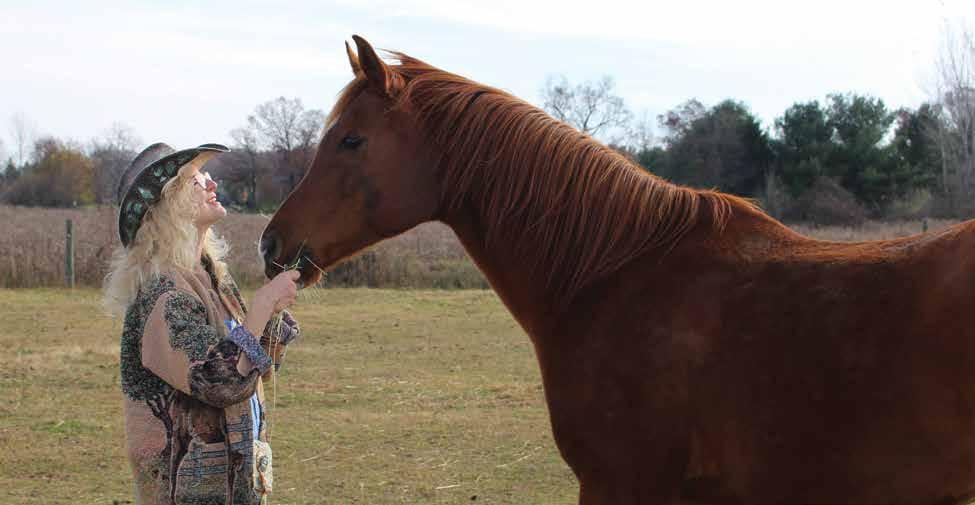
Just because Sanders doesn’t identify herself as a researcher doesn’t mean she won’t share her experiences with the rest of the world. “I would love to write. I’ve had so many experiences now that have helped me to recognize that working in animal partnerships for some people is just like pouring Miracle Grow on their therapeutic goals. I’d love to write up these therapeutic stories that reflect the power of relationships with animals in helping people to heal in an ethical way, where there’s something in it for the animals, as well.”
“So, at a fundamental level, you want to spread the magic?” I asked Sanders as we wrapped up our chat. Sanders smiled, her wide-brimmed and beautiful hat bobbed up and down in clear, unwavering consensus.


You can learn more about Sanders on her website laura-sanders.com.


Spreading the Magic
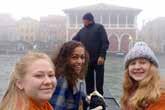
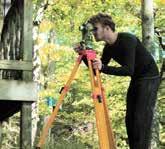

Sanders hopes to teach many more classes like this in the future, to introduce more young professionals to Animal Assisted Therapy. In fact, she has a lot of hopes for the future.
“I would really like to keep developing Animal Assisted Education through U of M. I’d also love to keep teaching my minicourse out here on the farm,” she told me excitedly. “An eventual goal is to help U of M’s School of Social Work develop a certificate program for Animal Assisted Therapy.” If such a program were to exist, it could pave the way for a more formal, evidence-based approach to AAT. Though there is much anecdotal evidence that AAT is helpful as an adjunct to mental health therapies, there isn’t yet much research in the field. Sanders hopes to change that. “Although I’m a practitioner and a teacher, I’m not a researcher,” Sanders said. “And I fully recognize how important evidencebased practices are, and how vital research is to the process of growing and developing any field of therapy, both physical and mental.” There is a growing body of research about AAT, and Sanders hopes and predicts that it will continue to grow.
The Crazy Wisdom Community Journal • May through August 2023 • Page 71
“The mark of a creative person is not that you draw well, or dance spectacularly, or write beautiful music, but that you can always think of more than one way to solve a problem.”
Laura Sanders
Offering a broad curriculum with each topic enriching the others, deepening students’ understanding of all subjects. Encouraging discovery, building resilience, and preparing students for countless opportunities. This is a Classroom! Taking Students Beyond the Textbook and Into the World SteinerSchool.org • 734-995-4141
In-Home Euthanasia and Hospice-Assisted Natural Death For Your Pets


 By Monica Turenne
By Monica Turenne
The bond we share with our pets is one the strongest bonds we will ever experience. Their devotion to us, as well as their non-judgmental, unconditional love, leaves an indelible mark on our hearts which is why saying goodbye is so hard. As a Certified Hospice and Palliative Care Veterinarian, the most common question I am asked is, “When will I know it is time to say goodbye?” What many families do not realize is that choosing where and how to say goodbye can be just as important.
Until a decade ago, pet parents seeking euthanasia only had the option of taking their pet to their local veterinary hospital. Options have expanded, and now include in-home euthanasia, and in some cases, hospice-assisted natural death.
The bond we share with our pets is one the strongest bonds we will ever experience. Their devotion to us, as well as their non-judgmental, unconditional love, leaves an indelible mark on our hearts which is why saying goodbye is so hard.
Death is incredibly intimate and more pet parents are looking for ways they can help their pets feel comfortable, relaxed, and safe in their final moments. Pet parents are also looking for ways they can feel safe and supported through this process.
In-home euthanasia provides many benefits, including giving pet parents the opportunity to say goodbye on their own terms. Pet parents may choose to incorporate spiritual or religious customs. Candles may be lit, songs sung, poems read, and photographs displayed—all setting a peaceful atmosphere while honoring the life the pet has shared with them.
It is important to note that every family and every pet have different needs. This is what makes in-home euthanasia so special. I am always so amazed by the thought and consideration pet parents give to how and where they want their pet’s last moments to be. Requests have included the pet being in a special chair, being under a picnic bench, being in a favorite spot in the backyard, or the most common, simply nestled in your lap.
Death is incredibly intimate and more pet parents are looking for ways they can help their pets feel comfortable, relaxed, and safe in their final moments.
Just like people, pets have extended family, too. This may include family members, special friends, or neighbors who may have cared for or bonded with your pet. With the euthanasia at home, families may choose to invite these special people to be present.

I am often asked if children should be present for a euthanasia. Ultimately, this decision is left to the children’s parents. My Certification in Thanatology (the study of death) has given me knowledge and insight into how best to include children of all ages in the process. If the family would like children to be present, I can suggest how this can be accomplished while still making the pet the central focus. With a euthanasia at home, there are many more options for how children can participate in a developmentally appropriate way. If the family would prefer the children not be present, I can provide meaningful and creative suggestions for how these children can still be in involved in the process even if they are not present for the euthanasia.
Another question I am often asked is, “What about my other pet?” In-home euthanasia benefits these pets as they do go through a grieving process just as we do. I have heard so many stories about pets who have lost a “sibling” and that that they look for that pet after they have died. Simply offering the space and time for these pets to be present with the deceased pet allows them to understand in their own way what has happened. I have had the privilege to see how pets react to death. Some pets curl up with the deceased and won’t leave their side. Others simply become very quiet and still. And yet others show their understanding by simply leaving the room. While pets may still grieve, it is clear that those who have been given the opportunity to witness the deceased pet seem to handle the subsequent absence of that pet a bit easier.
It is important to note that while euthanasia is the more common choice for families, hospice-assisted natural death may also be an option. If you are interested in this option for your pet, it is important to find a Certified Hospice and Palliative Care veterinarian (CHPV). A CHPV’s advanced training can help families determine if their situation is right for natural death as well as providing experienced guidance and support to be sure the pet parent understands the process and that the pet is always comfortable and pain-free.
At the beginning of this article, I referred to the “when is time to say goodbye to my pet” question. Some families already know the answer to this question and are ready to schedule an in-home euthanasia. Other pet parents are not sure how to begin to make this decision. Seeking a consultation with a CHPV can be instrumental in putting together a plan and providing expert counsel along the way. The more information and support pet parents are given, the more confident they are in making these very difficult decisions.


We are truly humbled to do this work and help families facing the end of their pet’s life. And while appointments are steeped in sadness, we always hope that we have made a very difficult situation perhaps just a bit easier.
Dr. Turenne has been a veterinarian for 24 years. She is the owner of Four Paws Veterinary Wellness, a mobile veterinary practice. She is a Certified Hospice and Palliative Care veterinarian, a Certified Veterinary Acupuncturist, and is also Certified in Thanatology. Dr. Turenne provides in-home euthanasia services, holistic, hospice and palliative care consultations, as well as assisting families with hospice-assisted natural death.For more information, please visit fourpawsvetwellness.com call (734) 385-7161.
The absolute worst part about having and loving a pet is when it is time to say goodbye. Our cat, Weezer, was with us for over 20 years. She was amazing. She was family. She was pure Love. She absolutely deserved to die in the most peaceful, loving way that we could possibly provide for her. We realized that In-home euthanasia was the way this was possible. Weezer was terrified of the car, so we refused to let that be the final moments of her life. She got to pass away at her own home, outside, relaxed, in the shade, on her lounge chair, being held by us as we soothed her and loved her right to the end. It was the death experience that I so badly wanted for her and for us, too. It meant so much. But it wasn't just the very end that was different and better. For several months, Dr. Turenne helped guide us through the whole death process. She provided treatment, medications, and supplements to help Weezer feel good until the end of her life. She and her team were always just a phone call away. There are so many reasons I recommend in-home euthanasia. It changed the entire experience for us. I am so thankful that it is available where we live. I would never do it any other way, ever again.
—Mike, Weezer’s Dad
The Crazy Wisdom Community Journal • May through August 2023 • Page 72

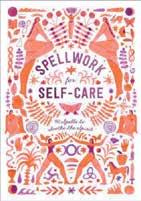


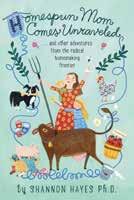

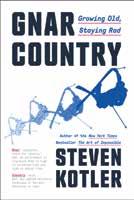
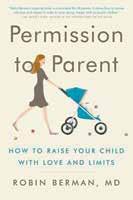




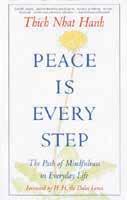







The Crazy Wisdom Community Journal • May through August 2023 • Page 73 ShopCrazyWisdom.com Browse the millions of book titles available and thousands of items from gift, game, and sidelines vendors Books, tarot, games, toys, blank journals, ebooks, audio books & more
When Food as Medicine Becomes Food as a Threat to Health
By Judy Stone
In the early 1990’s, when first beginning my foray into nutrition work, the cutting edge was the emergence of the low carb diet. The Atkins Diet was published in 1992 and faced off against the high carb, low fat heart disease reversal program of Dean Ornish. Ornish is a physician who led the public and the medical community toward a plant based, low fat lifestyle approach to preventing and reversing heart disease. Previously, author Adele Davis, (Let’s Cook It Right published in 1947 and Let’s Eat Right To Be Fit in 1957), was one of the early, well-known pioneers to put forth the idea that what we eat is directly related to health and that by “eating this and not that” we can exercise a measure of control. Three plus decades later in my career, we’ve wound our way into an increasingly more sophisticated, nuanced, complicated, and confusing world of knowing how to feed ourselves. Food, supplements, and nutrition advice (including apps) is an industry somewhere in the hundreds of billions of dollars annually. We are now squarely in the age of personalized nutrition, and yet, attaining and maintaining good health throughout our lifespan, has never been more challenging.
hundred other chemical mediators. MCAS manifests differently in different people, but one of its defining features (diagnostic criteria) is that it involves symptoms across at least two body systems and organs happening at the same time in response to stimuli, which could be food or non-food stimuli. MCAS is also less common than “garden variety” histamine intolerance.
Does any of this sound familiar?
Unfortunately, there is no one picture to point to, to say this is MCAS or this is HI. Of the two, HI is less complicated, and symptoms can be similar to those one might experience with allergies—congestion, headaches, hives, rashes, exaggerated responses to bug bites, poison ivy etc. But it can also manifest as fatigue, brain fog, vertigo, anxiety or difficulty concentrating. Symptoms theoretically are more pronounced in the hours or day after eating a meal with a significant histamine load but since most people are frequently eating a lot of histamines because it’s not something most people think about, symptoms may seem constant and just part of life until dietary histamines are reduced. Histamines can also be triggered to environmental exposures to dust, mold, etc.
Too many people are more ill, and many are fearful and/or traumatized around food and what and what not to eat. The truth is food can make us unwell as much as it can improve health. It’s become harder, more complex, and more expensive to nourish oneself, and those without the resources to access more and healthier food options, health care, and nutrition guidance likely suffer the most.
We face an increasingly complex array of health conditions and food intolerances (perhaps known but often not) resulting from genetics, underlying imbalances driven by environmental toxins, gut microbiome imbalances, epigenetic alterations (gene changes driven by interactions with environmental factors, both internal and external to our body), pharmaceuticals, and yes, even stress and trauma. Many people’s lives are affected, if not dominated by any combination of persistent or frequent pain, digestive disorders, skin conditions, chronic fatigue, chronic mental health struggles, diminished cognitive function, tinnitus, tachycardia, autoimmune disorders, body temperature dysregulation, sleep disturbances, anxiety attacks, and more, in addition to the standard array of chronic diseases. Many of these problems can be triggered or exacerbated from eating the “wrong” food. But it may not be apparent what the “wrong” food is, at least not without some detective work. Paradoxically, the idea that “food is medicine” can morph, much like our genes, into “food as toxin.” Whew.
One Example: Histamine Intolerance versus Mast Cell Activation Syndrome

Over the last decade one culprit for the complex and variable combinations of symptoms and illnesses, the mast cell, has received an increasing amount of attention. Mast cells are white blood cells that hang out in tissues throughout the body, especially in the gastrointestinal tract. Their function is to set off inflammatory responses to protect the body in the face of injury or infection by releasing pouches full of chemical mediators. The most well-known and understood of these is histamine. Most people are familiar with antihistamine drugs used by so many to control responses to outdoor allergies or asthma; these drugs are specifically mitigating the effects of massive histamine dumps by mast cells. There is growing recognition that many people either have mast cells that are over reactive and producing too much histamine or have an overabundance of mast cells also leading to too much histamine being released. In addition, the main enzyme the body uses to degrade histamine, called diamine oxidase or DAO may be in short supply, making it difficult for the body to break down histamine. Low levels of DAO can be due to a genetic variant, deficiencies of nutrients needed to make DAO or to help it work, or gut problems in the small intestine, where DAO is made, thus inhibiting production.
There are multiple types of mast cell disorders not covered here, but two prominent categories are Histamine Intolerance (HI) and Mast Cell Activation Syndrome (MCAS). HI is a problem of mast cells overreacting in response to higher histamine containing foods and insufficient DAO enzyme production or function to keep up with breaking it down, while MCAS is a problem of having too many mast cells, which also are overreacting with histamine and over two
For people who have been chronically ill long-term, with problems affecting multiple body systems as noted above (e.g. GI complaints, temperature dysregulation, insomnia, anxiety, etc.) and for which no other explanation has been found, consulting with a functional medicine trained physician with MCAS experience may be worthwhile. While definitive diagnosis thru testing is difficult, identifying the possibility of MCAS when no other diagnosis for chronic, multisystem symptoms have been found, could be useful in leading to treatment of all the underlying problems that are creating havoc.
In either suspected HI or MCAS, following a low histamine diet can often be helpful preliminary detective work because it will lighten the histamine load in your body and may reduce symptoms. However, it’s important to realize that many things can cause histamine to dump—anything that triggers the immune system. A good starting point for identifying histamine levels in food can be found in the free app called Food Intolerances. Usually sticking with low histamine foods for a week will provide noticeable results if HI is the primary problem. Histamines are especially high in fermented/pickled foods, alcohol, citrus, chocolate, tomatoes, eggplant, green beans, chili peppers, vinegar, aged cheeses, smoked and aged meat, or leftover animal protein (over 36 hours). This is not a definitive list; there are also foods that “liberate histamine” and foods that inhibit DAO enzyme production. But it’s a good starting place.
Although nutrition is core to health, we each have unique genes, biology, and biochemistry. Our history, including trauma, drug/chemical/ toxic exposures, and food history all play a role in shaping health and health needs.
New Tools for New Times
If this seems confusing, it’s because it is! Histamine intolerance or MCAS are but two examples of complex problems receiving more attention of late. It’s important to realize that food is not the origin of these problems, but dietary strategies can help alleviate symptoms and help address the underlying drivers of the problems. While nutrition is core to health, we each have unique genes, biology, and biochemistry and each person’s history, including trauma, drug/ chemical/toxic exposures, stress and food history all play a role in shaping health and health needs. All of these need to be considered as part of a healing strategy. As healthy eating means different things for different bodies and at different life stages, we fortunately have more research, tests, and tools than ever before to help personalize diets to fit the individual and their current health, food, and nutrient needs. The goal is not to live with limited diets, rather to fix underlying issues, increase the body’s tolerance for a wide range of healthy foods, and live with more health and vitality.
Judy Stone MS, MSW has worked in the community for over 30 years—first as a psychotherapist, then as a nutritionist. She has a master’s in human nutrition from a functional medicine/nutrition perspective from the University of Bridgeport. Stone has a limited private practice working with older adults, and volunteers doing nutrition education for underserved communities. Learn more at CenterforFunctionalNutrition.com.
The Crazy Wisdom Community Journal • May through August 2023 • Page 74
Sustainable Health
We are now squarely in the age of personalized nutrition, and yet, attaining and maintaining good health throughout our lifespan, has never been more challenging.
How Humor Helps Me Over a Hurdle
By Angela Verges
I’m working once again to lose my post-pregnancy weight…it’s been 25 years since the baby. There have been peaks and valleys, fitness regimens and meal plans. Just when I thought I had things under control, menopause slapped me in the face. I hit a plateau. A brick wall. A stand-off.
In school we learned the theory of man against man, man against nature, and man against himself. We can now include woman against her waistline. There are many days that I wish my superpower was appetite control, but since it isn’t, I go with Plan B–live joyously anyway.
I’m not going down without a good fight, and if you’re facing a challenge, you don’t have too either. How do you encourage yourself through a challenge?
Here are three fun ideas to survive a challenge:
1. Play the song I will Survive by Gloria Gaynor—sing along with the song (really loudly). Sing the words like you believe them.
2. Play the Rocky theme song—do this one at home. Put on a pair a loose-fitting jogging pants, leggings, or anything comfortable. Bounce around your room like you’re preparing for a boxing match. Let the song lead you. Here are some of the lyrics to put you in the moment— Trying hard now. It’s so hard now. Getting strong now. You can count this time as part of your fitness routine for the day.
3. Go easy on yourself. Allow yourself to relax, do something fun, then regroup later to refocus on your situation.




You can apply these ideas to a weight loss journey or any difficult situation you’re facing. I’ve found that it helps to sprinkle any situation with humor.


In school we learned the theory of man against man, man against nature, and man against himself. We can now include woman against her waistline.

My sons are encouraging when I complain about my weight struggles. They say things like, “Ma, you look fine, you’re probably gaining muscle.”
I started to buy into their theory—maybe I am gaining muscle. I looked at my right arm, then my left, and lifted each one into a bicep curl.
“I see your muscles, Ma.” My son gave my arm a firm squeeze.
A toothy grin erupted on my face. It was a proud moment for my arms, but then—


I looked down at my stomach, it looked back at me as if to say, I’m not with them, don’t set your expectations too high.
And that my friend, is how I use humor to make it through.
If you’re on a weight loss journey, or another challenge, silence your inner critic and keep pushing forward. Go through your day with laughter as your sidekick. There is hope and healing through humor. There was a study conducted at Texas A & M University that concluded that humor may be effective in increasing a person’s level of hope.
My grandmother used to say, “if you want to grow up big and strong, you have to exercise and eat right.” I apply this theory to humor. A laugh a day keeps stress at bay. If you want to build your mental health, exercise your humor muscles one laugh at a time. Discover your humor happy place and go there often. Perhaps you need a ten-minute break during your day to regroup, refresh, or recharge. Read something funny, reflect on a funny memory, or make someone else laugh.
One of my favorite children’s books is Alexander and the Horrible Terrible No Good, Very Bad Day, by Judith Viorst. Just as Alexander had a bad day, we have bad days as adults. There will be times when you have to uncover the humor, as it lurks in unlikely places. I have done that by poking fun at myself (not in a mean way). Here’s what I mean:
You know it’s going to be a rough day when…
Your portioned snack goes wild— maybe it’s just me, but there are some snacks that I can’t keep in the house because uncontrolled eating may occur. It happens often with peanuts. One time I decided not to eat the nuts from the can by the handfuls, but to shake a small portion into a bowl. The only thing is my hand didn’t cooperate.
Go through your day with laughter as your sidekick. There is hope and healing through humor.
As I shook the can it slipped from my hand and knocked the bowl over. Nuts scattered as the can hit the floor. There may have been ten peanuts that made their way into the bowl. That must have been the day that I said, “Lord, help me control my eating.” Who says God doesn’t have a sense of humor?
A laugh a day keeps stress at bay. If you want to build your mental health, exercise your humor muscles one laugh at a time. Discover your humor happy place and go there often.
Or maybe you’re looking through old photos and discover how you’ve grown… out. As I was cleaning and purging files, I came across old photos. I sat crossedlegged (well I sat with the one leg I could comfortably cross), on the floor, and reminisced. There was a picture of me and my sons at a family reunion about 15 years ago. We were all smiling for the camera. The first thing I thought was, aww, I remember that day. I weighed 150 pounds…the good old days.
I’ve learned that weight loss and establishing a health and wellness routine require a lifestyle change. It doesn’t happen overnight; it’s a journey that begins with a first step: consistency pays off. Humor helps when hurdles pop up.
It doesn’t happen overnight; it’s a journey that begins with a first step: consistency pays off. Humor helps when hurdles pop up.
E.E. Cummings wrote, “The most wasted day of all is one without laughter.” So, treat yourself to a scoop of humor every day!
Angela Verges is a native Detroiter who writes books for children and blogs about parenting experiences as she practices being a grown up. You can find her on stage bringing laughter to others. Follow her on Instagram at writermama223, on Facebook @angela.verges or visit her website angelaverges.net.
The Crazy Wisdom Community Journal • May through August 2023 • Page 75
Craig Stoller — Healing Through Chiropractic
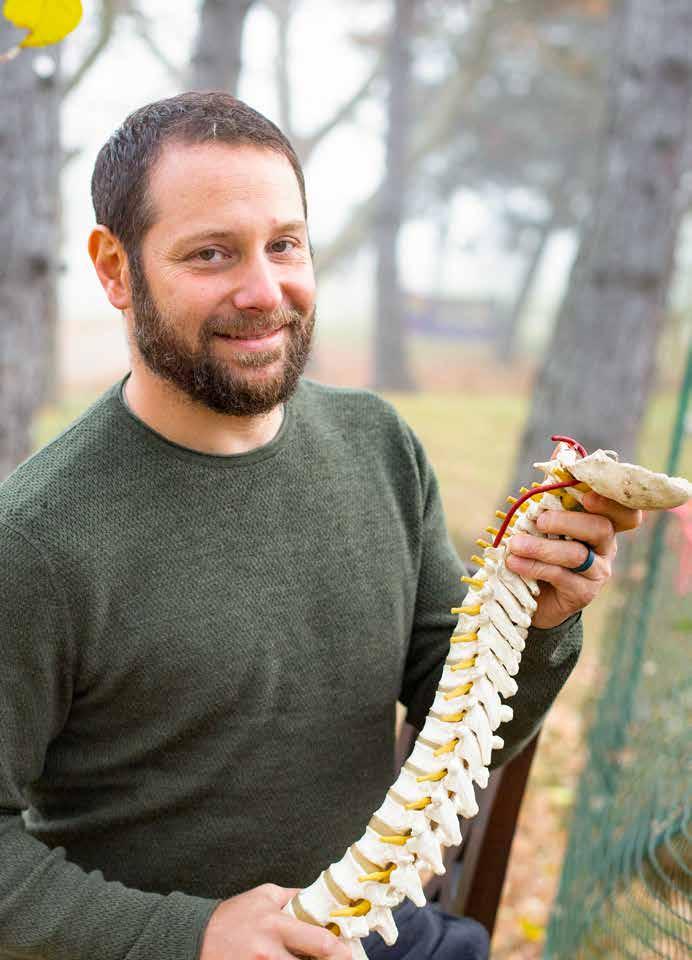
Interview by Madonna Gauding
Photos by Rachael Waring
Dr. Craig Stoller, D.C. has an unassuming office on Stadium, just east of Trader Joe’s. The sign on the door says, “Align Chiropractic.” His logo looks like a mandala. It represents the top vertebrae of the spine, otherwise known as the “atlas.” When you enter the waiting room, you are greeted with a large children’s play area, and above it a giant hand-painted mural. It depicts an idyllic scene of people of all ages and abilities actively enjoying the outdoors in a beautiful park like setting. It represents Stoller’s goal of having all of his patients, no matter what age or ability, enjoy an active, healthy lifestyle. Some chiropractors release a patient’s back pain or neck pain and send them on their way. Stoller’s aim is to maximize his patient’s health potential, whatever that might be. He is passionate about the inherent recuperative power of the body to heal itself without the use of drugs or surgery. He helps achieve this healing by focusing on the relationship between the structure of the body, the spine, and its function as coordinated by the nervous system.

Madonna Gauding: I’ve seen you on and off for care for some years starting with a serious car accident. I was reluctant to see you at first because I didn’t really know how a chiropractor could help, but a mutual friend strongly encouraged me to see you. You not only helped me recover from a strange, accident-induced brain fog, but I ended up feeling better than I had for a long time. I’ve been inspired by your holistic approach to health, your enthusiasm for how the body functions, and in particular, your laser focus on the benefits of a properly functioning nervous system. You introduced me to the depth and profound healing chiropractic has to offer. So, my first question is: What made you decide to become a chiropractor?
Craig Stoller: I was in college, I had already taken the MCAT exam and was getting ready to apply to medical school, when one of my fraternity brothers asked me why I wanted to become a doctor. I shared my thoughts about the field of medicine, and I mentioned how I didn’t believe medication was the answer for good health. I remember talking to him about physiology and my love for how the body works. He asked me if I had ever thought about going into chiropractic. My thinking was, “Well, that’s just for back pain.” I didn’t realize at that time how all-encompassing chiropractic can be. He said, “My dad and my grandfather are both chiropractors in Defiance, Ohio. You should talk to them and then see what you think. If you don’t believe pharmaceuticals are the ultimate answer to good health, you will be really interested in what they have to say.”
So, I took a little field trip to Defiance, Ohio, met Dr. Beane, and spent the day with him. It was such an eye-opening experience. People were coming into his office for all sorts of problems—headaches, poor digestion, balance issues, and of course knee and back pain—the whole gamut of health problems. He was utilizing chiropractic adjustments, nutritional counseling, and education to help his patients restore their bodies to proper functioning. What he was doing deeply resonated with me. I left Defiance knowing chiropractic is where I fit in the field of medicine. I went back to my college, got applications for chiropractic schools, and the rest is history.
Madonna Gauding: Well, I’m thinking of your parents, were they disappointed you didn’t become an MD? For some reason, the world doesn’t give chiropractors the same respect.
The Crazy Wisdom Community Journal • May through August 2023 • Page 76
Stoller’s aim is to maximize his patient’s health potential, whatever that might be. He is passionate about the inherent recuperative power of the body to heal itself without the use of drugs or surgery.
Craig Stoller: I have three siblings and my parents always wanted us to pursue what was best for us—what made us happy—so they had no problem with me becoming a chiropractor. Unfortunately, fifty years ago the AMA tried to destroy chiropractic. From the mid 1970s to the 90s, the AMA had a board called “the board on quackery” whose sole purpose was to contain and eliminate chiropractors as competition for medical doctors. The board spread misconceptions about chiropractic to discourage people from going to chiropractors or becoming chiropractors. They pressured high school counselors to advise students against pursuing a career in chiropractic. A group of chiropractors eventually filed a federal antitrust suit, and their case went all the way to the Supreme Court. After several appeals, the chiropractors won, and there was a significant financial settlement, but by then the AMA had done its damage. To this day, misconceptions and negative views about chiropractic continue.
Unfortunately, fifty years ago the AMA tried to destroy chiropractic. From the mid 1970s to the 90s, the AMA had a board called “the board on quackery” whose sole purpose was to contain and eliminate chiropractors as competition for medical doctors.

Madonna Gauding: I remember chiropractic being trashed during those years. People would call chiropractors “quacks” without actually knowing what they did.
Craig Stoller: One thing I find fascinating about chiropractic, and what helped me make the decision to enter the field, is that as complex as the body is, there are certain universal, innate principles regarding health that are always going to be true. Ultimately, our health depends on whether we listen to our body and understand how it works. There are so many ways chiropractors can educate patients and help them be active participants in maintaining their health. My job is to facilitate my patients having optimum health and to remove any roadblocks that may be preventing it. This has been my passion. It has motivated and resonated with me all these years.
MG: When I go to a regular doctor, I don’t feel he or she is that interested in how well my body functions as a whole. They tend to look for signs of illness or pathology. They focus on symptoms, tests, and prescriptions, all useful to some degree but not helpful in terms of my preventing disease or helping me have a better quality of life. The traditional doctors I see are sincere and well-meaning, and certainly helpful at times, but they operate under a different paradigm.
CS: There is definitely a time and place for traditional medicine. It is designed to put out a five-alarm fire, and diagnostic tests and pharmaceuticals can be helpful when you have serious symptoms. In my practice I have a different approach. I focus on dysfunction rather than symptoms. Dysfunction, if it were on a continuum, would be on the opposite end from symptoms because symptoms are always the last to occur. If we just address the symptom alone, we may be missing the deeper cause. For example, someone may come in with shoulder pain on their right side, but they may not realize it originated in their left ankle. To treat shoulder pain with muscle relaxants or pain killers will not get to the dysfunction underlying it. Unfortunately, traditional medicine is so focused on symptom patterning they don’t look at the body as whole. In standard medicine, everything is compartmentalized. If you have a heart condition, obviously the organ is sick, and it needs treatment. But your diseased heart will have ramifications throughout your entire body. Oxygenation is important, and if your heart is not working properly, you will not be getting oxygen to all your cells in the capacity they need. This could cause a cascade of problems affecting your lungs, your digestion, your kidneys, and so on. You have to get to where the dysfunction started, and when you address where that dysfunction began, so many other symptoms start to heal. A lot of people complain that chiropractors say they can fix everything. But, actually, we don’t “fix” anything. What we do is restore function to the body which triggers your body’s innate ability to heal. My goal is to get your body to heal and function at the highest level possible.
MG: This may sound like an aside, but I think it’s relevant as an example of the state of standard medicine. A few months ago, I went to the ER with extreme vertigo and other symptoms that made me think I was having a heart attack. I was there for 12 hours and given every possible test imaginable. The bill was over $12,000 mostly paid by my insurance. I was relieved to learn I had not had a heart attack or a stroke, however, they suggested I make an appointment with a cardiologist because of a slight anomaly on one of the blood tests. When I saw the cardiologist, he said I should not have been referred to him, that the ER doctors overreacted. Turns out I did not have heart disease. What showed up on that blood test was simply a result of my age.
CS: Well, the problem with standard health care is that it has become so regimented. A lot of people who go into medicine are very smart and are really good students. They can study, memorize, and regurgitate. That is one reason why standard medicine has become so formulaic. So, in your situation they ordered a predetermined battery of tests, but they didn’t find any answers to your vertigo. Diagnostics are good because you want to make sure to uncover something if it is there, but your ER testing and treatment cost over $12,000, which is why insurance costs are so high. Also, because medical malpractice insurance is so expensive, doctors and hospitals will over test out of fear of
Spruce up for Spring!!

* Off the body energy work
* On the body diagnostic Palpation on abdomen
* The main event! Expert gentle insertion style Acupuncture

See
missing something. Obviously, our healthcare system needs revamping so that physicians make clinical decisions based on the needs of their patient rather than the requirements of insurance companies.
There are “outside the box” doctors in the Ann Arbor area, like Jay Sandweiss and Sue McCreadie. They don’t fit in the “box” of medicine because they think about physiology and the body as a whole. And they don’t fit into large medical groups because they are thinkers. Rather than just treating symptoms, they will look for the underlying causes of symptoms.
MG: When doctors go to medical school, they learn about the physiology of the entire body and how it functions, but it seems when they begin practicing, they abandon that holistic view.
CS: In the U.S. there are five recognized primary care physicians. There are chiropractors (DC), medical doctors (MD), osteopaths (DO), dentists (DDS), and podiatrists (DPM). For chiropractors, osteopaths, and medical doctors, 95% of our curriculum is identical. We all learn the same physiology, whether it is gastroenterology, endocrinology, or embryology, we all go through the same training. You are right about doctors abandoning a holistic view of the body. If they asked “how is this body working as a whole” instead of compartmentalizing it into medical specialties, we would have dramatically better health care.
The chiropractic field originally promoted the idea of “wellness care” which in standard medicine became the “wellness check.” But a wellness check shouldn’t be, “Okay, we did a wellness check on you, and we found this problem we need to treat.” A wellness model should ask the question: How can we keep your entire body and mind working properly?
We live in such a fast-paced, stressful world, we need to counteract that by cultivating a positive and relaxed mind. This is something standard medicine completely overlooks. I suggest meditation to my patients to help with relaxation. Meditating just five minutes a day can help you achieve calm and peace. That five minutes will give you time to just slow down, breathe, and clear your mind. That small step can help undo the ravages of stress. I have a very busy life, but I make sure I take time every day to meditate. Some days it may be 15 minutes, others it may be an hour. There are many aspects to health and well-being. I always talk about these five pillars of health we just talked about to my patients.
The Crazy Wisdom Community Journal • May through August 2023 Page 77
JapaneseAcupu n cture inAnn A r b o r
off your first appointment • May 2023
10%*
her beautiful
emanueleacupuncture.com (734) 302-7300 • acurose@gmail.com 25 years experience
website...
Craig Stoller — Healing Through Chiropractic
MG: Can you go over them again?
CS: I start with a properly functioning nervous system. This is achieved through chiropractic diagnosis and adjustments. Consider that the tabletop. Then the four supporting legs are healthy nutrition, a consistent exercise plan, a positive mental attitude, and daily rest and relaxation. Those are the raw materials our body needs to be able to function at a high level. Let’s say someone comes to me to get adjusted. Yet, when they leave here, they eat poorly, and are not proactive with their health. A body that is aligned, with a properly functioning nervous system will definitely be of benefit, but they are not going to reach their maximum health potential if their lifestyle is undermining them. And if someone is already doing all the right things—exercising, eating well—and yet they don’t feel that great, well, the missing component in that case is their nervous system. A fully functioning nervous system is what allows their body to communicate and integrate all these great things they are doing for themselves. If there are blockages in the way their brain and body are communicating, if there are circuits turned off, then ultimately, no matter what they do, they are not going to feel their best, and their body is not going to reach their maximum potential. Even though they have good nutrition, exercise, rest and relaxation, and meditation—these great raw materials of good health—the body will not be able to integrate or assimilate them fully.
MG: Do most chiropractors think about the nervous system in the way you are talking about it or are they focused more on muscles, bones, and the skeletal system?
CS: Chiropractic is described as a philosophy, an art, and a science. The philosophy of chiropractic is that the nerve system controls and directs the proper function of the body. Daniel David Palmer, who founded chiropractic in the late 19th century, was practicing magnetic healing at the time. He started noticing electric currents in the body, which led him to the spine and the functioning of the nervous system. He, and A. T. Stills, the founder of osteopathy, were friends. Osteopaths focus on the oxygenation of the body, and osteopathic manipulation is geared toward increasing circulation. And really, they both are right. Everywhere a nerve goes so does a vein, so if you are affecting the nervous system, you are also affecting the oxygenation of the body. Back to your question, no matter what their technique, all chiropractors focus on the nervous system. Some may not necessarily talk about it in the way that I do, and their technique and approach may differ. Then there is the art of the practice. The art of chiropractic is being able to diagnose what needs to be adjusted on that day, and determine how to go about adjusting it, there are lots of different things to consider. Different chiropractors will come to different conclusions. But all approaches should be rooted in the concept that the nerve system has to be free of interference for the body to function correctly.
MG: You practice a type of chiropractic called “upper cervical.” How did you decide to use that method?
I would say about 30% of my patients are children. I often get the question, “Why chiropractic for kids when they don’t have back pain?” Of course, chiropractic isn’t only about back pain, it’s about optimizing the function of the entire body.

MG: Can you explain more about how the nervous system works?
— Craig Stoller
CS: Think of the nerves as the electrical wires, and the brain as the main computer. The “wires” allow the brain to communicate with every cell, every tissue, and every organ in your body. I work with the spine, primarily, because that is the electrical circuit breaker of the nervous system. If you were to look at the spine, it would look like a circuit breaker with wires coming out at different levels that go to different parts of the body. It’s kind of like your house. You have this big wire that comes into your house from the electric company, and the breaker box separates the electricity and routes it to the bathroom, bedroom, kitchen, wherever it needs to go. Same with our body, whether it’s a nerve going to your foot, your stomach, your heart, your lungs, or your hands. If there is any static on the line, if there is interference in the flow of the nerve signals, those parts of your body are not going to work properly.
I tell all of my patients that everyone is an athlete. One patient’s goal may be to be able to walk with a walker to the mailbox and back, and another may have the goal of running a marathon. These are both athletic activities. Any movement involves your brain telling your body to function well. At the same time, that brain has to be able to receive information. We basically live our life through our nerve system. Any break in that communication, any constriction, is going to end up as a point of dysfunction that we were talking about earlier.
CS: I went to a chiropractic school that taught both regular chiropractic and upper cervical chiropractic. There are hundreds of chiropractic techniques, but they all fall under two categories: full spine chiropractic and upper cervically based chiropractic. They both effect the whole spine. The difference is in technique. After I graduated, I started practicing traditional full spine chiropractic using what is called a high velocity adjusting technique, what people jokingly call “bone crunching.” Eventually, I realized this was not the practice of my dreams. I couldn’t see myself doing this for 30 years. So, I decided to move my family to Vermont for a year where I worked with another doctor to get advanced training in chiropractic neurology. I started looking into neurological tests—balance testing and testing cranial nerves—really looking at how the brain and body are communicating. A lot of people may not feel dysfunction and won’t know they have a problem until they feel symptoms. The testing helps identify nerve interference and dysfunction before they manifest as symptoms. One of my frustrations in my earlier practice with traditional full spine chiropractic was I didn’t want patients coming to me every six weeks saying, “Hey doc, I threw out my back.” I felt there is much more to chiropractic than back pain, and was I really making a change if they were constantly throwing out their back?
MG: I want to talk more about upper cervical chiropractic. In that system, does the health of the body depend on the position of the top vertebrae, the atlas? Is that where the main blockage occurs in the nervous system?
CS: The atlas holds a unique place in upper cervical chiropractic. Envision your head as a bowling ball, your atlas as a saucer it rests on, and the rest of your body as a rod that keeps you upright and balanced. If the saucer is tipped and rotated, there is going to be some kind of postural distortion introduced to keep your body upright against gravity. The brain stem and the spinal cord meet there at the atlas. Every single nerve has to go from your brain through that juncture, so the atlas can have a far-reaching neurological effect. I focus on that bone to get every vertebra below it to stack up like blocks which allows other things to correct.
MG: Does it ever happen that you adjust the atlas, and the rest of the spine does not fall into place?
CS: Yes. Sometimes there are areas that don’t respond. That’s why I use multiple ways to analyze and treat the body. Think of your body as a closed kinetic chain. Any time I project force into your body there is going to be a ripple effect. For example, when I move my shoulder, it’s not just my shoulder that moves but there is movement all the way through my body. Let’s say the atlas is in the correct place, but there are blockages elsewhere, maybe at the ankle, or the knee or another vertebra. Maybe a vertebra is “stuck.” My job is to find where those blockages are. At times I will use alternate techniques to address those areas, all with the goal of keeping the nerve system functioning optimally. That is why open communication between patient and doctor is so important. I really

The Crazy Wisdom Community Journal • January through April 2023 • Page 78
value having conversations with my patients. I encourage them to ask questions and to share whatever they want with me, even information they found online and want to know if it applies to them. There are no bad questions. It’s amazing how we chiropractors can read the body, but sometimes when we start talking, and my patients tell me what they are experiencing, the wheels start spinning in my head, and I realize there is a blockage somewhere I didn’t expect. Or they tell me they are doing great except in this one area. There is something called “point of subluxation,” the subluxation being a slight misalignment of a vertebra. You might be balanced when you are standing, but say you are a violinist and when you begin to play, that position triggers your subluxation. I actually have to adjust you in that position because that blockage, or that misalignment, will only show up when you are performing. I have to dig into that and do my detective work. Then, I can get the body to work the way it is supposed to.
MG: Do you use other techniques than upper cervical?
CS: Besides upper cervical adjustments, I use another technique called the “Zone School of Healing.” It works on the premise that we have six, principal systems in our body—glandular, elimination, neurological, muscular, circulatory, and digestive. Each has different control centers or zones in the brain, and those control areas are governed by certain areas along the spinal cord. I can assess if those systems are communicating by doing some palpation along the base of the skull. This technique differs from upper cervical structural adjustments, in that it is governed by spinal cord stimulation.
MG: In general, what gets people to your practice?
CS: I am very fortunate in that my practice is primarily referral-based by patients who are already educated about what I do. Certainly, I will get new people who come in with aches and pains. In most chiropractic settings that is why people seek chiropractic care. When someone does come in for back pain, we go through their history, and all of a sudden, they are talking about digestive problems. I get people who come to me for headaches or fatigue. I get a whole range of health issues besides pain.
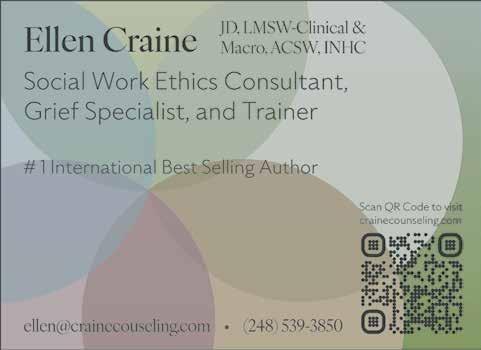
Can I turn an 83-year-old into a 25-year-old? Probably not. But with their participation, I can help maximize their body’s potential.
— Craig Stoller
MG: And because you have educated your patients about the nervous system and optimizing its functioning, you get new patients who are not necessarily having symptoms but want their bodies to function at a higher level?
CS: Yes. Think of it as a model of going to a doctor when you are not sick. This goes back to what we were talking about with wellness. My patients are generally people who want to own their own health. And to do that they are willing to take proactive steps. I also get people on the other end of the spectrum, who have tried everything in traditional medicine, have failed to get relief, and are at a loss for what to do next. I am sometimes their last resort. When I educate patients about physiology and how the body works, a lightbulb goes off. When I sit down with them and explain what is working and what is not working in their body, it typically makes sense to them. There is nothing about the body that is so complex that the average lay person cannot understand. I want patients to be an active participant in their health, whether it’s changing diet, adding simple exercises or changing their movement patterns. Exercise doesn’t have to be “I’m going to go to the gym and workout at this extreme pace for an hour and a half.” For some patients, exercise can simply be taking a walk outside for twenty minutes a day. That achieves a lot. And, in that twenty minutes, they can be in a meditative mind space which also contributes to the “pillar” of having a positive mental attitude.
After patients see me for a while, they begin to differentiate between feeling good and feeling bad. And they begin to understand what feeling good is. They begin to tune into their barometer, and they become more sensitive to changes in their body. They will tell me I’m feeling pretty good, but I’ve noticed this certain thing happening when I run. So many people chalk things up to getting older or they are so used to not feeling good, they think that’s normal. You know, “I wake up in the morning, I take my Aleve, and I’m good to go.” When my patients begin to be proactive about their health, which I encourage them to do, they begin to make positive changes in their daily life.
MG: What about cancer or heart disease? Can chiropractic help with serious illness?
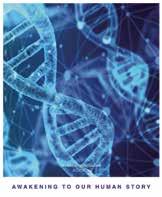
CS: Those are examples of the “five alarm fire” we talked about. There are a lot of treatment options in those cases, but they all involve critical care, whether someone chooses the traditional path for cancer or heart disease or not. If I were to take two patients who had cancer, who were both going through traditional chemo and radiation, and one was getting chiropractic care and one was not, in all likelihood, the one who is getting chiropractic care will respond better to their traditional treatment, because their body will be better equipped to handle the chemical onslaught of chemotherapy. Basically, chemotherapy chemically attacks and hopefully kills the cancer. And then after, we worry about restoring the health of the body. If I can keep the body functioning most optimally while going through a challenging cancer treatment, it is only going to give the person a chance to have a better outcome.
Life Force Intensive Session


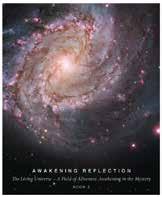
Next Sessions: 5/8, 7/24, & 10/23



Who are We?

The Crazy Wisdom Community Journal • May through August 2023 Page 79
Deepening our understanding of life. Intrigued? Learn more: webercenter.org/awakening-series AWAKENING TO THE GREAT SHIFT Awakening Reflection BOOK 6 The Awakening Reflection Booklet Series speaks to the personal, communal awakening that life, for 13.8 billion years, has been calling us to embrace. S t a r t y o u r r e g i s t r a t i o n a t s t e i n e r h e a l t h . o r g
Regain your health with two weeks of anthroposophic medical care, therapies, and nutrition in Ann Arbor Mistletoe treatment available. F o r q u e s t i o n s c a l l : 7 3 4 - 2 2 2 - 1 4 9 1 FOR CHRONIC ILLNESS, CANCER, OR WELLNESS
Craig Stoller — Healing Through Chiropractic
MG: What about breathing issues such as asthma?
CS: A lot of chiropractors are drawn to the field because they had childhood asthma and it was the only thing that helped them. Whatever the breathing issue, if there is some blockage in a functional path related to breathing, chiropractic can help to open it up. Sometimes it’s as simple as the diaphragm is not working exactly as it should because there is some kind of misalignment in the nerves that are feeding it. Or sometimes patients have a hiatal hernia they need to address, or their body is too acidic. There are so many things that can cause breathing problems. With sleep apnea, because our respiratory centers are in the brain stem, some people respond extremely well to upper cervical adjustment. And even though they may still have to use a c-pap device, they may achieve better respiratory function overall. There is no one health treatment that is the end all answer to everything. That’s why we often need multiple forms of healthcare.
issues that are genetic, that you inherited from your parents, but there has to be something that turns those tendencies on. We all have the ability to express health and I have to find out what is blocking that ability for each patient. Each individual will have a different “100% of health” they can express, so what is keeping that person from expressing that 100%? We need to free up that expression so the body can heal.
MG: What about chiropractic for children?
CS: I would say about 30% of my patients are children. I often get the question, “Why chiropractic for kids when they don’t have back pain?” Of course, chiropractic isn’t only about back pain, it’s about optimizing the function of the entire body. Patients bring their kids in for that reason, or they may be having some kind of health issue that hasn’t resolved, or their kid is always sick and missing school. Then some kids may be on a sports team, and I see them to help them improve athletic performance. Children respond pretty quickly to treatment. They don’t have the muscle memory we do and typically they don’t require the same treatment frequency. I test them neurologically, I check their postural balance, their muscle strength, their eye movements. What I’m looking for is how their brain and body are communicating. If there is a break in that communication, I address that. I typically don’t x-ray young children unless there is a need to. When they reach adolescence, I sometimes take an x-ray to see how their spine is developing.
MG: What about chiropractic for the elderly?

MG: I know you adjust newborn babies. Can you talk about that?
CS: I sometimes go to the hospital to adjust babies before they come home. Since Covid restrictions have been lifted, just a couple of weeks ago, I was able to get back in the hospital and adjust a patient of mine’s newborn. I’ve had patients who, before they drove the baby home from the hospital, came by the office to have them adjusted. Later in life, when patients come to me with problems, they ask, “how did I get here?” I tell them how you arrived at this point is the story of your life and everything that has happened to you since you were born. The birthing process is one of the most traumatic experiences a person will go through. Because of that, my kids have been adjusted since they were five minutes old and would have been adjusted quicker if I hadn’t been helping with the birth. I have adjusted them at minimum once a week since they were born. They have never taken any prescriptions and they have never missed school because they were sick. My fifteen-year-old has probably had five colds in his life, and they lasted only one or two days. My twelve-year-old daughter has probably only had two or three. Our goal with them is to always maximize their health. Everything we do, and the lifestyle we live, promotes that.
Some kids have their first misalignment at birth. And if it is not corrected, it just compounds. And, again, that’s were my detective skills come in. Things happen in your life, there are traumas. You have an auto accident, you step off a curb wrong, you are a programmer hunched over your keyboard, you play hockey or football, and you get injured, you are a cyclist, and you have a bad fall, or you are a desk jockey who just sits all day—all these lifestyle things add to your story. So, the detective work is asking, “How did those past experiences imprint onto your body?” There are certain patterns and certain structures that have shifted in your body over time. Every nerve goes to different muscle groups, different organs, cells, tissues, and my job is to sort out where you need correction. If someone comes in saying they have migraines and digestive issues, and they also complain of midback pain, the back may be the source of their problems. After a series of adjustments, they tell me their headaches and digestive issues are better than they have been in years. It’s not by coincidence. All these nerves feed muscles and organs.
MG: So, when you do these adjustments, you don’t actually “cure” anything. What happens is the body heals, and symptoms resolve when the body comes into alignment and the nervous system is flowing freely. This process, I assume, is very unique to each individual.

CS: The body is a self-healing organism. So, if you are having chronic, ongoing symptoms, you have to ask yourself, “Why is my body not healing itself?” Everybody has cut their finger at one time, and it healed. Or you have had some kind of ailment like a cold where you didn’t have to tell your body to heal, it just did it on its own. If we have a wound, yes, we have to intervene, we have to clean it, if not infection will set in. We have systems in our body that fight against infection. On the functional side, all I do is introduce proper alignment and proper function of the body which turns on the body’s ability to heal. Someone may come to me saying, “I have this symptom, and nobody has been able to figure out what’s causing it.” What I love about physiology is there is always a reason why something is occurring in your body. You may have health
CS: I see whole families, so I end up seeing patients of all ages. A patient may say I’d like to bring my mom in, she’s 83, can this help her? No matter what age, there is a maximum measure of health unique for that individual. Can I turn an 83-year-old into a 25-year-old? Probably not. But with their participation, I can help maximize their body’s potential. One of the biggest concerns of the elderly is falling. One of the tests I do is a cerebellum balance test. By testing how the body and cerebellum work together in understanding where the body is in space and time, I can help improve their balance. I will do a simple finger to nose test, which is a cerebellum test. And I will have them march in place
The Crazy Wisdom Community Journal • January through April 2023 • Page 80
Anything I can do to help people get through their roadblocks to optimal health—this is my passion. I hope when I am 90, I am still adjusting patients. I may not be doing it at the pace I am doing it now, but I have such a passion for the human experience, I want to be able to share that with everybody.
— Craig Stoller
and see what their patterns are so I can read what their cerebellum is doing. I will have them stand on one leg and observe how they stand and if they sway a certain way. If their eyes are closed and they sway to the right, that lets me know how the cerebellum is working. Sometimes I have to look at gait, how are they walking. For example, they may not be picking up their right foot, which may cause them to trip on a curb. Sometimes it is just what their brain is perceiving, or maybe their glute muscles are not firing on the right side, and they have trouble picking up that leg. These are all things that can be addressed and corrected to create the most optimal balance for the elderly person. We can open up those messages from the cerebellum so their body can understand better where it is in space and time. One of the things that is very problematic in the elderly community is they are not moving. Being stuck sitting in a chair all day is very detrimental to the body. So, I encourage consistent, daily movement for older people. There are ways to adapt to make movement possible for most everyone.
MG: Can you go over what happens when someone first comes to see you. What can they expect? What is the process for becoming your patient?
CS: I start with the consultation. I have to understand why they are seeking care, what their history is, and what’s going on in their body. Wheels start spinning for me the minute we have that conversation. Then I do an assessment, I look at the structure of the body; I do a postural assessment, how they distribute force through weight balance, postural changes. Then I do a series of x-rays where I look at the blueprint of the body. I look to see if the posture and the blueprint match. Then I do a series of neurological testing—looking at how the neurological system is functioning. After all of that, I go back and analyze whether what we talked about in our initial conversation matches what is going on physiologically in the body. It if does match, then I develop a plan for correcting what is functionally wrong so that their body can heal.
MG: Your x-rays are unique and have lot of lines and markings superimposed on them.
CS: Chiropractors look at x-rays differently. A patient may come in and tell me their MD took an x-ray and told them everything looks fine. But MDs are looking for fractures or pathologies, they are not looking for structural alignments. The lines you are referring to help me to check for structural alignment. That said, I also look for pathologies when I do an x-ray to rule out any reason why I should not treat a patient. For example, they may have a tumor on their spine that needs to be addressed with traditional medicine. In that case I would suggest I do not treat them at this time. The whole process allows me to decide if it makes sense to treat this person and if they are the right person for my practice. If they are not, or if they are not comfortable, I want to make sure they get to the right practitioner for them and they reach their goals in life when it comes to their health.
MG: Where do you see yourself going with your practice? What’s in your future?
CS: Well, I recently brought another chiropractor into my practice. Dr. Samantha Garlick went to the same school I did so we come from the same philosophy. It was important to bring somebody in who was congruent and compatible because it allows us to grow. As far as my plans for the future, I want to continue with my practice. I love physiology. I love to see people maximize their life potential and be able to do the things they want to do. I want that 90-year-old who has never traveled to Europe, and always wanted to, to not be concerned about doing that. Whatever the experience my patients desire, I want them to be able to pursue it and live their life to the fullest. Anything I can do to help people get through their roadblocks to optimal health—this is my passion. I hope when I am 90, I am still adjusting patients. I may not be doing it at the pace I am doing it now, but I have such a passion for the human experience, I want to be able to share that with everybody.
To learn more about Dr. Craig Stoller, D.C. visit him online at alignchiropracticannarbor.com. His office is located at 1955 Pauline Boulevard, Suite 80 Ann Arbor, MI 48103. To make an appointment call (734) 418-7515.

Crazy Wisdom Poetry Series
Hosted by Edward Morin, David Jibson, and Lissa Perrin
Second Wednesdays, 7-9 p.m.: Poetry Workshop. All writers welcome to share and discuss their poetry and short fiction. Sign-up for new participants begins 6:45 p.m.
Fourth Wednesdays, 7-9 p.m.: Featured Reader(s) for 50 minutes. Open Mic reading for 1 hour. All writers welcome to share their own or other favorite poetry. Sign-up begins at 6:45 p.m.
All sessions are virtual and accessible through Zoom. Email cwpoetrycircle@gmail.com for Zoom link.
Featured readers
May 24 – Bill Harris, Emeritus professor of English at Wayne State University, is a poet, playwright, prose writer and arts critic. I Got to Keep Moving, a book of related short stories is his latest publication. He was named the 2011 Kresge Eminent Artist for his contributions to the Detroit Literary scene.

May 24 – David James was born and raised on the third coast, Michigan. His most recent of seven published books is Alive in Your Skin While You Still Own It, and another—She Dances Like Mussolini—won the Next Generation Indie Book Award. He’s had over thirty oneact plays produced in the U.S. and Ireland.


June 28 – Terry Bohnhorst Blackhawk founded and for twenty years directed the InsideOut Literary Arts Project for Detroit students. Her poetry has won the John Ciardi Prize (for Escape Artist), the 2010 Pablo Neruda Prize, and a Kresge fellowship. Her fifth book, One Less River, was a Top 2019 Indie Poetry title. Her latest chapbook is Maumee, Maumee
June 28 – Derek Pollard is Editor of the Poets on Poetry Series at University of Michigan Press. A widely published poet, book critic, longtime educator, and workshop leader, he founded Constellar Creative, a creative agency that specializes in content marketing and copywriting. His most recent poetry collection is On the Verge of Something Bright and Good
Dr Susannah Parke, DO Integrative Musculoskeletal Medicine
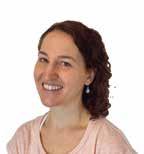
Dr Parke is an osteopathic physician offering integrative pain consults and osteopathic manipulation to ease pain and guide patients toward musculoskeletal well-being. Her holistic approach will help you rediscover the Health within.
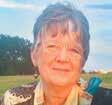
Board certified in Osteopathic Manipulative Medicine & Physical Medicine and Rehabilitation. RYT2oo.
Phone (734) 984-3612
Office - 231 Little Lake Dr, Suite E, Ann Arbor, MI 48103
Email: susannahparkedo@gmail.com Visit the website for more information, www.susannahparkedo.com
July 26 – Jack Driscoll’s Twenty Stories: New and Selected, won the 2022 Pushcart Editors Prize. His novels or story collections received the PEN/Nelson Algren Award, AWP Grace Paley Short Fiction Prize, Society of Midland Authors Award, and Michigan Notable Book Awards. He founded the creative writing department at Interlochen Center for the Arts.
Crazy Wisdom Poetry Circle
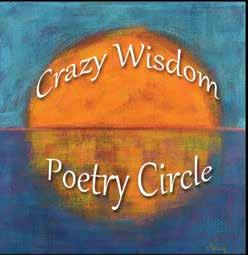
The Poetry Series is open to all. There is never a charge. https://cwcircle.poetry.blog/

The Crazy Wisdom Community Journal • May through August 2023 Page 81
Psychedelic Medicines in Trauma Recovery
 By Ashton D. Justice • Photos by Mary Bortmas
By Ashton D. Justice • Photos by Mary Bortmas
“We can’t solve problems by using the same kind of thinking we used when we created them.”
–Albert Einstein
Life is hard and yes, terrible things can and do happen, oftentimes to people who do not deserve it. Denying trauma and trying to inspire people out of its impact, both individually and collectively, has been the go-to method of dealing with trauma for generations.
We live in a world where trauma is commonplace and oftentimes inevitable. And, of course, history is repeated when members of society at large follow suit in paying a bit of lip service to the issue but not really talking about it. We judge those affected by trauma and avoid facing trauma and those impacted by it at a great cost to ourselves and to others. The most significant cost being the lives and well-being of those affected. Could there be another way to help people?
PTSD (Post Traumatic Stress Disorder), which results from acute trauma, and C-PTSD (Complex Post Traumatic Stress Disorder), which results from the presence of chronic, unrelenting traumas like child abuse or neglect, domestic violence, systemic racism, sexism, and homophobia are increasing in prevalence
and severity. Trauma is all around us, showing up in “typical” families, and in more obviously scarred families. There is trauma in divorce, illness, dislocation, injuries, childhood cruelties, middle school tribalism, work-related failures, unemployment, the loss of a loved one. The disorders associated with trauma affect all of us, in so many ways.
Enter, or rather re-enter, psychedelics. A non-exhaustive list of commonly known psychedelics include: MDMA, Ketamine, Psilocybin (more commonly known as Magic Mushrooms), Mescaline, LSD, Peyote, DMT, Ayahausca, and even Cannabis. Until 1970, when all psychedelics were classified as Schedule 1 drugs in the Controlled Substances Act, psychedelics had been used, with some success, in treating a myriad of conditions, including PTSD and other trauma-induced disorders. In recent years, there has been a robust resurgence of interest and experimentation surrounding medicinal psychedelic usage, also known by other terms including, but not limited to, plant medicines, transformative medicines, and entheogens. Cutting edge thinkers within the medical and psychiatric communities are leaving the traditional “cures” of pharmaceutical drugs and talk therapy behind in search of safe and effective solutions. In recent years, it appears many researchers and practitioners alike are independently arriving at the same conclusion, that psychedelics and the altered states of consciousness achieved by them, could be a significant and meaningful part of the answer.



While having an appropriate mindset about personal problems is a concept people understand, achieving it when plagued by the impact of trauma on the human brain can be an insurmountable task for many with (C)PTSD. Fortunately, the off-label use of ketamine injections has proven to help many MPH patients achieve this.
Southeast Michigan is a hotspot for these alternative trauma treatments and there Is a small trove of qualified doctors and licensed practitioners pioneering varied means of treatment through the use of psychedelics. These treatments are available in an array of settings including fully supervised inclinic treatments, multi-day retreat-based treatments, and practitioner-guided outpatient treatments self-administered by patients in their own homes. Practitioners and patients alike are seeing success, and many traditionally trained psychologists and psychiatrists are taking notice. What follows are conversations with three pioneers in the area in the field of psychedelic-based therapies and treatment.
Megan Oxley, M.D., a former emergency room physician at the Detroit Medical Center, left the hospital setting in 2016 to open Michigan Progressive Health (MPH), a ketamine-assisted psychotherapy practice with offices in Royal Oak and Ann Arbor. “What we do at MPH is help patients get to the root cause of their symptoms. It’s not because you have a chemical imbalance in your brain. There’s
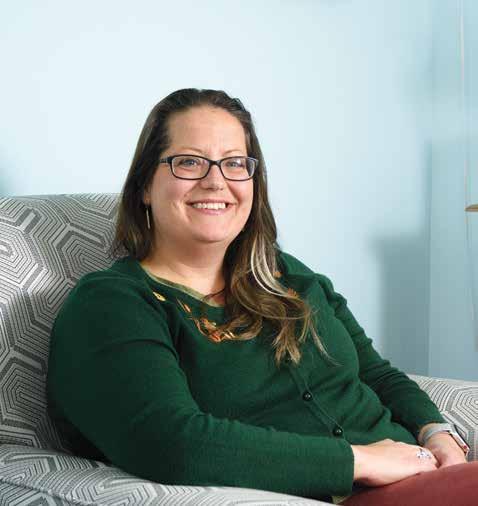
The Crazy Wisdom Community Journal • May through August 2023 • Page 82
Dr. Megan Oxley
a lot of things that have come before it in your life and your lifestyle that have led to this place, and we are trying to sort out why it is they are feeling this way so they can be empowered to change it.” In discussing the altered states of consciousness achieved via psychedelics, Dr. Oxley has continuously observed in patients “an opportunity to look at your problems differently or be in a different mindset when looking at your problems.”
While having an appropriate mindset about personal problems is a concept people understand, achieving it when plagued by the impact of trauma on the human brain can be an insurmountable task for many with (C)PTSD. Fortunately, the off-label use of ketamine injections has proven to help many MPH patients achieve this. As Dr. Oxley described it, “Creating new connections in your brain and reviving old ones that have been left in the dust…there’s physical connectivity and a psychological benefit in the brain that allows for seeing things from a different perspective.” Coming up against a lifetime of socialization, understanding and managing the disorder is a journey for these patients, a journey which appears to be facilitated by continued treatment with psychedelic medicines. “The biggest problem in our society is not recognizing trauma for what it is…we are very emotionally restricted and that’s how we teach our children.” When asked what sources of trauma she sees coming through her doors the most, this writer was taken aback by her response: “The most common is just life…and not recognizing trauma for what it is.”
Patients coming through the doors at MPH are desperately searching for a deeper understanding of the trauma and resulting conditions influencing every aspect of their life and hope to find a solution that will provide a way through the darkness and into light. Referencing her deep dives into the profound work of author and physician, Dr. Gabor Maté, Dr. Oxley said, “I believe that most of the conditions are rooted in trauma: ADHD: rooted in trauma. Addiction: rooted in trauma. Autoimmune conditions: rooted in trauma.”

Furthermore, elaborating on the relationship between trauma, mental health disorders, and autoimmune disease, she said, “The condition is just the label created by psychiatry for the sake of convenience and billing. That may be an unpopular opinion, but it’s not that important in the grand scheme of things. Here in the clinic, we have fixed these conditions that have basically been stemming from the root cause.” In talking with Dr. Oxley it became increasingly clear people do not identify their conditions as being a result of trauma. And society supports the pattern by touting bad luck, faulty genes, poor lifestyle choices, and really anything but trauma as the root cause for debilitating conditions. Dr. Oxley believes the western medical establishment has contributed to further this notion as well. “We saw the patterns, but no one talked about it, and nobody was curious.”
Somewhat in its infancy, much remains to be understood about how and for whom these treatments can be most fruitful. As an example, Dr. Oxley explained, “There is some early evidence that people with childhood trauma, which can be emotional or physical, respond better to ketamine than people who don’t, which is really interesting, and is yet to be sorted out by science.” MPH is actively researching this phenomenon now.

Patients seeking treatment at MPH are subjected to a series of assessments and exams to make sure they are eligible to safely receive off-label ketamine treatment. Once a patient has been determined eligible for treatment, a highly individualized treatment plan is developed. Most patients receive approximately six-to-eight in-clinic treatments over the course of several months, with
follow up visits in between to track progress. While the use of such powerful medicines would ideally be used in tandem with a long-standing therapeutic relationship, Dr. Oxley acknowledges this is not always possible, and the reasons are quite tragic. “We strongly recommend that patients are working with a therapist, but we do see a lot of people who have been either disenchanted or disenfranchised by the therapy system.” Even without an established therapist, patients and practitioners alike see results that previously felt impossible. “Once you started seeing people get better with ketamine you had to start explaining things that weren’t explainable with western medicine.”
And maybe a healthy degree of separation from western medicine is required to understand and achieve maximal benefit from these medicines. Historically, psychedelic experiences were often deeply sacred and as much part of an emotional and spiritual journey as a medicinal treatment. It seems there was something to the way these medicines were consumed with such intention in more ancient times and Dr. Oxley believes holding close to those traditions should be part of the protocol. “I would like to see these medicines be used with reverence the way they were for thousands of years before we got to the place where we are at…and I think they should definitely be legal.”
With clinical psychedelic treatment legally restricted to the off-label use of ketamine at this time, and out of pocket costs ranging between $5,000$10,000, decriminalization and legalization of psychedelics could be key to addressing the mental health crisis on a scale from local to global. Dr. Oxley acknowledges this, stating, “That’s the biggest problem with what we do…we don’t see the patients that probably need ketamine the most…Accessibility is my next big hurdle to tackle.”
And tackling it she is. Amid the Covid-19 global crisis, Dr. Oxley began the process of establishing a non-profit organization to make psychedelic medicines legal, available, and affordable to all who need and want to explore them. Regulatory changes concerning legalization and insurance coverage won’t just help patients with affordability and access. Changes such as these would allow licensed practitioners to legally offer a more diverse array of healing psychedelic remedies such as LSD, MDMA, and psilocybin in a clinical setting without risking legal consequences and loss of licensure.

The Crazy Wisdom Community Journal • May through August 2023 • Page 83
Historically, psychedelic experiences were often deeply sacred, and as much part of an emotional and spiritual journey as a medicinal treatment. It seems there was something to the way these medicines were consumed with such intention in more ancient times, and Dr. Oxley believes holding close to those traditions should be part of the protocol.
Dr. Megan Oxley’s office at Michigan Progressive Health
Psychedelic Medicinescontinued....





While an expert in her field, Dr. Oxley is also a lifelong student of it, choosing to look at every case as an opportunity to learn. “Every patient teaches me something new about depression, about PTSD, about ketamine, about psychedelics, and about life, and I try to carry that forward to future cases. Always learning.” One of the most important things Dr. Oxley has learned is to include a personal approach to bringing psychedelic medicine into the local conversation about treating trauma and normalizing the use of psychedelics asserting, “There is an onus on those of us in this place to be more open. Like, I’m a better mother because I did mushrooms.”
When asked what the most important takeaway from our conversation should be, she said, “What people need to know is that these medicines are inherently quite safe and extraordinarily helpful, and our society is suffering more and more with mental illness and this is one really big way we can make a difference in not suffering…The root cause is our toxic culture. We work too much, we eat too much, we drink too much, we do everything too much because we are trying to distract ourselves. Human doings not human beings, completely out of touch with our human bodies.”
Seeking a consciousness-based and more relaxed clinical approach to psychedelic treatment, Southeast Michigan native and Nurse Practitioner Shannon Starr PMHNP (Psychiatric Mental Health Nurse Practitioner) founded Floresta in 2021 with “a team of clinicians, doctors, coaches, pioneers and those that dare to be the change that is required within mental health and psychiatry.” With offices in both Michigan and Florida, Floresta offers monthly ketamine-assisted psychotherapy retreats across the United States.
Dedicated to doing her part in improving the human condition, Starr was transparent in sharing her position on how psychedelics produce results so vastly different than traditionally accepted means. “Through these medicines one can create change that is not linear and can really allow for a way to regain choice and power and thrive in one’s life and not just survive…energetically treating the whole person.” During these two-to-four day immersive retreats, the Floresta team takes an open and energetic approach to working with anywhere from six to up to twenty attendees, finding that “transformation can occur much more rapidly when we are not trying to control it, limit it, or have any conclusion on what it looks like.”
These retreats include other spiritual and mindfulness-based activities such as yoga, breathwork, guided nature walks, and TCM (Traditional Chinese Medicine) sessions to enhance the overall healing experience and create a “safe and reverent space” for the ketamine treatments. Starr believes the healing experiences that occur during retreats are ultimately derived from the attendees themselves, crediting the altered states of consciousness achieved by the medicine as an ally and a tool to help people find deeper healing truths and a catalyst for change when working through trauma, depression, suicidality, and (C)PTSD.
Describing ketamine as an “algorithm disruptor,” Shannon Starr recounts other common outcomes including patients finding love for themselves, developing a routine that fosters healthy living, and an increase in mindbody connectivity.
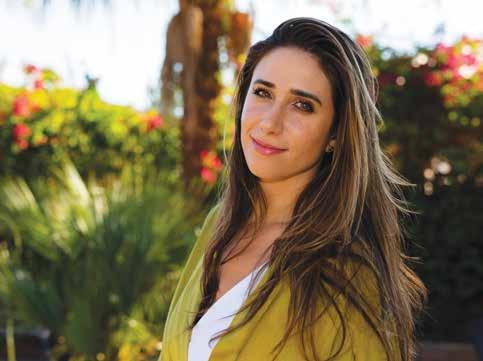
At the outset of her career, Starr planned to take a functional and nutritional medicine approach to treating psychiatric conditions. That course changed when she began working with psychedelics in 2017. Committed to demonstrating the level of vulnerability she encourages in her patients, Starr shared that her passion for these medicines was born out of a journey to find help and solutions for her own struggles with mental health and related physical conditions. “In my first psychedelic experience I could perceive the capacity for change that could be created in a way that moves so much faster, and I love moving quickly, efficiently, and safely. Working with plant medicine and allowing for more of these mystical experiences, that allows and unblocks different ways of perceiving reality, and a lot of trauma and psychiatric conditions aren’t necessarily linear.”
Keeping in mind the non-linear gradual nature of healing, Floresta hosts regularly scheduled integration circles for patients to attend indefinitely at no cost following the retreat experience. This also allows the Floresta team the opportunity to provide continued support and to observe long-term outcomes. When asked to share some examples of common, powerful outcomes she has seen, Starr ‘s response was immediate. “Working with clients with acute suicidality. I had a client at a retreat saying if this didn’t work, she was going to look into legally euthanizing herself. And having that totally changed, coming in feeling completely suicidal and leaving full of hope and feeling joy. That space of worry and constant rumination is now a space of calm and patience and less reactivity.” Counting herself lucky, you could feel the sincerity in Starr when she said, “I am so happy that I am alive in this lifetime where I get to offer this treatment and really see how it’s healing and helping.”
Describing ketamine as an “algorithm disruptor,” Starr recounts other common outcomes including patients finding love for themselves, developing a routine that fosters healthy living, and an increase in mind-body connectivity. With patients with depressive symptoms, she regularly sees the lack of motivation and fatigue open up, so people can do things to move their lives forward. In (C) PTSD patients the trauma response, reactivity, and hypervigilance transforms into a space of calm and relaxation, allowing the whole nervous system to relax. (C)PTSD patients are able to have a softer response and see reduction in panic attacks, nightmares, and other symptoms that have plagued them and interfered with their life and functionality for years. With psychedelics, they can discover that it is normal for the body to be relaxed and allow relaxation to be their new baseline.
Shannon Starr believes the healing experiences that occur during retreats are ultimately derived from the attendees themselves, crediting the altered states of consciousness achieved by the medicine as an ally and a tool to help people find deeper healing truths and a catalyst for change when working through trauma, depression, suicidality, and (C)PTSD.
While Floresta only offers ketamine treatments at this time, Starr is excited about the direction things are headed in -- the legalization of other psychedelics, particularly psilocybin. Still, she worries it is not happening fast enough for people suffering now. In order to help these people sooner rather than later, Starr and the Floresta team are currently exploring options for hosting retreats in places where psilocybin is legal, such as Jamaica. Echoing Dr. Oxley’s sentiments, Starr also believes that while some people could find success using psychedelics in a recreational space, others would not. So, this creates a need for safe and sacred settings, as well as proper educational resources made readily available, for individuals choosing to utilize psychedelics as part of their journey to healing and wellness.
A steadfast pioneer in this cause, former Licensed Professional Counselor, Board Certified Music Therapist, and Founder of Blue Sage Health Consulting, Julie Barron, has been instrumental in bringing the magic of plant medicine and psychedelics into the public eye and providing quality training to interested individuals as well as emerging psychedelic practitioners right here in her home state of Michigan. Her first task was to decriminalize plant medicines in Ann Arbor. In 2021, newly elected Washtenaw County Prosecutor Eli Savit
The Crazy Wisdom Community Journal • May through August 2023 • Page 84
made a bold move, essentially decriminalizing possession or small-scale distribution of entheogenic plants and other naturally occurring psychedelics, as well as supporting the expungement of old criminal convictions arising from entheogenic plant offenses. When looking at progress such as this, the contribution of Barron’s 10 years of activism in this arena can’t be lost upon us. While doing away with criminal consequences for using these substances is a huge step forward, there is still a long road ahead in making these medicines and treatments available to all who need it. With emphasis, Barron put it quite simply, “The goal is access. For all who want it with the focus on the most vulnerable people among us first.”
A lover of plant medicine since she was young, Barron began training to work with transformative plant medicines and non-ordinary states of consciousness during her graduate studies, crediting this work as defining her path as an out-of-the-box thinker. Upon completing her formal education, Barron knew healing does not occur in a vacuum and felt she could not do this work without “working on the community base” to decriminalize and legalize access to these medicines, particularly psilocybin.
Barron considers psilocybin the “whole package,” holistic on every level in working with individuals plagued by (C)PTSD and trauma. She envisions a treatment landscape that incorporates a therapeutic process around plant medicine work, including supervised macrodoses (larger doses with more profound psychedelic effects) of psilocybin followed by self-administered microdoses under the guidance of a practitioner.



Looking back on decades of work in this field, Barron cites neglect and emotional, physical, and sexual trauma as the primary precursors to (C)PTSD that she sees. Additionally, she finds the more complex the trauma, the more complex the case, necessitating a team-based, long-term healing approach. To meet this need, Barron works as a consultant to the therapist and client. “It’s hard to figure it out on your own and there needs to be people helping them figure it out.” Multiple times per year Barron offers formal training seminars to therapists, teaching them how to help their clients on their journey to help themselves with these medicines.
In discussing outcomes, Barron reflects upon her nearly three decades of work, summarizing it with a powerful statement that includes both the patient and the therapist: “The greatest gift that comes out of psychedelics…is the interconnection between mind, body, spirit. Overall, the people I work with do shift, and as a therapist that is my guide to success.”
With high costs and lack of insurance coverage creating a massive socioeconomic disparity in formal clinical access to these life changing and often lifesaving treatments, people have become desperate and begun to pursue them on their own.
trauma level of functioning. Johnson approaches these clients in an open and supportive way. “As mental health professionals, it’s important we recognize existing barriers to treatment, and we can take an open approach in supporting clients who seek this type of treatment on their own and notice a benefit. People have reported positive change attributed to the use of psychedelic medicine, and continued research and progressive policies may help to eliminate treatment barriers, expand the types of services provided by mental health professionals, and ultimately, improve the lives of those who find this treatment beneficial.”
Trauma is not new, but therapists are applying new ways of thinking to the problem. Body/mind modalities and somatic-based therapies have moved the ball forward in treating trauma. It began with Wilhelm Reich in the 1950’s, moved on to Alexander Lowen’s Bioenergetic Therapy in the 1960’s, Arthur Janov’s Primal Therapy, and Ida Rolf’s Rolfing, in the 1970’s, and then the somatic experiencing therapies, EMDR, and sensorimotor therapies in this century. Cutting edge therapists over the last 70 years have worked hard to understand the roots of trauma and neurosis. Now, finally, psychedelics have become an accepted part of the toolbox for impacting the treatment of trauma. There is a sense that psychedelics are a potential game changer in working with trauma, provided that one is working with conscientious and responsible practitioners. We can all be grateful to the practitioners who are charting these new paths with psychedelic treatments, and we can also be grateful for these plant-based medicines, themselves.
Brett
Johnson LMSW (Licensed Master Social Worker), a trauma informed therapist at Peaceful Mind Counseling in Dexter, has worked with clients who have had to take this path to help themselves achieve a pre-
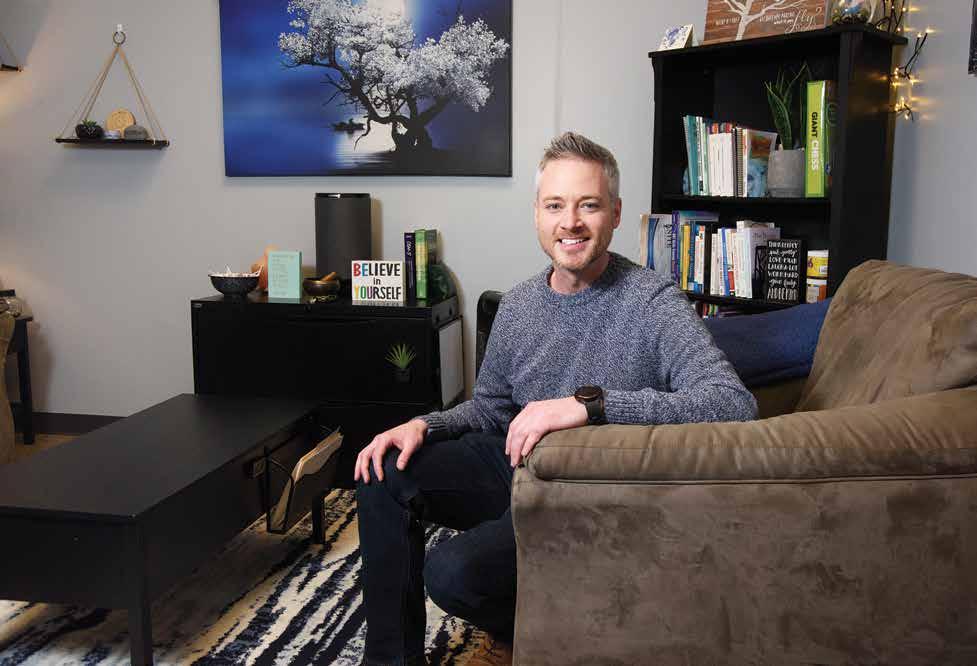
The Crazy Wisdom Community Journal • May through August 2023 • Page 85
Brett Johnson, a trauma informed therapist at Peaceful Mind Counseling in Dexter.
“The greatest gift that comes out of psychedelics… is the interconnection between mind, body, spirit. Overall, the people I work with do shift, and as a therapist that is my guide to success.”
—Julie Barron
Field of the Five Horses
By Irena Barbara Nagler
I’d been given some gourmet coffee for Christmas. It was late at night. I’d have to work in the morning, but, feeling impelled to give it a try, I brewed the rich dark potion.
The next day I remembered a night when I was eight years old. I was living in the tropics with my family, where heat thins boundaries and can induce fertile dreaming. I’d been allowed to drink a caffeinated beverage just before going to bed, a one-time occurrence. As I lay wide awake, the aquarium music from Saint-Saens’ Carnival of the Animals played in my brain. It got louder and louder. My room faded into green mist and shoals of golden fish swam through it from various angles and directions, hovering and then dissolving. Having gone to school opposite one of those old, gothic mental hospitals, I was frightened I might be locked up in it when we returned to the States, and I clutched the sheets until the vision dissipated.
My room faded into green mist and shoals of golden fish swam through it from various angles and directions, hovering and then dissolving. Having gone to school opposite one of those old, gothic mental hospitals, I was frightened I might be locked up in it when we returned to the States, and I clutched the sheets until the vision dissipated.
But this December night in my twenties, after a few years of experience of a then-illicit substance, plus one or two others on rare occasions, I was happy to float in a caffeine-induced synesthesia. Sounds in the street turned to color: spills of red and orange light on sidewalks, blue scrape and brush of tire friction on asphalt, green and gold voices.
Then I was in the air, over the rooftop, among a herd of white horses that roam universes. They leaped and soared, their manes and tails brushing my arms, their presence all around. It was a completely unexpected joy.

Horses cast their electricity out broadly. I was invited in 2011 to attend and present a participatory dance at a celebration at Tall Trees Farm in Oakland County: an experiment in permaculture and community farming. My first sight as my friend Matt and I drove up to the parking area was of a white horse standing beneath a tree, painted with Native American symbols, accompanied by two men, (one of them Native, the other not). It turned out the horse, named Magic, was a companion and familiar to Cliff Mortimer.
A little later, when I saw Magic and Cliff walking together in a field, I felt an irresistible urge to meet the horse. Normally I’d have been hesitant, even cowardly, but I walked half the field, swimming through the sense of invitation cast so generously by the horse. Magic pushed his nose into my palm and encouraged affectionate strokes and walked in circles around me painting swirls of elation.
Later, at a pine grove where I was about to facilitate movement meditation, Magic and Cliff arrived. Magic cantered around the outside of the grove again and again, all classic horse with mane and tail flying—then remained guarding the entrance with Cliff and his friend, while participants danced with trees.
A friend once postulated that much human strife was generated or intensified when horses were broken to be used for transportation. The speed of migration and invasion made for superficial connection, projection, and objectification, which intensified tendencies to exert dominance.
I’m weaving into a longer novel a story told by a ten-year-old girl of a people who have an intimacy with wild horses. They ask for permission to ride them. The horses offer transportation aid when there is need. The cultural cohesion is disrupted by the arrival of invaders from a cold land, hungry and desperate, a group that corrals the horses and keeps most of the people, who know how to connect to the horses, as servants. These now-subdued people with their secret ability for genuine intimacy are holding the world together for the conquerors. With various threats held over their heads, they believe themselves unable to break out of the servitude that reduces their lives and those of the horses to a mechanical aid for control and conquest.
One day, in my late teens or early twenties, during a week or two in Northern Michigan, I wandered on my own, exploring little roads. At the edge of a field of some golden crop, I stopped, chilled. A prehistoric horse was peering out of the fronds, its eye on the road. Eohippus, the dawn horse, estimated age 45 to 55 million years, resembling a strange little dog- tunneling its way into twentiethcentury Michigan and peering out through long, pale-gold fronds.
The Crazy Wisdom Community Journal • May through August 2023 • Page 86
Artwork by Irena Barbara Nagler
A friend once postulated that much human strife was generated or intensified when horses were broken to be used for transportation. The speed of migration and invasion made for superficial connection, projection, and objectification, which intensified tendencies to exert dominance.
I stood, riveted.
Suddenly, it emerged with a flamboyant gold-red tail floating behind it. A fox, the first I had ever seen. Fox, the shapeshifter, a flame.


In night-maps from space that show urban lights bleeding onto land and into sky, much of Michigan’s reaching hand is brightly lit. But just above it is an area wondrously dark and vast. The hand meets a place where dreaming appears to meld with the physical more purely and there is room to explore the blending of the two.

A dream, 1994. I am in a forest pierced by a lamp-lit road. Two women walk down it and disappear to the left where the road enters an area of dense trees. One of the women seems to be myself, wearing a dress I had worn to a recent memorial gathering.
Then, from that direction, moving to the right, a golden horse ambles through the scene, drawing a cart, looking burdened and sad.
A moment of silence.
Then five horses appear from the right, running. The one in the middle is the golden horse, now freed of its cart.
Another dream of five horses presented a film set during World War II. A young woman named Anna and her father are rescuing war-orphaned children who are being mistreated on farms where they are held as refugees. They rescue five boys and take them to live at their farm where they have five horses. Anna is devoted to the work, which leaves her little time to live a “normal” young life. But she has a luminous dark beauty.
One day, the family at the house sets the five horses free. They bound away into a field steeped in sunlight. They will come back and visit, but will no longer be fenced in.
Five horses, one more than the apocalyptic four. Pandora’s Hope, and more. The horse-dream companion: the ability to fly while standing or walking or lying on earth and paying attention to what is near and find portals to journeying from wherever we are.
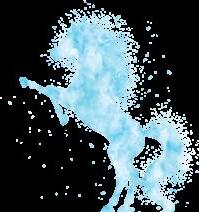
After millennia of migrating on foot: the horse and the wheel. Then the horsepower measure for distance covered in clock-time in automotive vehicles. Greater distances, but in some ways smaller fields.
Then smaller and smaller devices, vast quantitative mental spaces, galloping electrons. There can be a sensation of cramping and compression despite the opening of global connections: we are designed to use more of our senses than sight and hearing, some of which give access to deeper, wider fields to perception and experience than eyes and ears are able to.
Are our fields contracted when we focus on small screens? An opposite effect from William Blake’s world in a grain of sand despite promises to fit the cosmos into a handheld device or a minuscule chip? Carrying them about alters the visual field for those around us, and the sense of presence of those we might otherwise meet. For the shy and overwhelmed, nervously whipping out a phone replaces averting eyes in order to avoid direct contact. But something in us remains fully aware of the other, more so when attention isn’t diverted. Something in us may be aware of the people and places bound in servitude to the making of the machines, and the vast amounts of energy consumed to create the physical components of Cloud-infrastructure.
Are we conscious of how we are slicing into smaller pieces even the experience of those around us when filtering it through handheld phones, collecting secondary images to send to friends, instead of fully experiencing the moment we’re in? It ought not to matter, perhaps, but sometimes it does. Those of us who want to be “all there” can feel the snapped threads of consciousness that would otherwise be woven into a scene of ineffable richness and dimension. I remember standing around a fire brazier with strangers and wishing I were not the only one really being with the fire—everyone else continually held out little rectangles to photograph it. We were not in the same space despite standing measurably near each other.
The metallic horses, too, with their need for parking areas, have shaped our perceived space, almost irrevocably, though eventually all will be swallowed again in eruptions of green, of root and stem and branch, elbowing out concrete.
After millennia of migrating on foot: the horse and the wheel. Then the horse-power measure for distance covered in clocktime in automotive vehicles. Greater distances, but in some ways smaller fields.
• Next class begins September




exploring joy, truth, reactivity, curiosity, and more.

• For more information contact Lou Weir, Diamond Approach Teacher at: diamondworkmichigan@gmail.com

The Crazy Wisdom Community Journal • May through August 2023 • Page 87
Ongoing Classe s
May 1 Crazy Wisdom Discount $10 Use code: CW2023 Enrich Your Health reduce stress, increase concentra�on, and improve balance Peaceful Dragon School 1945 Pauline Blvd., Suite B Ann Arbor, MI 48103 Easy parking - 1 flight of stairs Phone: 734-741-0695 info@peacefuldragonschool.com To register for free intro go to www.PeacefulDragonSchool.com/events
FREE INTRO TO TAI CHI FOR COLLEGE STUDENTS Experience a sense of harmony and well being Limit to 10 in-person par�cipants May 1 - 15, 6-7 PM - Free Intro for College Students Master Wasentha Young Tai Chi and Chi Kung (Qigong)
WORK MICHIGAN Presenting the teachings of The Diamond Approach®
Introduction to Spiritual Inquiry, “Exploring the Present Moment” at the Interfaith Center for Spiritual Growth on June 25, at 10:45 a.m.
Begin
Peaceful Dragon School
DIAMOND
•
’23,
Field of the Five Horses
Electronic/LED colored lights, almost addictively vivid, are sometimes like bleedthrough from another world. Liquid crystal touch-screens read our skin as we read them, bubbles seeming to rise up and shape themselves to electromagnetic finger-gloves until the suction is broken, a touch at a time.
Are our fields contracted when we focus on small screens? An opposite effect from William Blake’s world in a grain of sand despite promises to fit the cosmos into a handheld device or a minuscule chip?
A darker dream that I recently recalled after not thinking about it for years:
Two friends and I are on a hike. We arrive at the edge of a ravine. The slope is dry, eroded, with outcroppings of rock or firmer ground. One of the three of us, Mandy, takes a look at the plunging slant and gets on a sled, lying on her back with her head pointing down. She goes bumping and sliding down the slope, yelling, “This is fun!” I’m feeling annoyed because she’s doing something dangerous, and I believe I have to work to keep her safe with my attention.
The other friend, Arlo, gets on a bike and goes tearing down the slope. I’m not as worried about him, but still would not choose that route on this terrain.
I follow, leaping down from rock to rock and feeling grounded and agile. I prefer to be touching the earth.
At the bottom, I find the other two crouched by a little pool. It’s apparently quite a deep one. Arlo sinks an arm into it. As he pulls his arm out, a horse rises from the water. A ghostly one, though it seems physical enough. It’s ancient, all bones clothed in yellow-white parchment skin. It is loosed into the world, and makes its way somewhere unknown to us, in the direction of the slope we just descended that seems to have disappeared
Does that ancient horse, still roam the earth, live within the bones of modern ones, or in our own? Was there a time when horses took us, dreaming, into the marrow of present space, before humans broke them, skipping vital steps to intimacy and connection, to know less of essence in the guise of knowing more in quantity?
The metallic horses, too, with their need for parking areas, have shaped our perceived space, almost irrevocably, though eventually all will be swallowed again in eruptions of green, of root and stem and branch, elbowing out concrete.
In vernal ponds and tidal pools of dream are realms to explore, moments that expand into journeys. All is available through a simple gesture of turning in, or sharing a dream in community, reaching for one or more dreams that feel currently relevant. The grace of flying manes, running on tundra and grass, or picking a way more slowly on mountain ridges, or swimming among the white manes of blue-black waves. The infinite/eternal space cannot be bound in artificial grids.
Walking through a living forest, relaxing our focus, our attention diffused, we become aware of life-fields around us. It’s a speaking world. It can seem as though a frozen film begins to play again, as we reenter consciously the field of the living system.
Through a recent connection with the Residential College Writers at the University of Michigan, I’ve been reminded of my times in East Quad: the RC before renovation. The one with the Halfway Inn, aka Halfass: a performance space, café, restaurant, and general hangout, open to the outer world for events.
I haven’t visited the building since 2010. My life is centered elsewhere. I may prefer memories of extended evenings there that overflowed with vitality and strangeness, during which it was impossible to sleep until four in the morning. The doors were open all night. On my first evening after moving in, I heard exquisite, birdlike tones from a dark stairway. I followed them and saw a blond man, older than we students were, playing his flute on a ledge. I knew I was in for an adventure.
In the dorm room of a friend, Nisi Shawl, now an acclaimed author of science fiction, three companions lounged around philosophizing and listening to music. The Incredible String Band somersaulted through universes, like my herd of horses. Elf-sparks flashed and flared. In its last line, The Juggler’s Song intones, “The next little ball is orange and blue/I can’t juggle four so I’ll toss it to you/And I call it TIME.”
Does that ancient horse, still roam the earth, live within the bones of modern ones, or in our own? Was there a time when horses took us, dreaming, into the marrow of present space, before humans broke them, skipping vital steps to intimacy and connection, to know less of essence in the guise of knowing more in quantity.
A potential future steeped in electronics existed already in the music and vision. Actors and jugglers waited behind a night-velvet curtain.

Maybe we could have—and in some universes actually do—followed along different threads, the way into worlds of burning colors, some beyond the visible spectrum, not bleached in blue-white light, nor polluted by everincreasing clouds of illumination thrown skyward. The fifth horse of my dream cannot be bound in squares. It travels through waves of ocean and blood. It’s not “orderly” though there’s order arising from it, translated through pulses and waves. Nor does it label people as disordered. It exults in adhering to essence and celebrates differences that arise in creative exuberance from underlying oneness. It celebrates both connection and core.
In the vast picture everyone is everyone and everything is everything, having a grand creative adventure with all possibilities, and generating new ones. Stars beckon into dream journeys on wandering horses with manes and tails of light. They glow within us too.


A little white horse with sapphire eyes leaps into sunlight from under the sea. It’s exquisite, starry. I don’t know what it’s about, maybe just a glimpse of elusive beauty. A hint that a pelagic herd of horses may be wandering just beneath the ocean’s ever-moving skin. Or a benthic herd, grazing on the sea floor, unhurried, shining like a galaxy, generating waves.
Irena Nagler writes fiction, essay, and poetry, teaches environmental movement meditation, and is a visual and performing artist. She has been researching the environmental, social, and industrial underpinnings of current technology for eleven years. Contact her by email at: birena@umich.edu.
The Crazy Wisdom Community Journal • May through August 2023 • Page 88
The Crazy Wisdom Kids Section

Our Book Picks for Kids and Tweens

The Bright Side
By Chad Otis
This endearing picturebook about making the most of any situation is also a heartfelt and meaningful portrait of houselessness that’s just right for young children. Sometimes it’s hard to stay positive: when you live in an old school bus instead of a normal house; when you have mostly just bread and ketchup to eat; and especially when you have to go to a new school where all the other kids already have friends. But the sweet and creative boy in this story discovers that he can do things he never thought possible, by using the skills his parents have taught him: imagining . . . and trying . . . and finding a way to look on the bright side.

Patrick Picklebottom and the Longest Wait
 By Mr. Jay
By Mr. Jay
This time, when Patrick sees a sign announcing story time is coming up, he's the first to arrive. But to his dismay, however, he arrives hours early, and the wait just feels like forever. Patrick has his work cut out for him to keep himself occupied, and not go stir-crazy during his very long wait. Using art and music, Patrick creates new worlds for himself and the reader, showcasing that in any trip, there's far more fun in the journey than in the destination. And with a surprise twist at the end, we never know where his imagination will take us next!
The Universe in You

 By Jason Chin
By Jason Chin
In Your Place in the Universe, Jason Chin zoomed outward, from our planet, solar system, and galaxy to the outer reaches of the observable universe. Now, Chin reverses course, zooming in past our skin to our cells, molecules, and atoms, all the way down to particles so small we can’t yet even measure them. Like its companion, The Universe in You is a mind-boggling adventure that makes complex science accessible and enjoyable to readers of any age. Impeccably researched, wholly engrossing, and with extensive backmatter for additional learning, The Universe in You is another knockout from the award-winning creator of Redwoods, Grand Canyon, and other distinguished works of nonfiction for young readers.
 Bea Wolf
By Zach Weinersmith, illustrated by Boulet
Bea Wolf
By Zach Weinersmith, illustrated by Boulet
A modern middle-grade graphic novel retelling of Beowulf, featuring a gang of troublemaking kids who must defend their tree house from a fun-hating adult who can instantly turn children into grown-ups. Somewhere in a generic suburb stands Treeheart, a kid-forged sanctuary where generations of tireless tykes have spent their youths making merry, spilling soda, and staving off the shadow of adulthood. One day, these brave warriors find their fun cut short by their nefarious neighbor Grindle, who can no longer tolerate the sounds of mirth seeping into his joyless adult life. As the guardian of gloom lays siege to Treeheart, scores of kids suddenly find themselves transformed into pimply teenagers and sullen adults! The survivors of the onslaught cry out for a savior a warrior whose will is unbreakable and whose appetite for mischief is unbounded. They call for Bea Wolf.

Finally Seen
By Kelly Yang
When ten-year-old Lina Gao steps off the plane in Los Angeles, it’s her first time in America and the first time seeing her parents and her little sister in five years! She’s been waiting for this moment every day while she lived with her grandmother in Beijing, getting teased by kids at school who called her “left behind girl.” Finally, her parents are ready for her to join their fabulous life in America! Except, it’s not exactly like in the postcards. As she reckons with her hurt, Lina tries to keep a lid on her feelings, both at home and at school. When her teacher starts facing challenges for her latest book selection, a book that deeply resonates with Lina, it will take all of Lina’s courage and resilience to get over her fear in order to choose a future where she’s finally seen.
You may purchase these books at shopcrazywisdom.com by either visiting the website or scanning the QR code.
The Crazy Wisdom Community Journal • May through August 2023 • Page 89 The Crazy Wisdom Community Journal • May through August 2023 • Page 89
“You can find magic wherever you look. Sit back and relax all you need is a book!”
– Dr. Seuss
By Kris Maly
Ele’s Place Ann Arbor is a healing center that provides peer grief support for children, teens, and their families in Ann Arbor as well as the surrounding southeast Michigan area, free of charge, for as long as a family needs. Ele's Place Ann Arbor is the only nonprofit in our community dedicated solely to helping children and teens work with, and through, grief in a peer-based setting.
“Ele’s Place Ann Arbor was established in 2007, and we opened the doors of our dedicated healing center—our Home for Healing Hearts—in 2019. At that time, we were able to expand our peer grief support groups to four evenings a week, helping about 160 grieving children, teens, and families each week,” Bree Arvai, Branch Director at Ele’s Place Ann Arbor said. “Unfortunately, the need for our services will never go away, and we’re so grateful that Ele’s Place Ann Arbor is here to help when families need us.”
At Ele's Place, children and teens have a place to share their stories and memories, explore their feelings, and learn coping skills alongside their peers.
According to the 2022 Childhood Bereavement Estimation Model, one in 11 children in Michigan will experience the death of a sibling or parent before age 18. Children and teens who are grieving need access to a supportive environment and compassionate peer-based programming, as peer grief support can have a positive life-long impact on a young person. As the need for these critical services continues to grow, Ele’s Place Ann Arbor is committed to ensuring that no child or teen should have to grieve alone.
Before coming to Ele's Place, some children and teens have expressed feeling alone and isolated in their grief. They may keep their emotions inside and may be hesitant to share their feelings with other family members or friends.


“At Ele's Place, children and teens have a place to share their stories and memories, explore their feelings and learn coping skills alongside their peers. They have the opportunity to meet new friends who understand what it feels like to experience the death of someone in their lives,” said Hannah Brown, LMSW, Program Director at Ele’s Place Ann Arbor. “To promote healing, children and teens engage in a variety of activities with their peers, including the utilization of music, art, storytelling, writing, and play, and they are able to express their feelings in an emotionally safe space while being supported in their grief.”
Ele’s Place was founded in Lansing, Michigan, 32 years ago when a group of mental health professionals, concerned community volunteers, and grieving parents Betsy and Woody Stover, saw a need to provide bereavement support for the Stover’s three young children after the death of their 11-month-old daughter, Ele.

After researching several children’s grief centers across the country, they determined that peer support for grieving children and teens who had experienced the death of someone significant in their lives was the best way to learn to cope with their feelings of grief, sadness, anger, and loss.
–Bree Arvai, Ann Arbor Branch Director
Ele’s Place Ann Arbor— A Home for Healing Hearts
“After researching several children's grief centers across the country, they determined that peer support for grieving children and teens who had experienced the death of someone significant in their lives, was the best way to learn to cope with their feelings of grief, sadness, anger and loss,” Arvai said.
Ele’s parents also wanted the name of the organization to have greater meaning beyond their daughter, for all children and teens who are grieving.
“While the name of our organization—Ele’s Place—is named after the Stover’s daughter, Betsy Stover found an even deeper connection to the organization’s mission after searching in the dictionary. The acronym, ELE, stands for ‘Embracing Loss Effectively’,” said Arvai.
Ele’s Place peer groups for children and teens are divided by age, typically preschool/kindergarten, early elementary, upper elementary, middle school, and high school, and are led by trained volunteers with oversight by clinical program staff.
“Ele's Place Ann Arbor offers evening peer support groups for children and teens ages 3-18. Groups allow children and teens to realize they are not alone by connecting with individuals their age. Peer support groups for the child's/ teen’s parent(s) or guardian(s) are also available, as it’s important to be able to support adults in their grief, so the family can continue their healing journey together,” said Brown, who has been with Ele’s Place Ann Arbor since 2013. “Our role is to be present with grieving families and to walk alongside them in their journey. We know we cannot fix what’s happened, however, we can be present with them and the feelings they have.”
Ele’s Place peer groups for children and teens are divided by age, typically preschool/kindergarten, early elementary, upper elementary, middle school, and high school, and are led by trained volunteers with oversight by clinical program staff. Peer groups for adults are split by type of loss: spouse/partner loss, child loss, other significant loss and suicide/homicide/overdose and are facilitated by licensed mental health clinicians. All peer grief support groups are provided at no cost to the families.
Arvai said that the peer grief support services Ele’s Place Ann Arbor provides are “100% free of charge, for as long as a family needs, and 100% communitysupported, by generous individuals, companies, small businesses, and foundations.”
To fund their peer grief support programs, Ele’s Place Ann Arbor hosts several amazing fundraising events throughout the year, one of which is coming up on Saturday, June 24, 2023. “Everyone is invited to join us at our Healing Hearts Family 5K Walk/Run, a family-friendly event to honor, celebrate and remember a special person who has died. Grab your walking or running shoes and register to join us for our third annual walk/run,” said Arvai.
If families need assistance, please call Ele’s Place Ann Arbor at 734-929-6640 to speak with our clinical program staff.
Ele’s Place Ann Arbor is grateful for 16 years of peer grief support for children and teens in Ann Arbor, and the surrounding southeast Michigan area. The organization’s vision is that no child or teen should have to grieve alone. For more information, please visit the Ele’s Place website at elesplace.org.
Kris Maly has served as the communications manager for Ele’s Place Ann Arbor since 2020, after joining the organization as the project manager for the Capital Campaign in 2018.
The Crazy Wisdom Community Journal • May through August 2023 • Page 90
Conscious Parenting
The Crazy Wisdom Community Journal Events
Calendar for Kids-Related Classes and Happenings

•
May through August 2023
New, Fun, and Just Plain Cool Things to do!
Childbirth
Six-Week Childbirth Series with Cynthia Gabriel and Toni Auker · May 2 through June 6 · 5:30 to 8:00 p.m. · This class aims to prepare you for your best birth. We will cover topics including stages of labor, communicating with providers, informed decision making, coping techniques, and postpartum. $350.00. For more information email Hello@nestandnurture.org or visit nestandnurture.org.
Doulas' Night Out · Friday, May 26, June 23, July 28, and August 25 · 7 to 9:00 p.m. · All Doulas and Birthworkers are invited to join us for a fun night of connection, support, and fun. Speakers and activities will vary each month. We do ask that you RSVP by emailing Hello@NestandNurture.org. FREE-$10. Presenters will be determined closer to the event, but in the past, they have included a chiropractor, pelvic floor therapist, and acupuncturist. For more information email Hello@nestandnurture.org or visit nestandnurture.org.
One Day Prenatal Bodyfeeding Class with Erica McLeod · May 28, June 24 · 2 to 4:30 p.m. · This 2.5-hour comprehensive class enables us to take time to answer all your feeding questions, and concerns. We will cover information beginning with the prenatal period to feeding in the early weeks. ASL and Queer affirming. This class will be taught at Nest & Nurture. Private classes are also available in person and virtually. $100. For more information contact EricaMcleod@gmail.com.
Family Pride Party with Nest & Nurture · June 4 · Noon to 4:00 p.m. · Nest & Nurture celebrates ALL families. Come celebrate Pride month us. We will have music, crafts, storytime, and more. FREE. For more information email Hello@ nestandnurture.org or visit nestandnurture.org.
Newborn Care with Toni Auker · Saturday, June 17 · 10 a.m. to 1:00 p.m. · In this class we will answer all of your questions about bringing home a newborn. We will talk about how to soothe a crying newborn, bathing, different diapering choices, babywearing, car seat safety, safe sleep, and much more. We will give you several different tools and techniques for each topic and discuss the wide range in normal when it comes to newborns. This class is ideal for expectant parents as well as adoptive and fostering parents. Private classes are also available. $100. For more information email Hello@nestandnurture.org or visit nestandnurture.org.
Children and Young Adults
Happy Signing Time with Sonya Carter · May 10 and May 24 · 10 to 11:00 a.m. · Join us as Sonya teaches us to use our hands to sing with babies and toddlers. Whether you are fluent in sign language or curious to learn, this will be a fun bi-weekly class. $15 drop-in or 6 classes for $60. For more information email Hello@nestandnurture.org or visit nestandnurture.org.
H2W2 - K4K - Happy, Healthy, Wealthy, Wise - Kabbalah for Kids (5th grade & up) with Karen Greenberg · Sunday, May 21, June 25, July 23, August 20 & continues to meet monthly · 1 to 3:00 p.m. Utilizing movement, multisensory input, color, and experiential learning, we build self-esteem of spiritually evolved children (not reinforce feelings of being different, damaged, defective, disordered, dysfunctional). In an ascensional journey through the Tree of Life, we aid in organizational skills, navigating low-vibrational emotions, relationships, setting healthy boundaries. We encourage children in discovering and fostering their authentic selves’ genius, to fulfill their spiritual mission of a healthy, interdependent, functional planet for the “1000 Years of Peace” prophecy. $50/ session for 2-hour class. For more information contact Karen Greenberg (734) 417-9511 krngrnbg@gmail.com or visit clair-ascension.com.
Camp Jump-In 2023 Intensive Therapy Camp with Jacquelin Kilburn · July 17 through 28 · 9 a.m. to Noon · Therapy camp benefits children with sensory processing difficulties, learning problems, apraxia, in-coordination, low muscle tone, auditory processing dysfunction, and other neurological delays or disorders. We use the “Frequency, Intensity, Duration Model” which has been proven highly effective at making large gains in a small amount of time. We require one parent or caregiver for each camper, because the camp becomes a parent training, networking, and support system. We can accommodate eight campers. All camp activities are held outdoors, weather permitting. Activities involve the use of suspended equipment, gross motor activities, fine motor activities, social interaction, brain gym, language, body work, and pool time. Campers new to Jump-In need an evaluation prior to camp. Due to the intensity level, campers must be at least four years old. Program may be covered by health insurance. For more information call (810) 231-9042 or email Info@ jumpinot.com.
Summer Peace Camp with Ann Arbor Zen Buddhist Temple Friday, July 28 through Friday, August 4 · Tent camping for families and children of all ages, by the lake and in the forest, close to Ann Arbor. Peace camp programs focus on learning about peace and happiness from the Buddhist perspective of the interrelationship of all things. Activities emphasize fun, mindfulness, cooperation, and appreciation for animals and plants while seeking to balance structure and spontaneity. For more information call Zen Buddhist Temple at (734) 761-6520 or email annarborzentemple@gmail.com.
Parenting, Teaching, Coaching, and Working with Indigos with Karen Greenberg · Sunday, August 27 · 9 a.m. to Noon · Your Indigo child is a genius! What worked with earlier generations, simply doesn’t work and can even be counterproductive and self-defeating. Indigos, parents, teachers, coaches, employers, and employees: learn how to discover, understand, encourage, support, nurture this genius, novel patterns of bonding, how emotional needs differ from those born previously, mate agreements, social difficulties, organization, hyperactivity, and alternative strategies to drugs, how Indigos learn differently, and mirror unresolved family issues (private individual/family sessions available, too). $77. For more information contact Karen Greenberg (734) 417-9511, email krngrnbg@gmail.com or visit clair-ascension.com.
Family-Friendly Festivals and Fairs
Art on the Grand · June 3 & 4 · Saturday 10 a.m. to 7:00 p.m., Sunday 11 a.m. to 5:00 p.m · Art on the Grand takes place along Grand River Avenue in historic downtown Farmington, between Farmington Road and Grove Street. The fair features FREE admission and an array of high-quality art in a variety of price ranges and disciplines including ceramics, jewelry, painting, photography, wood, wearable art, glass, leather, and sculpture. For more information visit artonthegrand.com.
Saline Celtic Festival · Friday and Saturday, July 7 & 8 · Join us for our 26th festival! We’ve relocated to the Washtenaw Farm Council Grounds just north of Saline at 5055 Ann Arbor Saline Road. Celebrate your Celtic heritage with Highland dance competitions, Ancient Athletics competitions, merchants, workshops, and more! Magical fun for the whole family. For more information visit salineceltic.org.
Holler Fest with the King Family at Frog Holler Farm Friday, August 25 through Sunday, August 27 · Begins Friday at 2:00 p.m. through 8:00 p.m. on Sunday · A family-friendly farm festival featuring over 60 top local music artists on four stages with guided nature walks, yoga and movement workshops, local food vendors, and kid’s activities throughout the weekend. FREE camping. Check hollerfest.com for when tickets go on sale. For more information follow Holler Fest on Facebook and Instagram or email kings@hollerfest.com.
Massage
Infant Massage with Irene's Myomassology Institute · Saturday, August 26 · 9 a.m. to 1:00 p.m. · Students are taught how infant massage can enhance development and well-being of babies. Techniques included are for infants up to one year old. Students are asked to have a friend or family member bring a baby to class. If a student wants to work with their own baby, another care-giver will need to bring the infant to class. You will also need a sheet, doll or stuffed animal large enough to practice techniques. $88. For more information call (248) 350-1400 or visit irenes.edu.
Parenting
Infant/Pediatric CPR and First Aid with Lorenda Lewis May 28 · 10 a.m. to 1:00 p.m. Nest & Nurture is excited to team up with Lorenda Lewis to offer this class, which includes Red Cross Certification for infant/pediatric CPR and First Aid. $120. For more information email hello@nestandnurture.org
Work & Play Hours at Nest & Nurture · May 2, 9, 16, 23, 30, and June 6 · 10 a.m. to Noon OR 1 to 3:00 p.m. · It can be difficult to find a safe place to let our little ones play away from home. We started our play area so our own children could come to work with us. Thanks to some generous donations from community members and The Little Seedling, we now have a beautiful area that is perfect for toddlers and preschoolers. Our space has a variety of seating options, Wi-Fi, and coffee. We will be here working, and we would love to invite you to do the same. $0-10. For more information visit nestandnurture.org.
The Crazy Wisdom Community Journal • May through August 2023 • Page 91 The Crazy Wisdom Community Journal • May through August 2023 • Page 91
Handcrafting
Little Bug Fairies
A Waldorf-style
Pocket Doll
By Jennifer Carson
Spring brings showers, flowers, and faeries back into our gardens! These cute Little Bug Faeries are great for entertaining little ones during story time, while riding in a car, or waiting to see the doctor. They are so easy to make, you’ll find yourself making one in every color of the rainbow!
Materials Needed:
• 6” square of cotton velour
• 4” square of linen or other wing material
• 3x4” square of cotton interlock knit
• Wool stuffing
• Embroidery floss for eyes, nose, mouth, hair, flowers
• Heat erasable pen
• Strong binding thread
• Fabric glue or Fray Check
• Basic sewing supplies (hand or machine)
To begin, fold your linen square in half. Trace the wing pattern onto the fabric. Stitch right on the outline of your wings. Cut a slit in the wings and turn them right side out. Dab some fabric glue or Fray Check on your slit. Let dry then press with a warm iron.
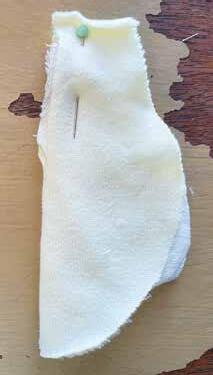



Draw vein lines in your wings. Be creative! Topstitch the lines you drew. Press again to get rid of the drawn lines.
Fold your wings in half and stitch through all layers, very close to the fold. Set aside.
Trace the pattern for the body and the hood onto the wrong side of your cotton velour with your heat erasable marker. Make sure that the stretch goes across the body. Cut these two pieces out from your fabric.
Embroider the body with any decoration you choose. I embroidered flowers.
Fold the remaining cotton velour in half and cut a slit down the center Insert the wings and pin. Stitch through all the layers so the wings are sewn in securely.
The Crazy Wisdom Community Journal • May through August 2023 • Page 92
Pin the body pieces right sides of the fabric together, matching the centers. Stitch along the outside edge leaving a 1/8” seam allowance— being careful not to catch the wings in the seam. Cut out the body and turn right side out. Set aside.
Fold your 3x4” cotton knit rectangle in half. Stitch the long edge with a 3/8” seam and one short edge. Trim seam allowance down to about 1/4”. Turn right side out.

If you know how to make a Waldorf head, make a head that measures about 3 to 3-1/2” in circumference. If you don’t know how, it’s okay! Just wind a wool ball until it’s about 3” in circumference. Then pull three strips of roving that are about 4” long and make a star. Place your wool ball into the center and pull the star’s “legs” down over the ball. Insert into your cotton knit tube.
With a strong thread, tie your tubing under the wool ball.
Embroider the eyes using French knots and three strands of floss. For the eyebrows, hair, and mouth, use one strand of floss. Use two strands for the nose. Add some color to your fairie’s cheeks with a Prismacolor pencil, blush, or rouge crayon.
Stuff your fairie’s body with wool stuffing. Insert the head. Add more stuffing if needed. With a ladder stitch and strong thread, attach the head to the body.





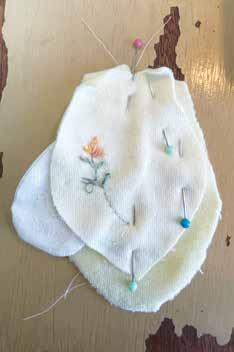
Fold the hood in half with right sides together. Stitch the back seam and turn right side out. Place the hood on your fairie’s head. Stitch the hood to the body with a ladder stitch. Stitch the hood around the face using a tiny blanket stitch, or blind stitch.

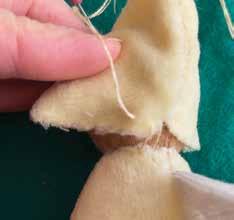
Jennifer Carson is a local author and artist who enjoys creating whimsical art for the home and family. You can see over 70 sewing patterns, her books for kids, and other art on her website, thedragfoncharmer.com or furandfeatherfriends. com. Follow her on instagram @magickalJennCarson_art.

The Crazy Wisdom Community Journal • May through August 2023 • Page 93
Use these full sizes patterns to make your own Little Bug Faeries. • •
©Jennifer Carson 2023
©Jennifer Carson 2023
The Crazy Wisdom Calendar a
free guide to local classes, workshops, and events
May through August 2023
Calendar edited by Jennifer Carson
A Course in Miracles
Course in Miracles Study Group via Zoom with Interfaith Center for Spirtual Growth • May 1 through August 28 • Monday • 6:45 p.m. to 8:45 p.m. • Course study group. FREE, but donations gratefully accepted. For more information visit interfaithspirit.org.
Course in Miracles Study Group via Zoom with Interfaith Center for Spirtual Growth • May 31 through August 28 • Thursday • Noon to 1:30 p.m. • Course study group. FREE, but donations gratefully accepted. For more information visit interfaithspirit.org.








Animals and Pets
Basic Telepathic Animal Communication with Judy Ramsey • Saturday and Sunday, May 27 & 28 • 9 a.m. to 5:00 p.m. • Rediscover your natural telepathic communication skills with step-by-step instruction in a nurturing environment. Learn how to connect with animals the way they communicate with each other. It’s a fun, creative, and fascinating window to the world around us! Join us for this amazing class to open your intuitive senses to your animal friends. $150 per person/$75 for repeat students. For more information email info@JudyRamsey.net or visit JudyRamsey.net.
Canine Massage with Irene’s Myomassology Institute • Thursday, May 25 • 9 a.m. to 1:00 p.m. • Whether your pet is suffering from arthritis, recovering from surgery, or experiencing anxiety, this class will teach you techniques to help quiet your pet’s problems. A basic massage sequence will be taught with special emphasis on the hips. Students must bring a dog to class with them, plus a towel or mat to work on. $88. For more information call (248) 350-1400 or email contact@irenes.edu.
Advanced Animal Communication with Judy Liu Ramsey • Friday, August 4 through Saturday, August 6 • 9 a.m. to 5:00 p.m. • If you have practiced communication with animals after a basic course and want to deepen your experience and to remove blocks to receiving messages, learn to apply your telepathic skills to explore the practical essence of communication with domestic and wild animals, plants, minerals, the elements, and the Earth. Ancestral ways of honoring spirit in all life will be introduced, including learning basic shamanic journeying for connection, communication, and kinship with the whole web of life. $440. For more information email info@judyramsey.net or visit judyramsey.net
Art and Craft
Natural Building & Sustainable Skills Program at Strawbale Studio • May 2 through May 29 or July 2 through July 28 • Live at Strawbale Studio and experience a variety of natural building skills through classes and hands-on training: foundation, round pole framing, thatched and living roof, strawbale walls, earth plaster and cob. Learn to fire up the Rocket Stove, Rumford Fireplace and Earth Oven (for pizza!). Enrichment: mushroom fruiting on inoculated logs, foraging, and more. $1250 / $950 if registered two weeks in advance. All classes, training, enrichment, plus room and board included. Some ½ pay work trade available. For more information visit strawbalestudio.org.
Learning Tour at Strawbale Studio with Deanne Bednar • Saturday, May 13, June 10, July 15, August 6 • 9:30 a.m. to Noon Tour the enchanting structures with thatched & living roofs, Earth Oven, Rocket Stove & Rumford Fireplace! See “Strawbale Studio”, “Hobbit Sauna” & “Middle Earth.” On lovely rural land one hour north of Detroit. Questions invited! Each tour has a workshop scheduled for the afternoon. $20. For workshop schedule and more information visit strawbalestudio.org.
Earth Oven Workshop & Pizza Supper with Deanne Bednar • Saturday, May 13 • 1 to 7:00 p.m. • Hands-on construction of a 1/2 scale earth oven! Learn the basics of designing an earth oven, sourcing, mixing & applying materials, building the confidence to make your own. Then enjoy individual pizzas you will create and bake in the Earth Oven! Held at Strawbale Studio with enchanting natural buildings, rocket stoves and more. Consider registering for the tour in the morning. $70. For workshop schedule and more information visit strawbalestudio.org.
INAI Exhibit - Seasons of Beauty with Kathleen Voss, OP, Janet Wright, OP, Mary Jean Dorsey, OP • Monday, May 26 through October 1 • Artists
Reception is June 4. Seasons of Beauty gives us a springtime look at the brilliant digital paintings of Kathleen Voss, OP, beautiful watercolor paintings of Janet Wright, OP and the extraordinary cut-out silhouettes of Mary Jean Dorsey, OP (1914 - 1988). Each artist shares her unique artwork, her unique way of seeing and creating. For more information call the Weber Center at (517) 2664000 or visit webercenter.org.
Art on the Grand • June 3 & 4 • Saturday 10 a.m. to 7:00 p.m., Sunday 11 a.m. to 5:00 p.m • Art on the Grand takes place along Grand River Avenue in historic downtown Farmington, between Farmington Road and Grove Street. The fair features FREE admission and an array of high-quality art in a variety of price ranges and disciplines including ceramics, jewelry, painting, photography, wood, wearable art, glass, leather, and sculpture. For more information visit artonthegrand.com.
Artists from the Linkage Community, an Alliance of System-Impacted Artists
• Open Monday through Friday • August 11 through September 1 • Opening Reception on Friday, August 11, from 6 to 9:00 p.m. • In cooperation with the Flint ARTWALK. Film screening is on August 31 at 7:00 p.m. The exhibition is designed to connect viewer to artist through the wide gamut of their human experiences. We all have dreams, memories, goals, pasts. We all process emotions of anger, joy, grief, nostalgia. We have specially curated works that show a culmination of ways artists in prison have dealt with complex realities of being human. PCAP worked closely with artists who were formerly incarcerated to select works that would fit the theme of this exhibition and be of interest to the broader audience. FREE. Visitors will see works from familiar artists, including Andy Wynkoop, An ArtsyGuy, RIK, Roger (FREE-Hand) Stephenson, and many others. For more information call Sarah Unrath at (734) 615-5643.
Strawbale Studio Work Trade/Sustainable Skills Program with Deanne Bednar • Four Week Program • August 1 through August 28 • Strawbale Studio Work/Skill Program. Enjoy this enriching experience of living on the land at Strawbale Studio! Help create and maintain Strawbale Studio buildings and grounds while learning many sustainable living skills along the way! two hands-on classes taught each week, such as spoon carving, lashing, foraging, and wood splitting. Includes Room, board, and sustainable skills in exchange for 25 hours infrastructure work trade, half of which will be natural buildingrelated activities. Also participate in any classes held for the public. For more information visit strawbalestudio.org.
The Crazy Wisdom Community Journal • May through August 2023 • Page 94
If you are interested in obtaining some biographical information about the teachers, lecturers, and workshop leaders whose classes, talks, and events are listed in this calendar, please look in the section that follows the calendar, which is called “Teachers, Lecturers, Workshop Leaders, and The Centers” and which starts on page 111.
Our Calendar Editor’s Picks of Interesting Happenings in our Community
Canine Massage with Irene’s Myomassology Institute • Thursday, May 25 • 9 a.m. to 1:00 p.m. • See Animals and Pets
Entering the Healing Ground: The Sacred Work of Grief with Kirsten Mowrey • Saturday, August 26 • 10 a.m. to 4:00 p.m. • See Ceremonies, Celebrations, and Rituals
Camp Jump-In 2023 Intensive Therapy Camp with Jacquelin Kilburn • July 17 through 28 • 9 a.m. to Noon • See Children and Young Adults
Folk Song Jam Along with Lori Fithian and Jean Chorazyczewski at Ann Arbor Library Branches • Wednesday, May 3, June 6, July 5, August 1 • 6:00 p.m. • See Music, Sound, and Voice
Living From our Unlimited Essence Through Meditation with Barbara Brodsky and John Orr • Saturday June 3 through June 10 • 10:00 a.m • See Retreats
Bodywork and Bodymind Therapies

D.O.V.E. Divine Original Vibration Embodiment System Practitioner Training with Karen Greenberg, P.T., • Friday, May 5, 12, 19, June 2, 9, 16, July7, 14, 21 or August 4, 11, 18 • 10:30 a.m. to 2:30 p.m. • After studying

D.O.V.E. System manual, learning to identify and repattern client’s limiting beliefs, thoughts, attitudes, and patterns, and assisting client in expressing any commensurate low-vibrational emotions, and instituting new behaviors. Through the Tree of Life, learn to Kabbalistically balance client’s energy via art, movement, music, toning, sound, aromatherapy, gemstones, sacred symbols, connecting with G-D, Archangels, Angels, Masters of Light, trees, powerful Archetypes, and more. $777 (pick any group of dates above) + materials fee. For more information contact Karen Greenberg (734) 417-9511, email krngrnbg@gmail.com, or visit clair-ascension.com.
Book Discussion Groups
Jewel Heart Readers with Jewel Heart Instructors • Monday, May 8, June 12, July 10 • Online only • 7 to 8:30 p.m • Enjoy lively discussion on monthly Buddhist-related book selections with our community. All are welcome. FREE / Donations welcome. For the book selection and participation information, visit the Jewel Heart-Ann Arbor website, jewelheart.org/chapters/ann-arbor, call Jewel Heart at (734) 994-3387, or send an email to programs@jewelheart.org.
Ancestors & Descendants with Connie Lee Eiland • August 12-13 • Saturday 10 a.m. to 6:00 p.m., Sunday 10 a.m. to 4:00 p.m. • See Shamanism
The Holy Grail: An Initiatory Quest for Divine Gnosis with Rocky Shadow Bear Rains • Fridays, May 5 through June 23 • 6:30 to 9:00 p.m • See Spiritual Development
The Promise of Summer: A Writing Workshop with Tarianne DeYonker, OP with the Weber Center • Saturday, July 15 • 10 a.m. to 4:00 p.m. • See Writing and Poetry
Yoga Chill Summer Course with Christy DeBurton, RYT July through August • See Yoga
Dine & Discuss Book Announcement, Dinner & Discussion with Matthew Desmond • August 7 • 5:30 to 7:30 p.m. • This fall we will be reading, Evicted: Poverty and Profit in the American City, by Matthew Desmond. Evicted: Poverty and Profit in the American City is a 2016 non-fiction book set in the poorest areas of Milwaukee, Wisconsin. The book follows eight families struggling to pay rent to their landlords during the financial crisis of 2007–2008. Winner of the Pulitzer Prize and a New York Times Bestseller, this book not only opens our eyes to the plight of those struggling to keep a roof over their heads, but also offers some possible solutions to this crisis. $15.00 Includes book & dinner. For more information call the Weber Center at (517) 266-4000 or visit webercenter. org.
Buddhism
Practical Buddhism by Gelek Rimpoche • Tuesdays, May 2, 9, 16, 23, 30, June 6, 13, 20, 27, July 11 and 18, August 1, 8, 15, 22, 29 • Online only • 7 to 8:30 p.m. • “Practical Buddhism” offers video recordings of earlier teachings by Gelek Rimpoche as an opportunity for some to revisit and as an introduction for others. A panel discussion with Jewel Heart Instructors follows each session. Discussions are not recorded. Each session reviews Gelek Rimpoche’s 2012 and early 2013 Sunday talks. FREE / Donations welcome. To register, or for more information visit the Jewel Heart-Ann Arbor website, jewelheart.org/chapters/ann-arbor, call Jewel Heart at (734) 994-3387, or send an email to programs@jewelheart.org.
The Crazy Wisdom Community Journal • May through August 2023 • Page 95
Artwork by Jennifer Carson
Adult Fitness and Yoga Program
A t R e c & E d w e c o n s t a n t l y s t r i v e t o m a k e p r o g r a m s m o r e e n r i c h i n g a c c e s s i b l e a n d e n g a g i n g s o y o u h a v e t h e b e s t e x p e r i e n c e p o s s i b l e w h i l e l e a r n i n g a n d h a v i n g f u n O u r c l a s s e s o f f e r a s t r e s s - f r e e e n v i r o n m e n t t o i m p r o v e y o u r w e l l - b e i n g W e c a r e a b o u t y o u r e x p e r i e n c e
704 Airport Blvd., Suite 1 Ann Arbor, 48108
Sunday Celebration Services 10:45-12:15
Monthly Concerts, Movies and Drum Circles
Weekly Study Groups, A Course in Miracles, Science of Mind, Sufi Gathering Mind, & more
Sunday Service and many classes available via live stream
Buddhism, continued
Nagarjuna’s Precious Garland of Advice to a King with Demo Rinpoche • Thursday, May 4, 11, 18 • 7 to 8:00 p.m In his Precious Garland, Nagarjuna offers sound advice on how to gain happiness in this life, individually, and as a society. He then expands the scope to include happiness in future lives and attaining enlightenment through practical ethics, great compassion, and the wisdom of emptiness. Note: This program is a continuation of Demo Rinpoche’s earlier Nagarjuna’s Precious Garland teachings. $60 Jewel Heart members / $75 Jewel Heart non-members. Pay what you can—No one turned away. To register, or for more information visit the Jewel Heart-Ann Arbor website, jewelheart.org/ chapters/ann-arbor, call Jewel Heart at (734) 994-3387, or send an email to programs@jewelheart.org.
Approaching Enlightenment: A Vesak Day Talk with Demo Rinpoche • Friday, May 5 • 7 to 8:00 pm. • Online and on-site. • In Tibetan Buddhism, Vesak Day honors the birth, enlightenment, and death of Shakyamuni Buddha. Vesak is observed by many Buddhist traditions, although the actual month and day may differ according to particular cultures. This Vesak Day talk by Demo Rinpoche provides us with an opportunity to celebrate the life of Buddha and to expand our knowledge about Buddha’s journey to enlightenment. FREE / Donations welcome. To register, or for more information visit the Jewel Heart-Ann Arbor website, jewelheart.org/chapters/ann-arbor, call Jewel Heart at (734) 994-3387, or send an email to programs@jewelheart.org.
Jewel Heart Sunday Talks: Ancient Wisdom, Modern Times, with Demo Rinpoche • Sunday, May 7, 14, 21, 28, June 4, 11, 18, 25, July 2, 9, 16, 23, 30, August 6, 13, 20, 27 • No discussion on July 30 • Online and onsite • 11 a.m. to 1:15 p.m. • Join Demo Rinpoche for weekly Sunday morning public talks on a variety of topics that are suitable for newcomers and longtimers alike, followed by a facilitated group discussion based on the morning talk. On the first Sunday of the month, Rinpoche presents the Jataka Tales, stories from the Buddha’s previous lives. FREE / Donations welcome. To register, or for more information visit the Jewel Heart-Ann Arbor website, jewelheart.org/ chapters/ann-arbor, call Jewel Heart at (734) 994-3387, or send an email to programs@jewelheart.org.
Crazy Wisdom's E-Blast Service is a great way to showcase yourself, your business and your services! This service i s a cost effective method of reaching a targeted audience without the need for investment in costly hardware and mail related so ftware!

Send out a listing of your upcoming classes, workshops, and events.


This is a great way to reach the more than 8000+ people who are currently subscribed to receive our E-Blasts.
Affordable pricing starting at $99.00 for any one email!
For all requirements and to pay visit www.crazywisdom.net

Click on "Crazy Wisdom's Email Service" in the left-side menu.

E-Blast Service ads must be mail-ready (see website) and emailed to Carol. Questions? Contact Carol at carol@crazywisdom.net


IFREE Film & Discussion with Jewel Heart Instructors • Fridays, May 12, June 9, July 14, August 11 • 7:00 p.m. • Bring your friends and enjoy a FREE film and discussion about the film. Concessions are also available. May 12—Happy (2011) Happy combines cutting-edge science from the new field of “positive psychology” with real-life stories of people from around the world whose lives exemplify these findings. June 9—Queen of the Sun: What are the Bees Telling Us (2011) Taking us on a journey through the catastrophic disappearance of the bees and the mysterious world of the beehive, this engaging and ultimately uplifting film weaves an unusual and dramatic story of the heartfelt struggles of beekeepers, scientists, and philosophers from around the world. July 14— Blessings: The Tsoknyi Nangchen Nuns of Tibet (2009) In Tibet, the word for woman translates as “lower rebirth.” In a remote eastern region of the country, the Tsoknyi Nangchen nuns defy this definition. Devoted to the ancient practices of Tibetan Buddhism—once primarily a male domain—over 3,000 nuns have attained elevated status. August 11—Travelers and Magicians (2005) A universal tale of a young man with big dreams and no real plans to achieve them, linking how we live our lives and how we imagine our lives should be. Filmed entirely in Bhutan, directed by Khyentse Norbu. FREE / Donations welcome. To register, or for more information visit the Jewel Heart-Ann Arbor website, jewelheart.org/chapters/ann-arbor, call Jewel Heart at (734) 994-3387, or send an email to programs@jewelheart.org.
Spring Seminar—Daily Practice with the Three Jewels with Demo Rinpoche • Friday through Sunday, May 26, 8:30 a.m. to 6:30 p.m., May 27, 8:30 a.m. to 6:30 p.m., May 28, 8:30 a.m. to 5:00 p.m. • Online and on-site • Putting the Buddha’s teachings into practice is the real dharma – the actual refuge from suffering. Demo Rinpoche will provide guidance and encouragement to sustain a daily, simple practice. He will also provide a framework to establish confidence in other meditative and spiritual practices that are useful in daily life. $180 Jewel Heart members / $225 Non-Members. Pay what you can—no one turned away. To register, or for more information visit the Jewel Heart-Ann Arbor website, jewelheart.org/chapters/ann-arbor, call Jewel Heart at (734) 994-3387, or send an email to programs@jewelheart.org.
Buddha’s Birthday Celebration with Ann Arbor Zen Buddhist Temple • May 27 & 28
• Traditional Buddha’s Birthday Service with Special Chanting, Bathing of the Baby Buddha, and Children’s Celebratory Service. Contact temple for more information. FREE. For more information call Zen Buddhist Temple at (734) 761-6520 or email annarborzentemple@gmail.com.

The Crazy Wisdom Community Journal • May through August 2023 • Page 96
You’re only here for a short visit. Don’t hurry. Don’t worry. And be sure to smell the flowers along the way.
—Walter C. Hagen
a a r e c e d o n l i n e c o m 7 3 4 9 9 4 2 3 0 0
Ensemble! Using the Power of Improv & Play to Forge Connections in a Lonely World
By Christine MacIntyre
Loneliness and isolation are common themes today, exacerbated even more in recent years by stay-at-home mandates and closures of schools and businesses. There is hope, however, as experts reveal solutions to combat the dark voids in life aggravated by a lack of social interaction. In Ensemble! Using the Power of Improv & Play to Forge Connections in a Lonely World, Dr. Jeff Katzman and actor, writer, improviser, and director Dan O’Connor, present a unique solution as the antidote to loneliness. Their combined expertise in improv and psychiatry demonstrates to readers how the skills of improv facilitate connection with others and how to recognize and strengthen current relationships. They call this process Ensembling, in which participants draw from improv skills to create a toolkit of reflective functioning, mindfulness, mentalizing, and emotional regulation. “Ensembling shows us a way to develop increased self-awareness, empathy, compassion, and attention to the dynamics present in all human interaction.”
While improv may seem daunting and an unsuspecting way to combat isolation, core concepts such as teamwork, creativity, embracing adventure and risk, and developing intentional focus are proven effective for meaningful connection with others. Ensemble! presents simple, yet smart, information about Ensembling— what it is, how to do it, who can use it, and why it works. Overall, the book feels informational but reads much like a workbook that teaches you step-by-step how to gain the upper hand on loneliness.
Katzman and O’Connor offer a sincere explanation of loneliness, what causes it, how different people experience it, and the negative impact it may have on health and well-being. Then, observing the innate social construct of human beings, the authors convey how and why the solution will come from connectedness and that the act of “play” is a promising solution. Of course, Ensembling is more than a theory; the authors introduce reallife examples of people who have experienced the phenomenon and had life-changing experiences. Additionally, chapter one exposes readers to the psychology behind loneliness and the proposed anti-loneliness prescription.
While improv may seem daunting and an unsuspecting way to combat isolation, core concepts such as teamwork, creativity, embracing adventure and risk, and developing intentional focus are proven effective for meaningful connection with others.
Of course, as with any significant life change, the foundation is the person making the change. Chapter two delves into the importance of staying true to self. The authenticity required for Ensembling draws on inward reflection and could include meditation, self-care, and acquiring the ability to relax through refocusing. However, Ensemble! teaches readers that introspection doesn’t have to be done alone and that drawing on others’ perspectives, emotions, and experiences is beneficial. “Improvisation gives us the opportunity to practice both tuning in to our own impulses and imagination as well as tracking and joining the ideas coming from those around us.” The result is more profound relationships with others.
Throughout the next few chapters, Katzman and O’Connor explain how to be an effective member of a relationship through truly seeing other people, listening, being vulnerable, and being curious about others. Being real with each other, both in improv and everyday life, opens doors to meaningful connections. Additionally, the authors explain how reflective functioning plays a role in everyday life and improv, allowing people to pay attention not only to their realities but to the reality of others. “We find ourselves in conversations moving
back and forth between our perspective and experience and attuning to the world of another. We wonder about our mental state and that of those around us. In a good conversation, a sense of balance often emerges. A give-and-take.”
Of course, improv, as with life, comes with challenges. Difficult contexts, such as a quiet, unresponsive audience, or an illness, often emerge and change the dynamics of our goal. However, the text offers solutions to enduring these difficult circumstances, such as slowing down, developing poise, and connecting with others in more playful ways. The tips offered are realistic and practical— nothing so tricky that readers couldn’t practice them in their own lives.
While improv may seem daunting and an unsuspecting way to combat isolation, core concepts such as teamwork, creativity, embracing adventure and risk, and developing intentional focus are proven effective for meaningful connection with others.
Additionally, Katzman and O’Connor acknowledge that people should be cautious about the potential dangers of belonging to any group. “Groups have the potential to actually make us feel even more lonely if we’re not careful”— either by exhausting ourselves, overscheduling, spreading ourselves too thin, and forgetting self-care, or by limiting our flexibility of mind through a tendency to comply.
Part II is all about putting Ensembling into practice in real life. The chapters delve into family and the possibility that some of us fall into rigid roles and beliefs about who we are. Often, this leads to the projection of early life experiences into adult life, potentially wreaking havoc in the relationships we enter. But, again, the text leans into the possibilities rather than what is damaged. Examples include: Creating new traditions.
Exploring what is possible instead of accommodating detrimental rules or limitations.
Searching for new people with whom we can Ensemble.
Adapting according to current circumstances. In addition to family, work is a constant presence in many people’s lives. Ensemble! acknowledges the need for healthy connection in work settings, as well, and addresses workplace roles, qualities of a healthy work environment that fosters a sense of belonging, and the importance of infusing a sense of play at work.
Ensemble! leaves readers satisfied with the knowledge and tools to implement improv skills in their own lives. While some readers may wonder where to begin, Katzman and O’Connor advise readers to start with what they have. “Get present to the experience that meets you at this particular moment and build from there.” Breaking through comfort zones, considering the perspectives of others, developing flexibility of mind, and realizing that perfection is impossible will allow people to transcend loneliness, isolation, and alienation.
Through careful consideration of diverse perspectives and unique experiences, Ensemble! builds on the notion that humans are social beings. The text considers major obstacles, nuances, and potential limitations and provides the tools needed to show up to the various ensembles to which we belong. The life-changing processes draw on skills readers already have within themselves, showing readers how to draw them out with confidence. Ensemble! is backed by real-life examples, theories rooted in psychology, and practical pointers with “Takeaways and Stuff to Try” at the end of each chapter. Part call-to-action, part workbook, and part self-help, Ensemble! presents an engaging and interesting concept.
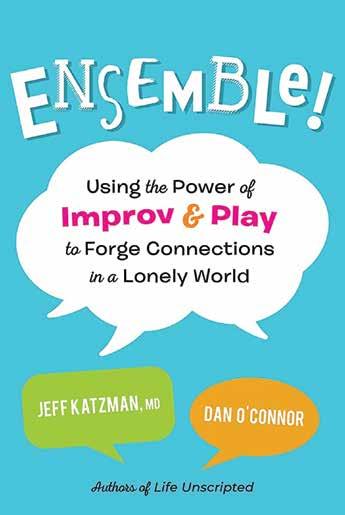
The Crazy Wisdom Community Journal • May through August 2023 • Page 97
Book Review
The Crazy Wisdom Calendar
May through August 2023


Buddhism, continued
Five-Day Spring Retreat (Yongmaeng Jeongjin) with Ann Arbor Zen Buddhist Temple • Thursday, April 5 through Saturday, April 9 • Begins at 7:00 p.m. through 10:00 a.m. Saturday morning • Conducted by Ven. Haju Sunim, spiritual director of the Buddhist Society of Compassionate Wisdom. This retreat is an intensive period of Zen practice geared toward the experienced student. Partial attendance can be arranged. Cost is $60/day, $50/day for members. For more information call Zen Buddhist Temple at (734) 761-6520 or email annarborzentemple@gmail.com.
All is Empty with Guy Newland • Saturday, June 10 • 10 a.m. to 1:00 p.m. • Professor Newland will provide an introduction and explanation of what “emptiness” does (and doesn’t) mean in the Dalai Lama’s system of Tibetan Buddhism. He will explore such questions as why does anything matter if it’s all empty? How can empty things work? How can empty persons do anything and why should they? And how does an understanding of emptiness affect our way of life? $75 Jewel Heart members / $90 Non-members. Pay what you can—no one turned away. To register, or for more information visit the Jewel Heart-Ann Arbor website, jewelheart.org/chapters/ann-arbor, call Jewel Heart at (734) 994-3387, or send an email to programs@jewelheart.org.
Mindfulness & Self-Compassion with Anthony King • Wednesday, June 7, 14, 21 • 7 to 9:00 p.m. • Online only • In the context of the Buddhist spiritual path, meditation practice is ultimately for the purpose to bring the practitioner closer to spiritual enlightenment. On a practical, secular level, meditation can also have benefits. This three-week experiential class will explore the relationships between traditional Buddhist and “therapeutic” meditation programs (e.g., mindfulness and compassion) and provide an accurate and contemporary discussion of the psychology and neuroscience underlying these programs, based on rigorous scientific evidence. $60 Jewel Heart members / $80 Non-members. Pay what you can—no one turned away. For more information, visit the Jewel Heart website at jewelheart.org, call (734) 9943387, or send an email message to programs@jewelheart.org.
Liberation of Life Service at the Ann Arbor Zen Buddhist Temple • June 18 • 10:00 a.m.
• In keeping with the Buddhist Precept “Do not harm, but cherish all life”, the Liberation of Life Ceremony celebrates non-human species by releasing beings held in captivity and/or destined for slaughter. FREE. For more information call Zen Buddhist Temple at (734) 761-6520 or email annarborzentemple@gmail.com.
Ullambana Day Service with Ann Arbor Zen Buddhist Temple • Wednesday, August 30 • 11:30 a.m.
• Rites and service for the dead to wish them a rightful place among the living and release from suffering in their next rebirth. Prior consultation appointment necessary. FREE. For more information call Zen Buddhist Temple at (734) 761-6520 or email annarborzentemple@gmail.com.
Sunday Services at the Ann Arbor Zen Buddhist Temple • Ongoing • 10 to 11:30 a.m.
• Morning meditation service consists of two periods of meditation followed by chanting and a talk. Afternoon dharma service has two shorter periods of sitting meditation, sometimes walking meditation, reflection, chanting, and a short talk. By donation. For more information call Zen Buddhist Temple at (734) 761-6520 or email annarborzentemple@gmail.com.
Temple Stay/ Visitor’s Program and Residential Opportunities with Ann Arbor Zen Buddhist Temple • Ongoing • The Visitor’s Program is for people who want to spend some time living in a Buddhist community. They follow the daily schedule and participate in programs such as retreats, study groups, public services, and yoga classes as their schedules permit. One can seriously pursue one’s spiritual path or simply seek peace and harmony in a wholesome environment. Prior arrangement with the Temple Director is necessary. The program is usually available throughout the year. For more information call Zen Buddhist Temple at (734) 761-6520 or email annarborzentemple@gmail.com.
Ceremonies, Celebrations, and Rituals
Entering the Healing Ground: The Sacred Work of Grief with Kirsten Mowrey • Saturday, August 26 • 10 a.m. to 4:00 p.m. • Grief finds its way into all our lives through losses great and small. Recent years have given us little time to mourn. Losses, both personal and planetary, batter us daily until our hearts and souls become weary and overburdened. This day-long gathering invites us to share in a time of honoring the losses we hold in our hearts. We will come together and turn our attention to the grief we carry—for ourselves, the loss of those we love, the wider community and our struggling world. This gesture brings us into the circle of restoration and into the arms of our human and more-than-human community. Grieving together, we reconnect with the practices of our ancestors, building a temporary village that can hold our grief and loss in human communion. Sliding scale $40-$60. For more information contact Kirsten Mowrey at greatlakesrituals@gmail.com.
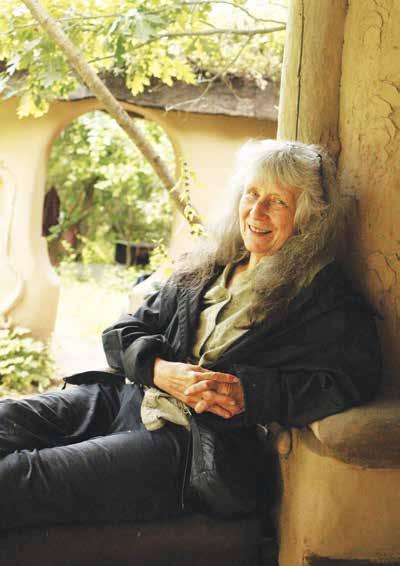
Deanne Bednar has been sharing natural building skills since taking her first course with the Cob Cottage Company in 1996 (after retiring from teaching middle school art & sustainable futures) and since then has overseen many interns and volunteers on various projects. From 2003 to the present, she has coordinated and taught at the Strawbale Studio, was part of the teaching team for the Natural Cottage Project which provides two week start-to-finish building workshops, and has been a co-teacher for ten day workshops with the Cob Cottage Company. Bednar has illustrated several books on natural building, including The Hand-Sculpted House, The Natural Plaster Book, and The Cobber’s Companion. She loves to forage for materials and co-create things. For more information check out her listings in the calendar under Art & Craft or visit strawbalestudio.org.
Channeling
Evenings with Aaron channeled by Barbara Brodsky • May 17 • 7 to 9:00 p.m • Evenings with Aaron meets once a month. All are welcome. Aaron will often address a present world issue and how we can best support the resolution of this issue from a place of loving awareness. He reminds us that whatever appears in our lives comes as a teacher. We are here to learn and practice dynamic compassion, that is, to actively live in the world while always connected to our spiritual centers. Suggested donation $10-$30. For more information email om@deepspring.org, call (734) 477-5848, or visit deepspring.org.
The Crazy Wisdom Community Journal • May through August 2023 • Page 98
Remembering Wholeness - Darshan with The Mother • May 14 • 2 to 5:00 p.m. • A mother is one who gives birth to, supports, and cherishes, and then releases out into the universe, with love, always ready to hold and support. Zoom allows everyone to hear my words. I speak to individuals, often what I say is applicable to many in the group. I will be offering from my own understanding the personal and the group messages that can most support the program participants. Suggested donation $10-$30. For more information email om@ deepspring.org, call (734) 477-5848, or visit deepspring.org.
Childbirth
Six-Week Childbirth Series with Cynthia Gabriel and Toni Auker • May 2 through June 6 • 5:30 to 8:00 p.m. • This class aims to prepare you for your best birth. We will cover topics including stages of labor, communicating with providers, informed decision making, coping techniques, and postpartum. $350.00. For more information email Hello@nestandnurture.org or visit nestandnurture.org.
Doulas’ Night Out • Friday, May 26, June 23, July 28, and August 25 • 7 to 9:00 p.m. • All Doulas and Birthworkers are invited to join us for a fun night of connection, support, and fun. Speakers and activities will vary each month. We do ask that you RSVP by emailing Hello@NestandNurture.org. FREE-$10. Presenters will be determined closer to the event, but in the past, they have included a chiropractor, pelvic floor therapist, and acupuncturist. For more information email Hello@nestandnurture.org or visit nestandnurture.org.
One Day Prenatal Bodyfeeding Class with Erica McLeod • May 28, June 24 • 2 to 4:30 p.m. • This 2.5-hour comprehensive class enables us to take time to answer all your feeding questions, and concerns. We will cover information beginning with the prenatal period to feeding in the early weeks. ASL and Queer affirming. This class will be taught at Nest & Nurture. Private classes are also available in person and virtually. $100. For more information contact EricaMcleod@gmail.com.
Family Pride Party with Nest & Nurture • June 4 • Noon to 4:00 p.m. • Nest & Nurture celebrates ALL families. Come celebrate Pride month us. We will have music, crafts, storytime, and more. FREE. For more information email Hello@ nestandnurture.org or visit nestandnurture.org.
Newborn Care with Toni Auker • Saturday, June 17 • 10 a.m. to 1:00 p.m. • In this class we will answer all of your questions about bringing home a newborn. We will talk about how to soothe a crying newborn, bathing, different diapering choices, babywearing, car seat safety, safe sleep, and much more. We will give you several different tools and techniques for each topic and discuss the wide range in normal when it comes to newborns. This class is ideal for expectant parents as well as adoptive and fostering parents. Private classes are also available. $100. For more information email Hello@nestandnurture.org or visit nestandnurture.org.
Children and Young Adults
Happy Signing Time with Sonya Carter • May 10 and May 24 • 10 to 11:00 a.m. • Join us as Sonya teaches us to use our hands to sing with babies and toddlers. Whether you are fluent in sign language or curious to learn, this will be a fun bi-weekly class. $15 drop-in or 6 classes for $60. For more information email Hello@nestandnurture.org or visit nestandnurture.org.
H2W2 - K4K - Happy, Healthy, Wealthy, Wise - Kabbalah for Kids (5th grade & up) with Karen Greenberg • Sunday, May 21, June 25, July 23, August 20 & continues to meet monthly • 1 to 3:00 p.m • Utilizing movement, multisensory input, color, and experiential learning, we build self-esteem of spiritually evolved children (not reinforce feelings of being different, damaged, defective, disordered, dysfunctional). In an ascensional journey through the Tree of Life, we aid in organizational skills, navigating low-vibrational emotions, relationships, setting healthy boundaries. We encourage children in discovering and fostering their authentic selves’ genius, to fulfill their spiritual mission of a healthy, interdependent, functional planet for the “1000 Years of Peace” prophecy. $50/ session for 2-hour class. For more information contact Karen Greenberg (734) 417-9511, email krngrnbg@gmail.com, or visit clair-ascension.com.
Camp Jump-In 2023 Intensive Therapy Camp with Jacquelin Kilburn • July 17 through 28 • 9 a.m. to Noon • Therapy camp benefits children with sensory processing difficulties, learning problems, apraxia, in-coordination, low muscle tone, auditory processing dysfunction, and other neurological delays or disorders. We use the “Frequency, Intensity, Duration Model” which has been proven highly effective at making large gains in a small amount of time. We require one parent or caregiver for each camper, because the camp becomes a parent training, networking, and support system. We can accommodate eight campers. All camp activities are held outdoors, weather permitting. Activities involve the use of suspended equipment, gross motor activities, fine motor activities, social interaction, brain gym, language, body work, and pool time. Campers new to Jump-In need an evaluation prior to camp. Due to the intensity level, campers must be at least four years old. Program may be covered by health insurance. For more information call (810) 231-9042 or email Info@ jumpinot.com.
Summer Peace Camp with Ann Arbor Zen Buddhist Temple • Friday, July 28 through Friday, August 4 • Tent camping for families and children of all ages, by the lake and in the forest, close to Ann Arbor. Peace camp programs

Crazy Wisdom Kids
An ongoing section of The Crazy Wisdom Community Journal
Articles, calendar listings, advertisements, music and book reviews, and other features that focus on raising conscious and spirited kids.
If you like our CW Kids section, and would like to contribute to it, contact jennifer@crazywisdom.net.

We welcome story ideas, illustrations, feature writing, and photographs.
focus on learning about peace and happiness from the Buddhist perspective of the interrelationship of all things. Activities emphasize fun, mindfulness, cooperation, and appreciation for animals and plants while seeking to balance structure and spontaneity. For more information call Zen Buddhist Temple at (734) 761-6520 or email annarborzentemple@gmail.com.
Parenting, Teaching, Coaching, and Working with Indigos with Karen Greenberg • Sunday, August 27 • 9 a.m. to Noon • Your Indigo child is a genius! What worked with earlier generations, simply doesn’t work and can even be counterproductive and self-defeating. Indigos, parents, teachers, coaches, employers, and employees: learn how to discover, understand, encourage, support, nurture this genius, novel patterns of bonding, how emotional needs differ from those born previously, mate agreements, social difficulties, organization, hyperactivity, and alternative strategies to drugs, how Indigos learn differently, and mirror unresolved family issues (private individual/family sessions available, too). $77. For more information contact Karen Greenberg (734) 417-9511, email krngrnbg@gmail.com, or visit clair-ascension.com.
The Crazy Wisdom Community Journal • May through August 2023 • Page 99
Keep your face always toward the sunshine, and shadows will fall behind you."
— Walt Whitman
C h e r r y W i n e

CBD flower

Feel relaxed, euphoric & focused without intoxication.

“Tarot.” For more information visit EvenstarsChalice.com/Happenings or email
Mara at mara@evenstarschalice.com.
Art on the Grand • June 3 & 4 • Saturday 10 a.m. to 7:00 p.m., Sunday 11 a.m. to 5:00 p.m • Art on the Grand takes place along Grand River Avenue in historic downtown Farmington, between Farmington Road and Grove Street. The fair features FREE admission and an array of high-quality art in a variety of price ranges and disciplines including ceramics, jewelry, painting, photography, wood, wearable art, glass, leather, and sculpture. For more information visit artonthegrand.com.
21st Annual Michigan Lavender Festival • Friday through Sunday, June 23 through June 25 • It’s the most fragrant and relaxing event of the season! The Lavender Festival will showcase Michigan’s top lavender farms, growers, and producers along with more than 200 Artists and Makers. Our festival also features a food truck gathering with Metro-Detroit’s best food trucks, and guests will be able to learn about the many benefits of lavender, including growing, harvesting, cooking, crafting, along with medicinal and aromatic uses for this beloved herb. A variety of lavender themed classes, artist workshops and demonstrations offer a hands-on learning experience. Learn more at themichiganlavenderfestival.com.
Saline Celtic Festival • Friday and Saturday, July 7 & 8 • Join us for our festival! We’ve relocated to the Washtenaw Farm Council Grounds just north of Saline at 5055 Ann Arbor Saline Road. Celebrate your Celtic heritage with Highland dance competitions, Ancient Athletics competitions, merchants, workshops, and more! Magical fun for the whole family. For more information
We are a regenerative farm dedicated to responsibly producing great CBD

Death and Dying
Death Café via Zoom with Rev. Annie Kopko • First Tuesday of the month • 6:30 p.m. to 8:00 p.m. • Open discussion of death and dying. FREE, but donations gratefully accepted. For more information visit interfaithspirit.org.
End-of-Life Doula Training with Patty Brennan • Saturday and Sunday, May 20 & 21 OR July 29 & 30 • 10 a.m. to 4:00 p.m. • Online professional training with Patty Brennan to become a certified end-of-life doula (EOLD) through Lifespan Doulas. Hybrid program includes 50 hours of self-paced study plus a live, interactive workshop on Zoom. Course prepares you to support family and friends on their final journey, seek employment as an EOLD, enhance your support efforts as a hospice volunteer, or open an income-generating community-based doula practice. Explore creative ways to blend the doula model of care with your unique experience, gifts, and passion. $697.00. For more information contact Patty Brennan at (734) 663 -1523, email patty@ lifespandoulas.com, or visit lifespandoulas.com/end-of-life-doula-training.
Energy and Healing
Wild Goose Qigong with Master Wasentha Young • May 2 through July 28 • Tuesday, 6 to 7:00 p.m. and/or Thursday, 10 to 11:00 a.m. • The Wild Goose Form is a series of ongoing movement – a reverent dance that embodies the multidimensional aspect of Chi. The movements include imagery, stretching, acupoint contact, and a connection with universe, nature, and earth energies. The Peaceful Dragon School is down one flight of stairs. In-person (limit 10) and/or Zoom. $195. For more information email info@peacefuldragonschool. com, call (734) 741-0695 or visit peacefuldragonschool.com.
Weekly Word for Healing & Ascension with Eve Wilson, UCM Master Healer • Friday • What’s new in personal and planetary healing and ascension, support for your journey including practical and spiritual tools, insights, visions, and finding hope, trust, and joy through the process. This international awardwinning blog is cutting edge and timely. Eve Wilson is a leader in World Healing and Ascension. FREE. Visit spiritualhealers.com to sign up for weekly links.
Festivals and Fairs
Community Chalice with Evenstar’s Chalice • May 21, June 24, July 30, August 26 • Noon to 5:00 p.m.
• “Community Chalice” is a monthly gathering where we learn, play, do ceremony, and grow together in community! Each month will have a theme. May’s theme is “Allied Pride!”, June’s theme is “Keep it Light!’, July’s theme is “Plant Magic / Plant Medicine” and August’s theme is
Holistic, Metaphysical & Spiritual Fair with Unity of Bay City • Friday and Join Unity of Bay City for a weekend of holistic, metaphysical, and spiritual practitioners, readers, speakers, vendors, artists, and musicians as we come together to offer wellness services, products, performances, education, and experiences to the community so that you can learn how to care for yourself and your loved ones in alternative healing ways and have fun doing it! Presenters and speakers include healing touch, organic composting, assisted yoga, drumming circle, a children’s area, and so much more! Entrance fee is $5.00, $2 for kids 12 and up, children 12 and under are FREE. For more information contact Tammy Monroe at (989) 686-0265, or email unityhearthub@gmail.com, or visit shorturl.at/qMSU8.
Holler Fest with the King Family at Frog Holler Farm • Friday, August 25
• Begins Friday at 2:00 p.m. through 8:00 p.m. A family-friendly farm festival featuring over 60 top local music artists on four stages with guided nature walks, yoga and movement workshops, local food vendors, and kid’s activities throughout the weekend. FREE camping. Check hollerfest.com for when tickets go on sale. For more information follow Holler Fest on Facebook and Instagram or email kings@hollerfest.com.
Healing
Scar Release with Gail Castle LMT, BCTMB • Wednesday, May 10, June 14, July 12, or August 9 • 1:30 to 4:30 p.m. or 6 to 9:00 p.m. • Release of old scars can feel like a new lease on life. This educational and experiential class is valuable for the health pro and public. Benefit from working with scars over 6 months old: Reduce pain, stiffness, and fatigue. Improve circulation and sensation. Prevent new injuries/problems, be less affected by weather changes, feel better as old anesthesia is released... The list goes on! $50/per person. For more information visit atransformationstation.net.

Holistic Health

PTSD in Modern Society with Conrad Joseph Welding Jr. • Wednesday, June 14, 21 • 6 to 8:00 p.m. • Explore the gap between the real-world presentation of anxiety disorders and post-traumatic stress disorder (PTSD). Explore research into this area, the options and hope to individuals suffering from posttraumatic symptoms and increased societal awareness. $99 For more information visit wccnet.edu/noncredit or call (734) 677-5060.
Holistic Health Classes with Beth Barbeau at the Natural Health Expo— Part of the Lavender Festival • Friday, June 23 through Sunday, June 25 • 10 a.m. to 6:00 p.m • Beth is teaching three FREE classes at the Natural Health Expo: Helpful Healthy Herbs for Families, Proactive Pain Relief, and Why Birth Matters to All of Us, Even When We Aren’t Having Babies. See event website themichiganlavenderfestival.com for descriptions and schedule. Lavender Festival admission $8, under 12 FREE. For more information visit wearebloomingwell.com or email Beth@IndigoForest.com.
Intuitive and Psychic Development
Focused Mind Meditation – Teleconference with John Friedlander • Sunday, May 7, June 4, July 2, August 6 • 9 a.m. to Noon • Development of sustained focused meditation makes it easy to develop a whole new magnitude of psychic skill and healing ability, as well as a whole new level of mental clarity and spiritual openness. See website for phone and payment information. $15. For more information contact Violeta Viviano at (734) 476-1513 or visit psychicpsychology.org.
The Crazy Wisdom Community Journal • May through August 2023 • Page 100
s h o p & l e a r n m o r e p o t t f a r m s . c o m
The Practice Beneath the Practice
S
By Kelly Kempter
My bodywork practice synthesizing Shiatsu and Thai massage serves as a physical manifestation of a deeper spiritual practice. Both Thai massage and Shiatsu are rooted in Buddhist traditions, and I feel honored and enlivened to be a part of these pathways in the modern world. The principles of Insight Meditation offer guidance for my bodywork sessions, allowing a somatization of the path.
In my mat-based bodywork practice, I utilize a mapping of the body-mindheart founded in Shiatsu and Five Element Theory and apply methods from both Shiatsu and Thai massage. I studied Thai massage twenty years ago at the beginning of my massage therapy training and fell in love with the approach; performing Thai massage on a clothed recipient on a floor mat feels like a beautiful duet of healing touch, a slow, meditative dance akin to Tai Chi. The choreography of it, if you will, awakens a sense of being fully embodied in the practice of touch.
I am listening with my whole being to another person’s pain and honoring the life force within which is healthy and whole.
Some years later, when I began studying Five Element Shiatsu as taught by Frances Farmer, I was able to connect with a foundational theory that makes my heart sing and reminds me of deeper truths. Utilizing presence, reverence, and full body engagement along with a growing understanding of Five Element Theory and being in tune with nature (with the seasons and tides in our bodies) the stage is set for healing--I’m all in. I am listening with my whole being to another person’s pain and honoring the life force within which is healthy and whole. Frances Farmer observes, “Your body has the inner wisdom to heal itself, and I am here to listen and learn.”

Both Thai massage and Shiatsu are mat-based therapies founded on a premise of oneness and that the giver is healed as much as the receiver. The therapist opens their senses to what is present and holds it in a loving light. Holding is the essence of what I do. I hold tissue with my body weight. I hold points with my fingers, knees, elbows, or toes. I hold words. I hold the pain of embodiment. I hold emotions, sensations, and thoughts. I stay with what arises, watch transformation occur, and remain curious. In the simplest way, I am listening, witnessing, feeling, and accepting while holding the physical form.
My spiritual journey is the foundation of this incarnation; it is the ground I stand on and guides all aspects of my life. For me, it is easy to see how it is the very bedrock of a practice that involves touch and healing. Although, I do not limit my spirituality to a single tradition; it is a living practice steeped in Insight Meditation. Also called Vipassana, Insight Meditation is one aspect of Theravada Buddhism, which is practiced in Thailand. The teachings urge us to sit in meditation, study the Dharma, move with awareness, cultivate Sangha, pay attention to the stillness, speak with kindness, walk in silence, and watch what arises. The idea is to honor whatever is present, inviting all of it in for a cup of tea—the old wounds, fear and grief, the harmonious heart, mundane plans, rehearsals spawned by anxiety, inner peace, replaying of scenes laced with shame, the exalted states, and everything in between. Returning to this moment over and over again, in a spiraling dance of unfolding, we come closer and closer to home. When we sit with our resistance, its grip loosens, and we are brought back to wholeness.
Vipassana practice, Thai massage, and Shiatsu are all founded upon a cosmology of non-duality. They are based on the radical premise that there is nothing wrong, nothing to be fixed, that we are already healthy, vibrant, and whole--that our true nature is one of peaceful aliveness. We can only gain access to this wisdom in the present moment. Since the body is always
in the present moment, it makes for an easy entry point into both healing and spiritual inquiry. Connected to our wholeness, we observe ties to the natural world; we begin to see that we are not separate from nature, but a manifestation of its elements. Awareness of sensations in our bodies brings us closer to our elemental nature and invites its own sort of healing.
My bodywork practice is a somatic exploration of Insight Meditation. In both practices, upon first glance, there is chaos. There are complaints. There is pain. There is dissatisfaction. When a client walks into the room, they give name to the details of their suffering. Similarly, when we sit down to meditate, our patterns of suffering become apparent. When we touch or are touched with care and attention, the resistance begins to melt. When we stay with sensations, mindfulness creates an opening in which suffering can transform. Over time, the consciousness of what is happening becomes larger and more powerful than the details of our pain. As my Thai massage teacher, Paul Fowler wrote, “In the Thai way of thinking, illness and disease are a natural part of life and although it recognizes that the body is out of balance when these things occur and need to be corrected, there is less tension around illness and disease because they recognize that these things are natural and impermanent.”
There is literally nothing that needs doing, fixing, changing, or even healing. Our wholeness and vibrancy is already present, it is the essence of us.
For me, both meditation sessions and bodywork sessions integrate a ritualistic start and finish. When a person walks through my door, utilizing Buddhist principles around compassion and sympathetic joy, I open myself to be a kind witness, one who accepts whatever is going on, hearing the details and honoring the suffering. Taking in the fullness of a human being, perhaps I am able to discern which elemental phases are speaking the loudest and what parts of a human are in need of nurturing. Moving over to the mat, the process of setting up the body of both giver and receiver in a relaxed alignment contributes to concentration and enhances energy flow through the system. This is true as well for tending to our posture when we sit in meditation. This pre-session care creates a sacred space and a kind of healing cocoon. With the first touch, I am reminded of my Vipassana teacher, Susan Weir’s words, “Let awareness do the heavy lifting.” I feel deeply into the very essence of a person, beyond the complaints that they walked in with, beyond their name and the person they experience themself to be. I too walk beyond myself as a massage therapist working on tissues. I open my awareness to our joined life force. I listen with an intimacy that unites two beings via a shared experience. There is nothing to do but be present while connecting with a solid, relaxed pressure. There is literally nothing that needs doing, fixing, changing, or even healing. Our wholeness and vibrancy is already present, it is the essence of us. With a courageous presence, when we are able to pull back from doing and engage in the art of non-doing, we connect with a force that is always in a state of balance. This is coming home.
The Crazy Wisdom Community Journal • May through August 2023 • Page 101
Kelly Kempter is a licensed massage therapist specializing in Thai Massage and Shiatsu in her Kerrytown studio. She seeks to inspire balance in the community through the practice and teaching of bodywork. Visit her online at kaizenhealingarts.com .
The Crazy Wisdom Calendar
May through August 2023
Psychic Psychology Women’s Group - Teleconference with John Friedlander
• Thursday and Friday, July 20 and 21 • 7 to 9:00 p.m. • Saturday and Sunday July 22 and 23 • 10 a.m. to Noon and 2 to 4:00 p.m. • New material introduced with continued development of advanced and core techniques seeking a natural sense of skills in practical everyday life. Prerequisite: Level 1 Psychic Developmnet class, CD set, or permission of instructor. $275. For more information contact Gilbert Choudury at gchoud@yahoo.com or visit psychicpsychology.org.
Kabbalah


Brand New Beginning Kabbalah: Kabbalah Miracles with Karen Greenberg • Tuesday, May 2, June 6, July 11, August 8 • 9:15 a.m. to 11:15 a.m. OR 7 to 9:00 p.m. • This life-changing journey is an ordered, systematic approach to develop and balance all the important areas of life. Rather than utilizing energy resisting (exercise, meditation, sleep, eating and/or drinking healthily), we utilize that liberated energy for creating, on a similar vibration as our Creator. We become empowered to develop ten G-D like traits, join with G-D, and become co-creative, proactive manifesters of our dreams, desires, and goals, open to miracles, and fulfilling our purpose/destiny. Monthly Course Rate - $150/person; Monthly SemiPrivate (2 people) Rate - $180/person; Monthly Private (1 person) Rate - $150/ hour (based on time utilized). For more information contact Karen Greenberg (734) 417-9511, email krngrnbg@gmail.com, or visit clair-ascension.com.
Love and Relationships
Kabbalah for Couples with Karen Greenberg
• Sunday, May 21, June 25, July 23, August 20 & continues to meet monthly • 3 to 5:00 p.m. • Has social distancing amplified distance between you and your partner? K4C is for good relationships that both parties are willing to work on to make their relationship even better, physically, emotionally, mentally, financially, spiritually, and energetically. This two-hour session (not one hour), once a month, for about a year, is not couples therapy; it can help you get your relationship to the place that you always wanted it to be but did not know how. $274 for 2-hour session. For more information contact Karen Greenberg (734) 417-9511, email krngrnbg@gmail.com, or visit clair-ascension.com.
Creating Your Ideal Mate with Karen Greenberg • Sunday May 7 • Noon to 5 p.m. • Identify your Ideal Mate’s qualities (as I did so to manifest my mate of over two decades), learning how to use ceremony, meditation, chanting, movement, fragrances, essences, elixirs, herbs, flowers, colors, shapes, metals, altars with sacred symbols, Archetypal images, and candles. Learn to work to remove blockages, to work through fears, and “not deserving” issues, and to trust the Divine Order and Timing! $150. For more information contact Karen Greenberg (734) 417-9511, email krngrnbg@gmail.com, or visit clair-ascension.com.
Massage
FREE Massage Class with Irene’s Myomassology Institute • Saturday, June 9 • 7 to 9:00 p.m. • You can relax and have some fun at Irene’s FREE massage class! This is an excellent opportunity for those interested in massage as a hobby or an introduction to massage as a career possibility. If you’ve never given a massage before, this is a great chance to explore the benefits of healthy touch. For more information call (248) 350-1400 or visit irenes.edu.
Infant Massage with Irene’s Myomassology Institute • Saturday, August 26 • 9 a.m. to 1:00 p.m. • Students are taught how infant massage can enhance development and well-being of babies. Techniques included are for infants up to one year old. Students are asked to have a friend or family member bring a baby to class. If a student wants to work with their own baby, another care-giver will need to bring the infant to class. You will also need a sheet, doll or stuffed animal large enough to practice techniques. $88. For more information call (248) 350-1400 or visit irenes.edu.
Carol Blotter has led more than 75 retreats across the United States and taught over 85 classes in meditation to spiritual seekers, schools, universities and medical groups over the last 20 years. Her 25+ years of practice and study has led to a blending of Insight (Vipassana) Meditation and non-dual teachings from various spiritual traditions. She is the primary teacher of Chelsea Meditation Group. Currently, her personal practice is rooted in self-retreats and work with a variety of teachers.
Carol has also been involved with the Quaker tradition since 1979. She has taught about some of the mystics influencing Quakerism as well as ways to resolve conflict through building unity and deep listening practices. Learn more at ChelseaMeditation.com.

Meditation
Meditation Class with Ann Arbor Zen Buddhist Temple • Thursdays, April 27 through May 25 • 6:30 to 8:30 p.m. • The viewpoint of Zen is that life lived fully in each moment is the end and purpose in itself, and not the means for something else. Held in the Temple’s meditation hall, the course includes simple stretching exercises, work with the breath, meditation postures, concentration, and mindfulness practice. Cost is $160/$120 unwaged. For more information call (734) 761-6520, visit zenbuddhisttemple.org or email annarborzentemple@gmail.com.
Healing and Compassion Meditations with Hartmut Sagolla • Mondays, May 1, 8, 15, 22, June 5, 12, 19, 26, July 10 and 17, August 7, 14, 21, 28 • Online only • Noon to 1:00 p.m. • Hartmut Sagolla leads a 30–40-minute guided meditation on a Buddhist theme followed by discussion. Meditations are centered around healing oneself and others and developing compassion. They include concentrated meditation, visualization, and contemplative meditations. FREE / Donations welcome. To register, or for more information visit the Jewel Heart-Ann Arbor website, jewelheart.org/chapters/ann-arbor, call Jewel Heart at (734) 994-3387, or send an email to programs@jewelheart.org.
The Crazy Wisdom Community Journal • May through August 2023 • Page 102
On May 1, 2023, The Crazy Wisdom Community Journal will be availble on our website: crazywisdomjournal.com.
FREE open meditation with Jewel Heart Instructors • Thursday, May 4, 11,18, June 1, 8, 15, 22, 29, July 6, 13, 20, August 3, 10, 17, 24, 31 • On-site only 6 to 6:45 p.m. • Facilitators offer lightly guided concentration meditation sessions for all levels of experience. FREE / Donations welcome. To register, or for more information visit the Jewel Heart-Ann Arbor website, jewelheart.org/chapters/ann-arbor, call Jewel Heart at (734) 994-3387, or send an email to programs@jewelheart.org.
World Labyrinth Day - Labyrinth Walk with Rob Meyer-Kukan • Saturday, May 6 • 1:00 p.m. • Join Veriditas Certified Labyrinth Facilitator, Rob MeyerKukan at Webster United Church of Christ, Dexter, Michigan for a labyrinth walk on World Labyrinth Day! This event is offered as a donation-based event to support programs at the Labyrinth. Parking for this event can be found along Farrell Road or near to the barn. Once parked, follow the signs to the labyrinth. Please register for this event at https://forms.gle/DtGXdH2yrHeTr4hdA Donation based. For more information call Rob Meyer-Kukan, at (248) 9625475, email rob@robmeyerkukan.com, or visit 7notesnaturalhealth.com.
White Tara Guided Healing Meditation with Jewel Heart Instructors • Sunday, May 7, 14, 21, 28, June 4, 11, 18,25, July 2, 9, 16, 23, August 6, 13, 20, 27 • No event on July 30 • Online and on-site • 9:30 to10:35 a.m.
• Tara is the mother goddess of Tibetan Buddhism, known for her quick and compassionate activity. White Tara is particularly associated with healing and long life. These guided meditations use visualization techniques to overcome physical, mental, and emotional suffering. FREE / Donations welcome. To register, or for more information visit the Jewel Heart-Ann Arbor website, jewelheart.org/chapters/ann-arbor, call Jewel Heart at (734) 994-3387, or send an email to programs@jewelheart.org.
A Day of Mindfulness Meditation with Esther Kennedy, OP • Saturday, May 13, June 10, July 15 • 10 am to 2:30 p.m. • Meditation has a way of going to the heart of who you are, the choices you make, and the way you live. The heart of meditation is awareness of and staying with whatever rises. We just stay. We just breathe. As the mind begins to ease, a taste of compassion rises. $35, lunch included. For more information call the Weber Center at (517) 266-4000 or visit webercenter.org.
Sound and Art with Rob Meyer-Kukan • Saturday, May 13 • 7 to 8:30 p.m • Come and join Whitepine Studios and Ann Arbor’s 7 Notes Natural Health, for our sixth collaboration as we listen to the melodic sounds of the singing bowls while painting a beautiful monarch butterfly using watercolors. Monarch butterflies are symbols of change, transformation, and hope. $40. For more information call Rob Meyer-Kukan, at (248) 962-5475, email rob@ robmeyerkukan.com, or visit 7notesnaturalhealth.com.
Fundamentals of Insight Meditation with Insight Meditation Ann Arbor •
Tuesday • May 16 through June 20 • 6:30 to 8:30 p.m. • A six-week long class that will cover concentration meditation and insight meditation instructions, mindfulness, working with difficult emotions and mental processes, and how to establish and continue with an on-going practice. For those new to meditation or looking for a refresher on the fundamentals of insight practice; suitable for all levels of experience with meditation. $125.00 For more information and to register visit insightmeditationannarbor.org/meditation-classes.
Peace Generator via Zoom with Interfaith Center for Spiritual Growth • Friday, May 19, June 16, July 21, August 18 • 7 to 9:00 p.m. • Manifest peace for the planet. FREE, but donations gratefully accepted. For more information visit interfaithspirit.org.

Day of Meditation with Carol Blotter • Friday, June 9 • 9 a.m. to 4:00 p.m. • Meditation practice of sitting and walking plus a short talk. Find peace and calm in the quiet wooded space of Michigan Friends Center in Chelsea Donation only, suggested is $30-$60. For more information email manager@mfcenter.org.

Cacao + Sound with Rob Meyer-Kukan • Saturday, June 11 • 7 to 9:00 p.m. • Join Rob Meyer-Kukan of 7 Notes Natural Health and Alicia Clark-Teper of Sacred Lotus Experience at 7 Notes Natural Health for a heart opening cacao ceremony supported by sacred sound. Using ceremonial grade cacao, pure intention, over 40 different instruments (singing bowls, gongs, therapeutic harp, shruti box, and more), Alicia and Rob will create an experience that will immerse you in peace and tranquility. $50. For more information call Rob Meyer-Kukan, at (248) 962-5475, email rob@robmeyerkukan.com, or visit 7notesnaturalhealth.com.
Solstice Celebration: Labyrinth Walk with Rob Meyer-Kukan • June 17 • 1:00 p.m. • Join Veriditas Certified Labyrinth Facilitator, Rob Meyer-Kukan at Webster United Church of Christ in Dexter for a labyrinth walk to celebrate the Solstice. This event is offered as a donation-based event to support programs at the Labyrinth. Parking for this event can be found along Farrell Road or near to the barn. Once parked, follow the signs to the labyrinth. Pre-registration required. For more information call Rob Meyer-Kukan, at (248) 962-5475, email rob@robmeyerkukan. com, or visit 7notesnaturalhealth.com.
Summer Solstice with Esther Kennedy, OP • Sunday, June 19 • 3:30 p.m. to 4:30 p.m. • Ritual Celebration. FREE. For more information call the Weber Center at (517) 266-4000 or visit webercenter.org.
The Crazy Wisdom Community Journal • May through August 2023 • Page 103
Chris McCall has decades of experience in all aspects of music. She is a singer, songwriter, and has been a vocal coach for over 17 years. McCall has taken students all the way to American Idol Voice. Her unique approach embraces her ability to guide students to find, free, and then to use their voice in all of its depth. Learn more about McCall at her website singannarbor.com. Read Issue #89 of The Crazy Wisdom Biweekly at crazywisdomjournal. com/biweekly-89.
Read the full article about Chris McCall in The Crazy Wisdom Community Journal at crazywisdomjournal. com/featuredstories/2022/4/20/chris-mccallbeyond-the-voice-box.
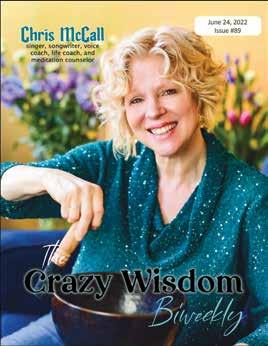
Meditation continued
Myriad of Meditations with Karen Greenberg • Sunday, July 9, 16, 23, 30, August 6, 13, 20 • 10 a.m. to 12:30 p.m. • Seven classes in the series. Meditation is an essential component to spiritual evolution. Learn a myriad of meditation techniques, to discover which resonate for you (possibly dissolving years of resistance to mediation). Learn meditations with fire, water, air, earth, with the Four Worlds, with different breathing, with Holy Geometry, sacred letters, powerful Archetypes, Biblical figures, spiritual beings, higher self, qualities of G-D, with movement, music, toning, colors, scents, gemstones, and trees, including several guided meditations through the Tree of Life. $25 per class. For more information contact Karen Greenberg (734) 417-9511, email krngrnbg@gmail.com, or visit clair-ascension.com.
Meditation Getaway with Rob Meyer-Kukan • Saturday, August 19 • 9 a.m. to 5:00 p.m. • You are invited to join Rob at 7 Notes Natural Health for a chance to get away and meditate. This day long retreat will be your oasis of peace and calm, a chance to connect to nature, to spirit, to your higher self. Walking/ hiking meditation opens our day at one of Ann Arbor’s many local parks. We continue with various forms of meditation, yoga nidra, journal writing, breath work, sound, and aroma experience, and more. Ample time for sharing and reflection will be provided. Registraton required. $125. For more information call Rob Meyer-Kukan, at (248) 962-5475, email rob@robmeyerkukan.com, or visit 7notesnaturalhealth.com.
Weekly Silent Meditation Practice with Celeste Zygmont via Zoom • Sunday, 11 a.m. to Noon • Tuesday, 9 to 9:30 a.m. • We will have a brief period of chanting, then mute ourselves, and begin silent vipassana meditation. After the hour is finished a bell will ring and meditators can go on with their day. There will be time to stay and chat or discuss questions if someone so chooses. Donation. For more information email om@deepspring.org.
Sunday morning meditation with Insight Meditation Ann Arbor • Sunday • 10 to 11:15 a.m • Join us for a silent 45-minute meditation, followed by a talk or sharing. A chance to be in community and practice together. Donations appreciated. For more information visit insightmeditationannarbor.org.
Still Mountain Buddhist Meditation Center Sunday Morning Sitting with Kenneth Morley • Sunday • 10 a.m. to 11:30 a.m. • Our weekly meditation and sharing is open to the public. We will sit in silence for about 45 minutes, take a quick break, and then gather for sharing related to the Dharma. Zoom option is available. FREE. For more information contact Ken Morley at kenwmorley@yahoo.com.
Movement and Dance

First Friday Dances of Universal Peace with Judith L. Trautman • Friday, May 5, June 2, July 7, and August 4 • 6:00 p.m • We meet on Zoom. By donation if in person—we are in transition. People on our list receive updates. To be on the list, or for more information email Judy Lee Trautman at jltrautman@ sbcglobal.net.
Nutrition and Food Medicine
Prime-Time Health Online with Debra Metler, MSW, CHC • Monday, May 1, June 5, July 3, August 7
• Self-directed virtual health science workshops— based on the work by Dr. William Sears, will teach participants the dangers of eating processed foods with toxic ingredients and excess salt and sugar. They will learn how to avoid most diseases and disabilities like cancer, Alzheimer’s, diabetes, arthritis, high blood pressure. Participants will learn which foods can keep you young and which foods can make you old. Workshops can be completed at your own pace. There will be live group Zoom meetings included with coaching. $95. For more information call Debra Metler at (248) 819-2131, email debmetler@gmail.com, or visit sweetalternatives.webs.com.
Music, Sound, and Voice
Sound Bath Meditation with Rob Meyer-Kukan • Friday, May 5, July 14, August 4 • 7 to 8:30 p.m. • Join Rob Meyer-Kukan for this sound bath meditation. In this time of sound bath, Rob will play singing bowls, gongs, and more with the intention of washing you with the sounds that bring calming vibrations to reduce stress and ease tension. Yoga mats and one yoga blanket are provided for each attendee. Please bring any additional supports you would like for your comfort. $40. Registration required. For more information call Rob Meyer-Kukan, at (248) 962-5475, email rob@robmeyerkukan.com, or visit 7notesnaturalhealth.com.
Singing for Comfort, In Person & Zoom Interfaith Center for Spiritual Growth • Thursday, May 11, June 8, July 13, August 10 • 7 to 8:30 p.m. • Singing for comfort FREE, but donations gratefully accepted. For more information visit interfaithspirit.org.
Cafe 704 via Zoom and In-person with Spirit Singing Band • Saturday, May 13 • 7 to 9:00 p.m. • $10/per person. For more information visit interfaithspirit.org.
Client Appreciation Day with Rob Meyer-Kukan • Saturday, May 20 • 1 to 4:00 p.m. • You are invited to a Spring Open House to celebrate you! Tour our offices and group event space (see the spaces you don’t get to see at your regular appointments or events), meet our team, receive a 10% discount on essential oils purchased at the event, enjoy refreshments by local shops, and relax to live music and sound healing by Rob Meyer-Kukan. FREE gift bags to the first 25 participants. Ample FREE parking is available onsite. For more information contact Rob Meyer-Kukan at (248) 962-5475, email rob@ robmeyerkukan.com, or visit 7notesnaturalhealth.com.
Bowls + Harp: Sound Bath Meditation with Rob Meyer-Kukan and Celia van den Bogert • Friday, June 2 • 7 to 8:30 p.m. • Join Rob Meyer-Kukan and Celia van den Bogert for this special event celebrating the sound of harp and bowls. Join us as we celebrate the creative possibilities of this bliss-filled pairing of instruments creating sacred sound that is like no other. Yoga mats and one yoga blanket are provided for each attendee. Please bring any additional supports you would like for your comfort. $50. Registration required. For more information contact Rob Meyer-Kukan at (248) 962-5475, email rob@ robmeyerkukan.com, or visit 7notesnaturalhealth.com.
Folk Song Jam Along with Lori Fithian and Jean Chorazyczewski at Ann Arbor Library Branches • Wednesday, May 3, June 6, July 5, August 1 • 6:00 p.m. • Folk Song Jam Along: Bring your voices and/or acoustic instruments for some all-ages community music-making, just for FUN! Beginners most welcome! Guitar, Ukulele, harmonica, kazoo... even tuba! You pick from 300+ songs, we put lyrics & chords up on a screen. When we say “Folk Songs” - we mean songs by folks! For more information contact Lori Fithian at (734) 426-7818 or email lorifithian@mac.com. Join us on Wednesday, May 3 and July 5—Malletts Creek Branch. Tuesday, June 6 and August 1—Westgate Branch.
Cafe 704 via Zoom and In-person with David Mosher • Saturday, June 10 • 7 to 9 :00 p.m. • $10/per person. For more information visit interfaithspirit.org.
Cafe 704 via Zoom and In-person with Path and Friends • Saturday, July 8 • 7 to 9:00 p.m • $10/per person. For more information visit interfaithspirit.org.
Sound & Vibrational Healing Certification with Bill Gisclair-Sullivan • Saturday, July 15 through Tuesday, July 18 • Saturday, Sunday, and Monday, 10 a.m. to 6:00 p.m., Tuesday, 10 a.m. to 4:30 p.m. • This interactive training is centered around the teaching of Sound Healing & Vibrational Therapies. Our intention for this amazing interactive training is to not only share the theory, science, and practices of Sound Healing, but to give you “hands-on” experience. Level I and Level II are both available at this training. Level I - $795, Level II$795, Levels I & II - $1590. For more information contact Brian Gisclair-Sullivan at meditateyou@gmail.com or visit meditateyou.me.
The Crazy Wisdom Community Journal • May through August 2023 • Page 104
Photo by Hilary Nichols
Parenting
Infant/Pediatric CPR and First Aid with Lorenda Lewis • May 28 • 10 a.m. to 1:00 p.m. • Nest & Nurture is excited to team up with Lorenda Lewis to offer this class, which includes Red Cross Certification for infant/pediatric CPR and First Aid. $120. For more information email hello@nestandnurture.org
Work & Play Hours at Nest & Nurture • May 2, 9, 16, 23, 30, and June 6 • 10 a.m. to Noon OR 1 to 3:00 p.m. • It can be difficult to find a safe place to let our little ones play away from home. We started our play area so our own children could come to work with us. Thanks to some generous donations from community members and The Little Seedling, we now have a beautiful area that is perfect for toddlers and preschoolers. Our space has a variety of seating options, Wi-Fi, and coffee. We will be here working, and we would love to invite you to do the same. $0-10. For more information visit nestandnurture.org.
Personal Growth


Cohousing Tours with Cohousing Residents • Sunday, May 7, 14, 21, 28, June 4, 11, 18, 25, July 2, 9, 16, 23, 30, August 6, 13, 20, 27 • 2 to 4:00 p.m. • Explore Ann Arbor’s intentional communities, Sunward, Great Oak, and Touchstone Cohousing. We are self-governing condo communities built around shared values of connecting, sustainability, and consideration for differences. We are a community of friends who work, share, learn, grow and play together. Our neighborhood is a comfortable space that supports both individual expression and shared experiences. Come find out what it’s all about! For more information call (734) 274-9110, or email Tours@Touchstonecohousing.org.
Finding Your Ground: A Personal Growth Group for Women with Jessica Ryder and Rachel Egherman • Wednesday, July 12, 19, 26 • 6 to 8:00 p.m. • Summer Series Nourishing the physical, emotional, and spiritual roots that allow us to blossom in human form. Join us for guided explorations and practices of deep listening – to ourselves and each other. Seeing beyond the fog of judgement we naturally align more fully with our true nature, finding greater ease of being and the ability to live in heart-centered belonging. $150. Some scholarship support available. Limited to six participants. Open to adults who identify as women, independent of sex assigned at birth. Contact Jessica or Rachel to set up a FREE 20-minute consultation to find out if this is a good fit for you. For more information visit jessicaryder.net, email jessica@jessicaryder. net or visit celebratedheart.com or email tellrachel123@gmail.com.
Reiki
Usui Holy Fire III Reiki I & II Class with Alicia Clark-Teper • April 23 • 10 a.m. to 6:00 p.m. • Learn and become certified in Usui Holy Fire III Reiki I & II in an in-person workshop. Harness the power of healing into your own hands. Reiki is an attunement into your field to activate your own power of healing energy frequency which is often channeled through the hands. Everyone can be attuned and it will never leave you once attuned. You, your family, your pets, your plants and your home and all benefit from Reiki. $299. For more information contact Alicia Clark-Teper at (734) 945-5396, email clarkteper@yahoo.com or visit sacredlotusexperience.com.
People tell you the world looks a certain way. Parents tell you how to think. Schools tell you how to think. TV. Religion. And then at a certain point, if you're lucky, you realize you can make up your own mind. Nobody sets the rules but you. You can design your own life.
— Carrie Ann
accommodations in double rooms with shared bathrooms in cottages, and daily group classes are included. Our retreats work well for solo travelers, women, and men. The Center sits on 110 acres of beautiful non-farming land with a meditation Shrine Trail on it, huge indoor spaces, and a private patio that provide plenty of space for practice, solitude, and safe distancing. Our retreats book fast, reserve your seat early. $559/$529 for early registration. For more information email EmaStefanova@cs.com.
Living From our Unlimited Essence Through Meditation with Barbara Brodsky and John Orr • Saturday June 3 through June 10 • 10:00 a.m • Pure Awareness, and Lovingkindness retreat practice and instruction, on Zoom. The retreat will be held in silence; those joining will maintain that silence from their homes as best they can, around family, necessary work, and other matters. There will be clear instruction in sitting, standing, and walking meditation for beginners and experienced meditators, evening talks, optional discussion periods with the teachers and some chanting from various spiritual traditions. Suggested donation $200 - $800. For more information email om@deepspring. org, call (734) 477-5848, or visit deepspring.org.
Private Directed Retreat with Janene Ternes of Prayer in Motion, LLC • Monday, July 10 through Friday, July 14 • 2:00 p.m. • Experience the serenity and clarity that comes from listening to God’s Spirit within you. This retreat will provide time and space for solitude, personal prayer, quiet reflection and daily spiritual direction. $450.00 for five days, includes private room, meals & daily spiritual direction ($260 Commuter). For more information visit prayer-in-motion. com or email PrayerInMotionLLC@gmail.com.
A Retreat on the Mystics with Thomas Berry and Caryll Houselander • Sunday, July 23 through Wednesday, July 26 • 11 a.m. • The lives and works of two contemporary mystics, Thomas Berry and Caryll Houselander, will be explored and discussed. Commuter $180; Double Occupancy $280 each; Single Occupancy: $380 (meals included). For more information call Weber Center at (517) 266-400 or visit webercenter.org.
Mini Wellness Retreats at The Yoga Room with Christy DeBurton, RYT • Ongoing • When you haven’t got the time (or budget) for a full weekend retreat but just need a little ‘me-time,’ choose from a variety of 3-hour Mini Retreats at The Yoga Room to relax and renew. Watch for details for scheduled mini retreats in newsletter or grab up to three friends and schedule your own bespoke mini retreat! For more information email info@christydeburton.com or visit christydeburton.com.
Shamanism
Introduction to Journeying with Connie Lee Eiland • Sunday, June 4 • 10 a.m. to 4:30 p.m. • Class includes power animal retrieval and journeys to Upper, Lower, and Middle Worlds. Journeying is with drums and rattles. Journeying is also a way to connect with your spiritual teachers and guides to aide you on your path. Establishing relationships with teachers and guides can help in everyday life. $80 until two weeks before, $90 after. For more information call Connie Lee Eiland at (248) 809-3230, email clshebear7@gmail.com, or visit shewolfshaman.com.
Healing with Spiritual Light with Connie Lee Eiland • May 20 & 21 • Saturday 10 a.m. to 6:30 p.m. and Sunday 10 a.m. to 5 p.m • In Healing with Spiritual Light, we become the Light. We transfigure. This class brings in quantum physics as we work with the unlimited powers of the universe. Healing is through the Law of Resonance. This method doesn’t see the client as ill. $200 until May 6, then $230. For more information call Connie Lee Eiland at (248) 809-3230, email clshebear7@gmail.com, or visit shewolfshaman.com.
Extraction: Illness & Healing from a Shamanic Perspective with Judy Liu Ramsey • Saturday and Sunday, June 3 & 4 OR July 15 & 16 • 9 a.m. to 5:00 p.m. • This is an advanced in-person class with a limit of 6 persons. Deepen your understanding of illness and how one’s spirit can help the physical body thrive or not. Explore different ways to “diagnose” an illness as well as to address its healing. Working with partners, deepen your understanding of spiritual intrusions and learn ways to extract them. Prerequisites: Basic Journeying, Medicine For the Earth/Healing With Spiritual Light. Suggested Reading: Walking In Light by Sandra Ingerman. $195 per person/$100 for repeating students. For more information email info@judyramsey.net, or visit JudyRamsey.net.
Shamanism, Death & Dying with Connie Lee Eiland • June 24 & 25 • Saturday 10 a.m. to 6 p.m., Sunday 10 a.m. to 4:00 p.m. • This workshop heightens our spiritual understanding of death and dying and teaches ways to assist others as they approach transition. The class also includes psychopomp, which is crossing lost souls over. Psychopomp is done individually and with the class. $200 until June 10, $230 after. For more information call Connie Lee Eiland at (248) 809-3230, email clshebear7@gmail.com, or visit shewolfshaman.com.
Retreats
Three-Day SW Lake Michigan Holistic Yoga and Meditation Retreat with Ema Stefanova E-RYT500, C-IAYT • Friday 5 p.m. through Sunday 11 a.m. • April 21-23, May 12-14, June 16-18, July 14-16 or 21-23, August 1113 or 25-27 • Our small group retreats are held minutes away from sandy Lake Michigan beaches at the Vivekananda Retreat Center. Vegetarian meals,
Cycles of Life with Connie Lee Eiland • July 15 & 16 • Saturday 10 a.m. to 6:30 p.m. and Sunday 10 a.m. to 4:00 p.m • This class presents pathways to help with you own life explorations. We will work with the Medicine Wheel, the Spirit of the Moon and her cycles, our personal shield, our circle of ancestors. This class includes journeying, healing, divination, and ceremony. Introduction to Journeying is required. For more information call Connie Lee Eiland at (248) 809-3230, email clshebear7@gmail.com, or visit shewolfshaman.com.
The Crazy Wisdom Community Journal • May through August 2023 • Page 105
Moss
The Crazy Wisdom Calendar
May through August 2023
Ancestors & Descendants with Connie Lee Eiland • August 12 & 13 • Saturday 10 a.m. to 6 p.m., Sunday 10 a.m. to 4 p.m. • This class investigates our connections to the ancestors and descendants in ways that impact them and us. This class includes journeys, healing, sacred art--mask making and decorating a staff, and ceremony. Introduction to Journeying and Cycles of Life are prerequisites. $200 until July 22, $230 after. For more information call Connie Lee Eiland at (248) 809-3230, email clshebear7@gmail. com, or visit shewolfshaman.com.
Basic Journeying: The Art of Shamanism for Practical and Visionary Purposes in Daily Life with Judy Liu Ramsey • August 26 & 27 • 9 a.m. to 3:00 p.m. • The shamanic journey is an easy and powerful tool we can use to access spiritual information. Learn techniques to help you develop a selfdirected practice of empowerment, allowing you to move safely, intentionally through the world in a balanced way. Meet a compassionate spirit or power animal who is coming forward to help you at this time in your life. This class is a prerequisite to ongoing and more advanced shamanic studies. The class will be taught online via ZOOM. $150 per person/$75 for repeat students. For more information email info@judyramsey.net or visit JudyRamsey.net.
Journeying Circle with Judy Liu Ramsey • First and Third Thursdays • 7 to 8:30 p.m. • If you know how to do shamanic journeying, please join us to explore the gift and healing of different states of the human condition in a friendly, nurturing, and supportive environment. $25- $40. For more information email info@judyramsey.net or visit JudyRamsey.net.
Spiritual Development


Cultivating Joy with Janene Ternes of Prayer in Motion, LLC • Tuesday, April 25 • 9:30 a.m. to 3:00 p.m. • Do you long for more joy in your life? Joy, or some version of that word, appears in Scripture more than 450 times. Clearly God wants us to have joy in our lives. But how do we experience joy when there is so much sorrow, pain, and hardship? Join me to discover a more joyful spirit, explore the joy that God has for you, and learn everyday practices for nurturing more joy in your life. $60. For more information visit prayer-in-motion.com or email PrayerInMotionLLC@gmail.com.
The Holy Grail: An Initiatory Quest for Divine Gnosis with Rocky Shadow Bear Rains • Fridays, May 5 through June 23 • 6:30 to 9:00 p.m • The Holy Grail; three words that invoke a mystery that has intrigued the hearts and minds of people through the centuries. At the center of the legends and myths is hidden a secret way to Divine Knowledge. In this intensive Mystery School-styled course, the Grail seeker shall move through and experience a series of spiritual initiations which may impart “Divine Gnosis” and a new way of understanding. This Grail Quest is a seven-week initiatory journey. We will step into this journey on the Full Moon of Friday, May 5. On this date, there is a lunar eclipse with the moon being in the sign of Scorpio. Let’s take the plunge into the depths of the Mystery – together. $385. For more information contact Mara Evenstar at evenstar.institute@gmail.com.
Sunday Services via Zoom with Interfaith Center for Spiritual Growth • Sunday, May 7 through August 27 • 10:45 a.m. to 12:15 p.m • Sunday celebration. FREE, but donations gratefully accepted. For more information visit interfaithspirit.org.
Sufi Chanting Meditation and Discussion on Zoom with Interfaith Center for Spiritual Growth • Tuesday, May 2 through August 29 • 7 to 8:00 p.m. • An exploration of Sufism. $5-10 per class. For more information visit interfaithspirit.org.


Connecting with Archangels—Parts 1 – 4 with Karen Greenberg • Sunday, May 7, 14, 21, 28 • 5:30 p.m. to 9:30 p.m. • Become acquainted with the various Archangels represented in the Sephirot (Spheres) in the Tree of Life. Learn who the Archangels are, what they each do, how to create a sacred, protected space, on whom to call for particular assistance, and how to safely call upon them. Connect—Ask Questions—Often Receive Helpful Information and Guidance. $777 total (includes all 4 parts). For more information contact Karen Greenberg (734) 417-9511, email krngrnbg@gmail.com, or visit clair-ascension.com.
Heightening Your Vibration: Alchemy with Karen Greenberg • Sunday, May 21 and 28 • 8:45 a.m. to 12:45 p.m. • Some people have become depressed with the Covid-19 isolation, variants, and aftermath. Learn a myriad of tools and techniques, to change your vibration from a lower to a higher vibration, and to sustain it—including, but not limited to, sacred letters, powerful Archetypes, sacred oils, affirmations, visualization, meditation, prayers that you compose, gratitude, breathing, drumming, movement, music, Holy Geometry, traditions, toning Names of G-D, Archangels, Angels…$200. For more information contact Karen Greenberg (734) 417-9511, email krngrnbg@gmail.com, or visit clairascension.com.
Cultivating a Personal Relationship with G-D with Karen Greenberg • Sunday, May 28 and June 4 • 1 to 4:00 p.m. • Create a Sacred Space, compose/ask questions of your Higher Power, decipher if you are receiving “Yes,” “No,” or “Essay” answers from your spirit vs. thinking in your head vs. emoting or having sensations in your body. Ask G-D how you can serve (learn to trust/surrender to G-D); express gratitude, awe, and be comforted, healed, protected, guided by G-D. Compose prayers, feeling close to G-D, like G-D were a close friend: HE/SHE IS! $90. For more information contact Karen Greenberg (734) 417-9511, email krngrnbg@gmail.com, or visit clair-ascension.com.
Monthly Midrash Study with Karen Greenberg Starts • Sunday, May 28, June 11, July 16, August 13 • May 28 4 to 5:30 p.m., June, July & August dates 3:30 to 5:00 p.m. • The written version of the Old Testament (Torah) tells a story. What has been passed down orally for thousands of years is the backstory and various mystical, hidden meanings. It is rich, colorful, detailed, and compiles interesting data like who ascended to Heaven alive, who was so righteous that their deceased bodies never decomposed, the seven things that we are not permitted to know in human form... $90 per month for the monthly study (one 1½-hour session per month); $90 per month for the bi-monthly study (two 45-minute sessions per month); $90 per month for the weekly study (three ½-hour sessions per month). For more information contact Karen Greenberg (734) 417-9511, email krngrnbg@gmail.com, or visit clair-ascension.com.
Connecting with Various G-D Names/Aspects: Heavenly Travel with Karen Greenberg • Sunday, June 4, 11, 18, 25 • 5 to 9:30 p.m. • Learn how to create a sacred, protected space to astral travel safely to spiritual dimensions, gates of heaven, planets associated with the Sephirot (Spheres) in the Tree of Life, and other celestial bodies and star systems. Become more deeply acquainted with different aspects of G-D. Learn that which you don’t normally learn when you’re incarnate (some of which is accessible to you usually only after you leave your physical body and go to spiritual school). $777 total (includes all 4 parts). For more information contact Karen Greenberg (734) 4179511, email krngrnbg@gmail.com, or visit clair-ascension.com.
The Crazy Wisdom Community Journal • May through August 2023 • Page 106
Danielle
E N E R G Y H E A L E R Angel Whispers Spiritual Spa & Boutique 7940 Ann Arbor St., Dexter, MI 48130 www.angelwhispersspiritualspa.com Pr Vicky Lovell M I N D F U L P A S T O R 734-276-2682 A n g e l W h i s p e r s S p i r i t u a l S p a & B o u t i q u e Living compassionately rooted in love S P I R I T U A L D I R E C T O R Dan
P a s t o r a l & S p i r i t u a l C a r e E n e r g y M e d i c i n e W o r k s h o p s & R e t r e a t s S e l f - C a r e T h e r a p y T a b l e s
734-604-6938
Groth
McConnell 734-355-2808
Art as Spiritual Practice: The Art of Shamanism with Rocky Rains • August 5, 12, 19 • 1 to 4:00 p.m • “The truest expression of any thought is the art which it inspires.” In these workshops we shall be making a Shamans drum, rattle, and spirit bag, and learning the spiritual power behind them. $350. For more information contact Rocky Shadowbear Rains at (734) 799-7502, or email rainsrocky4@gmail.com.
Be Still and Know Silent Retreat with Swami Sankarananda • August 18-25 • Beginning at 5:00 p.m. • Deepen and uplift your experience of Life through silence, meditation, chanting, yoga asana and introspection. The retreat is guided by Swami Sankarananda in accordance with the holistic Sivananda Yoga Vedanta tradition. The program is specifically developed to aid participants in their evolution from fear to fearlessness, from discord to Harmony, and from pieces to Peace. This retreat is both a weekend and a weeklong retreat. We’ve been offering the weekend Be Still and Know retreats for six years now, and the one consistent request was for the retreat to be longer, and so we extended it to one week for the first time two years ago. You can join this either for the weekend, and complete the retreat on Sunday afternoon, or continue for the full week. FREE plus lodging. For more information contact Song of the Morning Yoga Retreat at (989) 983-4107, email office@songofthemorning.org, or visit songofthemorning.org.
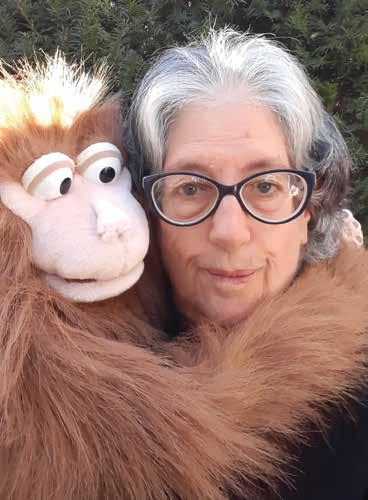
Catholic Social Teaching: Continuity, Change, and Relevance with Barbara Wall, Ph.D • Saturday, August 19 • 9:30 a.m. to 3:30 p.m. • An exploration of perduring themes in Catholic social teaching such as the sanctity of all creation, the common good, human rights, and the appropriate uses of power. $45.00 Lunch included. For more information call Weber Center at (517) 2664000 or visit webercenter.org.
Storytelling

“Do Something Beautiful for God!” A Reflection Day on Mother Theresa of Calcutta with Joy Barker, OSF/S • June 14 • 9 a.m. to 3:00 p.m. • $30, lunch included. For more information call Weber Center at (517) 266-4000 or visit webercenter.org
Stress Management

FREE Intro for Healthcare Professional – Basic Qigong for Self-Care with Master Wasentha Young • Monday, May 1, 8, 15 • 7:15 to 8:15 p.m • Learn basic Qigong energy work techniques for your self-care. Need some self-care tools to help manage your tensions? These FREE sessions are designed for your easy-to-do self-care. They will include meditation, self-acupressure, stretching, and centering movements. You must be a healthcare professional to attend these sessions. The class is down a flight of stairs and limited to 10 participants. Pre-registration is required. For more information or to register email info@ peacefuldragonschool.com, call (734) 741-0695, or visit peacefuldragonschool. com/events.
Stop Sabotaging Your Self-Care with Christy DeBurton, RYT • Self-Paced • In this compact but powerful self-paced course you’ll find effective tips and tools to honor your feelings, set boundaries, and thrive in the face of life’s challenges. Get at the root causes of your self-sabotaging habits. Learn to set healthy boundaries--without the guilt. Banish burn-out, overwhelm and resentment. Get inspired to eat healthy, sleep well + live better in your body. $79. For more information email info@christydeburton.com or visit christydeburton.com.
Debra Metler is passionate about eating healthy! As a senior, she’s learned that eating healthy is even more critical as we age since our bodies have more difficulty processing toxic foods and this turmoil turns into disease. She actually lost 30lbs and her toxic belly fat simply by changing her diet. It amazes her that we can potentially avoid every disease and live longer by just making different food choices that are actually delicious! In addition to her virtual Prime Time Health workshops from the Dr. Sears Wellness Institute, she’s now working with her puppet, Ziggie. Together. They will be presenting the benefits of healthy eating live to groups. She’s also developing an exciting new series of four workshops called “Don't Forget Your Brain.” It has been “scientifically proven that Alzheimer's and other forms of dementia can be prevented with simple dietary and lifestyle changes” and Metler believes this is vital information that everyone needs to know.
Find Metlers workshops in the calendar under the heading “Nutrition and Food Medicine.”




The Crazy Wisdom Community Journal • May through August 2023 • Page 107
If you are interested in obtaining some biographical information about the teachers, lecturers, and workshop leaders whose classes, talks, and events are listed in this Calendar, please look in the section that follows the Calendar, which is called “Teachers, Lecturers, Workshop Leaders, and The Centers” and which starts on page 111.
Finding Myself Through Human Design
By Melody Simmons
On New Year’s Eve 2020, I was feeling a lot of pressure about choosing a career path. The pressure came from my partner of six years, Jake. He was frustrated that I could not just choose a career and stick with it. He couldn’t understand that I no longer wanted to work a traditional job and felt burnt out. I felt like I was living in the movie Groundhog’s Day. No matter where I worked, I always found myself in the same situation. Either the boss would not understand me and become angry or frustrated, or if it was not the boss, it would be a coworker. Every traditional job I had seemed to chew me up and spit me out. I would find myself in a pattern of staying for about two years before the environment became toxic, and I would hop to the next job. I never understood why this would happen. I was a hard worker, friendly, and did my best, but it did not matter. I was stuck in the same cycle.
Every traditional job I had seemed to chew me up and spit me out. I would find myself in a pattern of staying for about two years before the environment became toxic, and I would hop to the next job.
I decided to meet with a Medium, TeeJay, hoping she would help me find what I was supposed to be doing in this life, and boy, did I get more than I bargained for. She told me a few things that shocked me. Spiritually, there was “beef” between my ancestors and Jakes’ and most importantly, I would be pursuing Human Design. “Human Design? What is that?” I asked. I had never heard of Human Design before, and I was intrigued. She only gave me a little insight into what it was by stating that it is a chart showing exactly who you are. That’s all I needed. Within the hour of that reading, I ended my relationship, moved out the next day, and told myself that I would investigate Human Design when I had my feet back on the ground—not knowing it would take six months.
In June 2021, I decided it was time to look into Human Design and see what it was all about. As soon as I put my birth information (date, time, and place) into the system, I immediately had an intense spiritual awakening that lasted for about two weeks. I had a need to learn everything about Human Design. I had to know what Aura Type my friends and family were, how I connected with them all, and how I should be navigating my life. Most of all, the information I learned about myself through Human Design was life changing.
The first thing I learned was my Aura Type. There are five Aura Types: Manifestor, Generator, Manifesting Generator, Projector, and Reflector. I was the Aura Type of the Projector. I found out that each of the Aura Types had a strategy, or the most effective way to navigate through life. Some Aura Strategies are “to respond, to wait a full lunar cycle, or to inform.” Mine was to “wait for the invitation.”
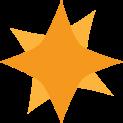

Everything clicked. Human Design explained why I had been having trouble with jobs, been misunderstood by people, and why I found myself running into one brick wall after another. I was living as society told me to: “Just do it” “Go make your dreams happen,” and “Get up and go get ‘em,” without knowing that I needed an invitation to do any of this. I decided that day to live how I was designed to live. I would wait for the invitation before pursuing anything. As I dove into Human Design, I decided to start with my own chart. I learned that as a projector, I do not have the Sacral Chakra defined in my chart. Meaning that, I do not have access to consistent energy, like 70% of the population does. Generator types (Manifesting Generators and Generators) have the Sacral Chakra defined. This means that they have enough energy from when they wake up in the morning to when they go to bed at night. Not me. I am designed to work 4 – 6 hours. Which made total sense to me as a typical 9 – 5 workday wipes my energy out. I’ll get home from a 9 – 5 and find myself on my couch, not wanting to move, not even to feed myself. I do not have the energy once I sit down. I always thought of myself as lazy, but now I know this is how I am designed to be.
Knowing I already had an invite through my New Year’s Eve reading, I decided to quit my full-time job, which I was miserable at, and see where this Human Design road would take me. It took me right to the Enlightened Soul Center and Shop in Ann Arbor.
I had passed by the Enlightened Soul Center and Shop many times, going up and down Carpenter Road, but Spirit delayed encouraging me to stop in and see what it was about. Finally, in June 2022, I entered the Center’s doors. The first person I met was Amy Garber, the owner. She was showing me around the shop and chatting with me. I let her know that I am a Human Design reader. Surprisingly, she had heard of Human Design before and invited me to read as a drop-in practitioner. I was so excited. I finally had a place that invited me in to read what I was most passionate about.



As soon as I put my birth information (date, time, and place) into the system, I immediately had an intense spiritual awakening that lasted for about two weeks.




In your first Human Design reading, I provide you with your Aura Type, Strategy, and Authority (authority relates to the Chakra System, and how to confidently make decisions), your Profile (or personality type), and your Incarnation cross (your karmic lesson you are here to learn in this lifetime). I try to fit this into a half-hour session, but there is so much information that most people sit with me for an hour. It’s mind-blowing to have a chart that encompasses precisely who you are and how you are designed to be. Most of all, it is validating and lifechanging information. Personally, learning about myself has changed my life for the better. How can knowing more about yourself help you?
If you are interested in a Human Design reading contact Melody Simmons to make an appointment at: HumanDesignwithMelody.com, Email: HumanDesignwithMelody@gmail.com, or shoot her a text at (313) 205-2687. She is also available for walk-in appointments at the Enlightened Soul Center and Shop at 2711 Carpenter Road in Ann Arbor Wednesdays, Thursdays, and Fridays from 1 p.m. - 5 p.m.
Everything clicked. Human Design explained why I had been having trouble with jobs, been misunderstood by people, and why I found myself running into one brick wall after another.
The Crazy Wisdom Community Journal • May through August 2023 • Page 108
Beth’s Bodywork Craniosacral Therapy Deep Tissue Massage Therapy #1 Therapist Recommended by University of Michigan Dr.s Requested to continue Diana Feldt’s work Techniques: Neuromuscular, Myofascial, Reflexology, Sports OT, Rolfing, Polarity, Lome, Reiki, Qigong, Alignment Guided meditation for stress relief for individuals and groups Free consultation & to book with Beth call or text 734 707 3706 Accepting New Clients Beth Dulka’s Aromatherapy Locally Made with Essential Oils Healing Hand Salve, Creams, Oils, Sprays & Lip Conditioner
Apparent’s Eril Andes & Beth Dulka 734 216 3825 | 734 707 3706 BethsBodyWork.com Requested to continue Linda Diane Feldt’s work Accepting New Clients Call or Text
Heir
The Crazy Wisdom Calendar
May through August 2023
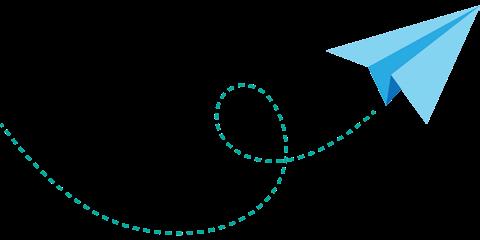
Tai Chi, Martial Arts, and Self-Defense

FREE Intro to Tai Chi for College Students with Master Wasentha Young • Monday, May 1, 8, 15 • 6 to 7:00 p.m. • T’ai Chi, often characterized as a moving meditation, is a series of postures linked together in a continuous, fluid manner. As a practice, it integrates the mind and body, promotes relaxation, as well increases balance. This is an in-person class (limit 10). Pre-registration is required. For more information or to register email info@peacefuldragonschool. com, call (734) 741-0695, or visit peacefuldragonschool.com/events.
Tai Chi for Beginners with Master Wasentha Young • Monday, May 1 through July 28 • Monday, 10 to 11:15 a.m. and/or Thursday, 6 to 7:15 p.m. • T’ai Chi, often characterized as a moving meditation, is a series of postures linked together in a continuous, fluid manner. As a practice, it integrates the mind and body, promotes relaxation, as well increases balance and concentration. Register for one class and you can attend both sessions – whatever your schedule allows – at no extra cost! Mondays in-person only (limit 10), Thursdays Hybrid class - taught in-person and on Zoom (your choice). $195. For more information email info@peacefuldragonschool.com, call (734) 741-0695, or visit peacefuldragonschool.com.
Women’s Health
Creating Your Perimenopause Plan with Christy DeBurton, RYT • Self-Paced • Creating Your Perimenopause Plan combines science and personal experience, so you feel like you’re going on a self-guided journey with a knowledgeable friend. In this e-Guide Christy shares everything she learned during her own perimenopause journey, and then helps you create a plan to support your body—pro-actively—through nutrition, supplements, exercise, stress relief and more. $59. For more information email info@christydeburton.com or visit christydeburton.com.

Writing and Poetry
Crazy Wisdom Poetry Series Hosted by Edward Morin, David Jibson, and Lissa Perrin • Workshops on May 10, June 14, July 12, August 9 • Featured Readers on May 24, June 28, July 26 • 7 to 9:00 p.m. • Second Wednesdays are Poetry Workshop days. All writers welcome to share and discuss their poetry and short fiction. Sign-up for new participants begins 6:45 p.m. Fourth Wednesdays are for Featured Reader(s) for 50 minutes, then Open Mic reading for one hour. All writers welcome to share their own or other favorite poetry. Sign-up begins at 6:45 p.m. All sessions are virtual and accessible through Zoom. Email cwpoetrycircle@gmail.com for Zoom link. For more information contact Edward Morin at (734) 668-7523, email eacmorin@sbcglobal.net, or visit cwcircle.poetry.blog. Featured Readers:
• May 24 – David James was born and raised on the third coast, Michigan. His most recent of seven published books is Alive in Your Skin While You Still Own It, and another—She Dances Like Mussolini—won the Next Generation Indie Book Award. He’s had over thirty, one-act plays produced in the U.S. and Ireland.
• June 28 – Terry Bohnhorst Blackhawk founded, and for 20 years directed, the InsideOut Literary Arts Project for Detroit students. Her poetry has won the John Ciardi Prize (for Escape Artist), the 2010 Pablo Neruda Prize, and a Kresge fellowship. Her fifth book, One Less River, was a Top 2019 Indie Poetry title. Her latest chapbook is Maumee, Maumee
Wu Style Tai Chi Chaun with Marilyn Feingold • Sunday, May 7 through July 23 • 4:00 pm to 5:00 pm.
• Onsite only at Jewel Heart. Learn the ancient art of meditation in motion with this “soft style” martial art emphasizing relaxation and balance. Drop-in, $5 per session collected at the door. For more information, visit jewelheart.org/chapters/ann-arbor, call Jewel Heart at (734) 994-3387, or send an email message to programs@jewelheart.org.
Wu’s Tai Chi Chuan Academy-Ann Arbor Taught by Disciples and Advanced Students of Sifu Genie Parker • Mondays and Thursdays, 11 am - 12:30 pm • Mondays 7 to 8:00 p.m. • Wednesdays and Thursdays, 6:30 to 8:00 p.m. • Saturdays, 10 to 11:30 a.m. and 2 to 3:00 p.m. • Sundays, 4 to 5:30 p.m. • Classes held at Jewel Heart. other classes in nearby communities are listed on our website. Wu Style tai chi chuan is a soft style martial art emphasizing balance and relaxation. All are welcome to learn this ancient art of meditation in motion. $45/month for 1 class per week; $70 for 2 classes per week. Student/ senior rates available. For more information email info@wustyle-annarbor.com or visit wustyle-annarbor.com.
Yang and Chen - Qigong and Tai Chi with Karla Groesbeck • Ongoing • Classes available in Yang and Chen - Qigong and Tai Chi - Beginner - advanced. Solo, two-person, weapons. Outside, inside and zoom. Yang Long Form 108, Chen Laojia Yilu, Xinjia Yilu. Various qigong sets. Zhan Zhuang. Staff, Bang, Ruler, Push Hands/Tuishou. Low fee, FREE for seniors. For more information call (734) 276-3059, email info@taichilove.com, or visit TaiChiLove.com.


Chen Tai Chi Chuan with Joe Walters • Ongoing Monday, Thursday 5 to 6:00 p.m. • Saturday, 9:30 to 10:30 a.m. • Instruction in Chen Tai Chi Chuan, a unique art emphasizing inner stillness and relaxation developed through disciplined whole-body integration and refined awareness. FREE. For more information contact Joe Walters, annarbortaichi@gmail.com, annarbortaichi.com
Theater
Can I Help You, Too? with Neighborhood Theatre Group • May 12 through May 21 • Do you want fries with that? If you’ve ever served or been served you’ll have a laugh in this musical sketch comedy show sequel that begs the question, “Can I help you, too?” $12 online, $15 at the door. For more information contact info@ntgypsi.org or visit ntgypsi.org.
• June 28 – Derek Pollard is Editor of the Poets on Poetry Series at University of Michigan Press. A widely published poet, book critic, longtime educator, and workshop leader, he founded Constellar Creative, a creative agency that specializes in content marketing and copywriting. His most recent poetry collection is
• July 26 – Jack Driscoll’s Pushcart Editors Prize. His novels or story collections received the PEN/ Nelson Algren Award, AWP Grace Paley Short Fiction Prize, Society of Midland Authors Award, and Michigan Notable Book Awards. He founded the creative writing department at Interlochen Center for the Arts.
The Crazy Wisdom Community Journal • May through August 2023 • Page 109
The bad news is time flies. The good news is you're the pilot.
— Michael Altshuler
The Crazy Wisdom Calendar
Writing and Poetry continued
The Promise of Summer: A Writing Workshop with Tarianne DeYonker, OP with the Weber Center • Saturday, July 15 • 10 am to 4:00 p.m. • When planting seeds in my garden my hope is palpable. As spring turns to summer, I need patience and support to persist in watering, weeding, and aerating the soil to nurture what I have planted. The same is true for writing. What are some of those nurturing activities that keep us writing when the words just won’t come, or time seems to drift away from us? You can give yourself the time to write with others during this workshop day. This workshop may be just the “fertilizer” your writing needs to thrive. Beginning and experienced writers are welcome in this workshop. $60, lunch included. For more information call the Weber Center at (517)266-4000. Registration is required at webercenter.org.
Yoga
Surya Kriya with Barbara Datz-Hernandez from Earth and Ether Classical Yoga • Saturday and Sunday, April 1 and 2 • Saturday, 5 to 8:00 p.m. and Sunday 9 a.m. to Noon • Both sessions are required. Surya Kriya is a gentle, slow-paced, 21-step process to aligns yourself with the cycles of the sun, the essential powerhouse of this planet and your physical body. Regular practice of Surya Kriya boosts vigor and vitality, balances hormonal levels in the body and greatly improves posture and balance. $200. For more information contact Barbara Datz-Hernandez at (517) 214-9671, email Barbara@earthandether. com or visit earthandether.com.

Open Level Yoga with Michele Bond • Ongoing, April through July • Sunday, 4 to 5:30 p.m. • Tuesday, 6 to 7:30 p.m. • Saturday, 10 to 11:30 a.m. Each student is encouraged to honor their own unique abilities and limitations in this mixed level class, with variations offered for all levels. Our method blends the science of biomechanics with an openhearted, uplifting philosophy. Learn to look for the good in yourself and others as you enjoy a dynamic practice. $15 per class if registered for the semester. $20 drop in with instructor’s permission For more information contact Michele Bond at (734) 358-8546, email michele@ yogahouseannarbor.com, or visit yogahouseannarbor.com.
Where Do We Distribute The Crazy Wisdom Community Journal?
6,000 copies of The Crazy Wisdom Community Journal are distributed to more than 235 locations in the Ann Arbor area, including Crazy Wisdom Bookstore, Castle Remedies at the Parkway Center, Kerrytown, Schuler Books, the Zen Temple, Sweetwaters, Pharmacy Solutions, Michigan Union, the Better Health Store, North Campus Commons, U-M, EMU, WCC, Arbor Farms, the Center for Sacred Living, Complete Chiropractic, the Lighthouse Center, Jewel Heart, Tsogyelgar, York, Argus Farm Stop, Michigan Theater, Seva, Booksweet, Clark Pharmacy, and the Weber Center.
We also distribute to the offices of dozens of doctors, holistic health care providers and therapists.

If you'd like us to bring copies of The CW Community Journal to your office, studio or center, please call us at 734-665-2757 or email: bill@crazywisdom.net.
Yoga Essentials with Michele Bond • Ongoing, April through July • Thursday 6 to 7:30 p.m. • For those new to yoga, or new to this system. Learn Universal Principles of Alignment that are an invaluable aid to learning the postures, deepening your understanding of the body, developing a yoga practice that is safe, joyful, therapeutic, and fun! $15 per class if registered for the semester $20 drop in with instructor’s permission For more information contact Michele Bond at (734) 358-8546, email michele@yogahouseannarbor.com, or visit yogahouseannarbor.com.
Yoga for Athletes with Michele Bond • Ongoing, April through July • Wednesdays 6 to 7:30 p.m. Athletes or anyone looking for a strong practice will enjoy increasing core strength, enhancing flexibility, agility, balance, and mental focus with this fun and energetic practice. Universal Alignment Principles help open the door to peak performance in sports and all areas of your life. $15 per class if registered for the semester $20 drop in with instructor’s permission For more information contact Michele Bond at (734) 358-8546, email michele@ yogahouseannarbor.com, or visit yogahouseannarbor.com.
Guided Personal Retreat with Song of the Morning Staff • May 26 – June 2 OR June 30 – July 2 • The Song of the Morning Yoga Retreat community invites you to join us for an uplifting weekend experiencing spiritual refreshment and relaxation in a supportive peaceful atmosphere. Offered during select weekends in 2023, guided personal retreat offers a greater sense of community and support, so that you might get the most out of your retreat experience. During these special weekends you are invited to join our daily schedule of events which includes meditation, devotional practices, community meals, and more (see schedule below). At the beginning of the retreat, our community facilitators will be happy to welcome you, and offer simple guidance and answer questions in our sincere effort to help you get the most out of your retreat, and experience what our founder envisioned: “Spiritual refreshment and relaxation.” $108 plus lodging. For more information contact Song of the Morning Yoga Retreat at (989) 983-4107, email office@songofthemorning.org, or visit songofthemorning.org.
Yoga for Core Integrity ‘Live + Virtual’ Course with Christy DeBurton, RYT
• May - June • Are you experiencing back pain? Poor balance? Bad posture? A strong core can help with all these things, not to mention help you feel stronger in all your daily activities. This ‘Yoga for Core Integrity’ 8-week Live+Virtual course will help you power up your yoga poses and your body by exploring all the muscles—abs, glutes, obliques and more—that make up a strong core. $130-$140. For more information contact Christy DeBurton by email at info@ christydeburton.com, or online at christydeburton.com.
Yoga + Sound with Rob Meyer Kukan • Friday, June 23 • 6 to 7:30 p.m.
• Join Sound Healer, Rob Meyer-Kukan and Yoga Instructor, Paul Barr for this seasonal series of Yoga + Sound at 7 Notes Natural Health. Paul will lead a mindful yoga practice that focuses on themes tied to each of the seasons. Rob will support with gentle sounds of singing bowls, gongs, and more. An extended time of savasana will allow you to deeply rest into the new season while being immersed in sacred sound. $40. For more information contact Rob Meyer-Kukan at (248) 962-5475, email rob@robmeyerkukan.com, or visit 7notesnaturalhealth.com.
Yoga Chill Summer Course with Christy DeBurton, RYT • July through August
• Summer is a season full of activity, which means that we need a yoga practice that is a nice balance to this: slowing us down, cooling us off, giving us a chance to relax and just be. This soothing 8-week ‘Yoga Chill’ Live+Virtual course will help you feel more grounded and calm. $130-$140. For more information contact Christy DeBurton by email at info@christydeburton.com, or online at christydeburton.com.
Sivananda Yoga with David Black at Ann Arbor Zen Buddhist Temple • Ongoing • 6:30 to 8:00 p.m. • Beginning and experienced students in the classes learn traditional yoga postures (hatha yoga) with an emphasis on relaxation, concentration, and working with the breath. The instructors were trained by the Sivananda Yoga Organization and combine that experience with meditation training. Classes fill up quickly, so early registration is necessary. Cost is $60 for all six sessions or $12 per drop-in class. For more information contact the Zen Buddhist Temple at (734) 761-6520 or email annarborzentemple@gmail.com.
Yoga for Resilience with Julie Woodward • Tuesday • 9 to 10:30 a.m • Join us for this weekly yoga posture, breath, and meditation practice designed to support you in cultivating greater resilience. Drawing on recent research about the brain, participants will experience powerful practices that enhance nervous system regulation, calm anxiety, or energize a low mood. Each class will feature embodied mindfulness practices for cultivating greater self-awareness, fostering stability of attention, tuning in to the felt sense of the body, and navigating inner experience with greater skill. Suitable for all levels, gentle movement may be modified to suit individual needs. $20 per class, advance registration required. Email jawh@comcast.net with questions and to register or visit juliewoodwardmsw.com for more information.
Iyengar Yoga with David Rosenberg and Ann Arbor Community Rec & Ed • Monday, 6:00 p.m., Thursday 7:00 p.m., Saturday 10:00 a.m. • Classes are 90 minutes. Experience invigorating yoga postures using the methods of BKS Iyengar to strengthen the body, create a feeling of well-being, reduce stress, and release tension through physical activity and meditation. The instructor emphasizes the use of props and individualized instruction so students of varying experience, age, flexibility, and strength can participate together. $115 for nine-week session (Senior discounts available). Learn more at aarecedonline. com or call (734) 994-2300.

The Crazy Wisdom Community Journal • May through August 2023 • Page 110
Teachers, Lecturers, Workshop Leaders, & the Centers
Aaron is a discarnate entity channeled through Barbara Brodsky, founder and guiding teacher of Deep Spring Center Meditation and Spiritual Inquiry. He offers wisdom and teaches us that we are all beings of light.
Ann Arbor Community Rec & Ed offers a variety of adult enrichment activities throughout the year in various Ann Arbor locations.
Toni Auker is an experienced doula, childbirth educator, and mother of three. Despite her many professional trainings, her children and clients continue to be her greatest source of education.
Beth S. Barbeau, CPM, LM is a licensed homebirth midwife, teacher, author, and speaker. She has over 40 years of experience in naturopathic health care and the birth community and founded IndigoForest.com in 2006 to support mothers and babies.
Joy Barker is a Sister of St. Francis from Sylvania, Ohio. She offers retreats, spiritual direction, and days of reflection.
Deanne Bednar is the Coordinator of and an Instructor at Strawbale Studio, teaching enchanting thatched and living roofs, strawbale walls, earth plasters, round pole, rocket stoves, and foraging.


Carol Blotter has been practicing Insight Meditation since 1989 and has been teaching since 1999. Her 25and years practice and study has led to a blending of Vipassana and non-duality teachings. She is the primary teacher of Chelsea Meditation Group.
Michele Bond brings an entire lifetime devoted to fitness and wellness, and a healthy dose of humor to her teaching. Michele has an extensive background in martial arts, dance, competitive synchronized swimming, gymnastics, stunt fighting and swordplay, as well as over 800 hours of training in yoga, yoga therapeutics, and meditation.
Patty Brennan is the owner and visionary force behind Lifespan Doulas. For 40and years, she has been a doula, midwife, educator, author, nonprofit executive, and entrepreneur. Patty has personally trained approximately 2500 people to become doulas and is the author of The Doula Business Guide
Barbara Brodsky is the founder and guiding teacher for Deep Spring Center for Meditation and Spiritual Inquiry and a channel for Aaron. Rooted in the Buddhist and Quaker traditions her teaching reflects this balance.
Sonya Carter is a deaf mama who creates a fun environment for families to learn and play together.
Gail Castle LMT is Board Certified in Therapeutic Massage and Bodywork. With 40and amazing years of “hands-on” experience, she uses a holistic approach and neuromuscular feedback testing in the therapeutic and educational activities at A Transformation Station, LLC.
Jean Chorazyczewski and Lori Fithian have been leading monthly sing-alongs since 2015. Jean plays keyboard and Lori is on guitar, and they welcome anyone on any instrument to join in the fun!
Barbara Datz-Hernandez studied in India at the Isha Hatha School of Yoga and had over 1750
hours of training and more than nine years of teaching experience.
Christy DeBurton, RYT, is a Holistic Yoga and Wellness Educator with 25 years of experience. She helps people restore balance to their lives through Yoga and Meditation, Wellness Retreats, HSP and Midlife Empowerment and Self-Care and Perimenopause Guidance.
Tarianne DeYonker, OP, MSW, is an Amherst Writers and Artists Affiliate.
Rachel Egherman, LMT, is a HeartMath™ Coach and mentor.
Connie Lee Eiland has studied shamanism since 2000 with Sandra Ingerman, Betsy Bergstom, Herb Stevenson, Ana Larramendi. She has been a shamanic practitioner for 20 years and a shamanic teacher for 15 years.
Evenstar Institute is a teaching/learning community – one that offers experiential courses, workshops, and community-building activities inperson and online. Both a space and place where people can consciously grow, evolve, and develop their capacities to step into this great work of transforming their lives, their relationships, and this world for the better.
Marilyn Feingold began training Tai Chi Chuan in 1996 at Botsford Hospital Rehabilitation Center. Retiring from her job in 1991 as a childcare worker for the State of Michigan after being diagnosed with serious health problems, she began training Tai Chi Chuan as a way to help control pain and maintain good joint and muscle mobility.
John Friedlander is an internationally acclaimed psychic, author, and teacher with degrees from Duke University and Harvard Law School. He studied with Jane Roberts in her Seth classes and Berkley Psychic Institute with Lewis Bostwick. Frog Holler Farm are longtime growers at the Ann Arbor Farmers Market and supporters of local culture.
Bill Gisclair-Sullivan is a transformational coach and has developed a program to teach other coaches how to awaken the power of transformation in their clients.
Karen Greenberg is a Success-Tracking Train-theTrainer, certified Essence Repatterning and D.O.V.E. Practitioner, dance instructor, physical therapist (formerly teaching at University of Maryland Hospital), as well as being a Personal and Spiritual Growth teacher/author for metaphysical spiritual seekers worldwide.
The background information listed here pertains specifically to individuals and centers whose classes, workshops, and events are listed in this current issue of the Crazy Wisdom Calendar. If you are a holistic/spiritual/psychological growth practitioner in the area, but don’t regularly lead classes or workshops, you can still be listed for free in our online Holistic Resource Guide. List your practice and add your logo, photo, and even a short video. To claim your listing, please visit AnnArborHolistic.com.
The Crazy Wisdom Community Journal • January through April 2023 • Page 111
Artwork by Jennifer Carson
Trish Maley
Health, Rob works with people who suffer from chronic pain, need to relax, and who are looking for natural health alternatives.
Michigan Friends Center is a non-profit rental space promoting social awareness, environmental friendliness, and spiritual love.
Edward Morin is a writer, editor, translator, and former university teacher.
is

her third year of running her business called Embracing Stillness. She has a BA in communications from Purdue University and is a graduate of University of California’s Greater Good Science Center as a Mindfulness Meditation Teacher.
Maley facilities group and private meditation counseling for adults and children. She also works with middle school and high school athletes to improve focus and emotional regulation. Embracing Stillness has a Facebook page and their handle on Instagram is Embracingstillnesswithjoy. To contact Maley email embracingstillnesswithjoy@gmail.com.
Read Maley’s article Social Meditation in Issue #92 of The CrazyWisdom Biweekly at crazywisdomjournal.com/biweekly-92.
Teachers, Lecturers, Workshop Leaders, & the Centers
Karla Groesbeck has over 30 years of experience in the body movement, meditation, qigong, and martial aspects of Tai Chi Chuan. She is owner and founder of Tai Chi Love Studios in Ann Arbor and is the lead instructor of Tai Chi and Qigong at Washtenaw Community College. She performs and innovates solo and two-person (martial art) and weapons forms.
Insight Meditation Ann Arbor is a sangha practicing insight meditation located in Ann Arbor, Michigan.
Irene’s Myomassology Institute is the oldest and largest massage school in the Midwest. Founded by Irene Gauthier in 1987, our nationally accredited school continues to set high standards for massage education.
Jewel Heart is dedicated to the preservation of Tibetan Buddhism and to bringing the practice of this rich tradition within the context of contemporary life to everyone. Programs for all levels of interest.
Jewel Heart Instructors moderate discussions, pose thought-provoking questions, keep the discussion on track, and encourage everyone to participate.
David Jibson is a poet, editor, blogmaster, and former social worker.
Sister Esther Kennedy, OP, a Dominican Sister of Adrian Michigan, is a retreat leader and spiritual director. She conducts a monthly Day of Mindfulness at Weber Center.
Jacquelin Kilburn MA, OT, is an Occupational Therapist who has devoted more than 40 years to developing expertise in the treatment of the pediatric population.
Anthony King is an Associate Professor in the Department of Psychiatry and Behavioral Health and the Institute for Behavioral Medicine Research (IBMR) at The Ohio State University (OSU), and Director of the OSU Center of Excellence for Resilience where he conducts NIH-funded clinical neuroscience research on Mindfulness and Compassion-based psychotherapy for PTSD, anxiety, and depression. King has been a student of Gelek Rimpoche for over 30 years and a Jewel Heart instructor since the mid-1990s.
The King family has been growing organic produce for fifty years on Frog Holler Farm. This will be the fifteenth Holler Fest they are offering on their farm in the beautiful Irish Hills.

Lorenda Lewis is a Red Cross Certified instructor, doula, and mother.
Lifespan Doulas offers comprehensive online training and certification for becoming a birth, postpartum, or end-of-life doula, plus guidance for launching your own doula business.
Erica McLeod is an IBCLC that has been working with families in Washtenaw County for over a decade.
Debra Metler is a Clinical Social Worker and Certified Health Coach.
Rob Meyer-Kukan is a licensed massage therapist, and sound healer. Owner of 7 Notes Natural
The Mother is a discarnate entity channeled through Barbara Brodsky, founder and guiding teacher of Deep Spring Center for Meditation and Spiritual Inquiry. She offers events in spiritual consciousness through the sharing of spiritual energy.
Kirsten Mowrey, LMT practices somatic based hands-on therapies. She has trained with Francis Weller, author of The Wild Edge of Sorrow, in California. She has worked with grief in small groups and is happy to bring this ritual to a wider audience.

Natural Health Expo is part of Michigan’s 21st Annual Lavender Festival in Imlay City, MI.

Neighborhood Theatre Group’s mission is to make theatre an accessible home for the collaboration of people, artistic challenges, and new ideas.
Nest & Nurture is a community center and teaching space that focuses on pregnancy, birth, and parenting.
Guy Newland is Professor of Religion at Central Michigan University, where he has taught since 1988. He has authored, edited, and translated several books on Tibetan Buddhism including the three-volume translation of The Great Treatise on the Stages of the Path to Enlightenment and Introduction to Emptiness.
John Orr received Theravada Buddhist ordination and training for eight years while living as a monk in the 1970’s in Thailand and India. He has been teaching meditation and leading retreats since 1980. He is the guiding teacher of the New Hope Sangha in North Carolina and retired faculty member of Duke University.
Sifu Genie Parker has trained and taught Wu Style tai chi chuan for over 30 years. She is a disciple of Grandmaster Wu Kwong Yu, gatekeeper of the Wu style.
The Peaceful Dragon School has offered yearround programs in the self-care practices of Tai Chi, Meditation, and Qigong (Energy Work) since 1990.
Lissa Perrin is a poet and former clinical social worker.

The Crazy Wisdom Community Journal • January through April 2023 • Page 112
The man who has planted a garden feels that he has done something for the good of the world.
—Charles Dudley Warner
in
The Art of Spirit Guide Messages and Tarot
By Kat Similo

Like many, my spiritual journey started at a young age, I felt, saw, and simply just knew. I knew there was more, especially when some of my dreams came to fruition. I simply didn’t understand how to interpret how that came to be. I would lose myself in my art, writing poetry and short stories. I dabbled in giving Tarot readings to friends and my self-growing up but did not fully embrace the power of the cards until later. Nor did I realize that my creative artwork could connect to Spirit. I certainly was not aware of what a guide was or could be.
As an adult, I began to glean the validity of the signs given to me, but still didn’t know what they meant, or how to listen and trust them, so they mostly went ignored, until I was given clear direction to search for classes about intuition. This is when I came across Amy Garber and The Enlightened Soul Center. Eureka! There were actual classes to help one understand and continue to develop one’s intuition and psychic medium ability. I took as many classes as one could take but was ultimately transformed through the Divination class when I realized I can be of service to others doing what I love. Inspiration hit when we engaged in readings using art books and colorful pictures. I thought, wait, what if I could use my skill as an artist and writer to share the messages during the reading. But how do I do this?
Then I met Tonya Henderson, an intuitive psychic artist and coach and I leveled up. I gained confidence in my abilities and trusted I could bring the beauty of art into my work. I was already sharing messages through Tarot, art books, and Oracle Cards. I was participating in Psychic Fairs at the center and in various venues including private events. I could do this. I could add art and make it personal.
I connect with Spirit, and work to bring messages brought to me from your spirit guides, celestial beings, ancestors, animal totems, or others. These messages are what your guide(s) wish you to know. They can be messages about current, future, or prior events. They may guide you in a question you have. They may show you a depiction of what they look like or how they present themselves to you. In essence, as a Spirit Guide Messenger I bridge connections by creating personal visionary artwork, depicting images, symbolism, and messages that you take with you to remember and reflect. I am always in awe of the messages and pictures that come through for a client. Each one is so unique.
If you would like to sit with Kat Similo for a personal Spirit Guide artistry and message, or attend one of her classes, visit her online at Enlightenedsoulcenter.com or email her at Kreativeintuitive@gmail.com.
Teachers, Lecturers, Workshop Leaders, & the Centers
The Prison Creative Arts Project brings those impacted by the justice system together with the University of Michigan community for artistic collaboration, mutual learning, and growth.
Rocky Shadowbear Rains is a Folk Magician and Shamanic Practitioner for over 45 years in the Native American, Appalachian, and Celtic Traditions. He is the founder of The Wyldwood School of the Magikal Arts and he along with his partner Airow create magikal wares and folk remedies made in the ancient way with song, prayer, and ceremony.
Judy Ramsey’s shamanic practice and animal communication skills have been helping people for nearly 20 years. An approved instructor, she teaches Sandra Ingerman’s approach to shamanic practice, as well as four levels of Penelope Smith’s animal communication, including interspecies counseling.

Gelek Rimpoche (1939–2017) was the Founder and Spiritual Director of Jewel Heart. Among the last generation of incarnate lamas tutored by the great masters in Old Tibet, Rimpoche’s command of western culture allowed him to convey the Tibetan Buddhist tradition with wisdom, kindness, and wit.
Demo Rinpoche is Jewel Heart’s Resident Spiritual Advisor. He studied uninterrupted for almost thirty years at the Drepung Loseling Monastery in India under the supervision of the Dalai Lama and received the highest monastic degree of Geshe
Lharampa in 2011. His studies continued at Gyume Tantric College, Sera College of Higher Tibetan Studies, and Union Theological Seminary.
David Rosenberg is a certified Iyengar yoga instructor who has been teaching since 1993. He has traveled to Pune, India in 1996 to study from the Iyengars as well as studying from other advanced Iyengar yoga teachers.
Jessica Ryder, LLPC, is a counselor and facilitator. Swami Sankarananda is a simple pilgrim of peace and a servant of God in our path of awakening to the One Truth. Living much of his adult life as a businessman in the tech industry, he realized the selfish pursuits were meaningless and through grace came to the pursuit of God, or highest Self. Having given up his old life, he dedicated his new life to service of this Self in all. In 2012, Swamiji renounced his worldly way of life and traveled to the Himalayas, receiving darshan and life guidance at the feet of Swami Premananda and Swami Ramaswarupananda, disciples of Swami Sivananda. He took initiation as a Sanyassi, or monk, in 2013.
7 Notes Natural Health is an Ann Arbor destination for integrative bodywork, incorporating massage, sound therapy, energy work, and reflexology.
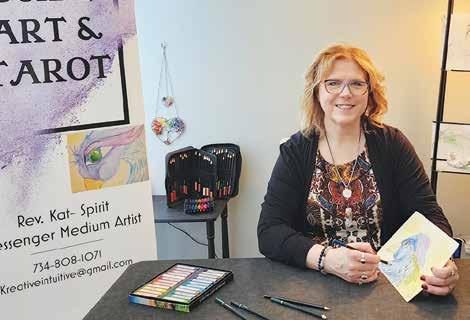
Song of the Morning Yoga Retreat was founded in 1970 by Yogacharya Oliver Black a direct disciple of Paramahansa Yogananda.

The Crazy Wisdom Community Journal • January through April 2023 • Page 113
I took as many classes as one could take but was ultimately transformed through the Divination class when I realized I can be of service to others doing what I love.
You don't always need a plan. Sometimes you just need to breathe, trust, let go, and see what happens.
—Mandy Hale
Teachers, Lecturers, Workshop Leaders, & the Centers
Ema Stefanova is an experienced master teacher, yoga therapist, teacher trainer, owner of Ann Arbor Yoga and Meditation. She enjoys working with beginners and all level students.
Still Mountain is a meditation and spiritual inquiry center.
Strawbale Studio is a place and a program offering natural building and sustainable skills/ crafts for adults and youth. Located on rural wooded land one hour north of Detroit.
Judy Lee Nur-un-nisa Trautman is a certified leader and mentor in training of the Dances of Universal Peace and an ordained Cherag to lead Universal Worship.

Unity of Bay City is a community looking within, reaching out, and practicing the principles of love. We honor all spiritual paths and cherish the uniqueness of every person who enters our doors. All are welcome!
Barbara Wall, Ph.D retired from Villanova University as Vice-President of Mission and Ministry.
Joe Walters has practiced Chen Tai Chi for 29 years.
Lou Weir has been teaching meditation classes and leading retreats for 15 years and is an ordained teacher in the Ridhwan school of Diamond Approach teaching.
Eve Wilson is an author and blogger and has published over 600 articles. She has 36 years of experience as a full-time healer, trainer of healers, and is a cutting-edge world healer and ascension worker.

Julie Woodward, MSW, RYT-200, ACC, brings her professional experience as a wellness coach, health educator, trauma therapist, neuroscience researcher, and yoga teacher to the Yoga for Resilience Class series.
Wu’s Tai Chi Chuan Academy-Ann Arbor is one of twelve academies licensed by the international Federation, under the auspices of Grandmaster Wu Kwong Yu. They offer in-person, hybrid, and online classes.

Wasentha Young is a Master of T’ai Chi and Qigong. She has also received formal instruction in Buddhist and Taoist mindful meditation styles; holds certificates in Acupressure, Five Element Practice, and Wellness Counseling/Mind/Body Consciousness; in addition, she has a master’s degree in Transpersonal Studies.

The Crazy Wisdom Community Journal • January through April 2023 • Page 114
Artwork by Margaret Wyngaard
Receive our Weekly E-newsletter which features information about new books, audio books, tarot, and more! Get emails when the latest issues of the CW Biweekly magazine and The Crazy Wisdom Community Journal are available. to subscribe: scan the QR code, click here, or visit crazywisdom.net scan QR code You will also receive occasional emails, through us, from organizations, centers, and groups that sponsor the kinds of events, classes, and programs that you care about. We will never sell or share your information! Stay Informed!
The Passing of Richard D. Mann
1933-2023
U-M Professor Emeritus of Psychology Richard Mann passed away in January. He was one of the leading transpersonal psychologists in the country, and he taught and influenced students at the University for 60+ years. His courses on Interpersonal Behavior, Psychology and Spirituality, and on Non-Ordinary States of Consciousness, were the kinds of exceptional learning opportunities that students craved. He was loved and appreciated in Ann Arbor for his kindness and welcoming spirit. His work and his ideas had a significant effect on the counter-cultural paradigm that was seeded in Ann Arbor in the 1960’s and 1970’s, and which bore fruit in the establishment of a local bookstore such as Crazy Wisdom Bookstore, and in the publishing of a magazine such as The Crazy Wisdom Community Journal.

To read more about his life and contributions, you can link to the following:
—The U-M Dept. of Psychology obituary written by Bill Gehring: https:// lsa.umich.edu/psych/news-events/all-news/faculty-news/faculty-memorial--richard--dick--mann--1933-2023-.html
—The Ann Arbor News obituary written by Bill Zirinsky of The Crazy Wisdom Community Journal at https://obits.mlive.com/us/obituaries/ annarbor/name/richard-mann-obituary?id=39215337.
The Crazy Wisdom Community Journal interview in the September through December 2004 issue of The Crazy Wisdom Community Journal (Issue #28) on our archive at: https://issuu.com/cwcommunityjournal/docs/issue_28_ sept_thru_dec_2004.

—Link to Memorial Service for Richard Mann: www.facebook. com/1188505686/videos/1648537158995873/
Since


The Crazy Wisdom Community Journal • January through April 2023 • Page 115 CWyzar i ds o m ’s Gu i de toHolistic&Consciou iving Resourcesforsouth east e r n M gihcina www.annarborholistic.com If you are a holistic practitioner or business owner, list your business for free in our online guide. Questions? Email annarborholistic@crazywisdom.net Online advertising opportunities available! Visit the improved, and updated Ann Arbor Holistic Resource Guide
1982,
has served as a regional resource for information in the areas of holistic health and integrative medicine,
therapies,
and personal growth, Buddhism, spiritual development, and consciousness. Visit annarborholistic.com if you are searching for a practitioner or business in southeastern Michigan s L
Craz y Wisdom
bodymind
psychology
Expand

The Crazy Wisdom Journal provides an amazing platform for us to reach our community in a way that digital media and other technologies simply cannot. As a newly-opened Cannabis Microbusiness, we were very fortunate to have a platform like this to connect with health-conscious Ann Arborites who value local, natural products.
—Eric Parkhurst, Winewood Organics

Advertising, for over 20 years, in The Crazy Wisdom Journal, has been a






augment their more traditional health support. —Wasentha Young, Peaceful Dragon School



Leslie Science & Nature Center is honored to continuing being a part of this critical local publication. Personally, I love reading CWJ, both the digital and print publications. There is something special about the people featured within both journals. I feel more connected and appreciative of the individuals and business who care for and celebrate the world around us. The consistency of intimate personal stories, alongside deeper philosophical conversations that I really enjoy! Thanks, Crazy Wisdom Journal, for continuing to seek out and feature all of the incredible people making our community special!
The Crazy Wisdom Journal is such a blessing to the area's holistic community! It's the one place you can go to find out about places, events, products, and practitioners of alternative and metaphysical pursuits in the Ann Arbor area. I especially love their in-depth articles, which allow for a real experience of whomever is the focus. Even the ads are a great exploration of the community's offerings. Many people have told us they've seen our ads, and articles about us, in the CWJ. We are grateful to be a part of such an important publication!
—Amy Garber, Enlightened Soul Center & Shop
The Crazy Wisdom Community Journal • May through August 2023 • Page 116 Joyful Spirits Reiki 16 Judy Ramsey / Heart to Heart Animal Communication 69 Kate Roos, MAAT, ATR 15 Krasnick Regenerative Medicine 21 Leslie Science & Nature Center & Ann Arbor Hands-On Museum 67 Life Empowerment Coaching/ Maria Sylvester 6 Living Grateful/Bill Mure 16 Living Heart/ Ellen Livingston 17 McLaren Wealth 31 Melisa Schuster, LMSW 14 Michelle Camilleri/Reflexology 17 Michigan Collaborative for Mindfulness in Education 67 Monica Turenne / Four Paws Veterinary 35 Neighborhood Theatre Group 17, 49 New Earth Home and Garden/ Rosina Newton 16 Nia Spongberg, ACC,CPC 15 NITE - Naturopathic Institute Back Cover Northern Sky and Beyond/ Alice Davinich 14 Nuero Fitness Wellness Center 100 Pauline Loewenhardt 14 Peaceful Dragon School 87 Pott Farms 100 Ravensong Counseling 15 Rob Meyer-Kukan, LMT / 7 Notes Natural Health 14 Ronora Lodge & Retreat Center 27 Roos Roast 61 Rudolph Steiner Schools 71 Ruth Wilson 12 Sacred Sexuality with Leslie Blackburn 17 Shop Crazy Wisdom 73 Sing! Ann Arbor 69 Sole to Soul Healing 106 Stefanie Cohen, MA, RSMT / Moving Stories 17 Steiner Health 79 Stephen Rassi / Chrysalis Facilitation and Counseling 16 Susan McGraw / Divine Inspiration at Work 11 Suzy Wienckowski / Reiki 16 The Celebrated Heart/ Rachel Egherman 51 This Breath / Jackie Miller 14 Transitions LLC / Linda Bender 16 Triple Crane Monastery 25 Triple Moon Coaching 41 Victoria Schon 22 Unity Vibration .............................................................................................. 51 Winewood Organics 1 Adrian Dominican Sisters 79 Angel Whispers Spiritual Spa & Boutique 106 Ann Arbor Holistic Resource Guide 115 Ann Arbor Rec & Ed Adult Fitness 96 Ann Arbor School of Massage 16 Argus Farm Stop 53 Ashes in Art Glass 1 Beth’s Bodywork / Beth Dulka 108 Brad May, Ph.D Interior Front Cover Castle Remedies 47 Ceremonies by Sabra 2 Chérie Ann McMullen 15 Clinical Hypnosis Institute 15 Crazy Wisdom Poetry Circle 81 Crysterra Wellness 41 Curtis Glatter 16 Deep Spring Center 45 Denise Held 14 Diamond Work Michigan/ Lou Weir 15, 87 Divine Sanctuary 17 DNA Sales 2100 87 Dr. Raymond Kong / Acupuncturist 14 Dr. Susannah Parke, DO 81 Dynamic Points Acupuncture / Henry Buchtel 14 Ellen Crane Counseling 79 Elizabeth Sullivan / Ayurvedic Astrology 27 Emanuele Acupuncture Center 77 Embracing Stillness 109 Enlightened Soul Center 22 EOS Portal Interior Back Cover Eve Wilson 17,27 Evenstar’s Chalice 12 Fran Cowan Adler 16 Frog Holler Farm 37 Ginger Chase Massages 14 Great Lakes Herb Faire 103 Grove Emotional Health 55 Hilary Nichols Photography 11 Hollerfest ........................................................................................................ 31 Humane Society of Huron Valley / Tiny Lions 69 Indigo Forest 12 Interfaith Center for Spiritual Growth 96 Jennifer Carson / Artist & Author 43 Jennifer Lee Stein / Life is Current 15 Joobwear 27 Advertiser Directory Advertise in The Crazy Wisdom Community Journal and reach over 25,000 loyal readers in southeastern Michigan interested in a healthy, holistic, and conscious lifestyle!
resource that
business, Peaceful
School,
community of
keeps my
Dragon
connected with a
those looking for self-care and wellness methods that will
Crazy Wisdom Discount on Ongoing Classes $10 Use code: CW2023 Register Online Visa/MC Prac�ces to Enhance Your Well-Being Meditation in Motion * Energy Work Self-Care * Reduce Mental and Muscle Tension Tai Chi, Medita�on, and Qigong Peaceful Dragon School 1945 Pauline Blvd., Suite B Ann Arbor, MI 48103 Easy parking flight of stairs Phone: 734-741-0695 info@peacefuldragonschool.com Visit our website: www.PeacefulDragonSchool.com Peaceful Dragon School Semester Begins January 9 Experience a sense of harmony and well being through ongoning classes, private sessions, and/or mini series. Call to learn more about the Mini Series Mondays, 5:30 6:30 PMFeb 2-16, Thursdays, 11:30 12:30 PM - Reboot / Refresh Ann Arbor’s only Cannabis Microbusiness winewoodorganics.com
our family of satisfied advertisers ... It is a beau�ful �me to come PLAY Leslie Science & Nature Center Rentals, Summer Camp, Preschool, Birthdays, Cri�er House, Family Programming and more! Our trails, Raptor enclosures and Nature Playscape are always free & open sun up to sun down. Together we provide Moments of Discovery for everyone in our community. discoverscienceandnature.org Ann Arbor Hands-On Museum Open six days a week 10 am 5 pm Memberships available Museums for All par�cipant! $3 admission (EBT/WIC card holders)
Your Business Horizons! Join
—Susan Westhoff, Executive Director Leslie Science and Nature Center and Ann Arbor Hands on Museum

Connect to other organizational and individual account holders as EOS friends We’re proud to offer a FREE individual ($50) and/or organizational ($100) preferred membership to all CWCJ community members. SPECIAL OFFER We’re full-on allies of Crazy Wisdom! GROW YOUR COMMUNITIES Build, connect, and grow your personal and business communities in a truly safe and powerful online space Here's what you do Register Now @ www.eosportal.org/cwcj Eos is a new, innovative, and safe online space for community building with a fully-integrated social media suite, brought to you by the 501c3 non-profit The Intentional Living Collective. Register for a basic (free) account we'll upgrade you to a preferred account for free Explore Explore all of the cool features of EOS to build your personal and organizational connections and community FREE PREFERRED 1 YEAR MEMBERSHIP Collaborate Connect and Collaborate in a safe environment to expand your circles of support
































































Over 25 Years of Experience Licensed and Accredited
4th
Doctor
Naturopathy (each year 600 hours) Natural Health Educator.........................1st Year Natural Health Therapist........................2nd Year Natural Health Practitioner.....................3rd Year Certified Naturopath...............................4th Year
Year graduates are eligible for
of Naturopathy National Test & Title
Massage Therapy Therapeutic Bodywork Practitioner...1 Year Holistic Doula Practitioner Certificate Course.......3 Classes Diploma Course.......7 Months
Herbology - Aromatherapy - Nutrition Live Food Preparation - Light Healing Touch Reflexology - Homeopathy & Much More (989) 773-1714 ~ Mount Pleasant, MI contact@naturopathicinstitute.org www.naturopathicinstitute.org ~ Belong! Explore! Become! Find Your Way at The Institute! Explore all the available programs of study and apply online at: naturopathicinstitute.org
All Classes Meet on Weekends Fri: 5-9pm and Sat & Sun: 9am-6pm Naturopaths: 1 per month - Massage: 2 per month Individual Classes:












































































































 Story and Photos by Hilary Nichols
Story and Photos by Hilary Nichols




















 By Marie Duquette
By Marie Duquette
















































































































 By Peggy Alaniz
By Peggy Alaniz








 By Christine Macintyre
By Christine Macintyre






























 By Laurel Decker
Photos by Susan Ayer
By Laurel Decker
Photos by Susan Ayer
















































 By Sandor Slomovits
By Sandor Slomovits







 —Bridget O’Brien
—Bridget O’Brien




 By Cashmere Morley
By Cashmere Morley


























 By Monica Turenne
By Monica Turenne


















































 By Ashton D. Justice • Photos by Mary Bortmas
By Ashton D. Justice • Photos by Mary Bortmas






























 By Mr. Jay
By Mr. Jay

 By Jason Chin
By Jason Chin
 Bea Wolf
By Zach Weinersmith, illustrated by Boulet
Bea Wolf
By Zach Weinersmith, illustrated by Boulet


























































































































































